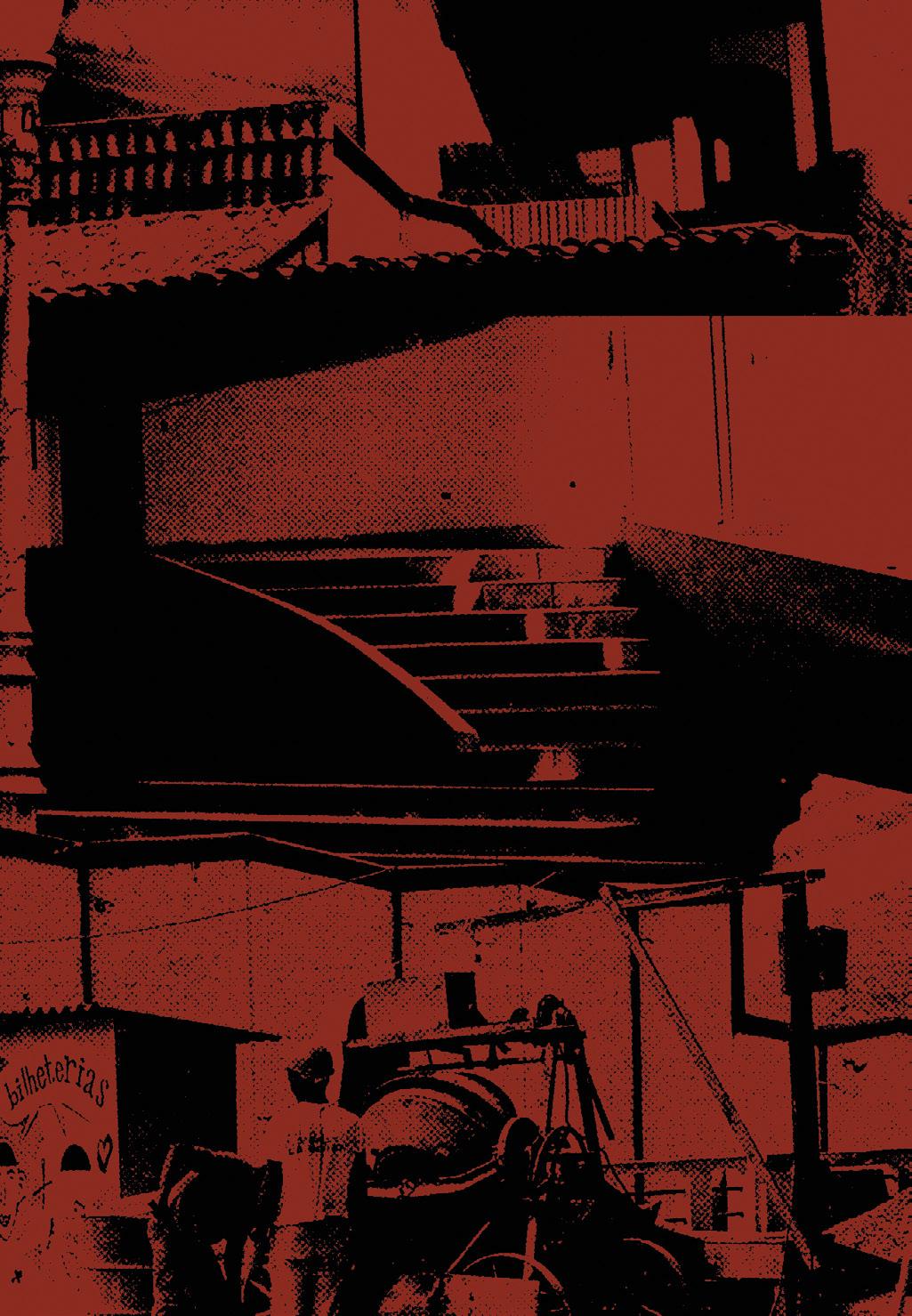

vila velha por exemplo
Apoio
Produção Coprodução
Realização

Ministério da Cultura e Banco do Brasil apresentam:
vila velha por exemplo
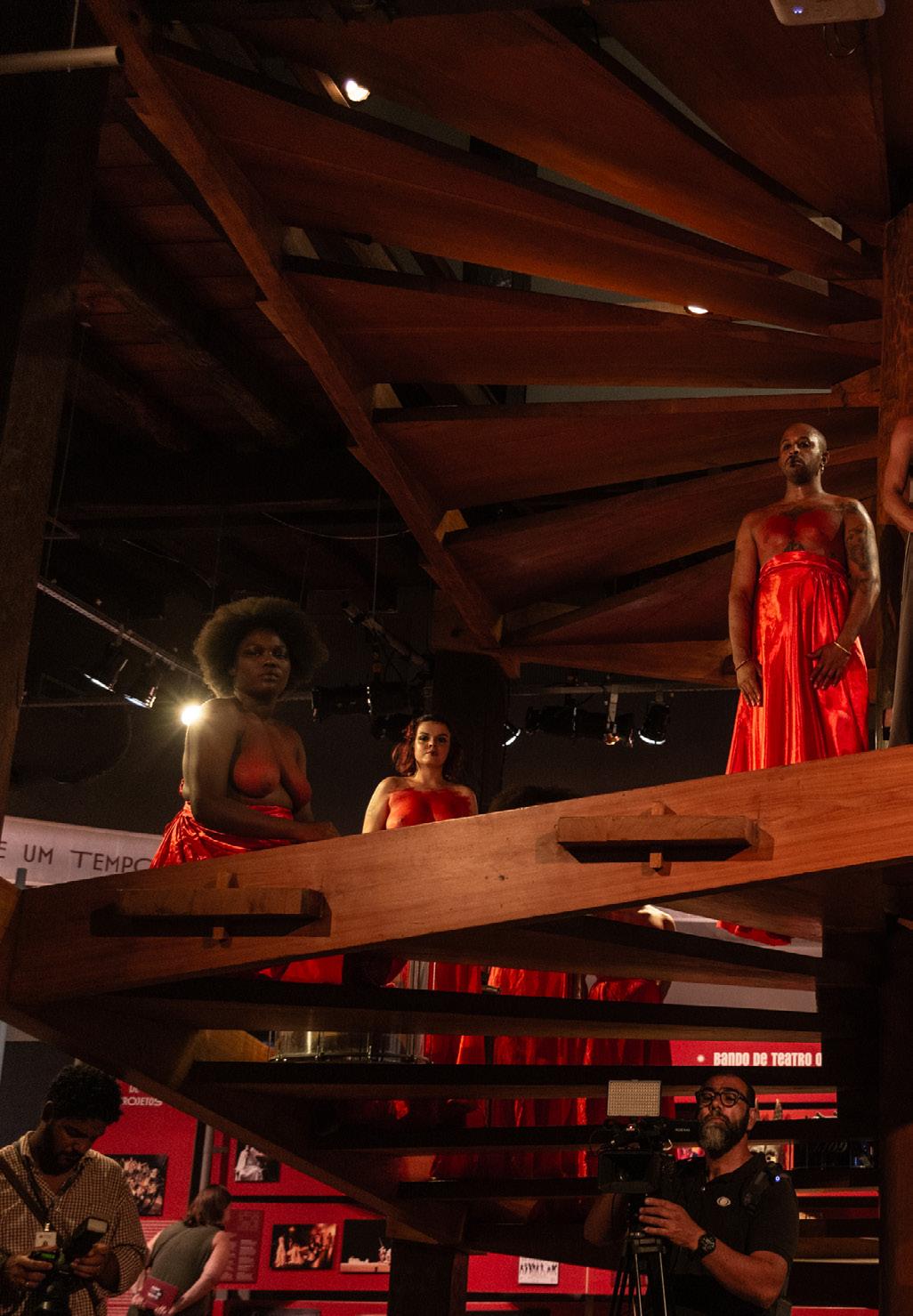
performance de abertura da exposição com a Universidade LIVRE do Teatro Vila
Foto:
Velha, Ariel Ribeiro e Loiá Fernandes
Escada de Lina Bo Bardi — Museu de Arte Moderna da Bahia
Maiara Cerqueira
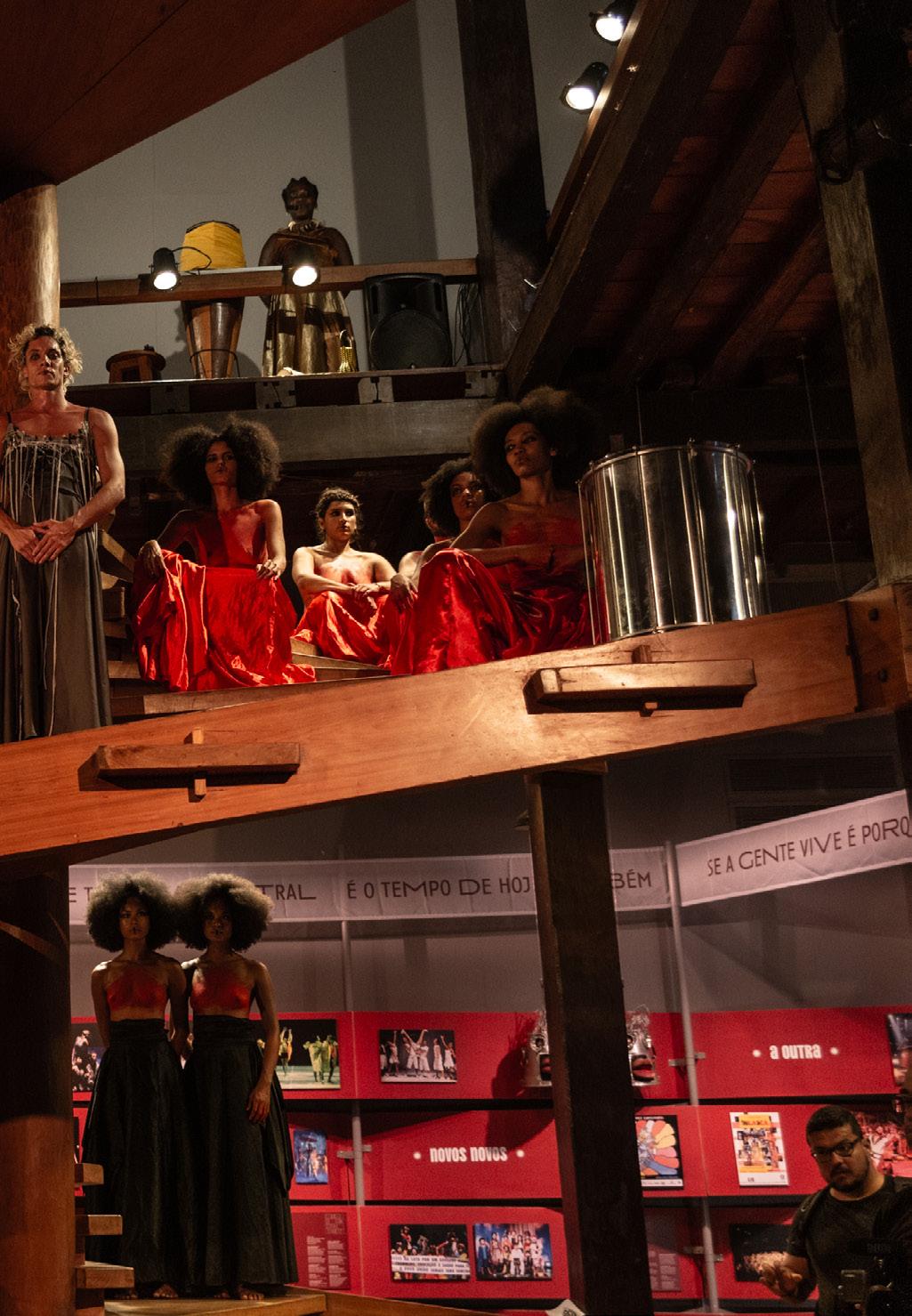
–
60
vElha, poR exEMplo
aNos de uM teatRo do BRasiL
Makota Valdina, em depoimento incorporado à narrativa de Bença1, nos disse: “Vocês pensam que estão sozinhos quando estão no palco? Não… tem muita gente aí com vocês”. É sobre isso a exposição Vila Velha, Por Exemplo – 60 Anos de um Teatro do Brasil. Muitas pessoas passaram por essa espiral do tempo, que permanece enquanto experimentamos o intervalo desta vida, e continuam em memória, energia e inspiração em suas voltas. A tarefa maior da curadoria foi optar pelo que não entraria na exposição, apesar da importância de sua passagem na história desse teatro. Algumas coisas foram deixadas de fora por falta de documentos no arquivo do Vila e impossibilidade de localizar, em outros acervos, o que faltava, enquanto preparávamos os recortes. Outras, porque foi difícil conseguir liberação e autorização para incluí-las na exposição, devido ao apego que alguns têm por seus documentos. Outros ainda por absoluta falta de espaço no grande salão do MAM para conter tantas ações, projetos, batalhas, artistas, nomes, coletivos, objetos, sonoridades, movimentos.
A decisão curatorial foi contextualizar este teatro no Brasil e na cidade de Salvador: a existência do Vila Velha antes do prédio e a construção deste prédio; suas fases, seus momentos de crise, seus momentos de brilho. O que ficou claro a partir daí foram as convergências de momentos históricos e fases do teatro: o surgimento da Sociedade Teatro dos Novos e a ideia do Vila Velha coincidem com um momento de desenvolvimento econômico e florescimento cultural e artístico da Bahia. Sua construção e inauguração, quatro meses depois do golpe civil-militar que instalou uma ditadura no país, dizia que, enquanto portas se fechavam encerrando pessoas que ousavam pensar, discordar e lutar, surgia um palco onde a democracia, a
liberdade e a defesa da justiça eram sua razão de ser. Onde a liberdade é uma parceira constante orientando caminhos.
Em 1968, quando é promulgado o AI-5, também há uma lacuna na produção do Teatro dos Novos, construtor do Vila. O AI-5 marca um momento de virada mais violenta no país, e é quando uma parede do teatro cai com as chuvas torrenciais que desabrigaram em torno de sete mil pessoas na cidade. A reconstrução acontece ao mesmo tempo em que o Teatro Livre da Bahia segura o bastão entregue pelos Novos e segue numa virada mais política, mais militante, apoiando inclusive o movimento pela anistia aos presos políticos.
O fim do AI-5 acontece pouco mais de um mês antes da morte de João Augusto, como se ele pudesse descansar da luta contra um estado de barbárie, porque o fluxo do tempo daria conta de restaurar a democracia. Isso aconteceu e não. Houve a anistia, mas os carrascos que torturaram e mataram em nome do Estado não foram punidos; houve eleições diretas, mas os agentes da ditadura continuaram ativos e atentos. Tudo isso foi sinalizado pelo teatro. Jango – Uma Tragedya, de Glauber Rocha, comemorou os 50 anos do Teatro Vila Velha e sinalizava que a tragédia se repetiria, e não como farsa, mas novamente como tragédia, com a morte de milhares de pessoas pela Covid-19. Mortes que poderiam ser evitadas por políticas públicas consequentes, e não pelo negacionismo e terraplanismo, e não pelo incentivo à violência, nem com cancelas abertas para a boiada, as armas, a milícia passarem. Foi o que tivemos. O Teatro Vila Velha anunciou: A Tempestade Virá e assim foi apresentada a montagem do texto de Shakespeare, em 2019. Algum tempo depois dessa estreia, em janeiro de 2020, a tempestade desabou. As apresentações da peça foram canceladas, o
teatro fechou, o mundo se fechou para tentar conter a pandemia.
Trinta anos antes, no início dos anos 1990, quando o Brasil se recompôs e houve uma certa estabilidade democrática e econômica, um grupo de artistas retomou a ideia original do Teatro Vila Velha. Com o projeto Novo Vila miravam a revitalização e a reconstrução completa do prédio para que pudesse abrigar os novos tempos e novas invenções poéticas em seu palco. Agora não mais frontal, um palco capaz de se transformar a cada montagem, reinventando a relação com a plateia. Uma renovação total, não só arquitetônica. Do prédio original ficaram duas paredes e seu espírito. Um quase condomínio de grupos reinstalou o movimento e o som em suas paredes. E ao longo dos últimos 30 anos, muitos outros artistas e coletivos têm mantido esta labuta de fazer e refazer o caminho que se faz ao caminhar.
A partir de 2022, o Brasil se recompõe, refazse em dignidade e humanidade. O dragão da maldade, mais vivo do que nunca, fortalecido pelo alimento de ódio e iniquidade que recebeu nos últimos anos, revira-se e almeja voar. A luta é muito grande e a arte tem seu papel de guerrear. Nesta reconstrução de país, estruturas precisam ser implantadas e consolidadas.
Em 2024, o Centro Cultural Banco do Brasil instala-se na Bahia, no Palácio da Aclamação, vizinho ao Teatro Vila Velha, e, em sua chegada, estreita os laços com o Vila e propõe patrocinar esta exposição, relato dos 60 anos do teatro, enquanto começa a percorrer seu ano zero em Salvador.
E, neste momento de reconstrução do país, o Teatro Vila Velha prepara-se para mudar a pele novamente. Vai adaptar-se aos novos tempos e adequar-se às novas políticas de acessibilidade. Um espaço sempre acessível como conceito
agora cria, na nova reforma, recursos arquitetônicos que ampliam fisicamente sua capacidade de acolher quem tem alguma dificuldade de acessá-lo.
Um teatro é fruto e espelho de sua época, mas não só tem a tarefa de refletir. Em um teatro também se cria o que não existe, e esta é a sua função maior: criar o que ainda não existe, mas pode acontecer e apontar caminhos, tanto para sinalizar os perigos que podem vir como as possibilidades de evitá-los. Um teatro é um baralho de Tarô, um jogo de I-Ching, um espelho de um tempo espiralar no qual “o amanhã enviou pássaros pra ontem. Quando a gente conhece o passado, a gente trabalha para que haja o futuro. No presente a gente faz, a gente se assenta”2
Salvador, 11 de agosto de 2024
Marcio Meirelles
aPResENtaçãO
Banco do Brasil apresenta e patrocina Vila Velha, por Exemplo – 60 Anos de um Teatro do Brasil, uma exposição que mostra a vida de um teatro construído e gerido por artistas, que se reinventou com a cidade e os tempos.
O Centro Cultural Banco do Brasil (CCBB) será vizinho do Teatro Vila Velha e, a partir desse momento, as duas histórias passam a dialogar, criando um potente parque artístico, junto com outras organizações, no Corredor Cultural do Centro de Salvador.
Enquanto prepara sua instalação definitiva no Palácio da Aclamação, o CCBB já se faz presente na cidade com programação em parceria com diversos espaços culturais, a exemplo do Museu de Arte Moderna da Bahia (MAM), que calorosamente nos acolheu para a realização desta importante exposição.
Ao realizar este projeto, o CCBB reafirma o compromisso de ampliar a conexão dos brasileiros com a cultura e com a valorização da produção cultural nacional. Viva! O CCBB chegou à Bahia.
CENTRO CULTURAL BANCO DO BRASIL
Ressonância é uma expressão oriunda do campo das ciências da natureza, utilizada para definir um sistema de vibrações que se superpõem amplificando as vibrações originais. E inicio esse texto mencionando-a porque ela foi a primeira expressão - e também a primeira imagem - que me veio à mente quando tomei conhecimento da exposição “Vila Velha, Por Exemplo: 60 Anos de Um Teatro do Brasil”, no Museu de Arte Moderna da Bahia (MAM).
Ao abrir as portas de suas instalações para receber esta, o MAM ressoa, no tempo e no espaço, a história de um dos mais simbólicos e significativos equipamentos culturais da Bahia, amplificando o alcance de ambos. Trata-se de uma espécie de metalinguagem cultural: a Cultura falando de Cultura! Um equipamento cultural do Estado da Bahia reconhecendo e reverenciando a grandiosidade do outro.
O Governo do Estado da Bahia, por meio da Secretaria de Cultura, entendendo a importância de reverberar a história do Vila e celebrar os seus 60 anos, vem atuando de maneira a fomentar e articular apoios para que as histórias que marcaram tantas vidas que passaram pelo Vila Velha sejam agora rememoradas. Nesse sentido, é oportuno mencionar o imprescindível apoio do CCBB para que esta mostra chegasse ao MAM com todas as suas possibilidades de ações interativas, mas também educativas.
BRUNO MONTEIRO
Secretário de Cultura do Estado da Bahia
A DOBRA DO TEMPO
parte IV
1994—
NOVO VILA VIRTUAL - COVID 19
Em janeiro de 2020, A Tempestade, de William Shakespeare, do Teatro dos Novos e da universidade LIVRE, estreou. A peça mostrou-se premonitória. Tanto pelo tema – estávamos, todos, próximos de vivenciar uma tempestade na sociedade – quanto pela utilização, em cena, de possibilidades diversas das ferramentas digitais.
Menos de dois meses depois, a Covid-19 foi decretada pela Organização Mundial da Saúde (OMS) como uma pandemia. Isolamento social e restrições de circulação foram necessários. Diante disso, o Teatro Vila Velha, através dos Novos, construiu
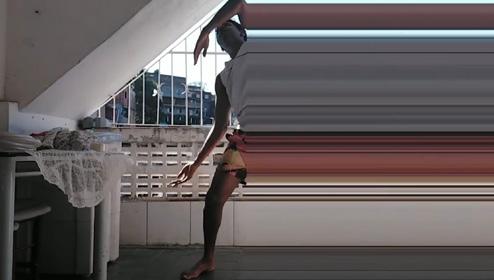
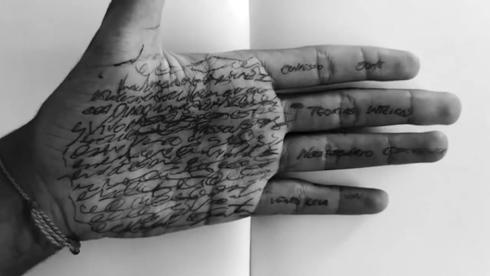
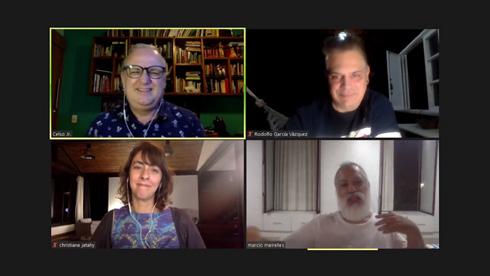
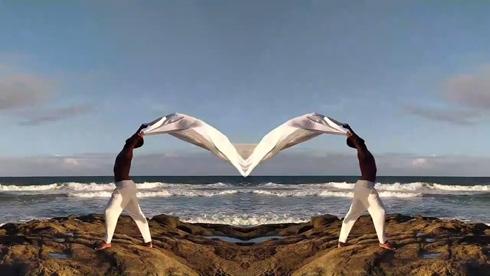
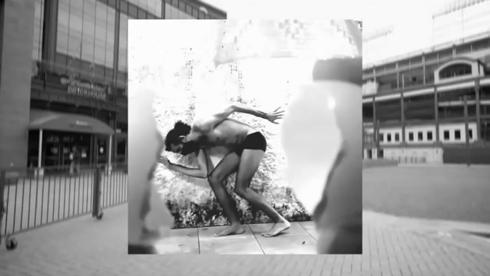
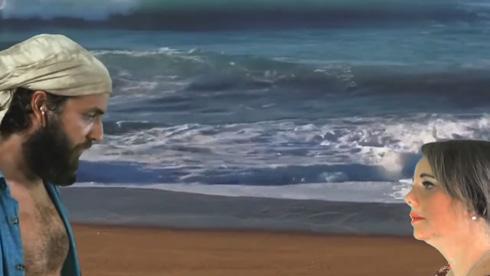
sua primeira peça totalmente virtual, potencializando as experiências de muitos espetáculos com as ferramentas digitais.
Fragmentos de um Teatro Decomposto, com textos do dramaturgo romeno-francês Matéi Visniec e direção de Marcio Meirelles, estreou em agosto com transmissão ao vivo pelo Youtube e atores atuando e contracenando cada um em sua casa. Mais seis espetáculos foram realizados dessa maneira, explorando, cada um, novas possibilidades dessas ferramentas.
O Meia-Noite se Improvisa ganhou versão digital, com artistas participando da Bahia, do Brasil e de outros países. Virtualmente
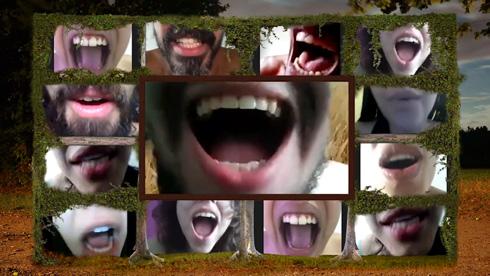
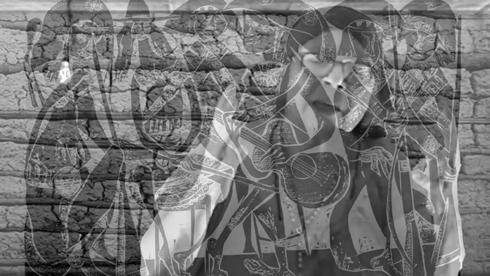
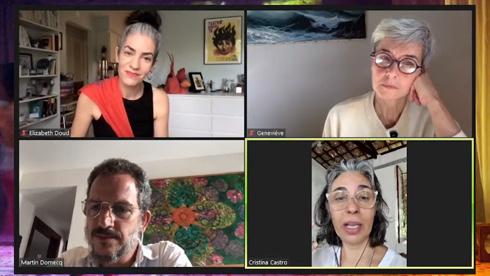
também foram realizadas oficinas artísticas e, em sintonia com o momento, debates sobre a relação entre o teatro e o audiovisual, dentre outros temas. Tudo transmitido virtualmente. Registros de trabalhos anteriores do Vila foram disponibilizados na rede mundial de computadores e duas exposições virtuais construídas.
Desde 1964, quando inaugurado, o Vila nunca parou. Mesmo em tempos de grandes dificuldades, reinventou formas de exercer a arte e disponibilizar sua produção à sociedade. E nem a pandemia de Covid-19 modificou essa postura.
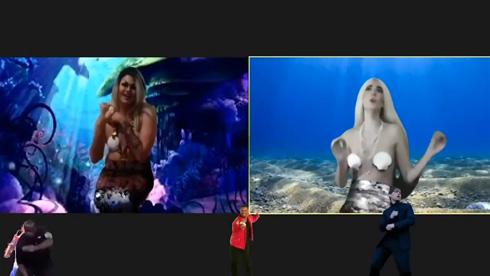
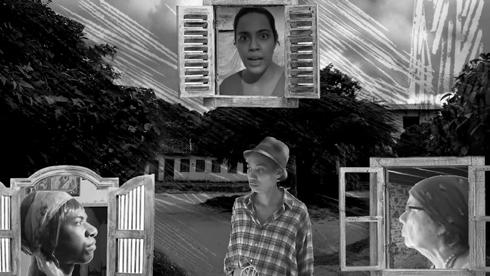
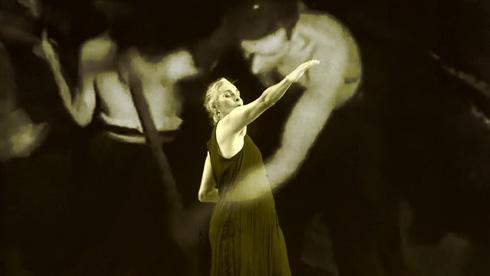
EDSON RODRIGUES
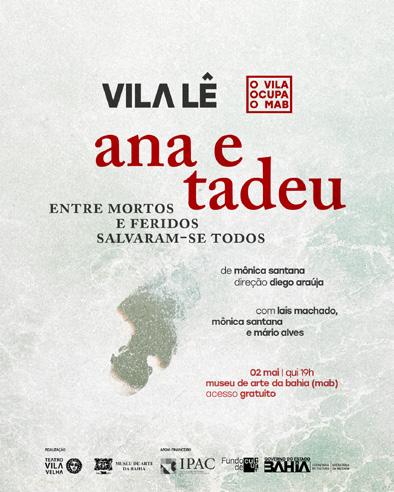
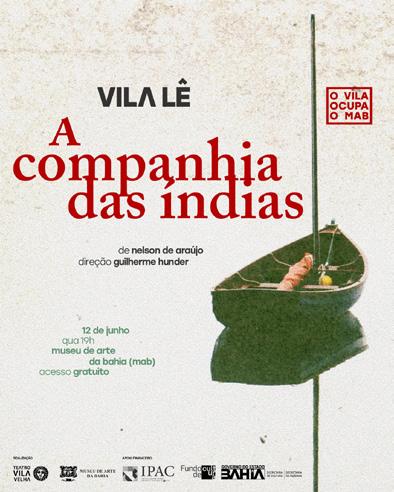
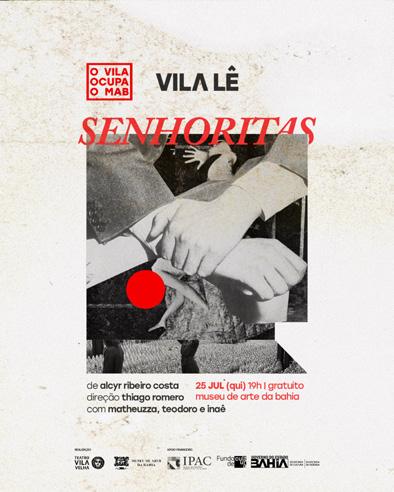

O VILA OCUPA A CIDADE
O Vila começou antes do Vila. Ocupou as praças, os adros de igrejas e os palcos disponíveis nas cidades da Bahia, desde o surgimento da Sociedade Teatro dos Novos (1959) e até a inauguração do prédio do Teatro Velha (1964).
Nos anos 1970, através do Teatro Livre, retornou às ruas com o Teatro de Cordel. E, nos anos 1980, com Echio Reis, voltou a montar autos religiosos nas praças e igrejas.
Entre 2002 e 2004, o projeto Teatro de Cabo a Rabo foi um retorno à circulação. Por três edições, percorreu doze territórios/ cidades da Bahia e promoveu oficinas
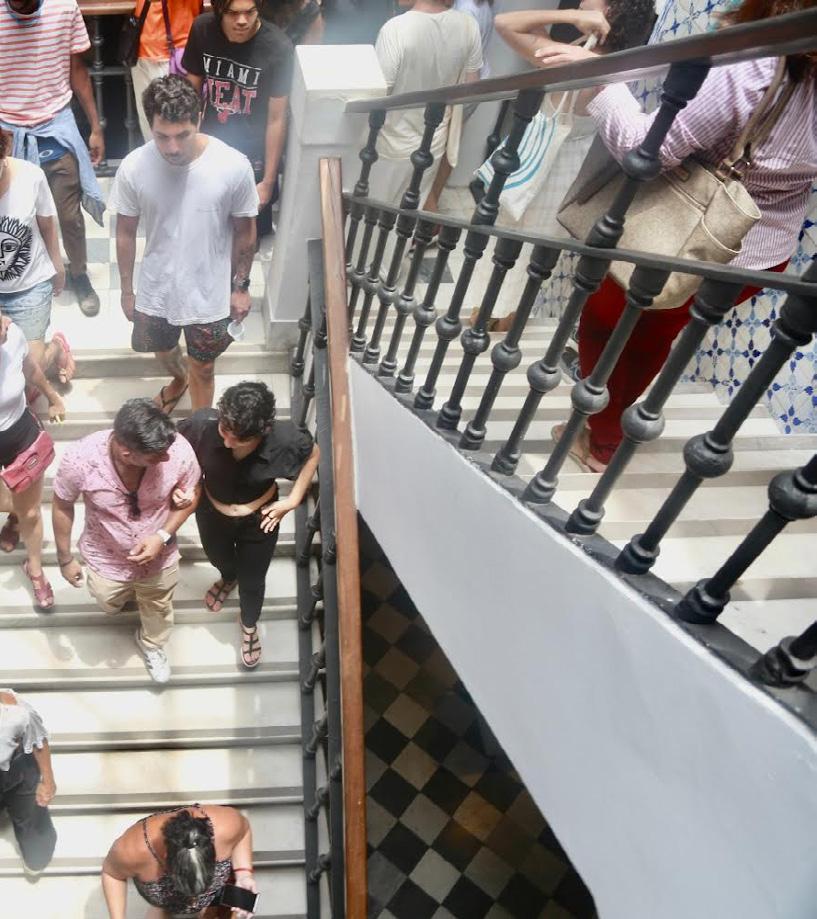

de teatro, dança, produção, iluminação e captação de recursos para projetos artísticos, além de exibição de espetáculos e da promoção da vinda dos grupos para se apresentarem no Vila.
Vivendo atualmente um novo período de recuperação de sua estrutura, surge o projeto O Vila Ocupa a Cidade e, através dele, vêm sendo realizadas ações em diversos locais: Museu de Arte da Bahia, Museu de Arte Moderna da Bahia, Teatro Sesc, Cine Glauber Rocha, Teatro do ICBA, Espaço Cultural da Barroquinha, comunidades e escolas da educação municipal de Salvador. São apresentações de espetáculos e performances, lançamentos de filmes,
oficinas, o festival Vila Lacre (uma mostra da cena LGBTQIAPN+ com artistas locais e internacionais), as leituras cênicas do VilaLê,
A atuação em escolas municipais e comunidades é parte do programa de formação artística e mediação cultural Pé de Feijão - Arte e Educação. Na edição 2024, o projeto também ocupa a cidade com sessões gratuitas de espetáculos, contação de histórias e promoção de encontros com educadores em outros teatros parceiros. EDSON
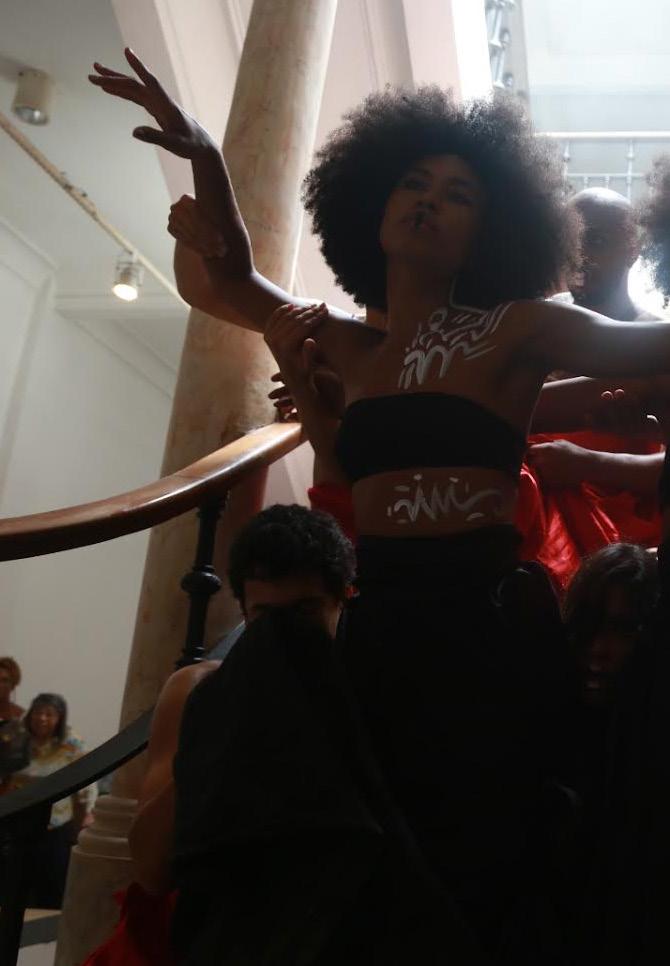
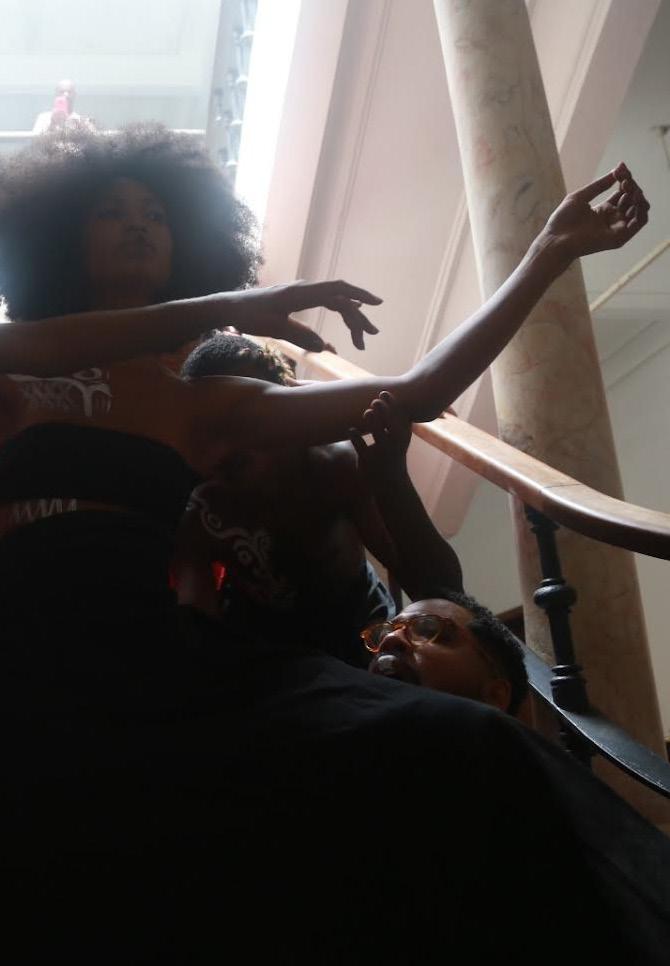
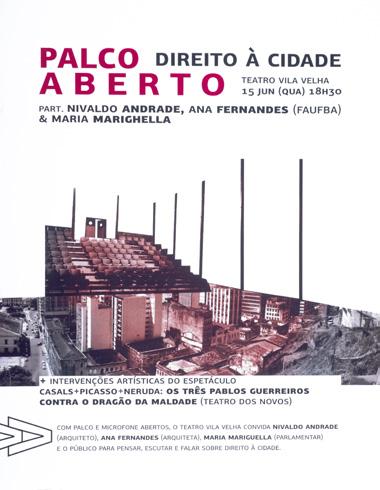
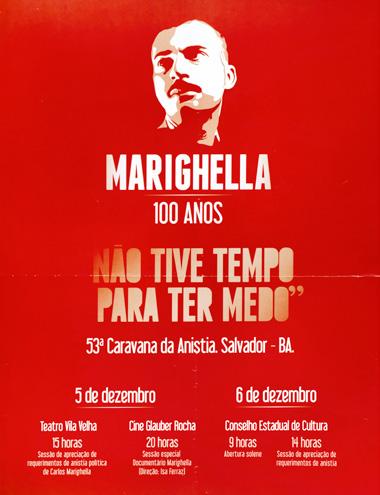

UM TEATRO DE ATUAÇÃO
O Vila Velha é um teatro de atuação, sempre foi assim. Atuação na ampla concepção da palavra e isso desde sua gestação, quando um grupo de jovens artistas se rebelou e abandonou a Escola de Teatro da Ufba para constituir uma companhia profissional, a Sociedade Teatro dos Novos, e foi para ruas, praças, comunidades da cidade e de outros municípios com seus espetáculos.
Assim, desde sua construção e inauguração em 1964, quatro meses depois do golpe militar que causou uma ruptura no processo democrático, até sua existência agora, o Teatro Vila Velha é um ato político.
Deve-se a essa postura o seu nome ser Vila Velha, em homenagem à cidade anterior a Salvador, em vez de Teatro dos Novos; como também sua inauguração com 12 espetáculos que mostravam a diversidade cultural da Bahia, sendo o primeiro uma apresentação da Escola de Samba Juventude do Garcia, em vez de uma peça do grupo, que só viria a estrear quatro meses depois: Eles Não Usam Bleque-Tai, texto sociopolítico de Gianfrancesco Guarnieri com direção de João Augusto. Uma postura que é uma marca, uma ousadia, um manifesto.
Durante o período da ditadura, o Vila recebeu reuniões clandestinas para a reorganização do movimento estudantil e no teatro foram realizados festivais de arte e música com esse fim. Também sempre acolheu artistas e os apoiou na missão de divulgar de forma livre suas ideias. Como quando, em 1971, foi para onde elenco, técnicos e público da peça Senhoritas se dirigiu, em protesto, após serem espancados pela polícia, quando encerrado um ensaio aberto realizado no Teatro Castro Alves. Em tempos de escancarada repressão, o texto havia sido censurado para todo o território nacional. Álvaro Guimarães, diretor da montagem, organizou o ensaio aberto e pretendia promover uma discussão sobre censura ao final da apresentação. Mas, terminado o ensaio, a sala foi invadida por policiais que, de forma violenta, levaram todos os presentes à delegacia de polícia. Quando liberados, foram para o Vila e lá realizaram um protesto que repercutiu por todo o país.
Quando emergiram movimentos pela anistia, entre 1978 e 1979, o Vila foi lugar de debates e apoio para arrecadar fundos para as diversas iniciativas realizadas na Bahia em favor da liberdade e exigindo retorno daqueles que foram exilados.
Em 1995, o teatro não se calou frente às ameaças ao povo Kiriri em Mirandela, no município de Banzaê, e realizou uma semana de atividades com artistas indígenas e soteropolitanos para dar visibilidade ao que acontecia.
Criou, com o Bando de Teatro Olodum e a Cia. dos Comuns, o Fórum Nacional de Performance Negra, onde foram propostas políticas públicas para a cena preta. Também criou o festival A Cena Tá Preta depois de ter comprado a briga de oferecer meia-entrada para negros no Cabaré da RRRRRrrrrraça, peça do Bando.
Desde a década de 1960, desfiles e eventos artístico-culturais LGBTQIAPN+ têm espaço no Vila, como o Miss Universo Gay, realizado anualmente por Bagageryer Spilberg. E como os Novos trouxeram a Juventude do Garcia ao teatro, o Vivadança Festival Internacional trouxe a Batalha de Break para o palco dessa casa das artes e da liberdade.
O projeto Teatro de Cabo a Rabo reuniu, no Teatro Vila Velha, grupos de outros municípios, que visitou por meio do Teatro dos Novos, mais uma vez circulando pela Bahia. Esses grupos tiveram a oportunidade de participar de projetos e mostras no Vila, apresentando suas produções. E, com O Que Cabe Nesse Palco, outro projeto, o Vila trouxe grupos amadores da periferia e do centro de Salvador e da Grande Salvador para encontros, oficinas e apresentação de suas produções.
O Teatro Vila Velha foi escolhido para ser o local dos julgamentos e aprovações das anistias políticas (post-mortem) dos grandes brasileiros Glauber Rocha (2010) e Carlos Marighella (2012). Foi no Vila que ambos foram absolvidos e suas famílias ouviram do Estado brasileiro um pedido formal de perdão.
As ações cidadãs do Teatro Vila Velha são numerosas. O Movimento Desocupa Salvador mobilizou a cidade, em 2012, e promoveu, no Vila, discussões sobre o uso do solo urbano. E, um ano depois, estenderam-se ao Vila os encontros do Movimento Passe Livre, realizados no Passeio Público. Já em 2014, o Vila criou o projeto Palco Aberto, que promoveu discussões no momento em que se pressentia um novo golpe, que realmente veio a acontecer com o impeachment de Dilma Rousseff, em 2016.
Em 2020, com a pandemia de Covid-19, o Vila não aceita a imobilidade e alarga o uso de ferramentas digitais, produzindo espetáculos, oficinas, debates e disponibilizando conteúdo crítico, e também por vezes de puro entretenimento, em momento social de grande tensão.
Em 2024, o teatro restringe a atuação em seu prédio devido às obras de reforma. Mas outra vez se nega a parar. Com o projeto O Vila Ocupa a Cidade vem realizando suas atividades em vários espaços de Salvador. E assim será até a sua reabertura, totalmente reformado e requalificado, no primeiro semestre de 2025.
O Vila Velha é um teatro de atuação, sempre foi e sempre será assim.
EDSON RODRIGUES
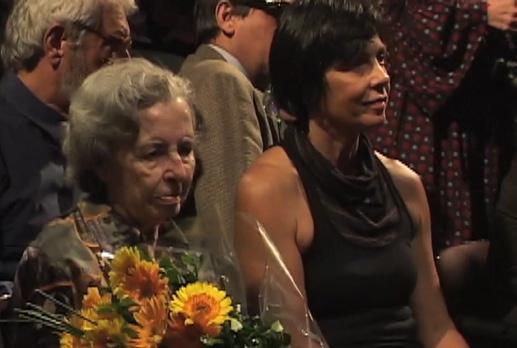
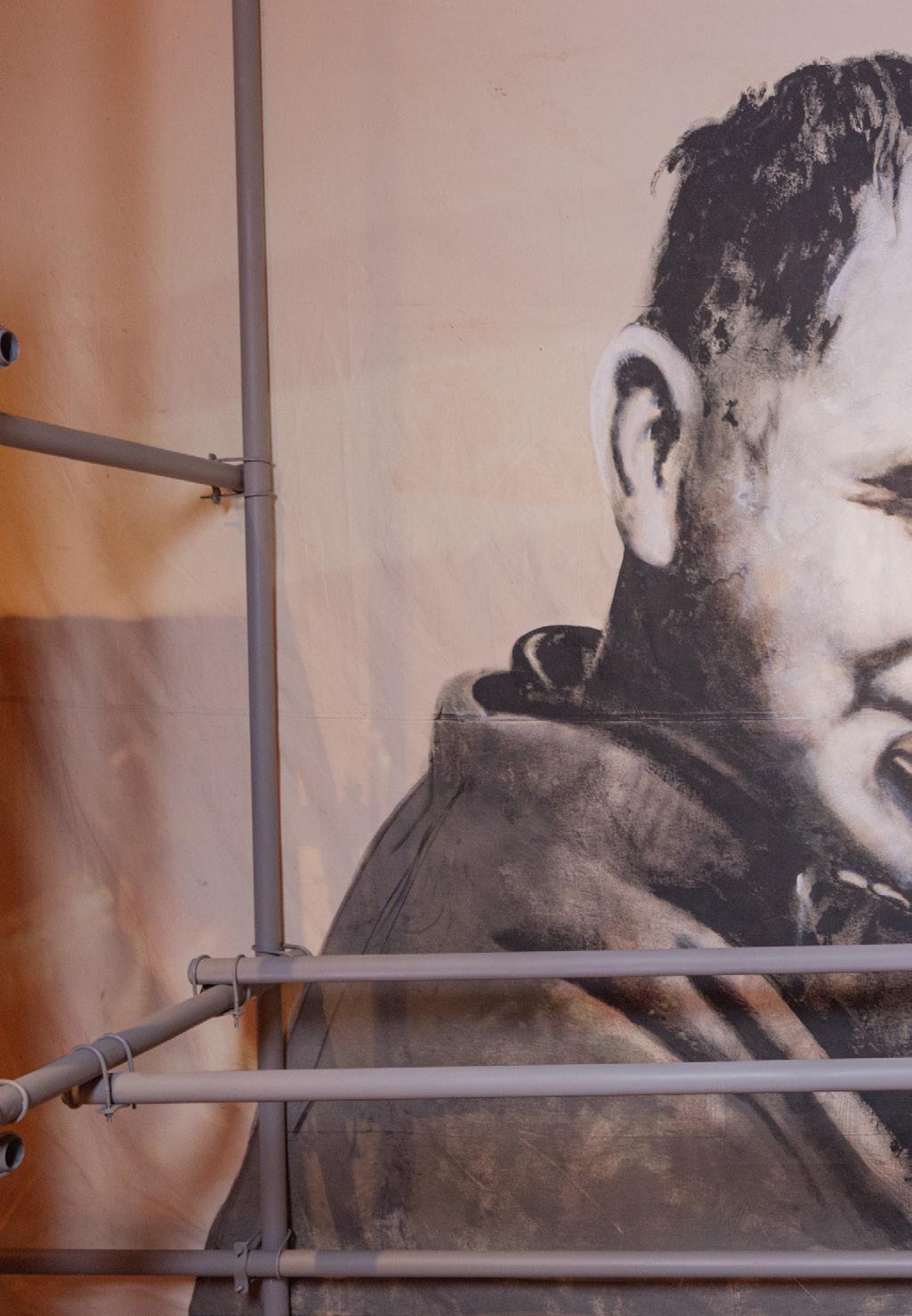
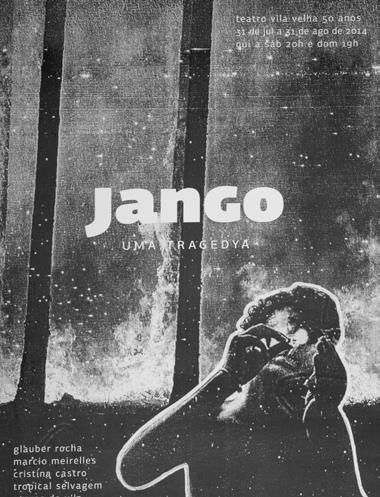
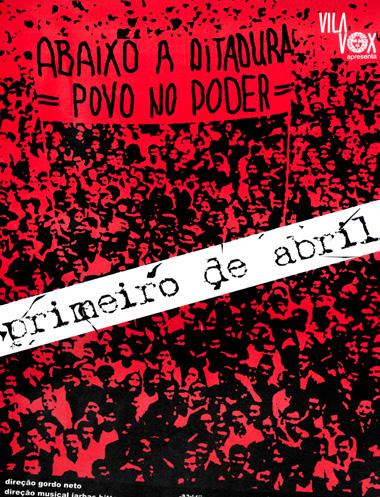
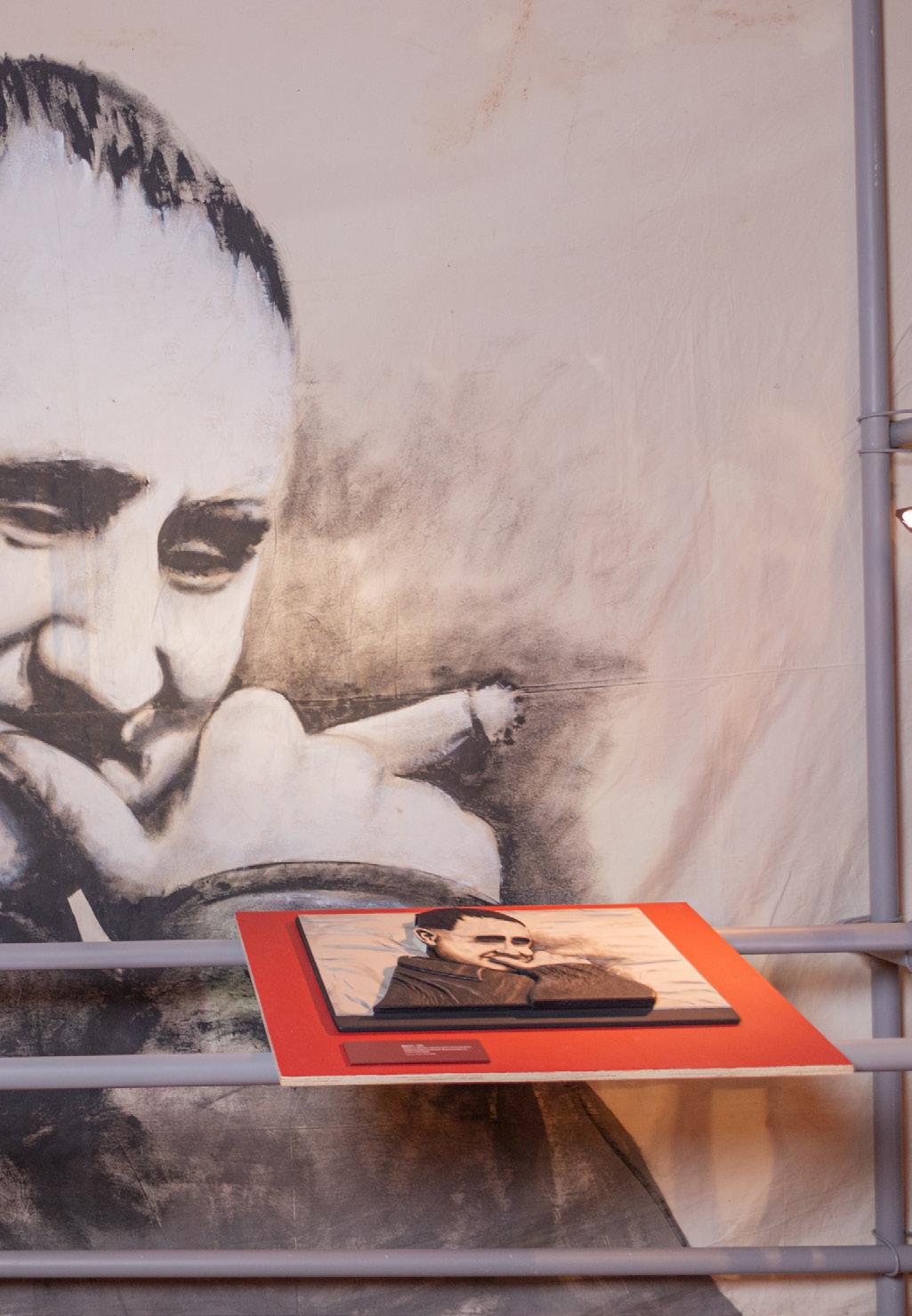
VISUALIDADES
Somos povos de trajetórias, não somos povos de teoria. Somos da circularidade: começo, meio e começo. As nossas vidas não têm fim.
(Antônio Bispo, 2023)
Em composição coletiva, colaboramos eu, George Teles e Joyce Delfim com o que viemos a chamar de uma curadoria de visualidades. A construção dessa narrativa, que se desenrola por imagens – sejam elas fotográficas, pictóricas ou gráficas –, foi feita a partir de uma pesquisa assentada no diálogo, um processo em que a oralidade foi o fio condutor das escolhas curatoriais; partimos de relatos, arquivo vivo.
Ao propor uma conversa com as obras do acervo do MAM-BA, abraçamos essa casa-nau que nos acolhe, mapeando uma constelação de obras que se sobrepõem à narrativa progressista estampada nos jornais que lambem as paredes do Casarão. Algumas dialogam mais diretamente com eventos que aconteceram no teatro, outras são indícios contemporâneos dos gestos grafados na cidade, e assim comunicam a porosidade do corpo-celeste do Teatro Vila Velha. O que nos ensinam as contradições propostas pelo contradiscurso polifônico dessas obras?
O desenho expográfico no Casarão, que a fala de Makota Valdina delineia em espiral – Tempo é Vento, Vento é Tempo –, propõe a suspensão de uma perspectiva linear, ao mesmo tempo em que incorpora a metáfora do sistema solar. Podemos pensar a Galeria 3 como um satélite em fase crescente, apontando para os futuros em construção do corpo expandido deste teatro que hoje ocupa a cidade.
LIA CUNHA

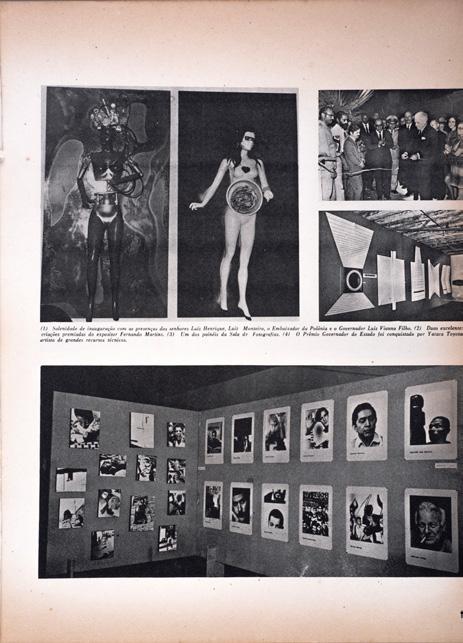
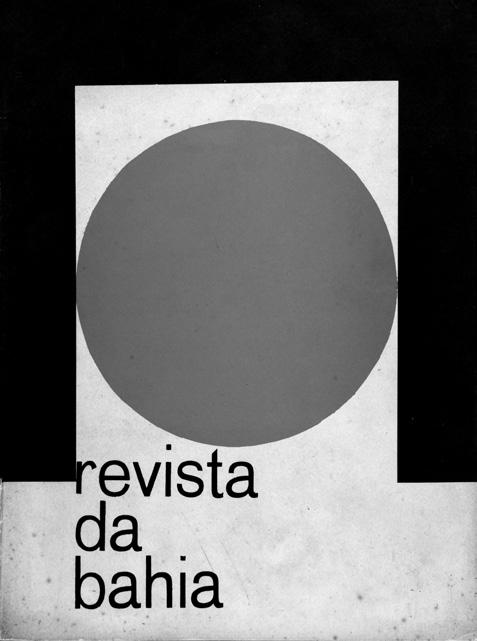
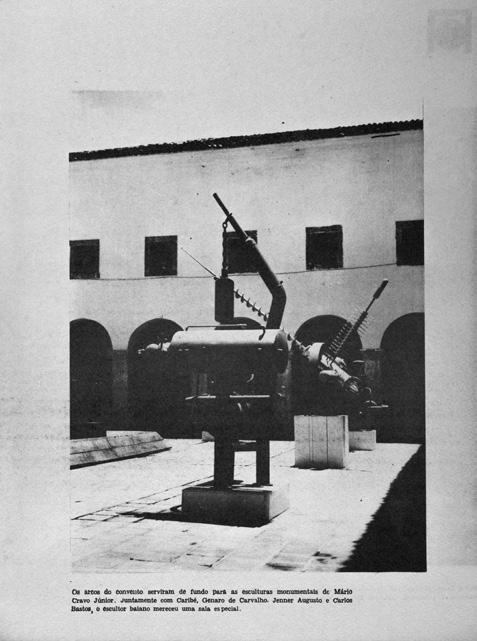
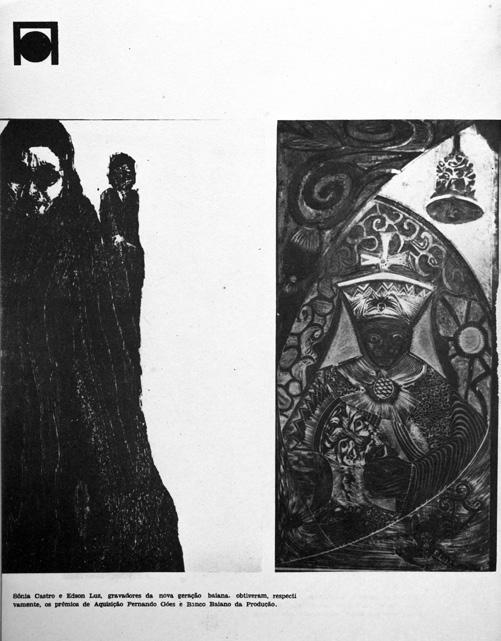
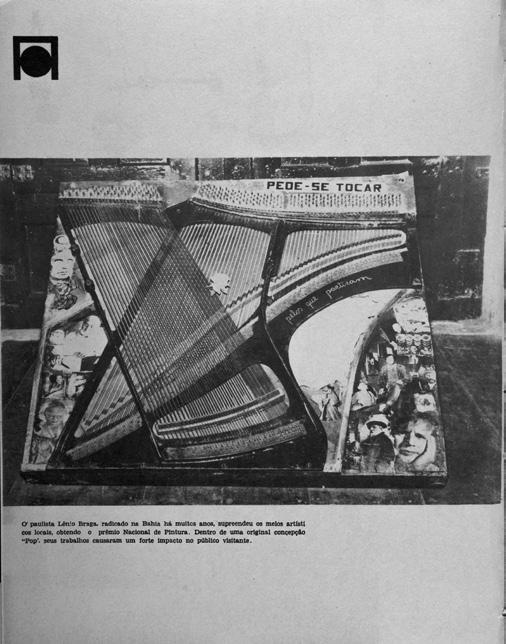
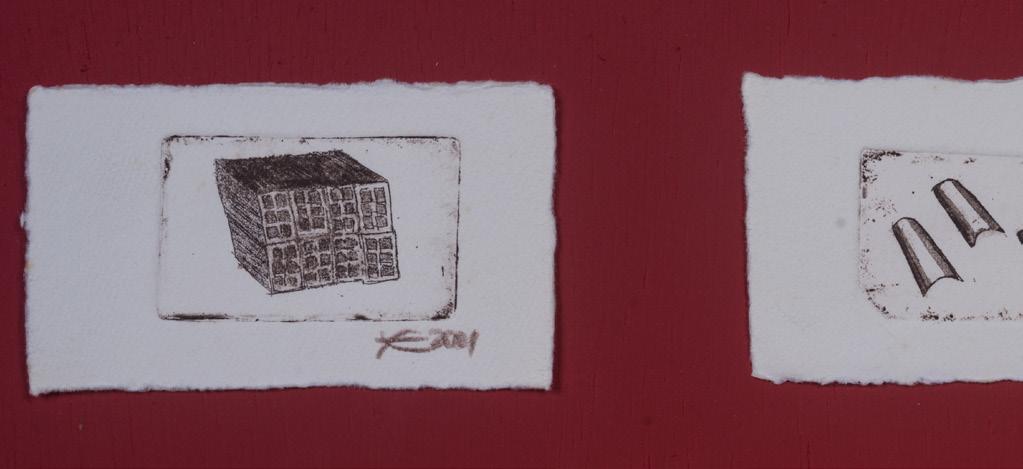
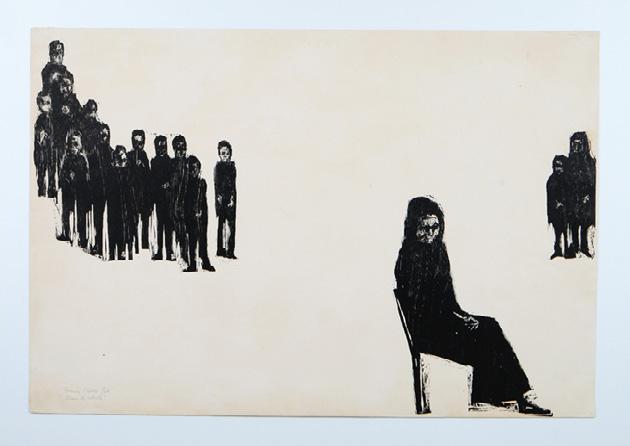
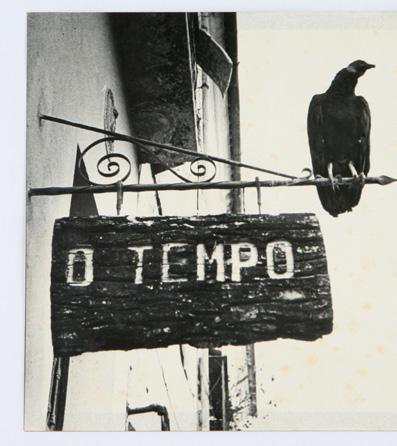


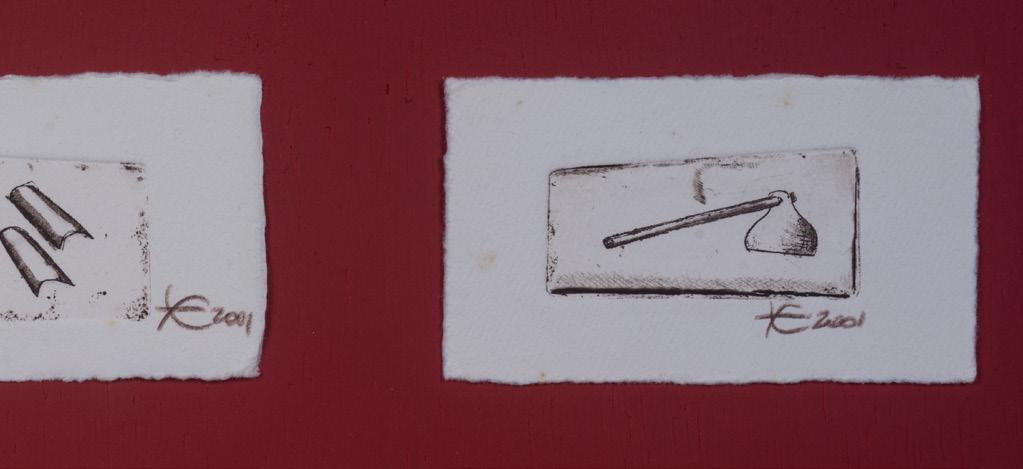
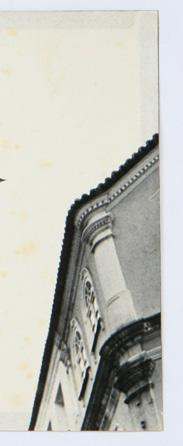
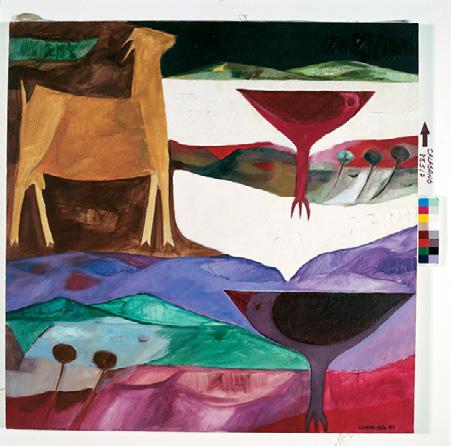
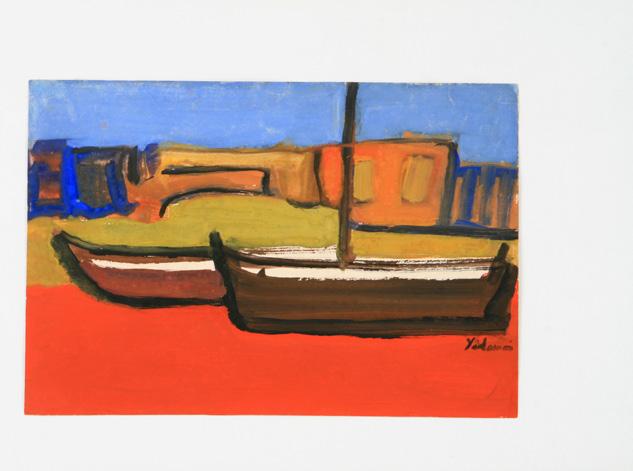
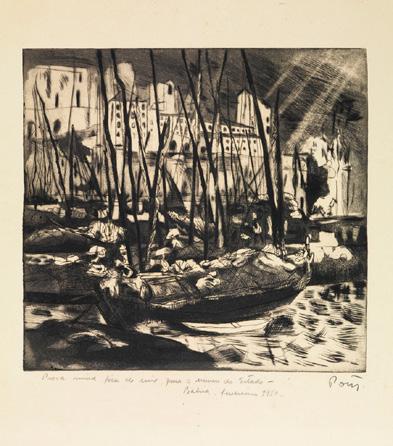
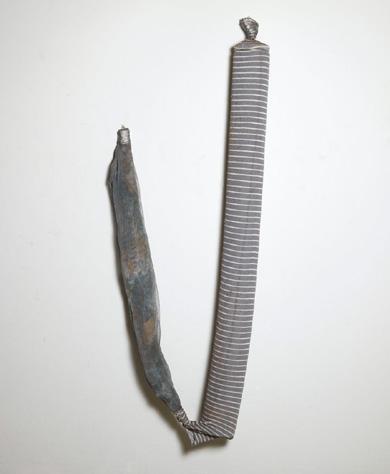
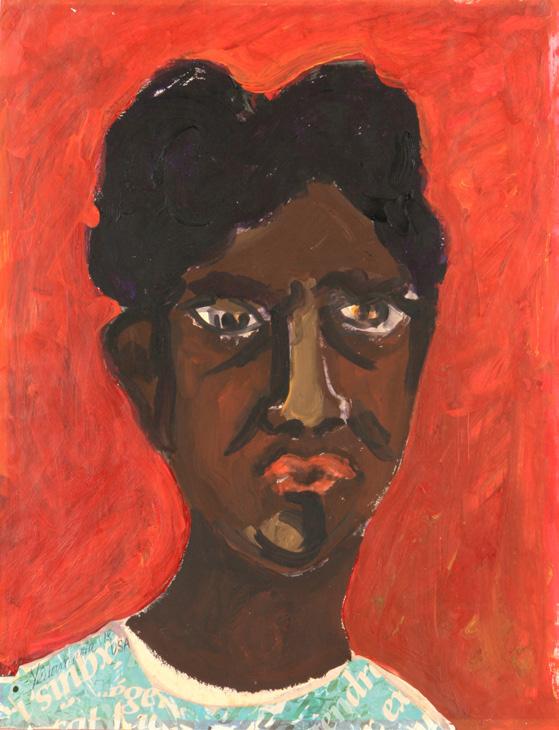
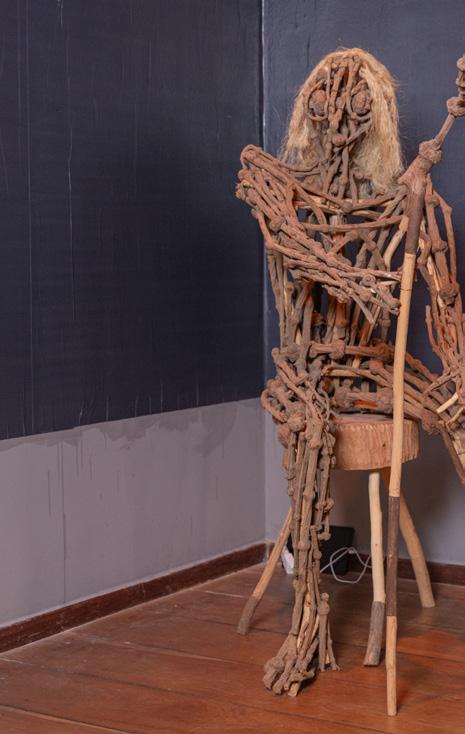
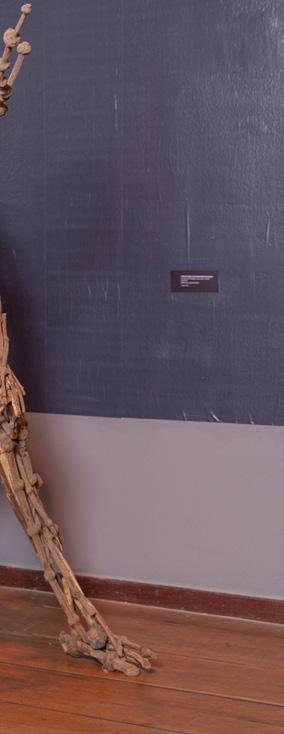
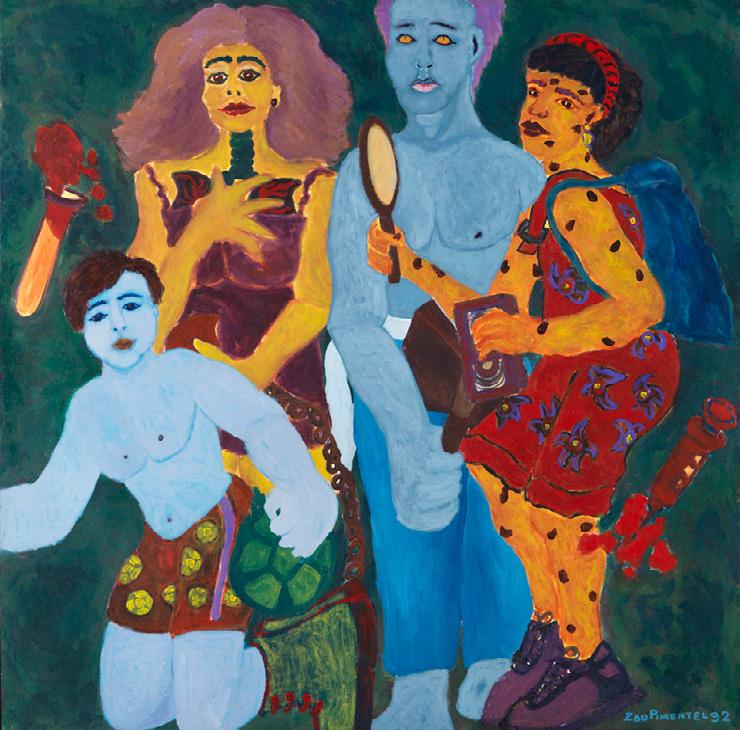
452
453

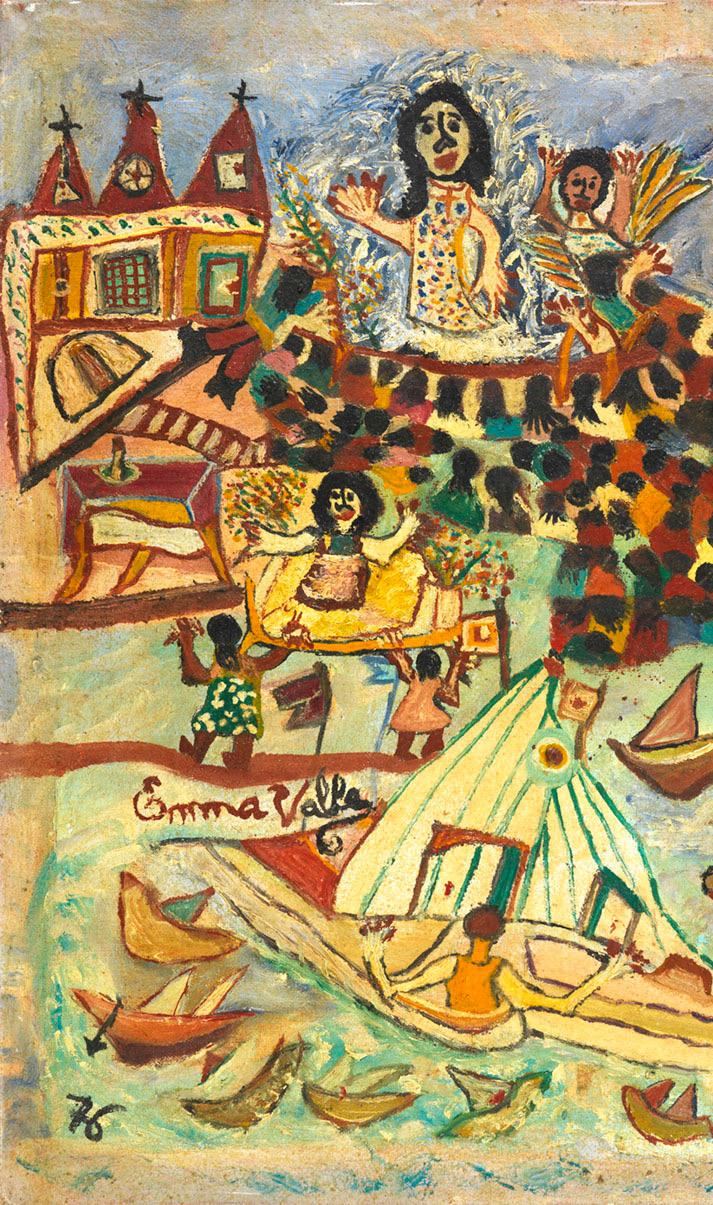

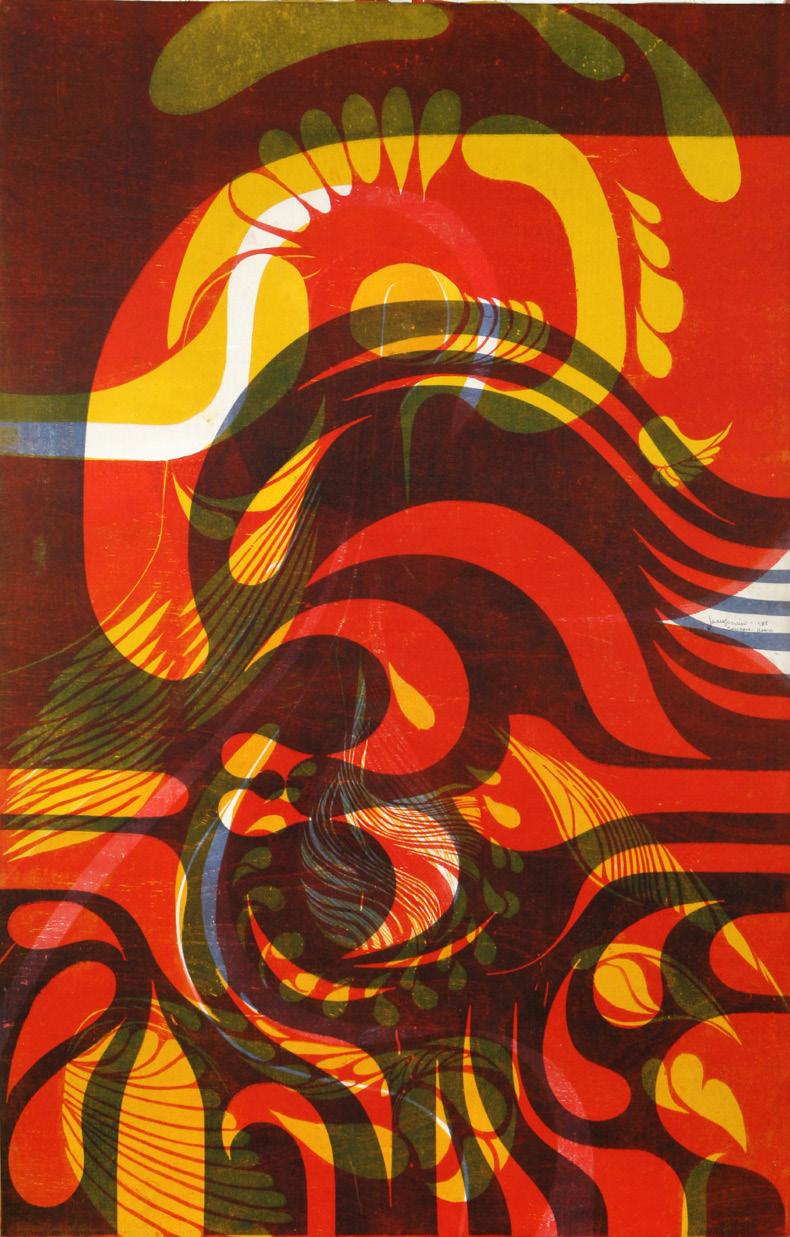
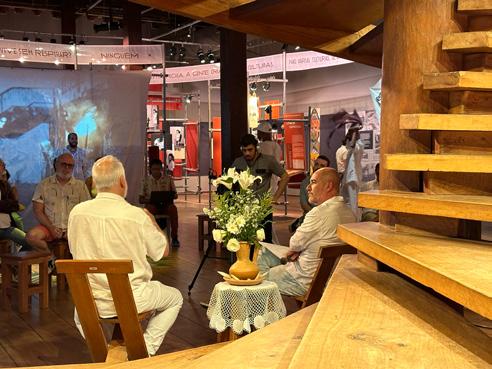
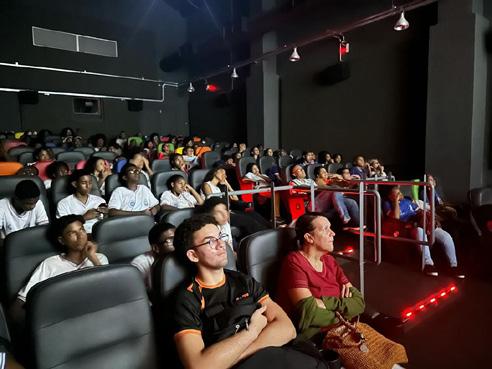
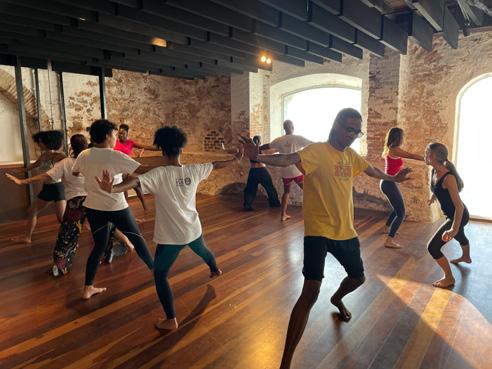

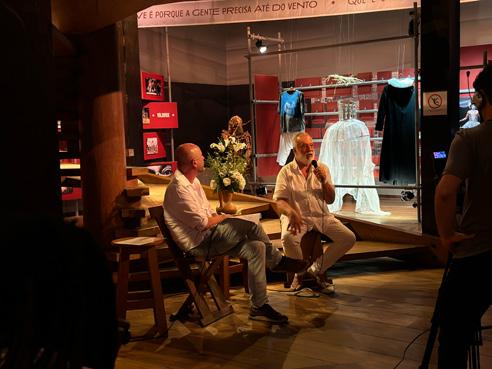
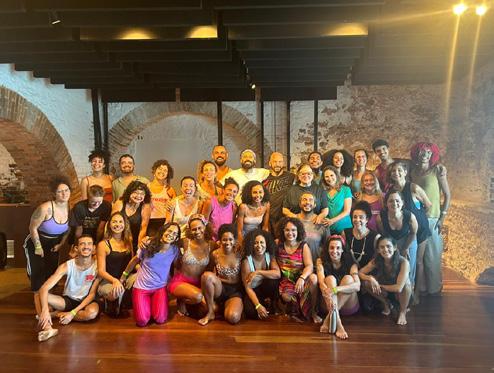
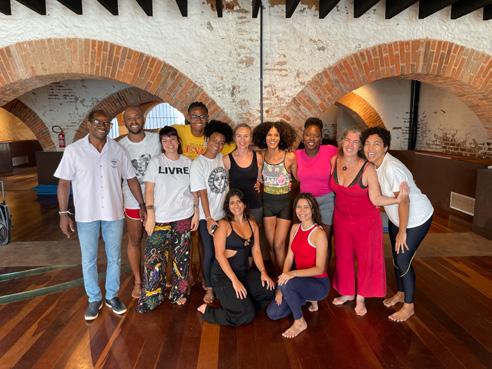
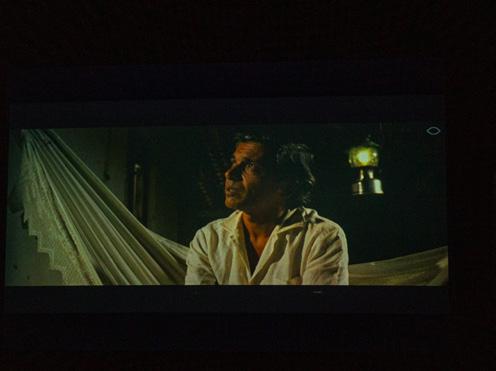
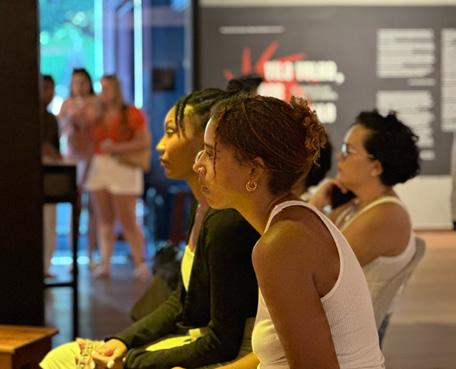
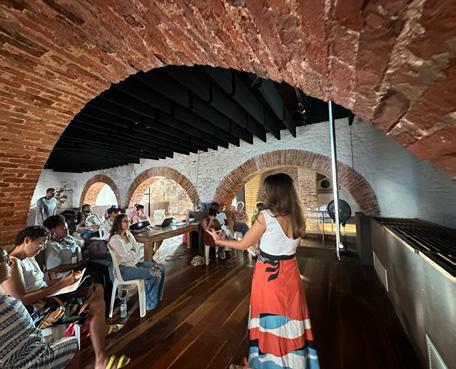
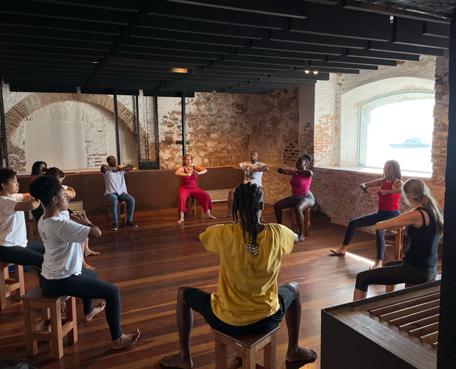
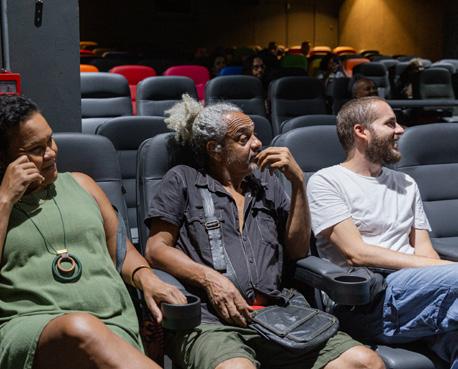
AÇÕES/ EDUCATIVO
TROCA DE SABERES:
Encontros continuados em mediação cultural com temas sobre acessibilidade, cuidados ambientais em acervo de papel, formação de público, além de oficinas práticas de teatro, dança e artes visuais.
História e Memória do Teatro Vila Velha, com Marcio Meirelles
02/09 - 14h às 17h | Local: Teatro Vila Velha
Encontro entre a equipe de mediadores do MAM e do Teatro Vila Velha, formada pelos integrantes da Universidade Livre, para um diálogo com Marcio Meirelles sobre as memórias do acervo do Teatro e as escolhas curatoriais que compuseram os eixos narrativos da exposição.
Educativo no Museu, com Lucia Manisco 09/09 - 14h-17h | Local: Oficinas
Encontro sobre a história do Museu de Arte Moderna da Bahia e o papel dos mediadores nos espaços expositivos. Foram discutidas práticas e estratégias de atuação da equipe de mediadores e possíveis caminhos de leitura (focada em interesses do público) da exposição.
Acessibilidade, com Marina Baffini e Iracema Vilaronga
13/09 - 16h-18h | Local: Casarão
Encontro sobre acessibilidade, obras acessíveis e orientação para mediação de pessoas com deficiência na exposição. As pessoas mediadoras TVV-MAM puderam tirar dúvidas e discutir práticas para incluir pessoas com diferentes necessidades, promovendo um ambiente mais acolhedor e inclusivo na exposição.
Museologia, com Rogério de Sousa e Valdete Moreira
16/09 - 14h-17h | Local: Arcadas
Encontro focado nos princípios da museologia contemporânea e o papel do museólogo no acervo do Museu. A atividade propôs uma discussão sobre a relação do público com a história e o acervo, além de compartilhar experiências práticas que enriquecem o aprendizado coletivo.
Cuidados Ambientais com Acervo em Papel, com Vanilda Mazzoni
23/09 - 14h-17h | Local: Oficinas
Encontro sobre a preservação ambiental e os cuidados necessários para a conservação de acervos em papel, focando nas obras da exposição. Os mediadores discutiram a importância de práticas sustentáveis e aprenderam técnicas de manuseio e conservação, visando a proteção do patrimônio cultural.
Mediação e formação de público, com Poliana Bicalho
30/09 - 14h-16h | Local: Oficinas
A atividade explorou as diferentes abordagens e etapas da mediação cultural, além de conscientizar sobre ferramentas criativas e interativas que transformam o processo de formação de público. Poliana, gestora da CRIARE - Mediações Culturais e Educacionais, doutoranda pela UFBA e especialista em Política e Gestão Cultural, trouxe sua vasta experiência como educadora e mediadora cultural. O encontro ofereceu um espaço rico para troca de experiências e práticas, fortalecendo a conexão entre público e mediadores.
Corpo, respiração, ação, com Edith Meric 07/10 - 14h-16h | Local: Arcadas
A oficina de Gyrokinesis ofereceu aos participantes uma experiência voltada para o corpo e a mente. Integrando elementos da natação, dança, yoga, Tai Chi Chuan e ginástica, a prática utilizou exercícios rítmicos e respiratórios para estimular a oxigenação e a plasticidade do sistema nervoso. O foco foi ampliar a amplitude dos movimentos, promover o autoconhecimento
corporal e melhorar a saúde física e mental. A atividade buscou proporcionar novas formas de movimento e bem-estar.
Performer MC: vozes de Resistência e F(r) esta, com Cris Meirelles 14 e 21/10 - 14h-16h | Local: Arcadas
Oficina sobre uma, dentre muitas, estéticas de resistência que surgem quando as velhas e mofadas formas não mais nos cabem nem contemplam. Inspirado no Teatro Hip Hop, e no conceito de atriz/ator MC, no qual a cena é criada a partir do depoimento e da dimensão social da personagem através de rimas, da contundência do discurso e da métrica sobre um beat. A esses aspectos já apresentados somam-se a música popular, as rítmicas brasileiras, as questões do gênero, o humor, a ironia e obviamente a montação, porque numa sociedade cinza e doente brilho é remédio. É na junção desses elementos, presentes no teatro de rua e nos cabarés populares, que surge a/o/e performer MC, conceito e prática que desenvolvemos nesse encontro.
Voz que Canta, Voz que fala, com Manuela Rodrigues 18/11 - 14h-16h | Local: Arcadas
A oficina “Voz que Canta, Voz que fala”, com a cantora e professora de canto Manuela Rodrigues, é um encontro lúdico que utiliza diversos exercícios da técnica do canto como veículo facilitador da fala. Através das melodias e textos das canções, diversos jogos e exercícios são trabalhados no intuito de melhorar a consciência e saúde no uso da Voz falada
Vivências artísticas africanas e a riqueza rítmica de São Tomé e Príncipe, com Marta Espírito Santo e Vanessa Faray 02/12 - 14h-16h | Local: Arcadas
O diálogo convida as artistas Marta Espírito Santo e Vanessa Faray, ambas atrizes e bailarinas, para dividir a sua experiência artística desde São Tomé e Príncipe. A ideia é proporcionar uma troca de conhecimentos que fortaleça as pontes e as raízes entre a cultura brasileira e africana, refletidas principalmente nas expressões artísticas da dança e do teatro.
DANÇA AFRO: caminhos saudáveis e fortalecimento para quem trabalha com público, com Tainara Cerqueira 16/12 - 14h-16h | Local: Arcadas
A Dança Afro da Bahia, tem origens fincadas na cultura Matrizes Africana através das Danças dos Deuses dessa cultura e dos movimentos de tradições populares estabelecidos na cidade de Salvador por povos primordialmente Africanos e depois Afro Brasileiros. A professora de Dança Tainara Cerqueira, oriunda da cidade de Salvador/BA, promove vivências de aprendizado sobre essa cultura da Dança Afro Brasileira. Na perspectiva, é proporcionar o acesso a grandeza da Afro brasileira que é desenvolvida na Bahia e toda riqueza ancestral rítmica, filosófica e de movimentação que ela possui fazendo assim, com que as pessoas identifiquem a naturalidade de relação que essa dança possui com a nossa realidade de vida e como ela interfere na qualidade da mesma.
FALA VILA
Bate-papos com convidados de diferentes campos do conhecimento conversam sobre temas que atravessam a história do Teatro Vila Velha e suas criações.
Memórias de um teatro do Brasil
Convidado: Marcio Meirelles | Mediação: Edson Rodrigues 27/09 - 16h | Local: Casarão
Neste encontro aberto ao público, o encenador e diretor Márcio Meirelles compartilha o processo de curadoria da exposição em comemoração aos 60 anos do Teatro Vila Velha. Juntamente com Edson Rodrigues, eles discutem os desafios e as escolhas que influenciaram a narrativa da exposição, abordando como cada decisão curatorial se relaciona com a história e a identidade do teatro. O encontro também proporcionou um espaço para que os participantes compartilhassem suas próprias experiências e memórias relacionadas ao teatro, enriquecendo a discussão e a reflexão sobre o impacto cultural da instituição.
Arquitetura mutante: um teatro em transformação
Convidados: Nivaldo Andrade e Carl Von Hauenschild | Mediação: Silvana Moura 11/10 - 15h | Local: Arcadas
Com foco nas transformações na arquitetura do Teatro Vila Velha e do seu entorno, esta edição do Fala Vila apresentou a relação do teatro com a cidade e sua história. Desde a sua inauguração em 1964, com o projeto de Silvio Robatto e Alberto Fiúza, o teatro se destacou na arquitetura baiana, mesclando elementos contemporâneos e tradicionais. Em 1994, sob a direção de Márcio Meirelles, uma reforma significativa, projetada por Carl Von Hauenschild, introduziu inovações. A atividade também abordou as novas intervenções planejadas pela Prefeitura de Salvador, apresentadas por Nivaldo Andrade.
Fala Vilinha: Trajetos do fazer teatral com e para crianças
Convidadas: Débora Landim e Marísia Motta Mediação: Poliana Bicalho 18/10 - 16h | Local: Casarão
Poliana Bicalho, Débora Landim e Marísia Motta conduziram um encontro sobre a produção e a feitura do teatro para crianças. A perspectiva de Débora e Marísia, responsáveis pela Companhia Novos Novos, conta com a colaboração criativa a partir das crianças, um teatro que não se faz apenas para elas, mas com elas. Os convidados também puderam compartilhar suas experiências com o teatro na infância e a formação da Cia Novos Novos, que atravessa gerações.
Gestão, mediação e processos criativos: Experiências entre a Bahia e o Ceará
Convidadas: Valéria Pinheiro e Vinício de Oliveira Oliveira | Mediação: Cristina Castro 01/11 - 16h | Local: Casarão
O encontro proporcionou a troca de experiências sobre gestão e mediação cultural, destacando conexões entre a Bahia e o Ceará. O diálogo explorou o papel da mediação na construção de experiências artísticas, enfatizando a importância da colaboração e da troca de saberes. O evento oferece um espaço para reflexão e intercâmbio entre os participantes.

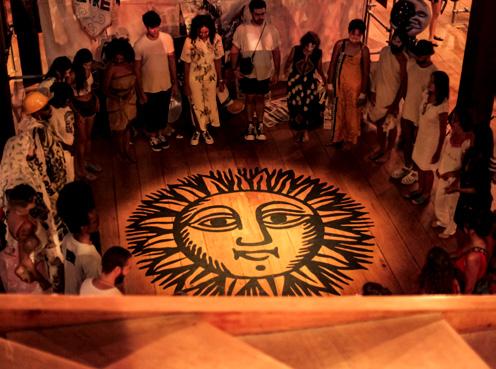
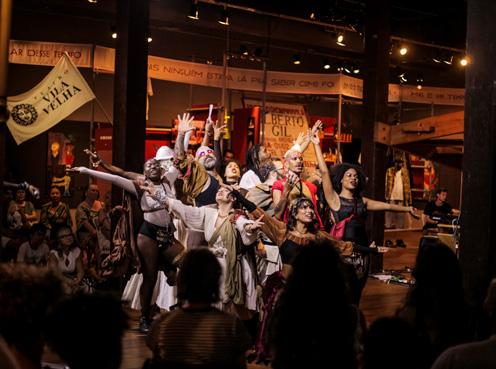

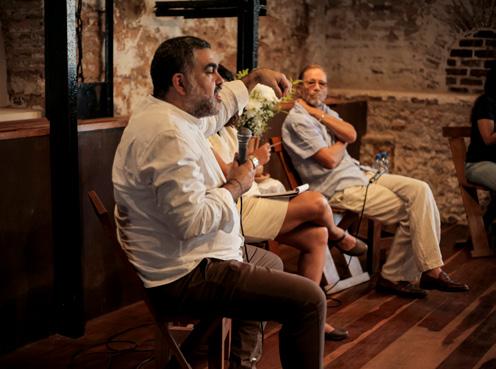
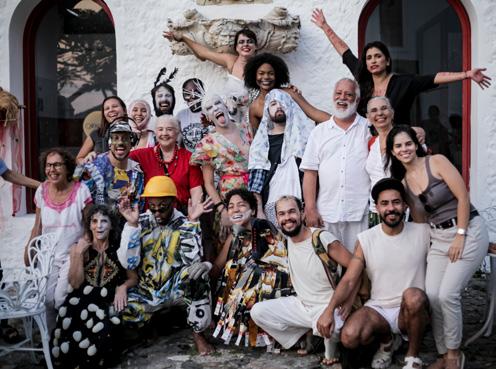
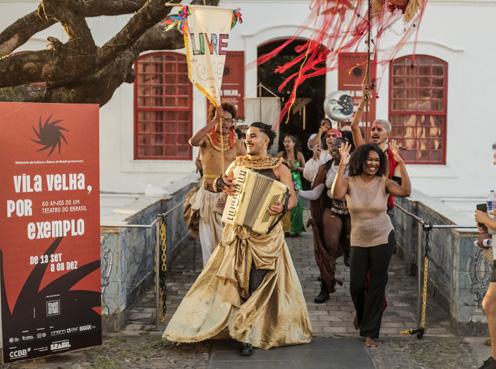
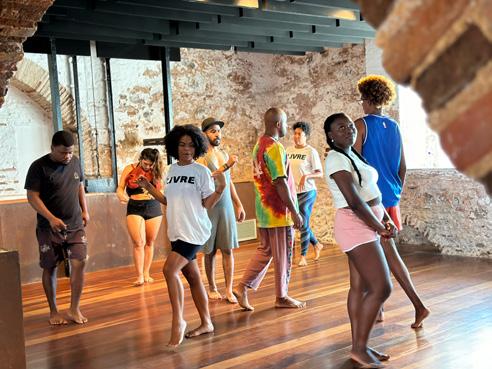
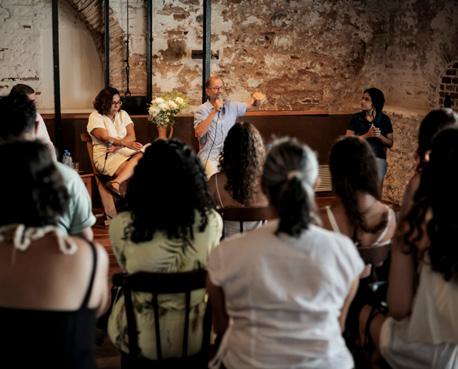
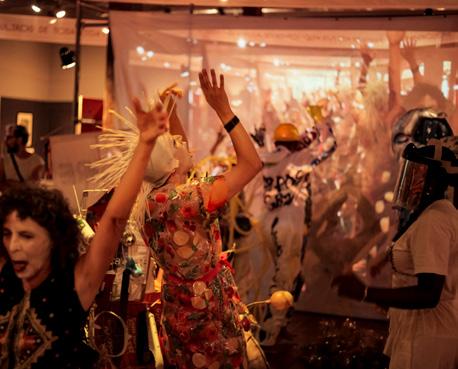
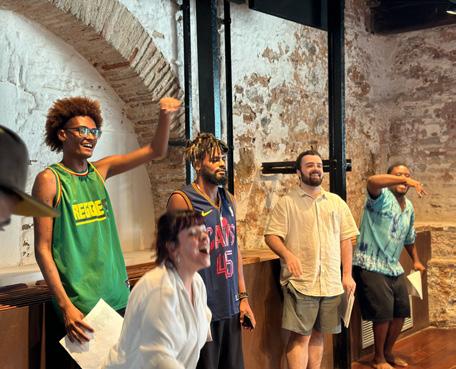
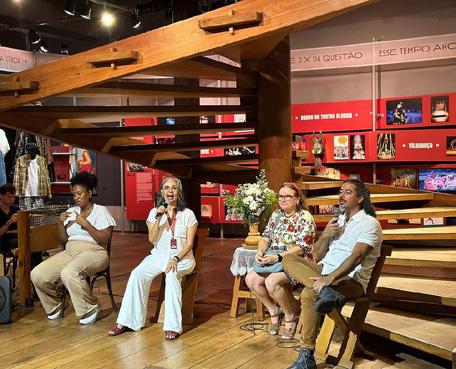
CINE VILA
Mostra de filmes que dialogam com o Teatro Vila Velha e seus artistas.
Placebo (direção Mateus Ribeiro e Wagner Moura) e A Faca e o Rio (direção George Sluizer)
08/10 - 18h30 | Local: Sala de Arte MAM
“A Faca e o Rio” é um candidato brasileiro ao Oscar que aborda o medo do abandono e as complexidades das relações, apresentando a rara participação de João Augusto Azevedo, fundador do Teatro Vila Velha. “Placebo”, dirigido por Wagner Moura e Mateus Ribeiro, é uma adaptação de um conto de Rubem Fonseca e foi filmado no Teatro Vila Velha, reforçando a conexão entre o espaço e seus artistas.
Deus e o Diabo na Terra do Sol (direção Glauber Rocha)
15/10 - 18h30 | Local: Sala de Arte MAM
Dirigido por Glauber Rocha, o filme se tornou um clássico do cinema nacional e teve uma forte conexão com o Teatro Vila Velha e seu fundador João Augusto. O filme traz no elenco Othon Bastos, do grupo fundador do Vila, Teatro dos Novos, e Sônia dos Humildes, grande parceira de João Augusto.
Jango, Uma Tragedya (direção Rafael Grilo) 22/10 - 18h30 | Local: Sala de Arte MAM
“Jango, Uma Tragédia” é a única peça teatral escrita por Glauber Rocha, agora apresentada em uma nova versão dirigida por Márcio Meirelles. A obra mistura as ideias progressistas de João Goulart com o pensamento de Glauber, oferecendo um retrato profundo do Brasil ao abordar temas como política, estética e forças retrógradas que marcaram a história do país. Com direção de Rafael Grilo, essa versão em vídeo, parte das comemorações dos 50 anos do Vila, conta com coreografias de Cristina Castro e músicas criadas por Ronei Jorge e João Meirelles.
A Matriarca (direção Lula Oliveira)
29/10 - 18h30 | Local: Sala de Arte MAM
O filme acompanha seis irmãos separados pelo tempo, reunidos inesperadamente
pelo falecimento da matriarca da família. Durante o velório, eles revivem memórias do passado, e revelações podem alterar o destino de todos. Com parte de sua preparação colaborativa com o diretor Márcio Meirelles, “A Matriarca” foi destaque no Los Angeles Brazilian International Film Festival, recebendo menções honrosas, incluindo uma para o ator Caco Monteiro. A sessão contou com a presença do diretor e de integrantes da equipe e elenco.
O Caipora (direção Oscar Santana)
05/11 - 18h30 | Local: Sala de Arte MAM
Lançado em 1964 e dirigido por Oscar Santana, “O Caipora” mistura terror psicológico com uma crítica ambiental, refletindo sobre a relação entre o ser humano e a natureza. A história acompanha Nezinho, interpretado por Carlos Petrovich, do grupo Teatro dos Novos do Teatro Vila Velha. Para escapar da seca, Nezinho, sua mãe e um irmão menor vagam pelo sertão e conseguem emprego na fazenda de um coronel ambicioso. Ao se apaixonar pela esposa do patrão, enfrenta a hostilidade do capataz, que o rotula como o Caipora, personagem lendário que traz azar. O elenco inclui nomes como Mário Gusmão, Lidio Silva, Jurema Penna e Maria Adélia. A sessão contou com a presença e promoveu o reencontro da atriz Maria Moniz (Maria da Conceição) com o diretor Oscar Santana.
Bando Um filme de (direção Thiago Gomes, Lázaro Ramos)
12/11 - 18h30 | Local: Sala de Arte MAM
Criado em 1990 por Márcio Meirelles, Chica Carelli e o Grupo Cultural Olodum, o Bando de Teatro Olodum se consolidou como um dos mais importantes coletivos de arte do Brasil. Em 2018, o grupo lançou o documentário “Bando, um Filme de”, dirigido por Lázaro Ramos e Thiago Gomes, que resgata os 25 primeiros anos de sua trajetória. Com imagens de arquivo e entrevistas de 42 pessoas, o filme destaca os esforços do Bando em levar a cultura negra a diversos espaços, abordando a ação da arte no combate ao racismo. A trilha sonora inclui canções de espetáculos e composições inéditas.
O Jardim das Folhas Sagradas (direção Pola Ribeiro)
19/11 - 18h30 | Local: Sala de Arte MAM
O filme acompanha Bonfim, um bancário negro e bissexual casado com uma mulher branca e evangélica. Filho de uma yalorixá, ele enfrenta os desafios de viver em uma
Salvador cada vez mais urbanizada, que dificulta sua vontade de criar um terreiro de candomblé. Em busca de um espaço sagrado que respeite a natureza e sua ancestralidade, Bonfim decide construir esse ambiente na periferia. O filme retrata as dificuldades e descobertas desse esforço, que resulta no Jardim das Folhas Sagradas.
Uma Leitura dos Búzios (direção Marcio Meirelles, Rafael Grilo)
26/11 - 18h30 | Local: Sala de Arte MAM
Dirigido por Márcio Meirelles e Rafael Grilo, o audiovisual “Uma Leitura dos Búzios” registra o espetáculo teatral idealizado pelo Sesc São Paulo, com texto de Mônica Santana. A peça revisita o movimento popular de 1798 em Salvador, conhecido como Conjuração Baiana ou Revolta dos Alfaiates. Por meio de temas como a política colonialista e as desigualdades sociais, o espetáculo aborda questões contemporâneas do Brasil, como a manipulação da história, o racismo, a presença da mulher negra e a conexão com as raízes afro-brasileira.
Esses Moços (direção José Araripe Jr.)
10/12 - 18h30 | Local: Sala de Arte MAM
Lançado em 2004, Esses Moços é o primeiro longa-metragem de José Araripe Jr., filmado a partir de roteiro assinado por ele em parceria com Hilton Lacerda. O filme narra a história de Darlene (Chaiendi Santos) e Daiane (Flaviana da Silva), duas meninas que fogem do interior rumo a Salvador. Na capital encontram Diomedes (Inaldo Santana), um homem de idade que perdeu a memória e vive nas ruas. Juntos eles passam a explorar a cidade, formando uma espécie de família informal.
O Outro Lado da Memória (direção André Luiz Oliveira) 17/12 - 18h30 | Local: Sala de Arte MAM
Em 1996, o diretor André Luiz Oliveira começou a pré-produção de um longa-metragem adaptado do livro Viva o Povo Brasileiro, de João Ubaldo Ribeiro, mas as filmagens foram interrompidas por diversos acontecimentos. Anos depois, trechos gravados e cenas de bastidores foram reunidos em um novo projeto, transformando-se no documentário O Outro Lado da Memória, produzido em 2018. O diretor conduz uma investigação poética sobre as causas que impediram a realização do filme, com uma narrativa rica em simbolismo.
RESIDÊNCIAS, APRESENTAÇÕES & INTERCÂMBIOS CULTURAIS
Espaço de compartilhamento de processos propiciados por meio das oficinas, e apresentações de artistas de todo o Brasil e da Universidade Livre.
Ensaio e Mostra de Processo “Rítmica Corporal na Encenação” com OFICCINA MULTIMEDIA (BH)
Ensaio 10/10 - 16h | Mostra 11/10 - 16h | Local: Casarão
O grupo mineiro, conhecido por sua fidelidade à experimentação e ao risco, apresenta o processo criativo por trás de sua vivência teatral. A residência desenvolveu, por meio de práticas coletivas, a percepção do tempo presente e a consciência corporal de músicos, atores, bailarinos e estudantes de teatro. Os participantes realizaram exercícios rítmicos, explorando sons vocais, textos, movimentos e objetos do cotidiano, conectando suas memórias à história do Teatro Vila Velha e sua contribuição cultural para Salvador. Também foram criados carros-instalações, que foram absorvidos ao Casarão do MAM, tornando-se parte do acervo vivo da exposição.
Caravana LIVRE 25, 26 e 27/10 - 16h | Local: Casarão
Uma performance cênico-musical que sampleia textos, histórias e musicalidades do acervo do Teatro Vila Velha em seus 60 anos de rebeldia artística e política. Uma caravana
de atores e atrizes estrangeiros a este tempo, trazem consigo memórias do passado para re-imaginá-las no hoje num ousado show de cabaré. Tudo feito de maneira oracular, onde o público é quem escolhe os caminhos deste show. Com direção de Jaya Batista, direção musical de Cris Meirelles e atuação da universidade LIVRE, o trabalho recria cenas de espetáculos encenados pela universidade LIVRE do teatro Vila Velha. É um convite ao delírio e ao sonho para celebrar o teatro e aqueles que o fazem, uma celebração ao Vila e à universidade LIVRE. O espetáculo tem direção e dramaturgia de Jaya Batista; direção musical, dramaturgia e performer mc: Cris Meirelles; atuação de Ana Valeria, Beatriz Zacharias, Crisley Cruz, Daniel Feitoza, Danielle Landu, Indigo Conceição, Gabriela Wenzel, Evelyn Venet, Stefani Barros e Wilson de França; participação de França Mahin, Gustavo Araujo, Lucas Trindade, Pedro Martins e Vânia Paixão; colaboração dramatúrgica de Gabriela Wenzel; figurino de Wil Carvajal; iluminação de Marcos Dedé; cenotécnica de Joilson Bispo; operação de Som de Thiago Vinícius; produção da universidade LIVRE; assistência de produção de Beatriz Zacharias e Milena Nascimento; interpretação em libras por Taiane Pereira ; arte gráfica de Ramon Gonçalves; comunicação de Amanda Lopes e Beatriz de Paula; Redes Teatro Vila Velha por Jean Teixeira e Comunicação universidade LIVRE por Gabriela Wenzel.
Oficina “Corpo Brincante, um convite ao território ancestral” com Valéria Pinheiro (CE) 29 e 30/10 - 09h às 12h | Local: Arcadas
Oficina de dança e ritmos tradicionais do Ceará oferecida a artistas e interessados em artes do movimento. O foco foi na investigação das possibilidades do corpo por meio de matrizes culturais nordestinas, como côco, maracatu, baião, entre outras, aliando-as a técnicas da dança contemporânea, como contato e improvisação. Os participantes foram incentivados a evocar sua memória corporal, criando uma “dança pessoal” que reflita sua história e identidade.
Residência Internacional “Memórias
Afrodiaspóricas do Sul Global” com Rafael Palacios (Colômbia) 25 a 29/11 - 10h-13h | Local: Arcadas
Uma residência artística realizada com o coreógrafo colombiano Rafael Palácios, fundador do Sankofa Danzafro, e o percussionista William Camilo Perlaza Micolta, destinada a dançarinos. O projeto explora narrativas de dança para a transformação social, enfatizando a importância da história pessoal na interpretação. Durante a residência, os participantes trabalham na descolonização do corpo, construindo narrativas autorreferenciais e enfrentando estereótipos sobre culturas negras, com o apoio de ritmos afro-colombianos e uma estética que valoriza as raízes afro. A residência inicia um novo ciclo de parceria entre o Teatro Vila Velha e o Centro de Dança e Coreografia do Valle del Cauca La Licorera, situado em Cali, Colômbia, importante espaço destinado à criação, formação, intercâmbio, circulação e empreendedorismo cultural da dança colombiana.
Mostra “Memórias Afrodiaspóricas do Sul Global” Rafael Palacios 30/11 - 16h | Local: Casarão
Apresentação do processo da residência artística com o coreógrafo colombiano Rafael Palácios e o percussionista William Camilo Perlaza Micolta.
Oficina Vilerê (Circo para crianças) com Yerko Haupt 5, 12 e 19/10 - 10h | Local: Arcadas
A Oficina de Circo para Crianças oferece uma imersão no universo circense, permitindo que os pequenos vivenciem diversas técnicas de forma lúdica. As atividades incluem malabarismo, acrobacias e poses acrobáticas, promovendo o desenvolvimento da criatividade, equilíbrio e coordenação motora. Conduzida por meio de jogos e brincadeiras, a oficina é adaptada às idades e habilidades das crianças, garantindo um aprendizado divertido e acessível, respeitando o ritmo individual de cada participante.
Mostra Vilerê (Circo para crianças)
26/10 - 10h | Local: Arcadas
A mostra da Oficina de Circo para Crianças segue a proposta da brincadeira e da diversão, além de ser um espaço de protagonismo onde os pequenos exibirão seus aprendizados sobre o universo circense. Por meio de jogos e brincadeiras, as atividades foram adaptadas para valorizar as habilidades de cada criança, criando um ambiente divertido e acessível.
MEDIAÇÃO
Programa Estudantes nos Museus Terça a sexta, das 10h-18h | Locais: MAM
Realizado em parceria com o programa estudantes nos museus (FLEM/IPAC/SEC), o projeto promove a vinda de estudantes de escolas públicas para visitação da exposição no Museu de Arte Moderna. Além das visitas à exposição, o projeto contou com exibições do filme Áfricas, produzido pelo Bando de Teatro Olodum, grande parceiro na história do Vila, dirigido por Chica Carelli, coordenadora de formação do Teatro Vila Velha. Coordenação Local: Lucia Manisco.
Mediação de grupos
Sábado e Domingo, das 10h-18h | Locais: Casarão e Galeria 3
Visitas mediada pela exposição para grupos de pessoas que agendam previamente com o museu.
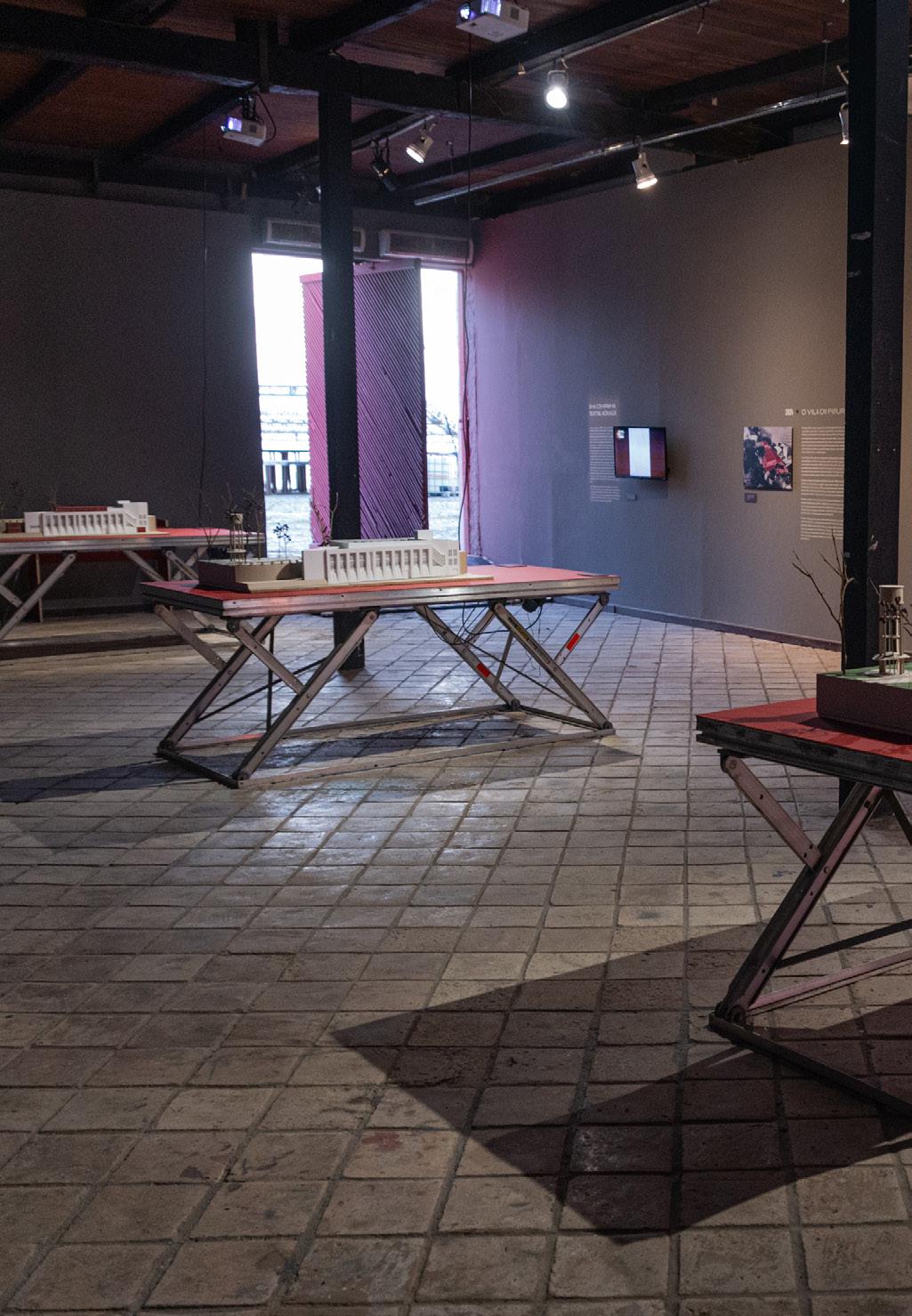
teatro vila velha — arquitetura mutante
Maquetes dos prédios do teatro
Galeria 3, Museu de Arte Moderna da Bahia
Foto: Maiara Cerqueira
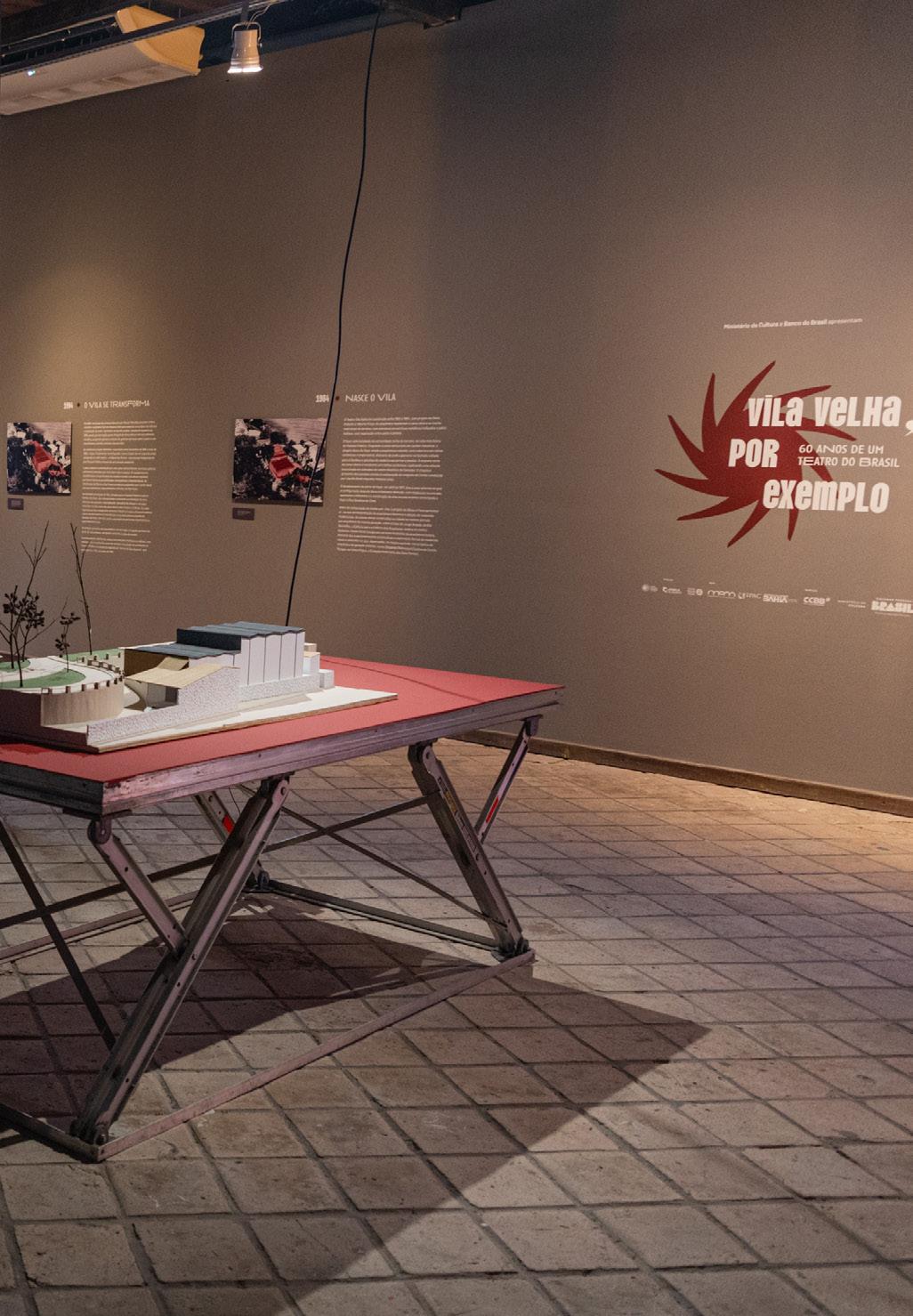
LegeNdAs /imagEns
ABERTURA A BAHIA ANTES DO VILA
1. Descoberta de petróleo na Bahia. Matéria de jornal: `O Ouro Negro do Lobato´.
2. Mapa do EPUCS mostrando o esquema de Zoneamento de Salvador. Década de 1940. Fonte: Arquivo Histórico Municipal de Salvador/Fundo EPUCS
3. Foto aérea da Refinaria de Mataripe, no município de São Francisco do Conde, na Bahia. 1956. Fonte: Centro de Pesquisa e Documentação de História Contemporânea do Brasil da Fundação Getúlio Vargas
4. Matéria do Jornal `O Momento´ (1945) sobre as eleições para a Assembleia Constituinte de 15 de outubro de 1945. Fonte: Jornal `O Momento´
5. Teatro Amador do Fantoches, 1947. Fachada do Cine Teatro Guarany. Fotógrafo não identificado - Acervo Teatro Vila Velha
6. `A Cigana me Enganou´, 1955. Peça do grupo amador Teatro Espírita. Na foto: Echio Reis e atriz não identificada. Fotógrafo não identificado - Acervo Teatro Vila Velha
7. Teatro Amador do Fantoches, 1947. Plateia do Cine Teatro Guarany. Fotógrafo não identificado - Acervo Teatro Vila Velha
8. Foto do artista Genaro de Carvalho finalizando o mural `Festas Regionais´, no restaurante do Hotel da Bahia. 1950. Foto: Pierre Verger. Fonte: Fundação Pierre Verger
9. `O Teatro Amador na Bahia´, 1960. Matéria em jornal não identificado - Acervo Teatro Vila Velha
10. Inauguração do Salão de Belas Artes, novembro de 1949. Fonte: CEDOC A TARDE/Projeto Cultural
11. Apoio do partido comunista do Brasil à candidatura de Otávio Mangabeira ao governo do estado da Bahia, em 1947. Fonte: CEDOC A TARDE / Projeto Cultural
12. Avenida Centenário, na cidade de Salvador, logo após a sua inauguração. Década de 1950. Fonte: Arquivo Histórico Municipal de Salvador
13. Foto do Hotel da Bahia recém-inaugurado, visto a partir do Passeio Público. Década de 1950. Fonte: Arquivo Histórico Municipal de Salvador
14. Campus Canela da Universidade Federal da Bahia. A) Faculdade de Farmácia (hoje Instituto de Ciências da Saúde); B) Faculdade de Direito; C) Hospital das Clínicas (hoje Hospital Universitário Professor Edgard Santos); D) Palácio da Reitoria; E) Escola de Enfermagem; F) Instituto de Cultura Hispânica (hoje Instituto de Ciências da Informação); G) Seminários Livres de Música (hoje Escola de Música); H) Faculdade de Odontologia; I) Instituto de Cultural Francesa (hoje Instituto de Saúde Coletiva). Década de 1960. Fonte: Biblioteca Central da UFBA
15. Palácio da Reitoria da Universidade Federal da Bahia. Década de 1960. Fonte: Arquivo Histórico Municipal de Salvador
16. Desenho da `Praça de Esportes da Baía´, que viria a se tornar o Complexo Esportivo da Fonte Nova. 1942. Fonte: Arquivo Histórico Municipal de Salvador/Fundo EPUCS
17. Maquete de projeto não executado para o Centro Educativo de Arte Teatral - Teatro Castro Alves. 1948. Fonte: Acervo da Construtora Christiani Nielsen
18. Anísio Teixeira no interior do Pavilhão de Atividades de Trabalho da Escola Parque. Década de 1950. Fonte: Centro Educacional Carneiro Ribeiro
19. Inauguração/Incêndio do TCA - 1º de julho de 1958. Fonte: Jornal `Diário de Notícias´
20. Teatro Castro Alves, em 11 de julho de 1958, dois dias após o incêndio. Fonte: Acervo Novonor
21. Hans-Joachim Koellreutter: Seminários de Música da Universidade da Bahia. Na foto: Koellreutter (centro) com seus alunos, entre eles, do lado esquerdo, Jamary Oliveira; atrás dele, à esquerda, Nicolau Kokron, e em pé à direita, Lindembergue Cardoso. (s/data). Fonte: Fundo Arquivístico Emus-Ufba
22. `As Três Irmãs´, 1958. Peça do grupo A Barca, da Escola de Teatro da Universidade Federal da Bahia. Texto de Anton Tchecov, direção de Gianni Ratto. Na foto: Carmen Bittencourt, Sonia Robatto e Nilda Spencer. Fotógrafo não identificadoAcervo Teatro Vila Velha
23. Martim Gonçalves, 1959. Plateia do Teatro Santo Antônio. Na foto: Álvaro Guimarães, Maria da Conceição (Muniz), Cecília Rabelo, Roberto Assis, Dulce Schwabacher, Martim Gonçalves, Robert Bonini, Geraldo Del Rey, Helena Ignez, Glauber Rocha e Sante Scaldaferri. Fonte: Arquivo Instituto Martim Gonçalves
24. Yanka Rudzka,1957. Dançarina e coreógrafa polonesa (centro), com suas alunas, Foto: Anthony R Worley - Acervo Memorial de Dança da Ufba
25. Edgard Santos com o embaixador espanhol, Marquês de Prat de Nantouillet, caminha pela varanda da Reitoria da UFBA. Ao fundo, o Hospital das Clínicas e a Escola de Enfermagem (1953). Fonte: Acervos Familiar e Lugares de Memória da UFBA
26. Incêndio do Teatro Castro Alves, em 9 de julho de 1958. Fonte: CEDOC A TARDE/Projeto Cultural
27. Juscelino Kubitschek saúda o povo na inauguração de Brasília, em 1960. Foto: Gervasio Batista - Arquivo Público do Distrito Federal
28. Populares sobre a cobertura do Palácio do Congresso Nacional, no dia da inauguração de Brasília, 21 de abril de 1960, Foto: Thomaz Farkas - Instituto Moreira Salles
29. Construção do edifício do Congresso Nacional, em Brasília. Por volta de 1958. Foto: Marcel Gautherot - Instituto Moreira Salles
30. Eleições de 1945, em 19 de novembro: presidencial e para Constituinte. Fonte: Jornal `O Momento´
ATO 1
O Vila como ProjeTo e EspAço
31. Ruptura dos alunos com Martim Gonçalves. Matéria de jornal: `Estudantes de Teatro Renunciaram à Formatura´. Fonte: Jornal `A Tarde´ (11/11/1959) - Acervo Teatro Vila Velha
32. Maria Tereza Goulart e o presidente João Goulart no comício da Central do Brasil, em 13 de março de 1964. Foto: CPDOCJB/Folhapress
33. Peça teatral `Senhoritas´. Matéria de jornal sobre censura: `Polícia Invade o Castro Alves e Prende Artistas´. Fonte: Jornal `Diário de Notícias´
34. Implantação da ditadura civil militar de 1964, em 1o de abril 1964. Fonte: CEDOC A TARDE/Projeto Cultural
35. Implantação da ditadura civil militar. Repercussão em 2 de abril 1964. `Goulart no Exílio´. Fonte: CEDOC A TARDE/Projeto Cultural
36. Foto do Solar do Unhão, sede do Museu de Arte Moderna da Bahia (MAM), e da Avenida Contorno, recém-inaugurada. Década de 1960. Fonte: Arquivo Histórico Municipal de Salvador
37. Assassinato de Marighella, em 5 de novembro de 1969. `Marighella Metralhado´. Fonte: Jornal `Diário de Notícias´
38. O presidente Emílio Garrastazu Médici se encaminha ao local da inauguração do primeiro trecho da rodovia Transamazônica, no Pará, em 27 de setembro de 1972. Fonte: Folhapress
39. Redesenho do Plano de Sergio Bernardes para o Centro Industrial de Aratu, 1967. Fonte: Bernardes, Sergio. Plano Diretor do Centro Industrial de Aratu. Salvador: Governo do Estado da Bahia, 1967
40. Foto aérea da Avenida Paralela, em Salvador. Década de 1970. Fonte: `Bahia. A Bahia constrói seu futuro sem destruir seu passado´. (Cartilha). Salvador. Governo do Estado da Bahia, 1975. Foto: Bruno Furrer.
41. Mapeamento elaborado por Marcio Meirelles e Nivaldo Andrade. Documento realizado a partir do levantamento cadastral de Salvador, publicado pela prefeitura em 1955, e do levantamento aerofotogramétrico de Salvador de 1947 - Acervo
Teatro Vila Velha
42. Carta ao governador Juracy Magalhães (folha 1). Acervo Teatro Vila Velha
43. Carta ao governador Juracy Magalhães (folha 2). Acervo Teatro Vila Velha
44. Cessão de área do Passeio Público. Acervo Teatro Vila Velha
45. Demarcação do terreno a ser doado ao Teatro dos Novos. Acervo Teatro Vila Velha
46. Contrato Comodato. Acervo Teatro Vila Velha.
47. Projeto para um pequeno teatro desmontável. Acervo Teatro Vila Velha
48. Teatro Vila Velha, 1964. Fotógrafo não identificado - Acervo Teatro Vila Velha
49. Teatro Vila Velha, 1964. Fotógrafo não identificado. Acervo
Teatro Vila Velha
50. Teatro Vila Velha, 1964. Fotógrafo não identificado - Acervo Teatro Vila Velha
51 a 58. Teatro Vila Velha em diferentes momentos de sua construção e recém-inaugurado, 1964. Fotógrafo não identificado - Acervo Teatro Vila Velha
59. Planta do palco do projeto original do Teatro Vila Velha, em papel vegetal - Acervo Teatro Vila Velha
60. Planta em escala 1:200, do foyer e jardim do Teatro Vila Velha, no Passeio Público, em papel vegetal, com anotações de Silvio Robatto - Acervo Teatro Vila Velha
61. Corte longitudinal do projeto original do Teatro Vila Velha, riscado à caneta, com estudo de iluminação - Acervo Teatro Vila Velha
62. Corte longitudinal do projeto original do Teatro Vila Velha, riscado à caneta, com estudo de iluminação - Acervo Teatro Vila Velha
63 a 66. Teatro Vila Velha recém-inaugurado, 1964. Fotógrafo não identificado - Acervo Teatro Vila Velha
67. `História da Paixão do Senhor´, 1961. Peça com dramaturgia e encenação de João Augusto. Na foto: Echio Reis e elenco. Foto: Silvio Robatto - Acervo Teatro Vila Velha
68. `História da Paixão do Senhor´, 1961. Folheto com datas de apresentações da peça que traz dramaturgia e encenação de João Augusto - Acervo Teatro Vila Velha
69. `Auto do Nascimento´, 1959. Texto de Sonia Robatto e direção de João Augusto. Na foto: Nevolanda Amorim, Yeda Rodrigues, Carmen Bittencourt, Echio Reis, Mário Gadelha, Sonia Robatto, Carlos Petrovich, Castro Negrão e Gileno Pinho. Fotógrafo não identificado - Acervo Teatro Vila Velha
70. `Auto do Nascimento´, 1959. Cartaz da peça - Acervo Teatro Vila Velha
71. `Os Fuzis da Senhora Carrar´, 1961. Leitura dramática do texto de Bertolt Brecht, realizada no Clube Social Filhos de Apolo, em Santo Amaro/BA. Na foto: atores do Teatro dos Novos (de costas); Maria Bethânia e Dona Canô (na plateia, à esquerda). Fotógrafo não identificado - Acervo Teatro Vila Velha
72. `Os Fuzis da Senhora Carrar´, 1961. Leitura dramática do texto de Bertolt Brecht, realizada no Clube Social Filhos de Apolo, em Santo Amaro/BA. Folheto de publicidade - Acervo Teatro Vila Velha
73. `Pluft, o Fantasminha´, 1961. Texto de Maria Clara Machado, direção de João Augusto. Na foto: Fernando Marcos (Froes), Martha Overbeck e Sonia Robatto. Fotógrafo não identificadoAcervo Teatro Vila Velha
74. `Pluft, o Fantasminha´, 1961. Programa da peça. Texto de Maria Clara Machado e direção de João Augusto - Acervo Teatro Vila Velha
75, 76, 78 - `Brasil Antigo´, 1961. Programa da peça. Textos de Mattos Moreira, Machado de Assis e Bartolomeu de Guimarães. Direção de Othon Bastos e João Augusto - Acervo Teatro Vila Velha
77. `Fluft, o Fantasminha´, 1961. Programa da peça. Texto de Maria Clara Machado e direção de João Augusto - Acervo Teatro Vila Velha
79. `Brasil Antigo´, 1961, na cidade de Nazaré das Farinhas. Textos de Mattos Moreira, Machado de Assis e Bartolomeu
de Guimarães. Direção de Othon Bastos e João Augusto. Na foto: adolescentes da cidade, Carlos Petrovich, Mário Gadelha e Carmen Bittencourt. Fotógrafo não identificadoAcervo Teatro Vila Velha
80. `Brasil Antigo´, 1961. Viagem do Teatro dos Novos e amigos para apresentação da peça na cidade de Nazaré das Farinhas. Na foto: Nevolanda Amorim e o casal José e Zuleide Collier (na primeira fila); Lia Robatto, Mário Gadelha, (Maria Francisca), Thereza Sá e Sonia Robatto (na segunda fila); Martha Overbeck, Carmen Bittencourt (na terceira fila); Carlos Petrovich (em pé). Fotógrafo não identificadoAcervo Teatro Vila Velha
81. `Brasil Antigo´, 1961. Elenco da peça que trouxe textos de Mattos Moreira, Machado de Assis e Bartolomeu de Guimarães; direção de Othon Bastos e João Augusto. Na foto: Carlos Petrovich, Carmen Bittencourt, Echio Reis, Maria Francisca (Thereza Sá), Martha Overbeck, Nevolanda Amorim e Othon Bastos. Fotógrafo não identificadoAcervo Teatro Vila Velha
82. `O Casaco Encantado´, 1960. Programa da peça. Texto de Lúcia Benedetti e direção de Carlos Petrovich – Acervo Teatro Vila Velha
83. `O Casaco Encantado´, 1960. Apresentação da peça em Mata Escura, bairro da periferia de Salvador. Fotógrafo não identificado - Acervo Teatro Vila Velha
84. `O Casaco Encantado´, 1960. Programa da peça - Acervo Teatro Vila Velha
85. Construção do Teatro Vila Velha, 1963. Matéria de jornal: `Nasce um Teatro no Passeio Público´ - `RDN´ (17/11/1963)Acervo Teatro Vila Velha
86, 87. Construção do Teatro Vila Velha, 1961. Foto da montagem da estrutura metálica. Fotógrafo não identificado - Acervo Teatro Vila Velha
88. Construção do Teatro Vila Velha, 1963. Feijoada da Cumeeira, evento realizado pelo Teatro dos Novos para celebrar uma etapa da construção do Teatro Vila Velha. Na foto: Othon Bastos (ao centro); Olga Maimone (ao fundo, servindo a feijoada). Fotógrafo não identificado - Acervo Teatro Vila Velha
89. Galeria Oxumaré, década de 1960 - Fotógrafo não identificado - Acervo Teatro Vila Velha
90. Construção do Teatro Vila Velha, 1964. Construção do palco do Teatro Vila Velha. Fotógrafo não identificadoAcervo Teatro Vila Velha
91. Inauguração do Teatro Vila Velha, 1964. Matéria de jornal: `Para o Primeiro Teatro da Cidade o Primeiro Nome da Bahia: Vila Velha´ - jornal `Diário de Notícias´ (24/05/1964) - Acervo Teatro Vila Velha
92. `A Farsa do Mestre Pedro (ou Pathelin)´, 1961. Programa da peça - Texto de autor desconhecido, direção de João Augusto, cenário de Carlos Bastos - Acervo Teatro Vila Velha
93. `A Farsa do Mestre Pedro (ou Pathelin)´, 1961. Na foto: Othon Bastos. Fotógrafo não identificado - Acervo Teatro Vila Velha
94, 95. Campanha da Cadeira, 1962. Folheto de adesão à campanha da compra das cadeiras de um cinema desativado na cidade de Santo Amaro, interior da BahiaAcervo Teatro Vila Velha
96. Recibo de pagamento de indenização por afastamento de ator, 1963. No recibo fica relacionado o compromisso entre o cineasta Glauber Rocha e o ator Othon Bastos para a realização do filme `Deus e o Diabo na Terra do Sol´. Caderno `Companheiro´ com várias anotações - Acervo Teatro Vila Velha
97. `A Paixão Segundo os Retirantes´, 1965, espetáculo com texto e direção de João Augusto. Cartaz/Programa - Acervo Teatro Vila Velha
98. Flâmula Promocional do Teatro Vila Velha, 1966. Impressão sobre tecido - Acervo Teatro Vila Velha
99. Escola de Dança da Universidade da Bahia, 1964. Apresentação de dança moderna no período posterior à inauguração do Teatro Vila Velha. Fotógrafo não identificadoAcervo Teatro Vila Velha
100 e 104. Escola de Samba `Juventude do Garcia´. Fonte: Jornal `Diário de Notícias´ (17/03/1972)
101. `Eles Não Usam Bleque-Tai´, 1964/1965. Texto de Gianfrancesco Guarnieri, direção de João Augusto. Na foto: sambistas da `Escola de Samba Juventude do Garcia´. Fotógrafo não identificado - Acervo Teatro Vila Velha
102. Inauguração do Teatro Vila Velha, em 31 de julho de 1964. Público na entrada do teatro. Fotógrafo não identificadoAcervo Teatro Vila Velha
103. Inauguração do Teatro Vila Velha, 1964. Foto geral da exposição retrospectiva da trajetória do Teatro dos Novos. À esquerda baixa da foto, em meio a um grupo de cinco pessoas, é possível identificar João Augusto, de terno escuro. Fotógrafo não identificado - Acervo Teatro Vila Velha
105. `Estórias de Gil Vicente´, 1966. Dramaturgia e direção de João Augusto. Fotógrafo não identificado - Acervo Teatro Vila Velha
106. `Auto dos Físicos´, um dos textos encenados na peça `Estórias de Gil Vicente´, 1966. Dramaturgia e direção de João Augusto. Na foto: Wilson Melo, Carmen Bittencourt, Fernando Peltier (em pé) e Alberto Luís Viana (deitado). Fotógrafo não identificado - Acervo Teatro Vila Velha
107. `Todo Mundo e Ninguém´, um dos textos encenados na peça `Estórias de Gil Vicente´, 1966. Dramaturgia e direção de João Augusto. Na foto: Marta Overbeck e Mário Gusmão. Fotógrafo não identificado - Acervo Teatro Vila Velha
108. `A Chegada de Lampião no Inferno´, um dos textos encenados na peça `Estórias de Gil Vicente´, 1966. Na foto: Alberto Luís Viana e Mário Gusmão. Fotógrafo não identificado - Acervo Teatro Vila Velha
109. Teatrinho Chique-Chique, 1965. Na foto: Maria Manuela e o boneco da personagem Dona Antônia. Fotógrafo não identificado - Acervo Teatro Vila Velha
110. `Teatro de Cordel´, 1966. Dramaturgia e direção de João Augusto. Na foto: Maria Manuela e Martha Overbeck. Fotógrafo não identificado - Acervo Teatro Vila Velha
111. `Stopem/Stopem´, 1968. Texto colagem e direção de João Augusto e Haroldo Cardoso. Na foto: Paula Martins e parte do elenco (não identificado). Fotógrafo não identificado - Acervo Teatro Vila Velha
112. `Stopem/Stopem´, 1968. Texto colagem e direção de João Augusto e Haroldo Cardoso. Na foto: Yumara Rodrigues e Cilene Guedes. Fotógrafo não identificado - Acervo Teatro Vila Velha
113. Inauguração do Teatro Vila Velha, 1964. Orquestra Sinfônica da Universidade da Bahia (OSUFBA), sob regência de Sergio Magnani. Fotógrafo não identificado - Acervo Teatro Vila Velha
114. `Exposição Nordeste´, 1963, que inaugurou o Museu de Arte Popular, no Solar do Unhão. Fotógrafo: A. Guthmann - Fonte: © Instituto Bardi / Casa de Vidro
115. Arquitetura cênica concebida por Lina Bo Bardi para a `Ópera dos Três Tostões´, de Bertold Brecht e Kurt Weil, encenada por Martim Gonçalves no Teatro Castro Alves, que havia incendiado na madrugada do dia 9 de julho de 1958, cinco dias antes da abertura ao público. Autor: A. Guthmann - Fonte: ©Instituto Bardi / Casa de Vidro
116. Inauguração do Teatro Vila Velha, 1964. Detalhe da exposição retrospectiva da trajetória do Teatro dos Novos, na noite de inauguração. Fotógrafo não identificado - Acervo
Teatro Vila Velha
117. João Augusto em fotocolagem com registros de ações e espetáculos montados por ele depois de 1964. Fotógrafos não identificados - Acervo Teatro Vila Velha
118. Palácio de Ondina, residência oficial do Governador da Bahia a partir de 1967. Foto de 26 de abril de 1991. Fonte: Arquivo Histórico Municipal de Salvador
119. `Eles Não Usam Bleque-Tai´, 1964/1965. Texto de Gianfrancesco Guarnieri, direção de João Augusto. Na foto: Othon Bastos (de costas), Mário Gadelha, Fernando Barros, Wilson Melo, Mário Gusmão, Fernando Lona, Maria Manuela, Robernival Ribeiro (Pitti) e sambistas da Escola de Samba Juventude do Garcia. Fotógrafo não identificado - Acervo Teatro Vila Velha
120. `Eles Não Usam Bleque-Tai´, 1964/1965. Texto de Gianfrancesco Guarnieri, direção de João Augusto. Na foto: Mário Gusmão, Sonia Robatto, Carmen Bittencourt, Fernando Lona. Fotógrafo não identificado - Acervo Teatro Vila Velha
121. `Eles Não Usam Bleque-Tai´, 1964. Tipografia anunciando a peça. Texto de Gianfrancesco Guarnieri, direção de João Augusto - Acervo Teatro Vila Velha
122. Anúncio do Governo do Estado da Bahia que apresenta os contornos do terreno onde viria a ser construído o Centro de Convenções da Bahia. Fonte: `Revista Aratu´, 1976
123, 124. Fotos aéreas do Centro Administrativo da Bahia durante a sua construção. Década de 1970. Foto: Bruno Furrer. Fonte: `BAHIA. A Bahia Constrói Seu Futuro Sem Destruir Seu Passado´ (cartilha). Salvador: Governo do Estado da Bahia, 1975
125. Shopping Center Iguatemi, hoje Shopping da Bahia, logo após sua inauguração, em 1975. Fonte: Acervo Novonor
126. Estação Rodoviária de Salvador, quando recéminaugurada, em foto de 1974. Fonte: Acervo Novonor
127. `Nós, Por Exemplo...´, 1964. Show musical dirigido por Caetano Veloso, Gilberto Gil e Roberto Sant’Ana. Na foto: Djalma Correia, Perna Fróes, Fernando Lona, Caetano Veloso, Gal Costa, Gilberto Gil, Maria Bethânia e Alcyvando Luz. Fotógrafo não identificado - Acervo Teatro Vila Velha
128. `Nós, Por Exemplo...´, 1964. Na foto: plateia, com Calasans Neto (ao centro), Auta Rosa e Dona Mariá, mãe de Gal Costa (esquerda inferior). Fotógrafo não identificado - Acervo Conceição e Orlando Senna
129. `Nós, Por Exemplo...´, 1964. Na foto: Gilberto Gil. Fotógrafo não identificado - Acervo Conceição e Orlando Senna
130. `Nós, Por Exemplo...´, 1964. Na foto: Tom Zé durante ensaio. Fotógrafo não identificado - Acervo Conceição e Orlando Senna
131. `Nós, Por Exemplo...´, 1964. Na foto: Alcyvando Luz e Perna Fróes. Fotógrafo não identificado - Acervo Conceição e Orlando Senna
132. `Nós, Por Exemplo...´, 1964. Na foto: Gal Costa. Fotógrafo não identificado - Acervo Conceição e Orlando Senna
133. `Nós, Por Exemplo...´, 1964. Na foto: Gilberto Gil e Gal Costa. Fotógrafo não identificado - Acervo Conceição e Orlando Senna
134. `Nós, Por Exemplo...´, 1964. Programa do show dirigido por Caetano Veloso, Gilberto Gil e Roberto Sant’Ana - Acervo Teatro Vila Velha
135. Inauguração do Teatro Vila Velha, 1964. Convite para a exposição retrospectiva sobre a trajetória da Sociedade Teatro dos Novos - Acervo Teatro Vila Velha
136. Reabertura do Teatro Vila Velha. Matéria de jornal: `Dezembro Marcará a Volta do Vila Velha Para Alegria Geral´. Fonte: Jornal `Diário de Notícias´ (20/10/1971)
137. `Gal-Fatal´. Matéria de jornal: `Gal Costa´. Fonte: Jornal `Diário de Notícias´ (29/01/1972)
138. O fim do AI-5. Matéria de jornal: `Para Almirante Fim do AI-5 Dá Estabilidade´. Fonte: Jornal `Diário de Notícias´ (06/01/1979)
139 `Baile das Atrizes´. Matéria de jornal: `Hoje Baile das Atrizes no Vila com Muitas Vedetes´. Fonte: Jornal `Diário de Notícias´ (11/02/1972)
140. Rainha do Carnaval. Matéria de jornal: `Show da Rainha Hoje no Vila´. Fonte: Jornal `Diário de Notícias´ (02/02/1972)
141. Reabertura do Teatro Vila Velha. Matéria de jornal: `Vila Velha Vem Aí com Novos Sucessos´. Fonte: Jornal `Diário de Notícias´ (15/01/1972)
142. Cartaz da peça teatral `A Nova Helena & O Vaso Suspirado´, 1967, que reuniu dois textos de Francisco Pereira da Silva. Direção de Haroldo Cardoso - Acervo Teatro Vila Velha
143. Último show de Caetano Veloso e Gilberto Gil em Salvador antes de partirem para o exílio. Matéria de jornal: `Adeus de Caetano e Gil no Canto de Vai Simbora´. (19/07/1969). Fonte: CEDOC A TARDE / Projeto Cultural
144. Gal Costa em foto de 1974, em show realizado nas apresentações da programação da Temporada de Verão, realizada no Teatro Vila Velha. Foto: Evinha
145. `Oxente Gente, Cordel!´. Peça teatral com dramaturgia e direção de João Augusto. Na foto, realizada entre 1977/78: Braulio Tavares, Zelito Miranda, Roberto Mendes e Raimundo Sodré. Fotógrafo não identificado - Acervo Teatro Vila Velha
146. `Gracias A La Vida´, 1976. Peça do grupo Teatro Livre da Bahia, com texto de Isaac Charcón e direção de João Augusto. Na foto: Harildo Déda e Bemvindo Sequeira. Fotógrafo não identificado - Acervo Teatro Vila Velha
147. `Cordel 3´, 1972. Elenco da peça do grupo Teatro Livre da Bahia que trouxe dramaturgia e direção de João Augusto. Na foto: Zelito Miranda, Wilson D’Argolo, Harildo Déda, Bemvindo Sequeira, Moisés Augusto, Maria Adélia, Jurandir Ferreira, Marise Castro, Olga Maimone, Normalice Souza, Sonia Medeiros (parte superior); João Augusto (parte baixa, de lado),
Francisco de Paula, Fernando Lona, Thereza Sá, Waldemar Nobre (parte de baixo). Fotógrafo não identificado - Acervo Teatro Vila Velha
148. `Cordel 3´, 1975. Cartaz da apresentação do grupo Teatro Livre da Bahia na Giornata Internazionale dello Espetacolo, Roma/Itália. No cartaz, Jurandir FerreiraAcervo Teatro Vila Velha
149. `Filismina Engole Brasa´, 1977. Texto de João Augusto e direção de Bemvindo Sequeira para espetáculo de rua/ cordel. Na foto: Maria Adélia (ao centro). Fotógrafo não identificado - Acervo Teatro Vila Velha
150. `Gracias a la Vida´, 1976. Peça do grupo Teatro Livre da Bahia com texto de Isaac Charcón e direção de João Augusto. Na foto: João Augusto, Maria Adélia, Normalice Souza, Moisés Augusto, Vilma de Leonah. Fotógrafo não identificado - Acervo Teatro Vila Velha
151. Teatro Livre da Bahia - Cortejo Teatro de Cordel na Rua, em 1977. Na foto: Harildo Déda, Zelito Miranda, Sônia dos Humildes e Bemvindo Sequeira. Fotógrafo não identificado - Acervo Teatro Vila Velha
152.`Quincas Berro D ́Água´, 1976. Adaptação e direção de João Augusto do livro de Jorge Amado. Na foto: Wilson Melo e elenco. Fotógrafo não identificado - Acervo Teatro Vila Velha
153. `Quincas Berro D ́Água´, 1976. Na foto: Harildo Déda, Sônia dos Humildes, Nilda Spencer, Bemvindo Sequeira, ator não identificado, Normalice Souza e Zizi Possi. Fotógrafo não identificado - Acervo Teatro Vila Velha
154. `Baile das Atrizes´, no ano em que a rainha foi Wilma de Leonah (1977). Fotógrafo não identificado - Acervo Teatro Vila Velha
155. Desabamento parcial do foyer do Teatro Vila Velha, 1971. Matéria de jornal sobre as chuvas em Salvador: `Há Sete Mil Desabrigados´ - Jornal `Diário de Notícias´ (29/04/1971) - Acervo Teatro Vila Velha
156. Cartaz do show de Tom Zé com o grupo musical Os Trogloditas, em 1969 - Acervo Teatro Vila Velha
157. Cartaz de 1974 com a logo do Teatro Vila Velha, o Sol do Vila. A marca foi criada pelo artista plástico Calasans NetoAcervo Teatro Vila Velha
158. Cartaz da `Temporada de Verão´, 1974 - Acervo Teatro Vila Velha
159. `Samba da Bahia´, 1973. Capa do disco de Riachão, Batatinha e Panela, gravado no Teatro Vila Velha. Arte de Gilson Rodrigues. Fotos: Evandro Texeira
160. `Quincas Berro D ́água´, 1972. Cartaz criado por Calasans Neto para a primeira montagem da peça, que teve adaptação e direção de João Augusto para o livro de Jorge Amado - Acervo Teatro Vila Velha
161. `Oxente Gente, Cordel!´, 1978. Cartaz da peça que teve dramaturgia e direção de João Augusto - Acervo Teatro Vila Velha
162. Cartaz do espetáculo `Off-Sina Pombas, Bahia´, 1977. Direção de João Augusto - Acervo Teatro Vila Velha
163. `GRRRRrrrrrr´, 1971. Cartaz da primeira peça dirigida por João Augusto para o grupo Teatro Livre da Bahia - Acervo Teatro Vila Velha
164. Carta de Carmen Bittencourt para João Augusto, datada de 1968 - Acervo Teatro Vila Velha
165. Carta de João Augusto a Manuel Veiga sobre o desabamento parcial do foyer do Teatro Vila Velha devido às chuvas que caíram em Salvador, em 1971 - Acervo Teatro Vila Velha
166. Edil Pacheco, Riachão, Batatinha e Ederaldo Gentil ao tempo do show e gravação do disco `Samba da Bahia´, 1973. Foto: Arlete Soares
167. `Noite pela Anistia´. Matéria de jornal anuncia o show: `Fagner, Gil, Tom Zé, Cae e Outros Valores Cantam Pela Anistia´ (07/02/1979). Fonte: Jornal `Correio da Bahia´
168. `Mulheres de Tróia´, 1978. Peça do grupo Teatro Livre da Bahia, com texto e direção de João Augusto. Foto: Mario Cravo Neto - Acervo Teatro Vila Velha
169. `Mulheres de Tróia´, 1978. Peça do Teatro Livre da Bahia, com texto e direção de João Augusto. Na foto: Yumara Rodrigues, Maria Adélia, Arly Arnaud, ao centro, ladeadas por Jacinta Ferraz, Luci Ball, Maria Celeste, Raimunda Lee e Zoila Barata. Foto: Mario Cravo Neto - Acervo Teatro Vila Velha
170 a 172 – João Augusto, nos anos 1970, em Salvador, BahiaFotógrafo não identificado - Acervo Teatro Vila Velha
173 - `Pluft, o Fantasminha´, em montagem do grupo Teatro O Tablado (1955), texto e direção de Maria Clara Machado. Na foto: João Augusto, Eddy Resende Nunes e Roberto de CletoFotógrafo não identificado - Acervo O Tablado
174 – `Pluft, o Fantasminha´, em montagem do grupo Teatro O Tablado (1955), texto e direção de Maria Clara Machado. Na foto: Carmem Sylvia Murgel, Kalma Murtinho, João Augusto, Roberto de Cleto, Eddy Resende Nunes e Vânia Velloso Borges - Fotógrafo não identificado - Acervo O Tablado
175 - `Pluft, o Fantasminha, em montagem do grupo Teatro O Tablado (1955), texto e direção de Maria Clara Machado. Na foto: Roberto de Cleto, Eddy Resende e João AugustoFotógrafo não identificado - Acervo O Tablado
176 - `Pluft, o Fantasminha`, em montagem do grupo Teatro O Tablado (1955), texto e direção de Maria Clara Machado. Na foto: Eddy Resende Nunes, João Augusto, Roberto de Cleto e Emílio de Mattos - Fotógrafo não identificado - Acervo O Tablado
177 – O ator Othon Bastos, em 1961, em frente ao cenário de Carlos Bastos para a peça `A Farsa do Mestre Pedro (ou Panthelin)´, que teve direção de João Augusto - Fotógrafo não identificado - Acervo Teatro Vila Velha
178. João Augusto. Matéria jornalística sobre sua carreira: `Graças a Deus e ao Diabo Teatro Aqui Suporta Tudo´. Fonte: `Jornal da Bahia´ (26 e 27/11/1972)
179 a 188 – João Augusto em viagens pelo Brasil e pelo mundo, realizadas na década de 1970, com o grupo Teatro Livre da Bahia - Fotógrafo não identificado - Acervo Teatro Vila Velha
189 – Na cidade de Santo Amaro, 1960 (?). A partir da esquerda: Rodrigo Velloso, Wilson Melo, João Augusto, Othon Bastos e Mário Gadelha – Fotógrafo não identificado – Acervo Teatro Vila Velha
190 – Foto do início dos anos 1960. A partir da esquerda: João Augusto, Carmen Bittencourt, Echio Reis e Sonia Robatto –Fotógrafo não identificado – Acervo Teatro Vila Velha
191 - Na janela do escritório do Teatro Vila Velha (início dos ano 1960)
192 a 197 - Fotos de ensaio de “Gracias a la Vida” (1977), com o elenco do Teatro Livre da Bahia. Fotógrafo não identificado –Acervo Teatro Vila Velha
198 a 203 – Carioca, João Augusto trabalhou e morou na Bahia durante seus últimos 22 anos de vida, formando jovens artistas, criando espetáculos, colaborando decisivamente para o desenvolvimento das artes, em especial a teatral. Em 1964, viu ser inaugurado o Teatro Vila Velha, projeto que o teve como incentivador e criador fundamental, do primeiro imaginar até sua realização e posterior consolidação. Em 25 de novembro de 1979, morre João Augusto, em decorrência de um câncer, em Salvador, cidade que adotou como lar e lugar de suas diversas criações artísticas que, dali, ultrapassaram fronteiras no Brasil e no mundo – Acervo Teatro Vila Velha
204 a 206.- Recortes de diferentes jornais anunciando e repercutindo a morte de João Augusto, em 1979. Fonte: Acervo Teatro Vila Velha
207 – João Augusto no Teatro Vila Velha – Acervo Teatro Vila Velha
208 - Escrito de próprio punho, por João Augusto, no verso da foto 207 – Acervo Teatro Vila Velha
ENTREATO
uM teatRo GuerreiRo coNtra o DRagãO da Maldade
209. `A Revolução das Mulheres´, 1983. Texto de Aristófanes com direção de Echio Reis. Na foto: Walri Reis, Marco Bahia e Carlos Tavares. Foto: Carlos Rizério - Acervo Teatro Vila Velha
210. Cartaz da peça teatral `Sapequices de Chapeuzinho Vermelho´, 1985, com texto de Ivone Leão Ladeia e direção de Jorge Lírio e J. Mendes - Acervo Teatro Vila Velha
211. Cartaz da peça teatral `O Menino Maluquinho´, de 1985. Adaptação de Marcos Antônio Rodrigues e direção de Adelaide Amorim - Acervo Teatro Vila Velha
212. Cartaz da peça teatral `Festival dos Vegetais´, de 1985. Texto e direção de Wilson da Rocha Besnosik - Acervo Teatro Vila Velha
213. Cartaz da peça teatral `Encantado´, 1987. Texto de Roberto Trujillo e Edwaldo Franciolli, com direção de Roberto TrujilloAcervo Teatro Vila Velha
214. `Cinderela, a Gata Borralheira´, 1983. Desenho de figurino de personagem da peça que teve texto e direção de Echio Reis. Acervo Teatro Vila Velha
215. `As Tias´, 1983. Texto de Aguinaldo Silva e Doc Comparato, com direção de Echio Reis. Na foto: Leonel Amorim, Regina Lúcia, Narcival Rubens, Di Paula, Geraldo Portela, Zezão Pereira. Foto: Carlos Rizério - Acervo Teatro Vila Velha
216. ‘Cinderela, a Gata Borralheira´, 1983. Texto e direção de Echio Reis. Na foto: Andréa Reis como Cinderela. Foto: Carlos Rizério - Acervo Teatro Vila Velha
217. ‘Cinderela, a Gata Borralheira´, 1983. Desenho de Echio Reis para o figurino de Cinderela. Acervo Teatro Vila Velha
218. Cartaz anuncia show das bandas Moisés Ramsés, Guerra Fria e Dever de Classe, em 1987, na Escola de Arquitetura da UFBA - Acervo pessoal de Williams Martins
219. `A Terra É Dona de Tudo´, 1988 - Cartaz do show de Bule Bule – Acervo Teatro Vila Velha
220. Eleição de João Durval. Matéria de jornal: `João Durval
Está Eleito: Uma Vitória Esmagadora´ (17/11/1982). Fonte: Jornal `Correio da Bahia´
221. Conjunto de edifícios comerciais projetados por Fernando Peixoto no loteamento Cidadela, em Salvador, e construídos na segunda metade da década de 1980 - Fonte: Acervo Arquiteto Fernando Peixoto
222. Criação da Secult - 16 de Julho de 1987. Fonte: CEDOC A TARDE / Projeto Cultural
223. Foto da Casa do Comércio em 1990, dois anos após sua inauguração. Fonte: Acervo Casa do Comércio - SESC Bahia
224. Foto atual da Casa do Benin, projeto de Lina Bo Bardi inaugurado em 1988 – Foto: Nivaldo Andrade, 2024
225. Conjunto de edifícios da Ladeira da Misericórdia, restaurados por Lina Bo Bardi como parte do projeto de recuperação do Centro Histórico de Salvador. Década de 1980Fonte: © Instituto Bardi / Casa de Vidro
226. Foto da maquete da Estação de Transbordo da Lapa, em Salvador, inaugurada em 1982 - Fonte: Instituto João Filgueiras Lima – Lelé
227. Rua do Maciel de Baixo logo após a requalificação do Centro Histórico de Salvador, realizada na primeira metade da década de 1990. Foto: Arlete Soares
228. Lina Bo Bardi e Gilberto Gil com a maquete da escada do Teatro Gregório de Mattos. Década de 1980. Foto: Luiz PradoAcervo: © Instituto Bardi / Casa de Vidro
229. Palácio Thomé de Souza, sede da Prefeitura de Salvador, em foto de 1986, durante sua construção - Fonte: Arquivo Histórico Municipal de Salvador
230. Matéria jornalística repercute a notícia que o Teatro Vila Velha passaria a ser administrado pela Fundação Cultural do Estado da Bahia. `Vila Velha Deixará de Ser Espaço da Livre Criação´ - `Jornal da Bahia´ (29/12/1983) – Acervo Teatro Vila Velha
231. Correspondência da Sociedade Teatro dos Novos para a Fundação Cultural do Estado da Bahia (1987) solicitando o pagamento do seguro que deixou de ser efetuado ao longo dos três anos anteriores - Acervo Teatro Vila Velha
232. Correspondência de Eduardo Cabús, diretor do DEPAT, ao Presidente da Fundação Cultural do Estado da Bahia, em 1987, solicitando o pagamento das dívidas em nome do Teatro Vila Velha - Acervo Teatro Vila Velha
233. Correspondência da Sociedade Teatro dos Novos, assinada por Sandra Berenguer (1987), solicitando o cancelamento do convênio com a Fundação Cultural do Estado da Bahia - Acervo Teatro Vila Velha
234. Termo de Distrato do Convênio com a Fundação Cultural do Estado da Bahia (1987) - Correspondência do Departamento de Teatro da FUNCEB para o Secretário de Cultura - Acervo Teatro Vila Velha
235. Nova Constituição. Matéria de jornal: `A Constituição Veio Para Ser Obedecida´ (06/10/1988). Fonte: CEDOC A TARDE / Projeto Cultural
236. Morte de Tancredo Neves. Matéria de jornal: `Tancredo Já Descansa em Paz´ (25/04/1985). Fonte: CEDOC A TARDE / Projeto Cultural
237. Diretas Já. Matéria de jornal: `Comício-Monstro Pelas
Diretas´ (11/04/1984). Fonte: CEDOC A TARDE / Projeto Cultural
238. Eleição de Waldir Pires. Matéria de jornal: `Wladir Garante Governo Para Humildes´ (19/11/1986). Fonte: CEDOC A TARDE / Projeto Cultural
239. Caras Pintadas. Matéria de jornal: `Manifestações Populares Contra a Corrupção´ (15/08/1992). Fonte: CEDOC A TARDE / Projeto Cultural
240. Massacre do Carandiru. Matéria de jornal: `Rebelião Acaba com Mais de 100 Mortes´ (04/10/1992). Fonte: CEDOC A TARDE / Projeto Cultural
241. Eleição de Fernando Collor. Matéria de jornal: `Collor Chega à Presidência´ (19/12/1989). Fonte: CEDOC A TARDE / Projeto Cultural
242. Posse de Lídice da Mata. Matéria de jornal: `Lídice Vai Assumir Prefeitura com Dívida de US$ 500 Milhões´ (02/01/1993). Fonte: CEDOC A TARDE / Projeto Cultural
243 – Massacre do Carandiru. Matéria de jornal repercute a chacina: `Governador Admite Que a Ação da Polícia Foi Criminosa´ (08/10/1992). Fonte: CEDOC A TARDE / Projeto Cultural
244. `Despertar para o Sexo´, 1989 - Foto publicitária da peça da JF Produções Artísticas Ltda., produção com texto de Carlos Figueiredo e direção de José Carlos Silva. Na foto: Sandra Lins, Diego Chaves, Marlete Camargo, Alex Ribeiro - Fotógrafo não identificado - Acervo Teatro Vila Velha
245.`Taras de uma Médica´, 1989. Na foto: atriz não identificada e Ary Santiago - Fotógrafo não identificadoAcervo Teatro Vila Velha
246. `As Filhas da Mãe´, 1987 - Cartaz da peça produzida por Nilton Raman - Acervo Teatro Vila Velha
247. Punks no Vila. Suplemento Cultural do `Jornal da Bahia´ (08 e 09/03/1987): `Punk: o Avesso do Axé´ - Acervo pessoal de Williams Martins
248. `Enfim Solos´, 1992 - Cartaz do show de Arrigo Barnabé e Itamar Assunção – Acervo Teatro Vila Velha
249. Camisa da Banda Cólera, 1987 - Acervo pessoal de Williams Martins
250. Camisa da Banda Dever de Classe, 1987 - Acervo pessoal de Williams Martins
251 a 255. Frames do registro do show da banda Camisa de Vênus no Teatro Vila Velha, 1982 – Acervo Teatro Vila Velha
ATO 2
o ViLa sE REinvenTA
256. Plano Real. Matéria de jornal: `Troca do Cruzeiro Pelo Real Já Está Pronta´ (07/03/1994). Fonte: CEDOC A TARDE / Projeto Cultural
257. Jornadas de Junho. Matéria de jornal: `PM Reage Com Bombas À Invasão de Terminal´ (12/06/2013). Fonte: CEDOC A TARDE / Projeto Cultural
258. Reeleição de FHC. Matéria de jornal: `FHC Curte a Vitória na Bahia´ (10/10/1998). Fonte: CEDOC A TARDE / Projeto Cultural
259. Jornadas de Junho. Matéria de jornal: `Onda de Protestos´ (21/06/2013). Fonte: CEDOC A TARDE / Projeto Cultural
260. Eleição de Lula. Matéria de jornal: `Luiz Inácio Lula da Silva Está Eleito´ (28/10/2002). Fonte: CEDOC A TARDE / Projeto Cultural
261. Impeachment de Dilma. Matéria de jornal: `Dilma Se Diz Inocente e Que Saída Será `Golpe´´ (30/08/2016). Fonte: CEDOC A TARDE / Projeto Cultural
262. Eleição de Jaques Wagner. Matéria de jornal: `Wagner Surpreende e É Eleito Governador´ (02/10/2006). Fonte: CEDOC A TARDE / Projeto Cultural
263. Prisão de Lula. Matéria de jornal: `Lula Se Entrega À PF Após Ato Político em São Paulo´ (08/04/2018). Fonte: CEDOC A TARDE / Projeto Cultural
264. Eleição de Bolsonaro. Matéria de jornal: `Com 55,13% dos Votos, Bolsonaro Vence´ (29/10/2018). Fonte: CEDOC A TARDE / Projeto Cultural
265. Assassinato de Marielle Franco. Matéria de jornal: `Assassinato de Marielle Gera Indignação no País e no Mundo´ (16/03/2018). Fonte: CEDOC A TARDE / Projeto Cultural
266. Tragédia de Brumadinho. Matéria de jornal: `Minas Gerais Volta a Viver Pesadelo de Lama´ (26/01/2019). Fonte: CEDOC A TARDE / Projeto Cultural
267. Pandemia Coronavírus. Matéria de jornal: `Organização Mundial de Saúde Declara Pandemia do Coronavírus´ (12/03/2020). Fonte: CEDOC A TARDE / Projeto Cultural
268. Morte do indigenista Bruno Pereira e do jornalista Dom Phillips. Matéria de jornal: `PF Confirma Mortes de Jornalista e Indigenista com Grande Violência´ (16/06/2022). Fonte: CEDOC A TARDE / Projeto Cultural
269. Eleições Parlamentares. Matéria de jornal: `PL Elege Maior Bancada na Câmara dos Deputados e Senado´ (04/10/2022). Fonte: CEDOC A TARDE / Projeto Cultural
270. Tentativa de Golpe de Estado. Matéria de jornal: `Bolsonaristas Atentam Contra o País´ (09/01/2023). Fonte: CEDOC A TARDE / Projeto Cultural
271. Eleições Parlamentares. Matérias de jornal repercutem candidaturas vencedoras de indígenas e mulheres trans (04/10/2022). Fonte: CEDOC A TARDE / Projeto Cultural
272. Tragédia no Rio Grande do Sul. Matéria de jornal: `Chuvas no RS Causam ao Menos 116 Mortes´ (11/05/2024). Fonte: CEDOC A TARDE / Projeto Cultural
273. Posse de Lula. Matéria de jornal: `A Posse da Democracia´ (02/01/2023). Fonte: CEDOC A TARDE / Projeto Cultural
274. Foto (2012) da Estação Brotas, do Metrô de Salvador, na Linha 1 - Fonte: wikipedia.Org
275. Foto (2019) da Estação CAB do Metrô de Salvador, na Linha 2. Fonte: wikipedia.Org
276. Foto (2016) da Concha Acústica do Teatro Castro Alves, após reinauguração. Foto: Rosilda Cruz - Fonte: Secult Bahia
277. Foto aérea do Centro de Tecnologia da Rede Sarah. À esquerda pode-se ver a fábrica de hospitais do aparelho locomotor, instalada em Salvador entre 1992 e 1994; à direita, o Hospital Sarah Kubitschek, no alto da colina. Projetos do arquiteto João Filgueiras Lima, o Lelé. Fonte: Instituto João Filgueiras Lima - Lelé
278. Planta do pavimento térreo, em escala 1:200, da primeira versão do projeto de Carl von Hauenschild para a reforma do Teatro Vila Velha, 1995 - Acervo Teatro Vila Velha
279. Planta da plateia e do palco na primeira versão do projeto de Carl von Hauenschild para a reforma do Teatro Vila Velha, 1995 - Acervo Teatro Vila Velha
280. Planta do pavimento térreo do projeto definitivo de Carl von Hauenschild para a reforma do Teatro Vila Velha, 1996Acervo Teatro Vila Velha
281. Corte longitudinal do projeto definitivo de Carl von Hauenschild para a reforma do Teatro Vila Velha, 1996 - Acervo Teatro Vila Velha
282. Fotografia do Teatro Vila Velha a partir da Rua Gamboa de Cima, vendo-se em primeiro plano a parede curva do Cabaré dos Novos, 1998 - Acervo Teatro Vila Velha
283. Etapa inicial da construção do novo bloco do foyer e Cabaré dos Novos, no Teatro Vila Velha, 1996. Foto: Isabel Gouvêa - Acervo Teatro Vila Velha
284. Construção da ala administrativa e da fachada do Teatro Vila Velha, voltadas para a Rua Gamboa de Cima, vendo-se, ainda, na direita da foto, a caixa cênica de 1964. Foto: Isabel Gouvêa, 1996 - Acervo Teatro Vila Velha
285. Interior da caixa cênica do Teatro Vila Velha na etapa inicial de demolição, 1996 – Fotógrafo não identificado - Acervo Teatro Vila Velha
286. Etapa final da montagem da estrutura metálica da caixa cênica do Teatro Vila Velha, 1997. Foto: Isabel Gouvêa - Acervo Teatro Vila Velha
287. Interior da caixa cênica do Teatro Vila Velha, etapa inicial de demolição, 1996 - Acervo Teatro Vila Velha
288. Fachada do Teatro Vila Velha voltada para a Rua Gamboa de Cima, destacando-se a escada em balanço que liga o setor administrativo à sala Mario Gusmão e camarins, 1997. Foto: Isabel Gouvêa - Acervo Teatro Vila Velha
289. Bloco principal do Teatro Vila Velha após a reforma, vendo-se a porta de acesso aos camarins, 1998 - Acervo Teatro Vila Velha
290. Construção do Cabaré dos Novos do Teatro Vila Velha, vista a partir do Passeio Público. Foto do dia da Feijoada da Laje, realizada para arrecadar dinheiro para a obra, em fevereiro de 1996. Foto: Isabel Gouvêa - Acervo Teatro Vila Velha
291. Acessos ao foyer (embaixo) e ao Cabaré dos Novos (em cima), vistos a partir do Passeio Público, dezembro de 1997. Foto: Isabel Gouvêa - Acervo Teatro Vila Velha
292. Jogo de rampas e escadas que conectam os diversos níveis do Teatro Vila Velha. Ao fundo, veem-se o foyer (abaixo) e o Cabaré dos Novos (acima), 1998. Fotógrafo não identificado - Acervo Teatro Vila Velha
293. Cabaré dos Novos logo após a inauguração, 1998 - Acervo Teatro Vila Velha
294. Construção da ala administrativa e da fachada voltadas para a Rua da Gamboa, 1996 - Foto: Isabel Gouvêa - Acervo Teatro Vila Velha
295. Caixa cênica com uma das várias configurações possíveis através de utilização dos praticáveis, 1998 - Acervo Teatro Vila Velha
296. Fotografia da caixa cênica com uma das várias configurações possíveis através de utilização dos praticáveis, 1998 - Acervo Teatro Vila Velha
297. Planta em escala 1:200 do pavimento térreo. Primeira versão (fevereiro de 1995) do projeto de Carl von Hauenschild para a reforma do Teatro Vila Velha - Acervo Teatro Vila Velha
298. Cortes do projeto de requalificação do Teatro Vila Velha, 2023 - Acervo A+P Arquitetos Associados
299 a 305. Ilustrações do recente projeto de requalificação do Teatro Vila Velha, que passa por reformas estruturais patrocinadas pela prefeitura da cidade de Salvador. Previsão de entrega da obra para o público: segundo semestre de 2025 – Acervo Teatro Vila Velha
306. `Projeto Novo Vila´ (1994 a 1998) - Na foto, grupo de artistas residentes na saída para a Lavagem do Bonfim, em 1995, entre eles: Rejane Maia (na esquerda baixa, segurando a bandeira), Tereza Araújo (no centro, à esquerda, segurando a bandeira) e Marísia Motta (última pessoa à direita, em pé, na foto), organizadoras do evento. Foto: Marcos MC - Acervo Teatro Vila Velha
307. `Meia-Noite se Improvisa´, 1995. Espetáculo de variedades realizado por Marísia Motta, Tereza Araújo, (Adelina) Dedé Rebouças. Na foto: Os Zárabe e Carlinhos Brown. Foto: Marcos MC - Acervo Teatro Vila Velha
308. `Meia-Noite se Improvisa´, 1995. Na foto: Frieda Guttman dá as doze badaladas no sino, ação que, tradicionalmente, marcava o início da programação. Ao fundo, Marísia Motta (de azul) e Zeca Freitas. Foto: Marcos MC - Acervo Teatro Vila Velha
309. `Meia-Noite se Improvisa´, 1995. Na foto: cortejo de entrada, com Celso Junior, Eneida Rebouças, Guilherme Leme, Virgínia Rodrigues, Katia Borges, Lázaro Ramos e Cícero Antônio. Foto: Marcos MC - Acervo Teatro Vila Velha
310. `Meia-Noite se Improvisa´, 1995. Na foto: Tracy Whitney, Tanucha Taylor e Bagageryer Spilberg. Foto: Marcos MCAcervo Teatro Vila Velha
311. `ShowPruvila´ - Maria Bethânia, 1995. Na foto: Carlos Petrovich, Sonia Robatto, Tereza Sá e Wilson Melo lendo um poema. Foto: Marcos MC - Acervo Teatro Vila Velha
312. `Meia-Noite se Improvisa´, 1995. Nas fotos: Zeca de Abreu e o público. Foto: Marcos MC - Acervo Teatro Vila Velha
313. `Meia-Noite se Improvisa´, 1995. Na foto: Bagageryer Spilberg. Foto: Marcos MC - Acervo Teatro Vila Velha
314. `Revilavolta´, 1996. Festival de Rock e artes integradas que teve programação durante a reforma do Vila. Na foto: Banda Ataraxia (Nando, Marcão, Márcio Muniz, Igor Caxixi, Eric Miráua, Serafim Martinez, Flavete, Maurício Aluado e Marcos Barroso). Foto: Marcos MC - Acervo Teatro Vila Velha
315. `ShowPruvila´ – Gilberto Gil, 1995. Na foto: Gilberto Gil. Foto: Beto Ricardo - Acervo Teatro Vila Velha
316. `ShowPruvila´ – Caetano Veloso, 1994 - Show de início do `Projeto Novo Vila`, de renovação do teatro. Na foto: Caetano Veloso. Foto: Isabel Gouvêa - Acervo Teatro Vila Velha
317. `ShowPruvila´ – Maria Bethânia, 1995. Na foto: Maria Bethânia. Foto: Marcos MC - Acervo Teatro Vila Velha
318. `ShowPruvila´ – Margareth Menezes, 1995. Na foto: Margareth Menezes e Amadeo Alves, no camarim. Foto: Marcos MC - Acervo Teatro Vila Velha
319. `ShowPruvila´ – Gereba, Naná Vasconcelos, Armandinho Macêdo e Carlinhos Brown, 1995. Na foto: Naná Vasconcelos, Armandinho Macêdo e Carlinhos Brown. Foto: Marcos MC - Acervo Teatro Vila Velha
320. `ShowPruvila´ – Tom Zé, 1995. Na foto: Caetano Veloso, Tom Zé e Daniela Mercury, no camarim. Foto: Alice RamosAcervo Teatro Vila Velha
321. `ShowPruvila´ – Caetano Veloso, 1994. Na foto: Ruy César, Wilson Melo, Armindo Bião, Nilda Spencer, Yumara Rodrigues, Carmem Bittencourt, Carlos Pertovich e Tereza Sá. Ao fundo, Virgínia Rodrigues e outros atores e atrizes do Bando de Teatro Olodum. Foto: Isabel Gouvêa - Acervo Teatro Vila Velha
322. `Um Homem é um Homem´, 1996. Ensaio da leitura cênica da peça de Bertolt Brecht, no projeto `O Que o Sr. Bertolt Tem a Ver Comigo´, durante a reforma do Teatro Vila Velha. Na foto: Gideon Rosa, Daniela Mercury, Marcio Meirelles, Harildo Déda e Lucci Ferreira; ao fundo, as bandas Munda Mundistas e Confraria da Bazófia (Andréz Santana, Celso Carvalho, Arnaldo Almeida, Jarbas Bittencourt, Ray Gouveia e Paulo Romero). Foto: Marcos MC - Acervo Teatro Vila Velha
323. `Um Homem é um Homem´, 1996. Na foto: Chica Carelli, Gideon Rosa, Lucci Ferreira, Marcelo Prado, Elísio Lopes Junior e Fernando Fulco; ao fundo, Munda Mundistas e Confraria da Bazófia (músico não identificado, Arnaldo Almeida, Paulo Romero, Jarbas Bittencourt, Ray Gouveia e Bau Carvalho); no alto, Marcio Meirelles e Harildo Déda. Foto: Marcos MC - Acervo Teatro Vila Velha
324. `Os Kiriri Estão Aqui´, 1995. Visita do Teatro Vila Velha à cidade baiana de Banzaê. Na foto: a produtora Beverley Randal observa o cacique Domingos que lê o programa de `Zumbi´, espetáculo dedicado à luta dos Kiriri. Outros moradores de Banzaê observam. Foto: Marcio MeirellesAcervo Teatro Vila Velha
325. `Os Kiriri Estão Aqui´, 1995 - Matéria de imprensa sobre a ocupação de Mirandela por não indígenas, que resultou na morte de Adão, liderança Kiriri. Foi o assassinato que gerou o evento do teatro, em parceria com a ANAI (Associação Nacional de Ação Indigenista). Jornal `A Tarde´ (10/04/1995) – Acervo Teatro Vila Velha
326. `Os Kiriri Estão Aqui´, 1995. Cartaz do evento - Acervo Teatro Vila Velha
327. `Os Kiriri Estão Aqui´, 1995. Na foto, espetáculo com os Kiriri, o grupo Nau Catarineta e a Orquestra de Frevos e Dobrados. Foto: Isabel Gouvêa - Acervo Teatro Vila Velha
328. `Os Kiriri Estão Aqui´, 1995. Cortejo de entrada dos músicos Kiriri, seguidos pelo público, no Teatro Vila Velha. Foto: Isabel Gouvêa - Acervo Teatro Vila Velha
329. `Um Tal de Dom Quixote´, 1998. Peça teatral com texto de Cleise Mendes e Marcio Meirelles para reinauguração do Teatro Vila Velha. Na foto: Cristina Castro. Foto: Isabel Gouvêa
330. `Um Tal de Dom Quixote´, 1998. Na foto: Ângela Andrade, Hebe Alves, Neyde Moura, Carlos Petrovich, Gil Onawale, Kita Veloso e Sandra Simões. Foto: Isabel Gouvêa
331. `Um Tal de Dom Quixote´, 1998. Na foto: Carlos Petrovich e o coro - Foto: Isabel Gouvêa
332. `Um Tal de Dom Quixote´, 1998. Na foto: Cristina Castro e Carlos Petrovich. Foto: Isabel Gouvêa
333. `Um Tal de Dom Quixote´, 1998. Na foto: o elenco. Foto: Isabel Gouvêa
334. `Um Tal de Dom Quixote´, 1998. Na foto: Carlos Petrovich e coro. Foto: Isabel Gouvêa
335. `Um Tal de Dom Quixote´, 1998. Na foto: Lázaro Ramos. Foto: Isabel Gouvêa
336. `Um Tal de Dom Quixote´, 1998. Na foto: Carlos Petrovich e Lázaro Ramos. Foto: Márcio Lima - Acervo Teatro Vila Velha
337. `Um Tal de Dom Quixote´, 1998. Figurinos de Sancho Pança (Lázaro Ramos), Dom Quixote (Carlos Petrovich) e Dulcinéia (Cristina Castro) criados para o espetáculo por Marcio Meirelles, restaurados por Zuarte Junior para a exposição `Vila Velha Por Exemplo – 60 Anos de Um Teatro do Brasil´- Acervo Teatro Vila Velha
338. `Supernova´, 2000. Peça teatral de Abel Neves, dirigida por Fernando Mora Ramos. Uma co-produção entre o Teatro dos Novos, o Teatro Nacional São João/DRAMAT (Porto/PT) e o CENDREV (Évora/PT), com a colaboração do Culturporto, Teatro Viriato (Viseu/PT) e Cia. Assédio (Porto/PT). Na foto: João Pedro Vaz. Foto: Isabel Gouvêa - Acervo Teatro Vila Velha
339. `Barba Azul´, 1997. Peça teatral de Marcio Meirelles, resultado de oficina que trouxe um novo elenco para o Teatro dos Novos. Na foto: o elenco. Foto: Isabel Gouvêa - Acervo Teatro Vila Velha
340. `Olho de Deus´, 2012. Texto de Sonia Robatto, direção de Marcio Meirelles. Na foto: Chica Carelli, Fernando Fulco e Sonia Robatto. Foto: João Milet Meirelles - Acervo Teatro Vila Velha
341. `O Que Você Acha Disso Tudo?´, 1994. Cartaz da peça do CRIA, dirigida por Maria Eugênia Milet - Arte de Caetano Dias com fotos de Aristides Alves - Acervo Teatro Vila Velha
342. Confraria da Bazófia, 1998. Cartaz de lançamento do CD da banda, que se tornou residente do teatro, com Jarbas Bittencourt como diretor musical de vários projetos e grupos. No cartaz: Arnaldo Almeida, Ray Gouveia, João Luis, Jarbas Bittencourt, Supertom e Jorge Sacramento – Acervo Teatro Vila Velha
343. `A Casa Fechada´, 1995. Peça teatral de Roberto Gomes, dirigida por Marcio Meirelles, no projeto `3&Pronto´, da retomada do Teatro dos Novos. Na foto: Chica Carelli, Gerimias Mendes, Lázaro Ramos, Cristiane Mendonça e João Miguel. Foto: Isabel Gouvêa - Acervo Teatro Vila Velha
344. `Bal Trap´, 1994. Peça do grupo Cereus, com texto de Xavier Durringer e direção de Hebe Alves. Na foto: Isabel Noemi (Reis), Aicha Marques, Cynara Isensée, Zeca de Abreu, Maria Menezes, Jorge Borges e Zé Lauro Azevedo. Foto: Rejane Carneiro - Acervo Teatro Vila Velha
345. `A Incrível Viagem´, 1995. Peça do grupo Cereus, com texto de Doc Comparato e direção de Hebe Alves. Na foto: Isabel Noemi (Reis), Cynara Isensée, Aicha Marques e Wagner Moura. Foto: Rejane Carneiro - Acervo Teatro Vila Velha
346. `Drácula´, 2012. Cartaz do espetáculo de Marcio Meirelles para o grupo Supernova, em residência no Teatro Vila Velha. Criação de David Pádua, Iansã Negrão e Rex (Santo Design)Acervo Teatro Vila Velha
347. `Drácula´, 2012. Espetáculo de Marcio Meirelles para o grupo Supernova, em residência no Teatro Vila Velha. Na foto: Luísa Prosérpio e os olhos de Fernando Fulco em vídeo. Foto: João Milet Meirelles - Acervo Teatro Vila Velha
348. `Aroeira - Com Quantos Nós Se Faz Uma Árvore´, 2006.
Espetáculo de Cristina Castro, com música de Milton Nascimento para o Viladança. Na foto: Sérgio Diaz, Leandro de Oliveira, Janahina Cavalcanti e Matias Santiago. Foto: Márcio Lima - Acervo Teatro Vila Velha
349. `Sagração da Vida Toda´, 1998. Espetáculo de dança criado por Cristina Castro para o Viladança. Na foto: Sérgio Diaz (ao centro) e Leandro de Oliveira, Simone Bonfim e Jairson Bispo. Foto: Márcio Lima - Acervo Teatro Vila Velha
350. `CO2 - Cinco Sentidos e Um Pouco De Paixão´, 2000. Espetáculo de dança de Cristina Castro para o Viladança. Na foto: Clênio Magalhães, Eduardo Pinheiro, Ísis Carla, Izabel Ferreira, Jairson Bispo, Líria Morais, Maitê Soares, Roberto Montenegro, Sérgio Diaz, Silvia Costa. Foto: Márcio Lima - Acervo Teatro Vila Velha
351. `Caçadores de Cabeças/Headhunters´, 2003. Espetáculo de dança de Cristina Castro e Helena Waldmann para ao Viladança. Na foto: Danilo Bracchi (no alto), Leandro Oliveira, Sergio Diaz, Maitê Soares e Bárbara Barbará. Foto: Márcio Lima - Acervo Teatro Vila Velha
352. `José Ulisses da Silva´, 2002. Espetáculo de Cristina Castro para o Viladança. Na foto: Eduardo Pinheiro (de costas, em primeiro plano), Leandro de Oliveira, Maitê Soares, Clênio Magalhães, Danilo Bracchi, Janahina Cavalcanti. Foto: Márcio Lima - Acervo Teatro Vila Velha
353.`Vivadança Festival Internacional´, 2009. Criado e dirigido durante 15 edições por Cristina Castro. Cartaz da 9ª Edição. No cartaz: Camila Kowalski, em foto de João Meirelles; desenhos de Andréa May; projeto gráfico de Pedro Gaudenz - Acervo Teatro Vila Velha
354. `Habitat – Lat 13º S Long 38º 31′ 12” O´, 2008. Espetáculo de Cristina Castro para o Viladança. Na foto: os intérpretes-criadores: Bárbara Barbará, Ciro Sales, Jaqueline Elesbão, Jorge Oliveira, Leandro de Oliveira, Márcio Vesolli, Mariana Gottschalk, Pedro Ivo Santos, Sérgio Diaz. Foto: João Milet Meirelles – Acervo Viladança
355. `Jauria´, 2016. Resultado da residência com Vladimir Rodriguez. Foto: Andréa Magnoni - Acervo Teatro Vila Velha
356. `Tomaladacá´, em sua Primeira Mostra, 1999. Na foto: apresentação da Quadrilha Junina Asa Branca, da comunidade do Cabula, puxada por Antônio Soares. Foto: Isabel Gouvêa
357. `Teatro de Cabo a Rabo´, 2005. Cortejo para apresentação da peça teatral `Oxente, Cordel de Novo?´, com textos de João Augusto e direção de Marcio Meirelles, na cidade de Rio de Contas. Na foto: elenco do Teatro dos Novos e do Bando de Teatro Olodum e os músicos Saulo Gama e João Milet Meirelles. Foto: Márcio Lima - Acervo Teatro Vila Velha
358. `Almanaque da Lua´, 2004. Cartaz da montagem de 2004 da peça criada em 2002 por Gordo Neto para o VilaVox - Acervo Teatro Vila Velha
359. `Tomaladacá´, 1999. Cartaz da 1ª Mostra do projeto de intercâmbio entre os grupos residentes e grupos amadores, da qual vieram muitos atores para o Bando de Teatro Olodum e para a criação d’A Outra Companhia de Teatro - Acervo Teatro Vila Velha
360. `O Contâiner´, 2006. Texto de José Mena Abrantes, direção de Vinício de Oliveira Oliveira para A Outra Companhia de Teatro. Foto: João Milet Meirelles - Acervo Teatro Vila Velha
361. `Canteiros de Rosa´, 2006. Peça criada por Jacyan
Castilho, a partir de Guimarães Rosa, para o VilaVox. Na foto: Claudio Machado (no alto), Fábio Osório (abaixo), artistas não identificados (de costas). Foto: Márcio Lima - Acervo Teatro Vila Velha
362.`Remendo Remendó´, 2016. Remontagem da peça criada em 2002 por Inácio D’Eus, Cell Dantas e Vinício de Oliveira Oliveira. A remontagem foi dirigida por Luiz Antonio Sena Jr. e realizada para o projeto `Pé de Feijão´. Na foto: Israel Barretto (ao centro); Luiz Buranga e Roquildes Júnior (à sua direita); Anderson Danttas e Eddy Veríssimo (à sua esquerda). Foto: Claudio Varela - Acervo Teatro Vila Velha
363. `Trilhas do Vila´, 2003. Remontagem do espetáculo criado por Gordo Neto, Iara Colina e Jarbas Bittencourt, em 2001, para o grupo VilaVox. Na foto: Raissa Fernandes. Foto: Jonas Grebler - Acervo Teatro Vila Velha
364. `Teatro de Cabo a Rabo´. Cartaz das oficinas e apresentações de 2005. Projeto realizado pelo grupo Teatro dos Novos com a participação do Bando de Teatro Olodum, promovendo intercâmbio com o teatro feito em outros municípios. Desse projeto vieram vários artistas que se integraram à A Outra Companhia de Teatro – Acervo Teatro Vila Velha
365. `Siré Obá - A Festa do Rei´, 2009. Espetáculo de Onisajé para o grupo Nata (Núcleo Afrobrasileiro de Teatro de Alagoinhas). Na foto (fundo, da esquerda para a direita): Thiago Romero, Jandiara Barreto, Lucas Michel; (à frente): Fabíola Nansurê, Nando Zâmbia, Antônio Marcelo, Daniel Arcades e Vânia Santana. Foto: Thalita Andrade - Acervo Teatro Vila Velha
366. `Breve´, 2011. Peça de Thiago Romero para o Teatro da Queda. Na foto: Duda Woyda (em pé), Luiza Bocca (ao fundo, sentada), Guilherme Silva, Ricardo Albuquerque, Karen Souza, Márcia Gilbráz (deitados) e, na plateia à direita, Sonia Robatto, Lia Robatto e Marcos Uzel. Foto: Rodrigo F. WanderleyArquivo Teatro da Queda
367. `II Fórum de Performance Negra´, 2006. Cartaz do fórum criado em parceria do Bando de Teatro Olodum com a Companhia dos Comuns (RJ). Evento reuniu artistas e líderes de organizações da cultura negra para, juntos, pensar e implementar políticas para o desenvolvimento de um teatro negro no Brasil. No Cartaz: Mário Gusmão - Acervo Teatro Vila Velha
368. `A Cena Tá Preta´, 2012. Cartaz do festival criado no Teatro Vila Velha para difundir as artes do povo negro - Acervo Teatro Vila Velha
369. `Dô´, 2012. Cartaz para o espetáculo feito em colaboração entre o Bando de Teatro Olodum e Tadashi Endo. Foto do cartaz: João Milet Meirelles – Acervo Teatro Vila Velha
370. `Bai Bai Pelô´, 1994. Cartaz para o primeiro espetáculo feito pelo Bando de Teatro Olodum no Teatro Vila Velha. Texto de Marcio Meirelles; direção de Marcio Meirelles e Chica Carelli - Acervo Teatro Vila Velha
371. `Zumbi Está Vivo e Continua Lutando´, 1995. Peça cortejo entre o Passeio Público e o Campo Grande, com texto de Aninha Franco e Marcio Meirelles e direção de Marcio Meirelles, José Carlos Arandiba (Zebrinha) e Chica Carelli. Na foto: Mário Gusmão e elenco. Foto: Isabel Gouvêa
372. `O Paí, Ó!´, 2001. Remontagem da peça criada em 1992, por Marcio Meirelles, para o Bando de Teatro Olodum. Cenário de Gaio. Na foto: Rejane Maia, Edvana Carvalho, Nildes Vieira, Aline Menezes e Ana Bárbara (Borga). Foto: Márcio LimaAcervo Teatro Vila Velha
373. `Cabaré da Rrrrraça´, 1997. Cenário da estreia, com foto do elenco: Auristela Sá, Lenno Sacramento, Cássia Vale, Nildes Vieira, Lázaro Ramos, Valdinéia Soriano, Cristóvão da Silva, Lázaro Machado, Agnaldo Buiú, Jorge Washington, Rejane Maia, Merry Batista, Fernando Araújo e Arlete Dias. Foto: Márcio Lima - Acervo Teatro Vila Velha
374. `Bença´, 2010. Peça instalação de Marcio Meirelles, com o Bando de Teatro Olodum, direção de movimento de José Carlos Arandiba (Zebrinha) e direção musical de Jarbas Bittencourt. Na foto, em projeção: Makota Valdina Pinto e elenco. Foto: João Milet Meirelles - Acervo Teatro Vila Velha
375. `Sonho de Uma Noite de Verão´, 2006. Texto de Shakespeare, com encenação de Marcio Meirelles. Na foto: Telma Souza, Auristela Sá, Valdinéia Soriano, Rejane Maia e Jorge Washington. Foto: João Milet Meirelles - Acervo Teatro Vila Velha
376. Cabeça de Burro de Bobina, 2006. Máscara da República de Camarões usada na peça `Sonho de Uma Noite de Verão´, de Shakespeare, encenada por Marcio Meirelles (à esquerda) - Acervo Teatro Vila Velha. Do lado direito da imagem, duas máscaras/mamulengo criadas por Zuarte Jr. para a peça `Da Ponta da Língua à Ponta do Pé´ (2004), de Cristina Castro e João Sanches - Acervo Viladança
377. `Imagina só... Aventura do Fazer´, 2001. Realização da Companhia Novos Novos de Teatro, com texto de Edson Rodrigues, direção de Débora Landim, músicas de Ray Gouveia. Na foto: Felipe Augusto, Luciana Santiago, Felipe Gonzales, Thierri Gomes, Raissa Fernandes, Jamile Menezes e Elaine Adorno (de pé). Chaiend Cruz, Diego Velame, Victor Porfírio e Lucas Carvalho (sentados). Foto: Márcio Lima - Acervo Teatro Vila Velha
378. `Vilerê´, 2016. Cartaz da edição do festival de artes para crianças - Acervo Teatro Vila Velha
379. `Alices e Camaleões´, 2004. Cartaz criado pela artista plástica Sara Victória para a peça da Companhia Novos Novos de Teatro. Texto de Edson Rodrigues, direção de Débora Landim, músicas de Jarbas Bittencourt – Acervo Teatro Vila Velha
380. `Alices e Camaleões´, 2004. Peça teatral da Companhia Novos Novos de Teatro. Na foto: Rosa Abreu, Tarsila Lima, Adriele Costa, Raissa Fernandes, Malena Bastos, Chaiend Santos (na primeira fila); Lucas Carvalho, Joana Trindade, Wanessa Carvalho, Vera Lúcia, Victor Porfírio (na segunda fila); Leonardo Bittencourt e João Milet Meirelles (ao fundo). Foto: Márcio Lima - Acervo Teatro Vila Velha
381. `Dança Para Crianças´, 2015. Mostra de dança das oficinas de Dança do Núcleo Viladança. Direção do Núcleo Viladança: Cristina Castro; coordenação das oficinas: Janahina Cavalcanti. Foto: Camila Kowalski - Acervo Teatro Vila Velha
382. `Ciranda do Medo´, 2007. Espetáculo da Companhia Novos Novos de Teatro, com direção de Débora Landim, coreografias de Lulu Pugliese, músicas de Ray Gouveia. Adaptação livre de Edson Rodrigues para o livro de Sonia Robatto. Na foto: Camila Santos, Vida Carvalho, Caio Rocha, Beatriz Casteluccio, Alessandro Xavier, Gabriel Arthur. Foto: Márcio Lima – Acervo Companhia Novos Novos de Teatro - Acervo Teatro Vila Velha
383. `Da Ponta da Língua à Ponta do Pé´, 2005. Texto de Cristina Castro e João Sanches, com direção e coreografias de Cristina Castro. Na foto: Mariana Gotchalk, Jorge Oliveira, Bárbara Barbará, Sérgio Diaz, Leandro de Oliveira e Janahina Cavalcanti – Foto: João Milet Meirelles - Arquivo Teatro Vila Velha
384. `Frankenstein´, 2014. Espetáculo de Marcio Meireles para a primeira turma da universidade LIVRE. Foto: Marcio Meirelles –Acervo Teatro Vila Velha
385. `Frankenstein´, 2014. Cartaz do espetáculo de Marcio Meireles para a primeira turma da universidade LIVRE - Acervo Teatro Vila Velha
386. `Espelho Para Cegos´, 2013. Texto de Matéi Visniec, direção de Marcio Meirelles. Na foto: Sonia Robatto. Foto: Marcio Meirelles - Acervo Teatro Vila Velha
387. `Espelho Para Cegos´, 2013. Cartaz criado por Vinicius Bustani para a peça de Matéi Visniec, dirigida por Marcio Meirelles para a universidade LIVRE e Teatro dos NovosAcervo Teatro Vila Velha
388. `Espelho Para Cegos´, 2013. Texto de Matéi Visniek, com encenação de Marcio Meirelles para a universidade LIVRE e Teatro dos Novos. Foto: Marcio Meirelles – Acervo Teatro Vila Velha
389. `Por Que Hécuba´, 2014. Cartaz da peça de Matéi Visniek, com encenação de Marcio Meirelles para a universidade LIVRE. Na foto: Chica Carelli. Foto: Marcio Meirelles – Acervo Teatro Vila Velha
390. `Hamlet + Hamlet Machine´, 2015. Cartaz da peça. Textos de Shakespeare e Heiner Muller, encenação de Marcio Meirelles. Foto: Marcio Meirelles - Acervo Teatro Vila Velha
391. `A Tragédia de Macbeth´, 2015. Cartaz da peça de Shakespeare, com encenação de Marcio Meirelles para a universidade LIVRE - Acervo Teatro Vila Velha
392. `Romeu e Julieta´, 2016. Cartaz para a peça de Shakespeare, com encenação de Marcio Meirelles - Acervo Teatro Vila Velha
393. `Romeu e Julieta´, 2016. Experimento sobre espaços/ caminhada coreográfica. Na foto: Milena Nascimento, Bruno Torres, Amanda Cervilho, Gilberto Reys, Beatriz Pinho, Clara Romariz, Natália Mascarenhas, Victória Matos e Lavínia Alves. Foto: Marcio Meirelles – Acervo Teatro Vila Velha
394. `Por Que Hécuba´, 2014. Texto de Matéi Visniek, com encenação de Marcio Meirelles para a universidade LIVRE. Na foto: Chica Carelli (ao centro). Foto: Marcio Meirelles - Acervo Teatro Vila Velha
395. Encontro com Rejane Maia, 2015. Oficina de Dança Afro para a universidade LIVRE. Foto: Marcio Meirelles - Acervo Teatro Vila Velha
396. Encontro com Tadashi Endo, 2015. Oficina de Butoh para a universidade LIVRE, com o mestre japonês. Foto: Marcio Meirelles - Acervo Teatro Vila Velha
397. `Romeu e Julieta´, 2016. Peça de Shakespeare, com encenação de Marcio Meirelles para a universidade LIVRE. Foto: Marcio Meirelles - Acervo Teatro Vila Velha
398. `Hamlet + Hamlet Machine´, 2015. Textos de Shakespeare e Heiner Muller, com encenação de Marcio Meirelles. Na foto: Vinicius Bustani. Foto: Marcio Meirelles - Acervo Teatro Vila Velha
399.`A Tempestade´, 2020. Peça de Shakespeare, com encenação de Marcio Meirelles. Na foto: Figurino das personagens Caliban (Loiá Fernandes), Próspero (Lúcio Tranchesi) e Miranda (Rodrigo Lélis). Criação de Marcio Meirelles e Zuarte Junior
400. `Quem Manda É Nós´, 1997. Projeto de improviso teatral em
que o público conduzia a narrativa e estrutura dramatúrgica do encontro. Na foto: Hilton Cobra, improvisando como Tisbe, personagem de `Sonho de Uma Noite de Verão´, de Shakespeare. Foto: Marcos MC - Acervo Teatro Vila Velha
401. `Oficinas Vila Verão´, 1998. Oficina orientada por Débora Landim. Na foto: os participantes da oficina, entre os quais Marísia Motta, Camila Cordeiro Ribeiro e Maria Clara (em primeiro plano). Fotógrafo: Marcos MC - Acervo Teatro Vila Velha
402. `Oficinas Vila Verão´, 1998. Oficina de Perna de Pau, orientada por Gordo Neto. Na foto: Gordo Neto (sem camisa) e os participantes da oficina, entre os quais Roberto Brito (ao lado de Gordo) e Najla Andrade (de camisa laranja). Foto: Marcos MC - Acervo Teatro Vila Velha
403. `A Tempestade´, 2020. Texto de William Shakespeare, com direção de Marcio Meirelles. Figurino de Miranda, criado por Marcio Meirelles e Zuarte Junior. Na foto: Rodrigo Lélis. Foto: João Milet Meirelles - Acervo Teatro Vila Velha
404. `Josefina, a dos Ratos´, 2024. Cartaz da peça criada por Marcio Meirelles, a partir da obra de Franz Kafka, para a universidade LIVRE, dentro do projeto `O Vila Ocupa o MAB´ (Museu de Arte da Bahia/IPAC). Criação de Ramon Gonçalves –Acervo Teatro Vila Velha
405. `O Que Cabe Neste Palco´, 2012. Cartaz do projeto de ocupação da pauta por chamamento público - Acervo Teatro Vila Velha
406. `Óperas de Bolso´, 2002. Cartaz do projeto dirigido por Aldo Brizi para a Escola de Música da UFBA, com óperas curtas escritas em oficina de extensão. Participaram das óperas grupos do projeto Tomaladacá - Acervo Teatro Vila Velha
407. `A Besta´, 2017. Cartaz do espetáculo dirigido por Graeme Poulein, com textos de Alfred Jarry e Ionesco. Foi realizado dentro no projeto lusófono `K Cena´, em colaboração com o Teatro Viriato (Portugal) e o Centro Português do Mindelo (Cabo Verde) - Acervo Teatro Vila Velha
408. `Pé de Feijão´, 2016. Projeto de mediação cultural para infância e juventude, criado e coordenado por Cristina Castro. Na foto, plateia do espetáculo. Foto: Claudio Varela - Acervo Viladança
409. `Pé de Feijão´, 2016. Projeto de mediação cultural para infância e juventude, criado e coordenado por Cristina Castro. Na foto: crianças participando de vivência. Foto: Claudio Varela - Acervo Viladança
410. `Pé de Feijão´, 2024. Projeto de mediação cultural para infância e juventude, criado e coordenado por Cristina Castro. Na foto, crianças participando de vivência. Foto: Camila Aduke - Acervo Viladança
411. `Pé de Feijão´, 2024. Cartaz da edição de 2024 do projeto. Criação de Ramon Gonçalves – Acervo Teatro Vila Velha
A DOBRA DO TEMPO
412 a 423 – Entre 2020 e o primeiro semestre de 2023, a pandemia de Covid-19 impôs ações emergenciais, com isolamento social e reclusão das pessoas em suas casas. O teatro teve que se reinventar. O Vila Velha realizou diversas montagens, apresentadas na rede mundial de computadores, em plataformas diferentes, em tempo real. Vasto conteúdo também foi gravado e depois disponibilizado nas plataformas. Nas fotos, algumas dessas realizações – Acervo Teatro Vila Velha
424 a 426. `Vila Lê´ (a partir de 1997). Programas de leituras
cênicas, edição de 2023 - Criação de Ramon GonçalvesAcervo Teatro Vila Velha
427. `Oficinas Vila Verão´, 2024. Mostra da oficina de Zootomia, orientada por Ariel Ribeiro. Foto: Beatriz de Paula - Acervo Teatro Vila Velha
428. `Vila Lê´ (a partir de 1997). Programa de leituras cênicas, edição de 2023. Criação de Ramon Gonçalves – Acervo Teatro Vila Velha
429. `Oficinas Vila Verão´, 2024. Mostra da oficina de Zootomia, orientada por Ariel Ribeiro. Foto: Beatriz de Paula - Acervo Teatro Vila Velha
430. `Palco Aberto´, 2022. Programa de debates criado em 2014. Nessa edição se discutiu a cidade - Criação de Ramon Gonçalves – Acervo Teatro Vila Velha
431. `Marighella - 100 anos´, 2011. Cartaz do evento comemorativo do centenário de Carlos Marighella – Acervo Teatro Vila Velha
432. `Ditadura Não Mais´, 2020. Cartaz do evento de reflexão sobre o golpe civil militar de 1964 - Acervo Teatro Vila Velha
433. Anistias de Glauber Rocha (2010) e de Carlos Marighella (2012). Registro fotográfico de uma das cenas de vídeo sobre cerimônias dos julgamentos e concessões das anistias, realizadas no Teatro Vila Velha. Edição: Rafael Grilo – Acervo Teatro Vila Velha
VISUALIDADES
434. `Jango - Uma Tragédia´, 2014. Cartaz da peça de Glauber Rocha, encenada por Marcio Meirelles com a universidade LIVRE para comemorar os 50 anos do Teatro Vila Velha. Criação: Iansã Negrão e Lia Cunha - Acervo Teatro Vila Velha
435. `Primeiro de Abril´, 2004. Cartaz do espetáculo criado por Gordo Neto para o grupo VilaVox - Acervo Teatro Vila Velha
436. `Brecht´, 1996. Painel criado por Joãozito para vários projetos relativos a Bertolt Brecht, desenvolvidos no Teatro Vila Velha - Acervo Teatro Vila Velha
437 a 442. `Revista da Bahia´, 1967. Fac-símile ano 5, número 6, coordenação: Sostrates Gentil e Juarez Paraiso. Fonte: Acervo da Biblioteca de Arte José Pedreira do Museu de Arte da Bahia - Salvador
443. Gravuras da artista plástica Eneida Sanches – Acervo Teatro Vila Velha
444. `Mise en Page´, 1966. Gravura; xilogravura - Sonia Castro (1934) - Acervo MAM
445. `Pelourinho´. (s/data) – Foto: António Valente (1954-2005)Acervo MAM
446. `Habitantes das Dunas´, 1984. Pintura; óleo s/ telaCalasans Neto (1932-2006) - Acervo MAM
447. `Rampa do Mercado´, 1950. Gravura em metal - Poty Lazzarotto (1924-1998) - Acervo MAM
448. `O Colecionador de Primitivos´. (s/data). Pintura; óleo, tela, tecido e papel s/ eucatex - Lênio Braga (1931-1973) - Acervo MAM
449. `S/Título´, 1956. Desenho, guache sobre papel - Yêdamaria (1932-2016) - Acervo MAM
450. `Casulo´, 2000. Objeto. Aço inox, tecido, poliuretano e
luvas de borracha - Siron Franco - Acervo MAM
451. `S/Título´, 1978. Desenho; guache s/ papel - Yêdamaria (1932-2016) - Acervo MAM
452. `O Rei da Força e do Conhecimento´. (s/data). Escultura em madeira, cipó mariri e metal etsedron - Edson da Luz (1940-2023) - Acervo MAM
453. `S/ Título´, 1992. Pintura - Acrílica s/ tela - Zau Pimentel - Acervo MAM
454. `A Deusa Alemag´. (s/data). Pintura; óleo s/ compensado - Edson da Luz (1940-2023) - Acervo MAM
455. `Procissão de Nossa Senhora da Conceição e do Sr. dos Navegantes´, 1975. Pintura; Óleo s/ eucatex - Emma Valle (1933-2000) - Acervo MAM
456. `S/Título´, 1975. Gravura; xilogravura policrômicaJuarez Paraíso (1934) - Acervo MAM
EDUCATIVO
457 a 459. `Fala Vila´, 2024. Fotos do encontro `Memórias de um Teatro do Brasil´, com Marcio Meirelles e mediação de Edson Rodrigues. Foto: Diana Carvalho – Acervo Teatro Vila Velha
460. `Programa Estudantes nos Museus´ (FLEM/IPAC/SEC), 2024. Foto de sessão para estudantes da rede pública do filme `Áfricas´, do Bando de Teatro Olodum, com direção de Chica Carelli. SaladeArte Cine MAM. Foto: Diana Carvalho –Acervo Teatro Vila Velha
461. `Oficina Corpo Brincante´, 2024. Foto de participantes da Oficina `Corpo Brincante: Um Convite ao Território Ancestral´, junto à coreógrafa Valéria Pinheiro (Cia VatáCE). Foto: Diana Carvalho– Acervo Teatro Vila Velha
462. `Troca de Saberes´, 2024. Fotos da oficina `Mediação e Formação de Público´, com Poliana Bicalho. O evento reuniu mediadores do MAM, integrantes da universidade LIVRE e público externo – Acervo Teatro Vila Velha
463 a 465. `Troca de Saberes´, 2024. Fotos da `Oficina Corpo, Respiração, Ação´, com Edith Meric. A formação prática apresentou o método de Gyrokinesis como forma de percepção e autoconhecimento em relação ao corpo e seus movimentos. Foto: Diana Carvalho – Acervo Teatro Vila Velha
466 a 468. `Cinevila´, 2024. Fotos das sessões do CineVila na Saladearte do MAM. Os encontros contaram com as presenças de diretores, elencos e convidados. Foto: Maiara Cerqueira – Acervo Teatro Vila Velha
469 a 471. `Fala Vila´, 2024. Fotos do encontro `Arquitetura Mutante: Um Teatro em Transformação´, com as presenças dos arquitetos Nivaldo Andrade e Carl Von Hauenschild. Mediação de Silvana Moura. Foto: Diana Carvalho – Acervo Teatro Vila Velha
472 a 474. `Oficcina Multimédia´, 2024. Fotos da mostra de processo da oficina `Rítmica Corporal na Encenação´, com o grupo OFICCINA MULTIMEDIA (BH), realizada no Casarão, em meio à exposição, e ocupando também a área externa do MAM. Foto: Diana Carvalho – Acervo Teatro Vila Velha
475 a 476. `Caravana Livre´, 2024. Fotos da performance cênico-musical, com direção de Jaya Batista e direção musical de Cris Meirelles. Os artistas da trupe reúnem integrantes da universidade LIVRE e mediadores do MAM.
Foto: Diana Carvalho – Acervo Teatro Vila Velha
477. `Troca de Saberes´, 2024. Fotos do workshop `Performer MC: Vozes de Resistência e F(r)esta´, com Cris Meirelles. Foto: Diana Carvalho – Acervo Teatro Vila Velha
478. `Cine Vila´, 2024. Foto do diretor Oscar Santana e da atriz Maria Moniz na abertura da sessão de `O Caipora´ (1964) .–Acervo Teatro Vila Velha
479. `Troca de Saberes´, 2024. Fotos do workshop `Performer MC: Vozes de Resistência e F(r)esta´, com Cris Meirelles. Foto: Diana Carvalho – Acervo Teatro Vila Velha
480. `Fala Vila´, 2024. Foto do bate-papo `Gestão, Mediação e Processos Criativos: Experiências entre a Bahia e o Ceará´, com mediação de Cristina Castro. Os convidados desta edição foram Valéria Pinheiro e Vinício de Oliveira Oliveira. Foto: Diana Carvalho - Acervo Teatro Vila Velha
481. Makota Valdina, em, projeção no salão do Museu de Arte Moderna da Bahia – Acervo Teatro Vila Velha
Registros da exposição/aberturas dos atos por Maiara Cerqueira – Acervo Teatro Vila Velha
NOTAS DE RODAPÉ
LINA BO BARDI E OPROGRAMA ESPECIAL DE RECUPERAÇÃO DOS SÍTIOS HISTÓRICOS (1986-1989)
1 BARDI, Lina Bo; FERRAZ, Marcelo Carvalho (Org.). Lina Bo Bardi. São Paulo: Instituto Lina Bo e P.M. Bardi, 2008, p. 270.
A ARQUITETURA DA NOVA CENTRALIDADE E A REDESCOBERTA DA COR NA ARQUITETURA — DÉCADA DE 1980
2 Apud RUTMAN, Jacques (Org.). Fernando Peixoto: arquiteto. São Paulo: J.J. Carol, 2011.
TEATRO AMADOR, ESCOLAS DE ARTE
1 LEÃO, Raimundo Matos de. Abertura Para Outra Cena: O moderno teatro na Bahia, 2. ed., Salvador, Edufba, 2013, p. 187. DE REBELDIA E CONSTÂNCIA SE FAZ UM TEATRO
1 O grupo Diários Associados chegou a ser o maior da imprensa no Brasil, tendo cerca de 100 empresas em seu auge. Era comandado por Assis Chateaubriand, que convidou o pernambucano Odorico Tavares para dirigir as empresas na Bahia. Na época, o Diários Associados possuía no estado os jornais Diário de Notícias e Estado da Bahia, além da Rádio Sociedade; mais tarde, o D.A. também incluiu ao seu conglomerado a TV Itapoan.
OS NOVOS NO VILA
2 O primeiro donatário a chegar à região foi Francisco Pereira Coutinho, em 1536, que fundou o Arraial do Pereira na região hoje conhecida como Ladeira da Barra. Esse arraial, 12 anos depois, passou a ser chamado de Vila Velha.
3 A composição de Tom Zé foi Impropérios
O TEATRO DOS NOVOS: PAUSA NA CRIAÇÃO
4 LEÃO, Raimundo Matos de. Transas na Cena em Transe: Teatro e contracultura na Bahia, Salvador, Edufba, 2009, p. 117.
5 Programa da peça Stopem/Stopem, maio de 1968, p. 3.
NÓS, POR EXEMPLO...
OU TUDO ERA POSSÍVEL PORQUE ERA O COMEÇO
1 João Augusto e a Companhia Teatro dos Novos optaram por modificar o título da peça, que no original é grafado Eles Não Usam Black-Tie. A busca foi por “abrasileirar” o título.
2 Diálogo do roteiro original do show Nós, Por Exemplo
3 Depoimento ao autor, 2018
4 Programa Ensaio, TV Cultura, 1994
5 Coqueijo, Carlos. Jornal da Bahia, 1964.
6 Coqueijo, Carlos. Jornal da Bahia, 1964.
7 Programa Ensaio, TV Cultura, 1991.
8 Depoimento ao autor, 2018
9 Depoimento ao autor, 2018
10 Programa Ensaio, TV Cultura, 1992.
11 Depoimento ao autor, 2019.
12 Documentário Tempo Rei, direção de Andrucha Waddington, 1996.
13 Gonzaga, Gabriel. Para Ouvir Sylvia Telles, Showtime, 2021.
14 Depoimento ao autor, 2018.
15 Minissérie documental O Nome Dela É Gal, direção de Dandara Ferreira, HBO, 2017
O VILA ENTRE A REPRESSÃO
E O DESBUNDE
1 À época, o movimento da contracultura se fortalecia nos Estados Unidos. A tônica era mudar o mundo. Para isso, era defendida a bandeira do amor livre e incentivada a relação entre vida e arte. O movimento hippie fica em evidência e há uma busca por experiências psicodélicas estimuladas por drogas, como também por uma busca interior alicerçada no autoconhecimento. Influenciados por esse cenário, jovens brasileiros, entre os anos 1960 e 1970, viveram o que se convencionou chamar de o “desbunde”. Esse sentimento de uma época, no Brasil, cresceu reivindicando direitos e liberdades em meio a uma realidade disputada entre a esquerda armada e a direita militar.
2 LEÃO, Raimundo Matos de. Transas na Cena em Transe: Teatro e Contracultura na Bahia, Salvador, Edufba, 2009, p. 232.
3 Amaral Filho, Lindolfo Alves do. João Augusto: Uma viagem no tempo. Repertório, Salvador nº 17, p.198-204, 2011.2, p. 202.
4 Amaral Filho, Lindolfo Alves do. João Augusto: Uma viagem no tempo. Repertório, Salvador nº 17, p.198-204, 2011.2. p. 203.
O DESEMBARQUE DOS NOVOS TEMPOS NO VILA: DOS NOVOS BAIANOS À TEMPORADA DE VERÃO
1 Galvão, Luiz. Blog Os Novos Baianos, 2010. Disponível em: https://osnovosbaianos.wordpress.com/ 2010/04/14/306. Acesso em: 2 julho 2024.
2 Galvão, Luiz. Blog Os Novos Baianos, 2010. Disponível em: https://osnovosbaianos.wordpress.com/ 2010/04/14/306. Acesso em: 2 Julho 2024.
3 Documentário Filhos de João: O admirável mundo novo baiano, direção de Henrique Dantas, 2011.
4 Depoimento ao autor, 2024.
5 Gropper, Symona. Jornal do Brasil, 1974.
6 Lima, Paulinho. Anjo do Bem, Gênio do Mal, Luz da Cidade, 2016
7 Siqueira, Sérgio; Afonso, Luiz. Blog Anos 70 Bahia, 2016. Disponível em https://anos70ba.blogspot.com/ 2016/06/a-piabatismal-dos-artistas-baianos.html. Acesso em: 2 de setembro de 2024.
A FUNCEB OCUPA O VILA
1 Acervo Teatro Vila Velha.
2 Acervo Teatro Vila Velha.
VilA VeLhA poR ExeMpLo 60 Anos dE uM TeatRo do BrasiL
FICHA TÉCNICA
EXPOSIÇÃO
Vila Velha, por Exemplo: 60 Anos de um Teatro do Brasil
Patrocínio: Banco do Brasil
Realização: Ministério da Cultura e Centro Cultural Banco do Brasil — CCBB
Concepção e Curadoria Geral: Marcio
Meirelles Coordenação Geral: Marcio Meirelles e Wilson Chaves de França
EQUIPE CURATORIAL
Visualidades: Lia Cunha Dança e Artes Cênicas: Cristina Castro História: Ricardo Sizilio Arquitetura e Urbanismo: Nivaldo
Andrade Audiovisual: Rafael Grilo Música: Jarbas Bitencourt, João Meirelles e Ronei Jorge Coordenação Curatorial: Jaya Batista Assistência Curatorial: Daniel Feitoza, Gabriela Wenzel, George Telles, Joyce Delfim e Lucas Trindade Pesquisa Histórica: Gualberto Conceição
Expografia e Sinalização Expográfica:
TANTOcria - Daniel Sabóia, Patricia Almeida e Fábio Steque Assistente de Expografia: Nina Barreto Redação de Textos Expositivos: Edson Rodrigues Revisão de Textos: Cristiane Sampaio Recuperação e Conservação de Obras/Documentação: Vanilda Salignac Mazzoni Recuperação de Figurinos: Zuarte Jr. Projeto de Iluminação: Atelier de Iluminação e Associados Desenho de Luz: Valmyr Ferreira Assistente de Iluminação: Louise Anibal Montagem e Instalação de Luz: R Lobo Iluminação Coordenação Técnica de Iluminação: Luciano Reis Assistentes Técnicos de Iluminação: Thaimara Leite e Roberto Batista Projeto de Elétrica: Arquitetura PHD Desenvolvimento de Sistemas Sonoros e Interativos: Lucas Barreto de Sá, Anderson Sampaio Carapiá e Caetano Travassos (VJ Caetano) Consultoria para Interatividade e
Sonorização: Bruno Rohde Digitalização de Áudios: Mosh Studio Confecção de Maquete Física: Pedro Henrique Passos Confecção de Maquete Digital: Pedro Bahia Produção Audiovisual: Rafael Grilo e Lucas Barreto de Sá Gravação de Depoimentos: Rafael Grilo e Rogério Vilaronga Operação de Drone: Rogério Vilaronga Digitalização de Vídeos: Ivo Xavier Digitalização e Impressão de Fotografias: Objetiva Fotografia Digital Digitalização de Periódicos: Roberto Abreu Consultoria e Recursos de Acessibilidade: Inclua-me Arte e Cultura para Todos Implantação/Execução do Projeto Expográfico: RCD Produção de Arte Direção de Produção: Ricardo Cavalcanti Coordenação Técnica: Adriano Passos Coordenação de Produção: Eliane Gomes Coordenação de Produção de Conteúdo: Carolina Pitanga Administrativo Financeiro: Bianca Muniz Produção: Paula Vaz Equipe de Cenotécnica: Clasio Vieira, Agnaldo Queiroz, Gringo Freitas, Cezar Rocha e Jonas Santana Assistentes de Cenotecnia: Jonas Nascimento e Robson Sacramento Pintura: Ademir Ferreira, Alex Lopes e Cid Ferreira Motorista/Logística: Elivaldino Pitanga
Concepção e Gestão Educativo: Cristina Castro e Jaya Batista Coordenação de Produção: Edu Coutinho Produção: Baobá Produções Artísticas Assistência de Produção: Gabriela Wenzel e Índigo Conceição Equipe Mediação universidade LIVRE do Teatro Vila Velha: Ana Valéria, Beatriz Zacharias, Crisley Cruz, Danielle Landu, Evelyn Venet e Stefani Barros Tradução: Clara Fernandes
Coordenação de Comunicação: Edson Rodrigues Comunicação Institucional: Karlene Rios Comunicação Teatro Vila Velha: Amanda Lopes e Beatriz de Paula Concepção Identidade Visual: TANTOcria -
Daniel Sabóia, Patricia Almeida e Fábio Steque
Desenvolvimento de Peças Gráficas: Ramon Gonçalves Assessoria de Imprensa: Arlon Souza e Umbu Comunicação Registro
Fotográfico: Maiara Cerqueira Registro em Vídeo e Edição: Rafael Grilo Planejamento de Redes Sociais: Camilla França Redes Sociais: Jean Teixeira
Fotógrafos (trabalhos usados na exposição):
A. Guthmann, Alice Ramos, Andréa Magnoni, Anthony R Worley, Arlete Soares, António Valente, Beatriz de Paula, Beto Ricardo, Bruno Furrer, Camila Castro, Kowalski, Camila Aduke, Carlos Rizério, Claudio Varela, Evinha, Evandro Texeira (Capa do LP Samba da Bahia), Fernando Vivas, Gervasio Batista, Isabel Gouvêa, João Milet Meirelles, Jonas Grebler, Lenise Pinheiros, Leonardo Finotti, Luiz Prado, Marcel Gautherot, Marcelo C Ferraz, Márcio Lima, Marcio Meirelles, Marcos MC, Mário Cravo Neto, Nivaldo Andrade, Pierre Verger, Rejane Carneiro, Rodrigo F., Wanderley, Rosilda Cruz, Silvio Robatto, Thalita Andrade, Thomaz Farkas.
EQUIPE TEATRO VILA VELHA
Direção Artística: Marcio Meirelles Coordenação Geral: Thiago Basto Coordenação de Projetos Institucionais: Cristina Castro Coordenação Financeira: Vânia Paixão Gerência Operacional: Meniky Marla Produção Executiva: Beatriz Albuquerque Chefe de Palco: Marcos Dedê Cenotécnico: Joilson Batista Limpeza: Gilmara Souza Portaria: Eliana Costa e Humberto Paixão Núcleo de Formação: Chica Carelli Núcleo Audiovisual: Rafael Grilo Núcleo de Comunicação: Amanda Lopes e Beatriz de Paula Redes Sociais: Jean Teixeira Designer: Ramon Gonçalves Acervo Teatro Vila Velha: Marcio Meirelles
EQUIPE JANELA DO MUNDO
Coordenação de Produção: Claudia Lima
Produção Executiva: Eneida Rebouças e Karlene Rios Assistência de Produção
Executiva: Ana Claudia Bastos e Erica Telles Assistente Administrativo-financeiro: Adriana Lima e Giselle Carvalho Auxiliar Administrativo: Bia Santos Controller: João Calmon Consultoria Jurídica: Olivieri e Associados
AGRADECIMENTOS
Acervo Novonor, Adalgisa de Sá Oliveira, Adriana Rabello Filgueiras Lima, AHMSArquivo Histórico Municipal de Salvador, Aiace, Ailton Muniz de Jesus, Alex Pint, Alice Ramos, Álvaro Assmar (in memoriam), Ana Basbaum, André Carvalho, Andréa Campos Reis, Andrea May, Angelo Rafael Fonseca, Anouk Sluizer, Arlete Soares, Armandinho Macedo, Arnaldo Almeida, Arquivo Público do Distrito Federal, Arrigo Barnabé, Artur Ribeiro, Ava Rocha, Bagageryer Spilberg, Batatinha (in memoriam), Beatriz de Paula, Biblioteca Brasileira Guita e José Mindlin, Bruno Furrer (in memoriam), Cacau do Pandeiro (in memoriam), Caetano Veloso, Camila Aduke, Camila Kowalski, Camila Rebouças, Carl Von Hauenschild, Carlinhos Brown, Carlinhos Cor das Águas, Carlos Augusto Marighella, Carlos Petrovich (in memoriam), Carol Fantinel, Christian Cravo, Claudia Cunha, Cláudio Cajaíba (Escola de Teatro da UFBA), Cristiana Siqueira (Instituto Ziraldo), Dandara Ferreira, Daniela Mercury, Dão Black, David Pádua, David Dórea Gentil Pereira, Diana Santos Souza, Diego Fox, Dinho Castilho, Dimazz, Dudu Reis, Echio Reis (in memoriam), Ederaldo Gentil (in memoriam), Edgard Santos (in memoriam), Edil Pacheco, Elidinei Bonfim, Elisa Goritzki, EMUS - Escola de Música da UFBA (confirmar se via citar nomes no caso de instituições), Eneida Sanches, Eric Assmar, Erich Gutmann, Everton Dingo, Eye Filmmuseum, Evinha, Felipe Ataide, Fernanda Fernandes, Fernanda Monteiro, Fernando Peixoto, Flavio Dultra, FPC - Fundação Pedro Calmon, Gal Costa (in memoriam), George Sluizer (in memoriam), Gervásio Batista (in memoriam), Gilberto Gil, Glauber Rocha (in memoriam), Glauco Neves, Goli Guerreiro, Gordo Neto, Gui Bamberg, Hans Joachim Koellreutter (in memoriam), Heidy Furrer, Henrique Santos, Iansã Negrão, IHGB - Instituto Histórico e Geográfico da Bahia, Instituto Bardi - Casa de Vidro, Instituto Mário Cravo Neto, Isabel Gouvêa, Isabel Reis, Isabela Reginato, Isadora Ramos,
Ivan Sacerdote, Jalmy, João Américo, João Barroso, João da Gama Filgueiras Lima - Lelé (in memoriam), Joel Barbosa (EMUS-UFBA), José Maurício Brandão (EMUS-UFBA), Juca Ferreira, Juliana Ferreira, Junio Barreto, Jussilene Santana, Kalu, Lázaro Ramos, Lelo Brandão, Lia Robatto, Liana Garrido, Lina Bo Bardi (in memoriam), Lucas Batatinha, Lucas Robatto (EMUS-UFBA), Luciana Cruz, Ludmila Patrício, Lula de Oliveira, MAB –Museu de Arte da Bahia (confirmar se via citar nomes no caso de instituições), MAM - Museu de Arte Moderna da Bahia (confirmar se via citar nomes no caso de instituições), Manuela Rodrigues, Marcela Bellas, Marceleza de Castilho, Marcelo Gentil, Marcio Lima, Marconi Silva Sousa, Marcos MC, Margareth Menezes, Maria Bethânia, Maria Caetana Cintra Santos, Maria Eugênia Milet (Escola de Teatro da UFBA), Mariana Marin, Marilia Gil, Martim Gonçalves (in memoriam), Mauro Benedito Silva Santos, Memorial de Dança da UFBA, Mercúrio Produções, Mirella Alonso, Moacyr Gramacho, Muniz do Garcia, Naná Vasconcelos (in memoriam), Neusa Martins, Nilda Spencer (in memoriam), Nilton Lopes, Nini Gondim, Orlando Senna, Oscar Santana, Othon Bastos, Paquito, Patrícia Vasconcelos, Paulinho Lima, Paulo Costa Lima (EMUSUFBA),Paulo Gondim, Paulo Ormindo, Pedro Amorim de Oliveira Filho, Pedro Gaudenz, Pedro Henrique Monteiro, Pedro Marighella, Pietro Leal, Plínio Rattes, Póla Ribeiro, Raniel José, Raul Pitanga, Riachão (in memoriam), Ricardo Prado, Rodrigo Moreira Garcia, Rodrigo Wanderley, Rogério Sganzerla (in memorian), Ronaldo Lopes, Sandra Simões, Sebastian Notini, Sertanília, Suinga, Suki Villas Boas, Susan Kalik, Suzy Spencer, Tabuleiro Musiquim, Teatro Castro Alves, Teca Gondim, Thiago Gomes, Tom Zé, Tony Lopes, Uriel Bezerra, Vanda Machado, Vendo 147, Victor Sales, Victor Hora Fontes Pereira, Vinicius Bustani, Wagner Moura, Willyams Martins, Wilma Petrillo, Yanka Rudzka (in memoriam), Zeca de Abreu.
CATÁLOGO
Vila Velha, por Exemplo: 60 Anos de um Teatro do Brasil
Projeto Editorial: Edições do Vila Coordenação Editorial: Marcio Meirelles e Edson Rodrigues Projeto Gráfico, Design e Capa: Ramon Gonçalves Textos: Edson Rodrigues, Jarbas Bittencourt, Lucas Fróes, Marcio Meirelles, Nivaldo Andrade, Ricardo Sizilio, Ronei Jorge Revisão de Textos: Cristiane Sampaio e Edson Rodrigues Tradução: Clara Fernandes e João Madureira Fotos: A. Guthmann, Alice Ramos, Andréa Magnoni, Anthony R Worley, Arlete Soares, António Valente, Beatriz de Paula, Beto Ricardo, Bruno Furrer, Camila Castro Kowalski, Camila Aduke, Carlos Rizério, Claudio Varela, Diana Carvalho, Evinha, Evandro Texeira (Capa do LP Samba da Bahia), Fernando Vivas, Gervasio Batista, Isabel Gouvêa, João Milet Meirelles, Jonas Grebler, Lenise Pinheiros, Leonardo Finotti, Luiz Prado, Maiara Cerqueira, Marcel Gautherot, Marcelo C Ferraz, Márcio Lima, Marcio Meirelles, Marcos MC, Mário Cravo
Neto, Nivaldo Andrade, Pierre Verger, Rejane Carneiro, Ricardo Prado, Rodrigo F., Wanderley, Rosilda Cruz, Silvio Robatto, Thalita Andrade, Thomaz Farkas Produção
Gráfica: Alessandro Vital
TEATRO VILA VELHA – Edições do Vila
Sociedade Teatro dos Novos
Avenida Sete de Setembro 1303
– Dois de Julho
CEP: 40.060-000
Salvador – Bahia 2024
ANDRADE, Nivaldo; BITTENCOURT, Jarbas; CUNHA, Lia; FRÓES, Lucas; MEIRELLES, Marcio; RODRIGUES, Edson; RONEI, Jorge; SIZILIO, Ricardo; Vila Velha, Por Exemplo: 60 Anos de um Teatro do Brasil - Catálogo. MEIRELLES, Marcio; RODRIGUES, Edson (orgs.). Salvador, VilaEdita, 2024.
ISBN nº 978-65-984609-8-3
1. História - Brasil. 2. Memória - Teatro Vila Velha. 3. Arte - Contexto. 4. Teatro – BahiaTrajetória. 5. Arquitetura – Desenvolvimento Urbano. 6. Teatro Vila Velha.
VILA VELHA, FOR EXAMPLE – 60
YEARS OF A BRAZILIAN THEATRE
Makota Valdina, in a statement incorporated into Bença’s narrative, told us: “Do you think you are alone when you are on stage? No… there are many people there with you.” This is what the exhibition Vila Velha, For Example – 60 Years of a Brazilian Theater is about. Many people have passed through this spiral of time, which remains while we experience the interval of this life, and continue in memory, energy and inspiration in their returns. The biggest task of the curatorship was to choose what would not be included in the exhibition, despite the importance of their passage in the history of this theater. Some things were left out due to a lack of documents in the Vila Velha archive and the impossibility of locating, in other collections, what was missing while we were preparing the clippings. Other things, because it was difficult to obtain permission and authorization to include them in the exhibition, due to the attachment that some have to their documents. Still others due to an absolute lack of space in the large hall of the MAM to contain so many actions, projects, battles, artists, names, collectives, objects, sounds, movements.
The curatorial decision was to contextualize this theater in Brazil and in the city of Salvador: the existence of Vila Velha before the building and the construction of this building; its phases, its moments of crisis, its moments of brilliance. What became clear from then on were the convergences of historical moments and phases of the theater: the emergence of the Sociedade Teatro dos Novos (Society Theater of the New) and the idea of Vila Velha coincided with a moment of economic development and cultural and artistic flourishing in Bahia. Its construction and inauguration, four months after the civilmilitary coup that installed a dictatorship in the country, showed that, while doors were closing, locking away people who dared to think, disagree and fight, a stage
was emerging where democracy, freedom and the defense of justice were its reason for being. Where freedom was a constant partner guiding paths.
In 1968, when AI-5 (Ato Institucional número 5 – Institutional Act Number 5) was enacted, there was also a gap in the production of Teatro dos Novos, the builder of Vila. AI-5 marked a moment of more violent change in the country, and it was when a wall of the theater collapsed due to torrential rains that left around seven thousand people homeless in the city. The reconstruction took place at the same time that Teatro Livre da Bahia took up the baton handed over by the Novos and continued a more political, more militant turn, even supporting the movement for amnesty for political prisoners.
The end of AI-5 happened a little over a month before João Augusto’s death, as if he could rest from the fight against a state of barbarism, because the flow of time would be enough to restore democracy. That happened and it didn’t. There was an amnesty, but the executioners who tortured and killed in the name of the State were not punished; there were direct elections, but the agents of the dictatorship remained active and alert. All of this was signaled by the theater. Jango –Uma Tragedya (Jango, a Tragedy), by Glauber Rocha, celebrated the 50th anniversary of the Vila Velha Theater and signaled that the tragedy would be repeated, not as a farce, but once again as a tragedy, with the death of thousands of people from Covid-19. Deaths that could have been avoided by consistent public policies, not by denialism and flat-eartherism, and not by encouraging violence, nor by opening gates for cattle, weapons, and militias to pass through. That’s what we got. The Vila Velha Theater announced it. The Storm Will Come: that was how the production of Shakespeare’s text was announced in 2019. Some time after its premiere in January 2020, the storm broke. The performances of the play were canceled, the theater closed, and the world shut down in an attempt to contain the pandemic.
Thirty years earlier, in the early 1990s, when Brazil was recovering and there was a certain democratic and economic stability, a group of artists revived the original idea
of the Vila Velha Theater. With the Novo Vila project, they aimed to revitalize and completely rebuild the building so that it could accommodate new times and new poetic inventions on its stage. Now no longer frontal, a stage capable of transforming itself with each production, reinventing the relationship with the audience. A total renovation, not just architectural. Two walls and its spirit remained of the original building. A quasi-condominium of groups reinstated movement and sound in its walls. And over the last 30 years, many other artists and collectives have continued this work of making and remaking the path that one takes when walking.
As of 2022, Brazil has been rebuilding itself, rebuilding itself with dignity and humanity. The dragon of evil, more alive than ever, strengthened by the food of hatred and iniquity it has received in recent years, turns and longs to fly. The fight is huge, and art has its role in fighting. In this reconstruction of the country, structures need to be implemented and consolidated.
In 2024, the Banco do Brasil Cultural Center will be set up in Bahia, at the Palácio da Aclamação, next to the Vila Velha Theater, and, upon its arrival, it will strengthen ties with the Vila and propose to sponsor this exhibition, a report on the theater’s 60 years, as it begins its year zero in Salvador.
And, at this time of reconstruction of the country, the Vila Velha Theater is preparing to change its skin again. It will adapt to the new times and adapt to the new accessibility policies. A space that is always accessible as a concept now creates, in the new renovation, architectural resources that physically expand its capacity to accommodate those who have some difficulty accessing it.
A theater is a fruit and a mirror of its time, but it does not only have the task of reflecting. In a theater, we also create what does not exist, and this is its greatest function: to create what does not yet exist, but can happen and to point out paths, both to signal the dangers that may arise and the possibilities of avoiding them. A theater is a deck of Tarot cards, a game of I-Ching, a mirror of a spiraling time in which “tomorrow sent birds
to yesterday. When we know the past, we work so that there may be a future. In the present, we do, we settle”.
Salvador, August 14, 2024
MARCIO MEIRELLES
VISUALITIES
WE ARE PEOPLE OF TRAJECTORIES, NOT PEOPLE OF THEORY. WE ARE OF CIRCULARITY: BEGINNING, MIDDLE AND BEGINNING. OUR LIVES ARE ENDLESS. (ANTÔNIO BISPO, 2023)
In a collective composition, George Teles, Joyce Delfim and I collaborated on what we have come to call a curation of visualities. The construction of this narrative, which unfolds through images – whether photographic, pictorial or graphic – was done based on research based on dialogue, a process in which orality was the guiding thread of the curatorial choices; we started from accounts, a living archive.
By proposing a conversation with the works in the MAM-BA collection, we embrace this ship-like house that welcomes us, mapping a constellation of works that overlap with the progressive narrative printed in the newspapers that lick the walls of the Casarão (Manor). Some dialogue more directly with events that happened in the theater, others are contemporary indications of the gestures written in the city, and thus communicate the porosity of the celestial body of the Vila Velha Theater. What do the contradictions proposed by the polyphonic counterdiscourse of these works teach us?
The exhibition design at Casarão, which Makota Valdina describes as a spiral –Time is Wind, Wind is Time – proposes the suspension of a linear perspective, while incorporating the metaphor of the solar system. We can think of Gallery 3 as a satellite in a growing phase, pointing to the future under construction of the expanded body of this theater that currently occupies the city.
LIA CUNHA artist and researcher
Banco do Brasil (Bank of Brazil) presents and sponsors Vila Velha, for Example – 60 Years of a Brazilian Theater, an exhibition that shows the life of a theater built and managed by artists, which reinvented itself with the city and the times.
The Banco do Brasil (Bank of Brazil) Cultural Center (CCBB – Centro Cultural Banco do Brasil) will be next door to the Vila Velha Theater and, from that moment on, the two stories will begin to dialogue, creating a powerful artistic park, together with other organizations, in the Cultural Corridor of downtown Salvador.
While preparing its permanent installation at the Palácio da Aclamação (Palace of Acclamation), the CCBB is already present in the city with programming in partnership with several cultural spaces, such as the Museu de Arte Moderna da Bahia (MAM – Museum of Modern Art), which warmly welcomed us for this important exhibition.
By carrying out this project, the CCBB reaffirms its commitment to expanding Brazilians’ connection with culture and the appreciation of national cultural production. Hooray! The CCBB has arrived in Bahia.
BANCO DO BRASIL CULTURAL CENTER CCBB
Resonance is an expression originating from the field of natural sciences, used to define a system of vibrations that overlap, amplifying the original vibrations. And I begin this text by mentioning it because it was the first expression - and the first image - that came to mind when I learned about the exhibition “Vila Velha, For Example: 60 Years of a Brazilian Theater”, at the Museum of Modern Art of Bahia (MAM – Museu de Arte Moderna). By opening the doors of its facilities to welcome this, MAM resonates, in time and space, the history of one of the most symbolic and significant cultural facilities in Bahia, amplifying the reach of both. It is a kind of cultural metalanguage: Culture talking about Culture! One cultural facility in the State of Bahia recognizing and revering the greatness of the other.
The Government of the State of Bahia, through the Department of Culture, understanding the importance of reverberating the history of Vila Velha and celebrating its 60th anniversary, has been working to encourage and organize support so that the stories that marked so many lives that passed through Vila Velha are now remembered. In this sense, it is worth mentioning the essential support of the CCBB so that this exhibition could reach MAM with all its possibilities of interactive and educational actions.
BRUNO MONTEIRO
Secretary of Culture of the State of Bahia
opening
OIL, WAR, DEMOCRACY AND DEVELOPMENT
1939-1959
Between the late 1930s and early 1940s, Bahia and Brazil experienced major transformations. The discovery of oil (1939) in the Lobato region of Salvador and the beginning of its commercial production (1941) in the town of Candeias, in the Recôncavo region of Bahia, generated significant changes in the society, economy and culture of the state, which acted as the country’s main oil producer. Brazil was still living in the midst of the dictatorial regime of the Estado Novo (New State) (1937-1945), on the threshold of developmental policies, in which “black gold” (as oil was known at the time) was a unique factor in the modernizing projects based on state interventionism.
In this process, from 1946 onwards, issues surrounding oil management intensified. It was time to invest in the exploration of the new discovery, and the Constitution approved that year opened loopholes for the possible participation of foreign capital in the oil industry. Facing that, parties, military and civil groups that defended the state monopoly on oil exploration engaged in major clashes in the political scenery with those who believed that partnerships with foreign companies were the best way to explore the mineral.
In this context, in 1948, President Eurico Gaspar Dutra sent a draft of the Petroleum Statute to the National Congress, which was received by some members of Congress as a declared intention to open the fuel market to private and foreign companies. As a result, and fearing the co-optation of Brazilian
oil by multinationals, political parties and civil society organizations began a protest campaign entitled “Oil is ours!” The campaign was widely supported by the population, protesting in favor of the state monopoly over oil. Victorious in its demands, it prevented the processing and approval of the draft of the Statute, contributing to the approval of the law that created Petrobras in 1953.
In Bahia, after its creation, Petrobras had as one of its assets the Landulpho AlvesMataripe Refinery, located in the Recôncavo region of Bahia, in the town of São Francisco do Conde. The inauguration of the refinery in 1949 had a significant impact on the economy and society of the region, which until then had lived mainly from sugarcane agroindustry.
In this context of economic and social transformations resulting from oil exploration, Brazil also changed politically. The proximity of the end of World War II (1939-1945) brought with it the weakening of the Vargas dictatorship, having in mind the contradictions of the participation of national forces alongside the Alliance in the defense of democracy in Western Europe. Thus, 1945 saw the end of the war on the global stage and, in Brazil, the calling of direct elections after 15 years of the Vargas Era. In the process of reestablishing democracy, the 1945 elections saw the legalization of the parties excluded from politics by the Vargas dictatorship.
In Bahia, Otávio Mangabeira, who was persecuted and exiled during the Vargas regime, returned to politics and was elected governor of the state in 1947, with the support of the Communist Party of Brazil, which operated legally between 1945 and 1947. During his term, Mangabeira implemented a series of reforms and development projects, with an emphasis on education and infrastructure.
The creation of the University of Bahia (later the Federal University of Bahia – already mentioned as Ufba) in 1946 boosted the transformations in the areas of education and culture in the following decades. The institution was responsible for technical training and encouraging
artistic expression, with the incorporation of already existing colleges, such as the School of Fine Arts (1947) and the Polytechnic School (1948), in addition to the creation of other units. The School of Music (1954), the School of Theater and the School of Dance were created, both in 1956.
The university was an important vector of cultural production in Bahia, with Professor Edgard Santos as its dean. Through engagement with artists from various parts of the country and the world, the institution welcomed renowned professionals, especially in the arts, to create and expand the courses offered, such as Eros Martim Gonçalves, Gianni Ratto, João Augusto, H. J. Koellreutter, Ernst Widmer, Walter Smetak and Yanka Rudzka. In 1950, Italian architect Lina Bo Bardi arrived in Salvador to direct the Museum of Modern Art of Bahia, which also became part of the city’s cultural circuit.
Within this cauldron of innovations, the figure of educator Anísio Teixeira as Secretary of State for Health and Education during the Otávio Mangabeira administration was also important. Among the initiatives and projects of this period, the creation of the Fine Arts Salon of Bahia in 1949 stands out, with the Modern Division, which sought to integrate Bahia into the modernist movement in vogue in Brazil and around the world. The Escola Parque (Park School) was one of Anísio Teixeira’s most emblematic initiatives in Bahia. Inspired by the ideas of comprehensive education and communityschool, the Escola Parque was conceived as an educational complex that integrated academic teaching, cultural, sports and recreational activities. The 1940s and 1950s profoundly transformed the state capital. With the rapid growth of the population in the capital, urban projects sought to redistribute this contingent among the areas of the municipality, opening new avenues and roads, encouraging the occupation of peripheral areas, and even aiming to transform the country’s first city into a modern metropolis.
Modernism, which emerged in the late 19th and early 20th centuries, with its far-reaching implications that lasted for decades, from literature to architecture, music and theater,
sought a new cultural identity, breaking with the past and integrating international influences in a creative and innovative way. The Bahian ambiance, especially in Salvador, was fertile ground for its development.
In national politics, the 1950s were intense, and the suicide of Getúlio Vargas (1954), in the middle of a troubled term, further shook up the Brazilian scenario. After Juscelino Kubitschek took office (1955), developmentalism became more pronounced, with the construction of largescale projects, highways and hydroelectric plants. JK’s term also introduced foreign automobile companies to Brazil, aiming to encourage trade in the sector. However, the most significant milestone of his term was the construction of Brasília in 1960, which, in addition to being a symbol of modernization, became the Administrative Center and the seat of the federal government. However, the high cost of its construction and the precarious working conditions brought to light some of the problems of accelerated development, fueling criticism of the government.
Bahia, in turn, was immersed in the process of urbanization and industrialization, which had been growing since the discovery of oil. It experienced the growth of the metropolitan region and the migration of rural workers to local urban centers, both of which were common phenomena in the mid-1950s. This scenario led to an increase in demands for better living and working conditions, contributing to the formation of new initiatives and social movements. Amidst the profound and continuous changes, unions and workers’ movements grew. The Industrial Workers’ Union and the Commercial Workers’ Union of Bahia, both created in 1957, were examples of this process of growing articulation.
The streets of Salvador became more crowded. Places such as the city downtown and Rio Vermelho neighborhood became meeting points for artists, musicians, and intellectuals. The bohemian scene of Bahia was born in the midst of urbanizing events. Musicians, modernist visual artists, and writers met frequently, mutually enriching their artistic practices. In the meantime,
Bossa Nova emerged in the late 1950s, with deep roots in the samba that echoed from the outskirts of large cities and influenced by North American jazz, which reached Brazil in the context of the greatest international openness of the post-war period. Bossa Nova also reflected the lifestyle of an urban middle class that expanded with the country’s economic growth and that made up the new bohemian scene.
And it is in this mood of expanding popular participation in politics, in this artistic effervescence, with the country undergoing metamorphosis, with the workers’ struggle for better living and working conditions, modernization of the country and cities, that the 1950s opens space for the following years, marked by deep political tensions, which culminated in the implementation of the military dictatorship in Brazil.
RICARDO SIZILIO
THE VANGUARDS
AND THE URBAN, ARCHITECTURAL AND CULTURAL MODERNIZATION OF SALVADOR 1942-1959
SALVADOR URBAN PLANNING OFFICE
(EPUCS - O ESCRITÓRIO DO PLANO DE URBANISMO DE SALVADOR)
In the 1940s and 1950s, Salvador experienced a period of vanguard transformations in several areas. In 1942, the Salvador Urban Planning Office (Epucs) was created, coordinated by Mario Leal Ferreira and hired by the city government. Initially, Epucs carried out exhaustive research work, data collection and definition of guidelines for the main problems in Salvador, including aerial photogrammetric surveys and research on topics such as geology, topography, meteorology, climatology, architecture, hygiene and sanitation, urban infrastructure networks, food supply, industrial production,
education, culture, religion, sports, arts, literature, finance, urban economy and urban legislation.
These surveys supported the plan’s proposals, which included the differentiation of urban areas; the definition of communication routes, areas designated for parks and gardens and housing areas; the location of various public services, as well as civic centers with local and urban reach and supply centers.
Based on the geomorphological understanding of Salvador and the occupation that historically favored the tops of the hills, Epucs identified and adopted a radio-concentric system of occupation, with radial roads connecting the neighborhoods to the center and concentric roads connecting neighborhoods. It also planned to connect the ridges and valleys; separate traffic by modes of circulation that included cars, trams and pedestrians; and create fasttraffic roads in the city’s valleys, which were free back then.
The valley avenues are certainly the bestknown aspect of the Epucs plan, since the first of them – Avenida do Centenário (Centenário Avenue) – began to be implemented in 1949, as part of the celebrations of the 4th centenary of the founding of Salvador, based on a route defined by Diógenes Rebouças, the main person responsible for the spatialization of the Epucs proposals.
Also based on the geomorphology of the site, Epucs identifies, in the territory of Salvador, a set of plateaus, associated with the figure of a four-leaf clover and which have relatively flat areas in the center, in which 19 civic centers are proposed, where daily consumption goods and services would be concentrated, such as commerce, hygiene, assistance and security.
It was also within the scope of Epucs that fundamental facilities for the city were built, such as the Hotel da Bahia (Hotel of Bahia) (designed by Diógenes Rebouças and Paulo Antunes Ribeiro in 1948 and inaugurated in 1952), the Escola Parque and Escolas Classe (Park School and Class Schools) (whose first stages, designed by Diógenes Rebouças and
Hélio Duarte, were inaugurated in 1951) and the Lemos de Brito Penitentiary (designed by Rebouças and João Augusto Calmon, built from 1950 onwards). These buildings followed Rebouças’ project for the Fonte Nova Sports Complex, which began in 1942 and opened, in its first stage, in 1951.
ANÍSIO TEIXEIRA AND THE CONSOLIDATION OF
MODERN ART IN SALVADOR
The consolidation of modern art in Salvador owes much to the incorporation of largescale artistic works in buildings such as the Hotel da Bahia, with the gigantic mural Festas Regionais (Regional Festivities) (1950), by Genaro de Carvalho, and the set of integrated works – especially murals – by Carybé, Mario Cravo Junior, Carlos Bastos, Maria Célia Amado, Jenner Augusto and Carlos Magano that were executed in the Work Activities Pavilion of the Park School and in the Class I, II and III Schools of the Centro Educacional Carneiro Ribeiro (CECR – Educational Center Carneiro Ribeiro), between 1949 and 1956. In the case of the CECR, this initiative was due to Anísio Teixeira, state secretary of Education and Health in the Otávio Mangabeira Term (19471951) and responsible for the conception of the Elementary Education Centers formed by a Park School and four Class Schools.
As Secretary of Education and Health, Anísio Teixeira also promoted the first three editions of the Salon of Fine Arts of Bahia, in 1949, 1950 and 1951, at the Hotel da Bahia (still under construction at the time of the first two editions). In these salons, in addition to the traditional and conservative General Division, Anísio created a Modern Art Division, with its own jury. In the first edition, in 1949, the Modern Art Division exhibited works by Cândido Portinari, Di Cavalcanti, Anita Malfati, Iberê Camargo, Milton Dacosta, Alfredo Volpi, Aldo Bonadei, Guignard, Poty, Clóvis Graciano, Emeric Marcier, Inimá de Paula and the Bahians Carlos Bastos, Genaro de Carvalho and Mario Cravo Jr.
THE EDUCATIONAL CENTER FOR THEATRICAL ARTS (CEAT – CENTRO
EDUCATIVO DE ARTE TEATRAL) AND CASTRO ALVES THEATER (TCA)
The revolution promoted by Anísio in the fields of education and culture in Bahia also included the decision to build a theater in the neighborhood of Campo Grande, conceived by the then state secretary of Education and Health, as not only a huge performance hall, but a facility that would integrate music, dance and performing arts and would combine entertainment, culture and training in the performing arts. The name chosen for the facility – Educational Center for Theatrical Arts (Ceat) – already highlighted that, more than a set of rooms for presenting shows, it was a center for artistic training. The architectural design for Ceat was drawn up by two architects from Rio de Janeiro, Alcides da Rocha Miranda and José de Souza Reis, recommended by Diógenes Rebouças, and its main performance hall, with 2,400 seats, was to be named Teatro Castro Alves. Construction of the CEAT, begun by the Christiani & Nielsen construction company, was interrupted in 1951, at the end of the Mangabeira administration, and was only resumed in 1957, during the Antônio Balbino administration, with another construction company – Norberto Odebrecht S.A. Construction Company –, which presented a new architectural project by architect José Bina Fonyat Filho. Bina Fonyat’s project abandoned the character of a training center that the CEAT had and reduced the capacity of the main hall to 1,500 seats.
The construction of the Castro Alves Theater – a name retained in the new project for the facility – was carried out at a very fast pace, with the inauguration scheduled for July 14, 1958. Five days before this date, however, with the work practically completed, a fire destroyed the TCA. Its reconstruction was carried out slowly and intermittently over the following years, and the actual inauguration would only take place in 1967.
EDGARD SANTOS AND
THE UNIVERSITY OF BAHIA
The creation of the University of Bahia in 1946, under the leadership of Dean Edgard Santos, represents another important event of the period. The Federal University of Bahia (UFBA), the name it adopted in 1950, played a fundamental role in areas such as law, medicine and engineering, as well as in various artistic fields, with emphasis on the creation, in the 1950s, of the schools of Theater, Music and Dance, the first in the country.
Edgard Santos’ long term ended in 1960, partly because of the wear and tear resulting from a strike lasting more than a hundred days in 1959 by students of the architecture course at UFBA, who were demanding the course’s exit from the School of Fine Arts and the creation of an autonomous College of Architecture.
UFBA played an important role in the consolidation of modern architecture in Salvador, with buildings such as the College of Law, built in the neighborhood of Graça between 1956 and 1961 based on a project by the architect Décio Corrêa Machado from Minas Gerais; the Polytechnic School, designed by Diógenes Rebouças, Fernando Machado Leal and José Bina Fonyat Filho from 1953 and inaugurated in 1960, in the neighborhood of Federação; and the College of Architecture, designed by Rebouças and a group of students from the unit itself between 1963 and 1964 and built between 1965 and 1971, also in Federação.
NIVALDO ANDRADE
AMATEUR THEATER, ART SCHOOLS
1939-1959
Between the 1950s and 1960s, the Federation of Amateur Theaters of Bahia was composed of the collectives Teatro de Amadores da Bahia (Theater of Amateurs if Bahia), Teatro Espírita da Bahia (Spiritist Theater of Bahia) and Grêmio Dramático Familiar (Family
Drama Guild), and the latter, directed by Paulo Serra, had been performing annually, during Holy Week, the staging of The Passion and Death of Our Lord Jesus Christ, occupying the auditorium of the Isaías Alves Central Institute of Education, in the Barbalho neighborhood. The institute itself, in fact, had a theater group since the time when the institution was known as the Escola Normal da Bahia (Normal School of Bahia).
In July 1958, during the government of Antônio Balbino, the Castro Alves Theater caught fire, just a few days before its official opening. Before that, between 1954 and 1956, under the command of rector Edgard Santos, the creation of new music, theater and dance schools, which joined the already existing School of Fine Arts, was decisive for the consolidation of artistic activities in the city and the state.
But this consolidation, with professional and even academic growth, did not mean the immediate silencing of amateurs. In 1960, the Bahia Cultural Theater, which had won an award at the Festival do Norte (North Festival) the year before, used the local press to invite amateur artists to a festival to be held in Salvador in August and September.
At the time, the Amadores do Fantoches (Amateurs of the Puppets), organized by Oscar Tôrres, occupied the Clube Fantoches da Euterpe (Euterpe Puppets Club) and had a production guided by rehearsal directors appointed by the National Theater Service. This experience led to the attempt to establish a theater school in Bahia, which lasted only from 1950 to 1953, but which left dozens of its former students creating and performing on the local scene. The production was added to that of several other groups, for a varied and large audience.
Inaugurated in 1956, the School of Theater of the Federal University of Bahia offered free courses until 1963, when the theater directing course was formalized at the higher education level, and the actor training course at the secondary level. To direct this project, the dean Edgard Santos invited a person from the state of Pernambuco with artistic and academic experience in his state, in São Paulo and in Rio de Janeiro: Eros Martim Gonçalves.
Martim Gonçalves had been collecting accolades and awards as a set designer and was experimenting with theater direction with the cast of the group he helped create in Rio de Janeiro in 1951, the O Tablado (The Stage) theater. Also in Rio, he was a professor of set design and theater history on a course promoted by the National Union of Students. His arrival in Bahia made a reality of the project of discussing theater under the models considered modern in that early second half of the 20th century. The experience with amateurs, especially those from O Tablado, proved important for understanding the artistic scene that was being developed in Salvador.
To flesh out his projects in Bahia, Martim Gonçalves invited, during his time at the head of the Theater School, several artists from different areas, such as the Italian director and set designer Gianni Rato, who had settled in Brazil, and the Americans Charles Mac Gaw (director of the Goodmann Theater, Chicago) and George Izenour, today recognized as a world pioneer in theater design and technology. “Izenour is credited by the Diário de Notícias (Daily News – Brazilian Newspaper) as the inventor of the equipment installed at the Theater School.”
It is important to note that the Santo Antônio Theater (now the Martim Gonçalves Theater), built to equip the Theater School, in the Canela neighborhood, was inaugurated in 1958. Mac Gaw and Izenour arrived in Salvador in 1959.
Earlier, in 1956, Martim Gonçalves brought with him, to take on the role of dramaturgy and theater history teacher, a young man who had also been part of the inaugural class at O Tablado, in 1951. He was João Augusto. It is understandable that the existence and production of the School of Theater of the Federal University of Bahia caused controversy in this turbulent environment. Added to this was the presence of Eros Martim Gonçalves, who respected amateurs but encouraged the professionalization of art workers, especially through academic instrumentalization. Controversies followed. Some were fueled by political resentments unrelated to cultural interests; others were personal in nature, when Martim Gonçalves
was accused of being a dictator, arrogant and uninterested in local and national drama. Under pressure, Eros Martim Gonçalves left the direction of the Theater School of the Federal University of Bahia in 1961 and returned to Rio de Janeiro. It was the end of a cycle that constituted, controversies aside, a legacy, with achievements that helped to reformat the theater made in Bahia.
EDSON RODRIGUES
ACT I
DEMOCRACY, DICTATORSHIP AND OPENING
1960 -1979-
In an increasingly polarized political environment, especially after the suicide of Getúlio Vargas (1954), the early 1960s saw the shadow of another authoritarian period grow once again. The election of Jânio Quadros, on a platform of moralizing politics, and his quick resignation in 1961, in an attempt to return to power in the “arms of the people”, further agitated the Brazilian political scene. To such an extent that the inauguration of Vice President João Goulart was prevented by conservative and military sectors. Jango, identified with labor and supported by democratic and left-wing forces, was viewed with suspicion by the military and conservative elites, who feared a socialist turn in the country, given the international context of political-ideological conflicts of the Cold War (1947-1991), led by the United States and the Soviet Union, which also exerted influence on Brazilian social and political thought.
Tensions rose for days, and a proposal was made for João Goulart to assume the presidency by establishing a parliamentary system of government. This proposal was not unanimously accepted, and popular mobilizations took place, including even by some wings of the military. The Legality Campaign, led by Leonel Brizola, is an example of this. It involved the mobilization of military troops and the dissemination of propaganda in favor of constitutional legality, in defense of Jango assuming the presidency unconditionally. However, the Constitutional Amendment was approved, and the parliamentary system was adopted,
which reduced presidential powers. This led to Goulart assuming the Presidency of the Republic in September 1961, with Tancredo Neves as Prime Minister.
Despite the political turmoil of the early 1960s, economic growth and urban transformations in Brazil and Bahia over the previous decades fueled several cultural movements. With the Federal University of Bahia as a hub for disseminating ideas and one of the axes of these movements in the state, students and professors engaged in ideological debates that were in vogue in the country and around the world. The university’s student magazines, such as “Ângulos e Mapas” (Angles and Maps), disseminated cultural discussions and proposed innovative worldviews. Furthermore, the articulation of student movements expanded at the beginning of the decade, with the Academic Directories and the Central Student Directorate, in addition to the Bahia Student Union, becoming important spaces for the political education of university youth.
Another social gathering place in Salvador was the Museum of Modern Art of Bahia (in Portuguese, Museu de Arte Moderna da Bahia), opened in 1960 in the foyer of the Castro Alves Theater. The following year, cinema was also introduced to space, in partnership with the Bahia Cinema Club. This ambiance inspired and was the product of a Cinema Cycle of Bahia, an embryo of ideas and filmmakers from the Cinema Novo movement (New Cinema). After the release of Rio 40 Graus (Rio 40 Degress), in 1955, the movement to promote Brazilian culture on the big screen gained momentum in the country and in Bahia, where filmmakers who were still essayists, such as Glauber Rocha and Roberto Pires, produced their first short films seeking to explore experimentalism and show the reality of Bahia. The drive to portray a world with social issues marked by underdevelopment and inequality originated in ideological references in vogue in the artistic environment of the period.
In this scenario, combining some of the desires for cultural expression of artists involved in student activism, inspired by revolutionary movements in different parts of the world, such as Cuba, China and some
African countries, the Popular Culture Center (in Portuguese, Centro Popular de Cultura) was created in 1961 in Rio de Janeiro, linked to the National Union of Students (UNE). The CPC articulated projects aimed at building a “national, popular and democratic culture”, aiming to raise awareness among the working class, and influenced artistic production in the country.
At the same time, popular unrest was also felt in rural areas. The Peasant Leagues, founded by Francisco Julião in the state of Pernambuco, were one of the main examples of rural organization. They sought agrarian reform and the defense of rural workers’ rights, facing resistance from large landowners. At the same time, in urban areas, unions and workers’ movements began to organize more effectively, fighting for better working conditions and labor rights, mainly through strikes. Faced with pressure from social sectors and the unstable political situation, the government addressed the situation through reforms “from above”, such as the unionization of rural workers and the creation of the 13th salary. However, in 1962, faced with the lack of support for the reforms and the continued decline of parliamentarism, the president of the Council of Ministers and his Cabinet opted for collective resignation, accelerating the process of returning to presidentialism.
In this context, a plebiscite in 1963 led to Brazil returning to a presidential system. The General Workers’ Command (in Portuguese, Comando Geral dos Trabalhadores), one of the most important unions at the time and which played a crucial role in the popular mobilization in favor of a return to a presidential system, brought together several union and labor organizations in the country and demanded the implementation of basic reforms, further heightening political and social tensions in Brazil. Agrarian reform was one of the main demands of the CGT and Goulart, with the aim of expropriating unproductive land for redistribution among small farmers. Furthermore, urban reform, aimed at improving living conditions in cities, as well as educational and fiscal reforms, also formed part of the “basic reforms.”
It was in this context that on March 13, 1964, João Goulart gave a historic speech at the Central do Brasil station in Rio de Janeiro, reaffirming his commitment to such reforms. In his speech, Goulart announced the signing of decrees regulating agrarian reform and the takeover of private oil refineries. The speech generated great support among workers and social movements, but it intensified opposition from conservative sectors, the military and business community, who saw Goulart’s proposals as a threat. Given the evident escalation of politics in the country, combined with external factors, the rally at the Central do Brasil station intensified the climate of tension that would culminate in the military coup of March 31, 1964.
The movement of military troops from Minas Gerais towards Rio de Janeiro is a milestone in the coup process. President João Goulart, lacking sufficient support to resist, headed for the state of Rio Grande do Sul, while General Olímpio Mourão Filho began the march of the troops, who quickly gained the support of other military units. After the coup, the dictatorship that followed imposed harsh political and cultural repression, using censorship and persecution to silence the opposition. At the same time, the regime attempted to promote a nationalist culture that would reinforce its ideology and legitimacy, resulting in a complex and contradictory period for Brazilian culture.
During this period, in the state of Bahia, cultural activities underwent changes due to the new restrictions imposed by the regime. The Vila Velha Theater, which opened on July 31, 1964, a few months after the military coup, stood out from the beginning as a space for artistic innovation and cultural resistance. The Sociedade Teatro dos Novos (Society Theater of the New), the group responsible for its founding, had a critical stance towards the regime, using theater as a platform to express ideas of freedom and democracy. In addition to theater, cinema also found ways to reconfigure itself and continue to exist with the Cinema Journeys of Bahia in the 1970s. Music and other arts were no different. The formation of Tropicália and the construction of Tropicalismo in 1968 and 1969 structurally affected the artistic sector during this period. The artists who were the
movement’s precursors suffered severely from censorship and persecution, being forced into exile, as in the cases of Gilberto Gil and Caetano Veloso.
The military dictatorship that was established also established a series of Institutional Acts (Ais in Portuguese, Atos Institucionais), which served as legal instruments to consolidate and perpetuate the authoritarian regime. The most emblematic of the Institutional Acts was AI-5, of 1968. It allowed the closure of the National Congress, intervention in states and municipalities, the suspension of political rights, prior censorship and the arrest of opponents without the need for judicial justification. This act marked the height of repression during the dictatorship.
In the same year that AI-5 was approved, the 2nd Bahia Biennial took place, bringing together works by several Brazilian and foreign artists, reflecting the avant-garde and experimental trends of contemporary art. Censorship was strictly applied to the event, and several works of art were considered subversive by the military regime and “arrested”, with some of them being destroyed. The biennial was closed by the police under accusations of promoting content contrary to the government’s interests.
In response to everything that was happening, armed opposition groups emerged to protest political repression and the lack of democratic freedoms. Among the best known were the National Liberation Action (in Portuguese, Ação Libertadora Nacional) and the VAR-Palmares, whose main leaders were, respectively, the activist born in Bahia, Carlos Marighella, a former congressman and communist leader, and Carlos Lamarca, a captain in the Brazilian Army. The military government responded with an intense campaign of repression, and agents from the DOI-Codi and the Army Information Center (in Portuguese, Centro de Informações do Exército) used torture, murder, and disappearances to dismantle pockets of resistance.
Also advocating armed struggle as a means of overthrowing the dictatorship, the Araguaia Guerrilla was an insurgent movement organized by the Communist Party of Brazil
(in Portuguese, Partido Comunista do Brasil) between 1972 and 1974 in the Araguaia region of southern Pará. The repression against the Araguaia Guerrilla was similarly brutal. Many guerrillas were captured, tortured and summarily executed, with the military destroying villages and intimidating the local population.
Fighting against the dictatorship at a time when repression was intensifying, artists from various fields, such as cinema, music and theater, contested the authoritarian regime, enthusiastic about the American countercultural movement. Criticized by the armed left wing, these artists were pejoratively called disaffected, depoliticized and alienated. But, in fact, disaffection represented a political alternative for Brazilian youth, a form of non-armed but also subversive protest.
And all those who fought against the dictatorship, whether armed or not, were persecuted by the military. This repression was camouflaged from society in general, due to the “Brazilian miracle”, which corresponds to the period of great economic growth in Brazil between 1968 and 1973. This phenomenon was marked by high GDP growth rates, industrialization and investments in infrastructure. However, the “miracle” also had significant social and economic consequences, including the widening of inequalities and external debt.
The end of the dictatorship occurred in the context of internal and external pressure for political openness, contributed to by the increase in inflation and foreign debt, which showed signs of the end of the supposed miracle experienced until then. In this process, in the late 1970s, human rights movements gained strength, denouncing the abuses committed by the regime. Thus, in 1979, the revocation of AI-5 was decreed, and the Amnesty Law was enacted, allowing the return to the country of several artists, politicians and intellectuals who had been forced to leave Brazil. And, without a doubt, the amnesty symbolically demonstrated that the dictatorship would not last much longer.
RICARDO SIZILIO
ARCHITECTURAL AND URBAN
TRANSFORMATIONS IN THE CITY OF SALVADOR (1959-1979)
THE 1960S AND THE CREATION OF CULTURAL SPACES IN SALVADOR
In 1959, Italian architect Lina Bo Bardi, who had lived in São Paulo since 1946, was invited by Governor Juracy Magalhães to create and direct the Museum of Modern Art of Bahia (MAM in Portuguese, Museu de Arte Moderna da Bahia). In 1960, the museum was temporarily installed in the foyer of the Castro Alves Theater (TCA in Portuguese, Teatro Castro Alves) in Campo Grande, which had survived the fire that destroyed the stage and the audience two years earlier. Between 1960 and 1963, Lina held exhibitions of local and foreign modern artists in the foyer and designed the stage design for Brecht’s The Threepenny Opera, staged by Martim Gonçalves, director of the UFBA Theater School, in the theater that had been destroyed by the fire. With the imminent reconstruction of the TCA and the consequent loss of its temporary headquarters, Lina restored the industrial complex of Unhão, while at the same time building Avenida de Contorno (Contour Avenue), a project by architect and urban planner Diógenes Rebouças. The permanent headquarters of MAM-BA in Unhão – and of the Museum of Popular Art, also designed by Lina – was inaugurated in 1963; four years later, the construction of the TCA was finally completed.
THE FIRST YEARS OF THE SOCIEDADE TEATRO DOS NOVOS (SOCIETY THEATER
OF THE NEW), A NOMAD COMPANY (1959-1964)
The Vila Velha Theater was built in Passeio Público (Public Walkway) between 1962 and
1964 as the headquarters of the Society Theater of the New Novos, in the same period and close to the MAM-BA and the TCA, which are still the two main cultural facilities in Salvador. However, between the creation of the Sociedade Teatro dos Novos in 1959 and the inauguration of Vila Velha in July 1964, the theater company had three temporary headquarters.
The first was a neoclassical mansion located on Avenida Princesa Leopoldina (Princesa Leopoldina Avenue), in Graça neighborhood, next to the famous Casa dos Carvalho (House of the Carvalhos) and near the Graça Church, on the site where an apartment building currently stands. The company was based in this mansion for approximately a year and a half until, in June 1961, it moved to another mansion, owned by Mr. Miguel Lima Dias Santos, with a large front garden and located in the equally noble Largo da Vitória neighborhood. In October 1961, the Teatro dos Novos (Theater of the New) had to vacate the property, as it was to be demolished.
Although that same month, Governor Juracy Magalhães had ceded a plot of land in Passeio Público for the construction of the definitive headquarters of the Sociedade Teatro dos Novos – the Vila Velha Theater –, it would only be inaugurated on July 31, 1964, and, in the meantime, the company would have as its provisional headquarters the Oxumaré Gallery, also in Passeio Público, lent by its owner, Odorico Tavares, director of Diários Associados newspaper in Bahia.
In addition to these four headquarters, it should be noted that in 1961, the Insurance Company Aliança da Bahia authorized, through a loan agreement, the use of a 750 square meter plot of land owned by it, located on Rua João Florêncio (João Florêncio street), in Barris, for the construction of a demountable theater. This theater, however, was never built.
VILA VELHA THEATER IS BORN (1964)
The Vila Velha Theater inaugurated in 1964 was a simple building, constructed with materials obtained largely through
donations, which did not prevent it from quickly becoming a fundamental space for Brazilian culture: the “baptismal font of artists from Bahia”, like Gilberto Gil, one of the artists to whom Vila gave ruler and compass, stated.
The architectural design of the Vila Velha Theater was designed by Silvio Robatto and Alberto Fiúza, who placed the stage box in the widest part of the lot, with a structure of metal latticework porticos and an Italian stage, with a clear separation between the stage and the audience. The foyer is located at the northern end of the lot, at the lowest point of a slope on the Passeio Público that dates back to the mid-19th century. While the stage box has an industrial character, the simple foyer block emulates colonial architecture, with a ceramic tile roof and wide eaves, exposed stone masonry on the facade facing Rua Gamboa de Cima (Gamboa de Cima Street) and wooden lattices on the doors and windows.
The northern gable of the stage box is covered with ceramic tiles, replicating a solution found in townhouses in the historic center of Salvador. The rough plasterwork on the walls, in turn, refers to the restoration of the Unhão complex, led by Lina Bo Bardi in those same years.
The collapse of part of the foyer at the end of April 1971 led to a renovation project designed by Silvio Robatto, in which the layout of the block was significantly altered: the location of the entrance was changed, as were the toilets and ticket office. A wide external staircase connecting the foyer to Rua Gamboa de Cima was built.
In addition to Lina’s restoration of the Unhão, Silvio and Fiúza’s project is similar, in its reinterpretation of historical architecture and adoption of traditional materials, to other works built in the city during the same period by architects of the same generation, such as the residence of writers Jorge Amado and Zélia Gattai, in the Rio Vermelho neighborhood, designed by Gilberbet Chaves between 1962 and 1963; the Ipê Building, on the corner of Rua do Bispo (Bispo Street) and Rua da Oração (Oração Street), in the historic center of Salvador, designed by
Paulo Ormindo de Azevedo and built between 1964 and 1965; and the Architects’ Building, headquarters of the Bahia Department of the Brazilian Institute of Architects (IABBA, in Portuguese, Departamento da Bahia Instituto de Arquitetos do Brasil), on the old Ladeira da Praça (Square Hill), now Ladeira dos Malês (Malês Hill), also in the historic center, designed in 1962 by Ary Penna Costa, Ary Magalhães Andrade, Armando Pontes, James Farias, José Maria Drummond and Sérgio Pinheiro Reis and completed in 1966.
These works inaugurated a new era in the architecture of Bahia, far removed from the constructive experiments and formal exploration of materials such as concrete and steel observed in the same period in the projects of architects of the previous generation, such as Diógenes Rebouças and José Bina Fonyat Filho. Among the works by Diógenes Rebouças (co-authored with Assis Reis) inaugurated in the early 1960s, the library (1961) and the pavilions of the Canteen and General Services (1962) and the Administration and Socializing Activities (1962) of the Escola Parque (Park School), in the neighborhood of Caixa d’Água, with pleated concrete roofs, deserve special mention; the Armando Viana de Castro Bus Station, of the Sete Portas neighborhood (1961-1963), the first building erected in Bahia with prestressed concrete; and the Visconde de Cairu Maritime Passenger Station (1962), in the Port of Salvador, the first precast concrete construction in the state. As for Bina Fonyat’s works, we highlight the Castro Alves Theater, inaugurated in 1967, with its audience cantilevered over the foyer; and the Bank of Brazil headquarters building, in the neighborhood of Comércio, built between 1962 and 1968 and, at the time, the largest building in Bahia, with 40 thousand square meters of constructed area.
URBAN EXPANSION AND NEW CENTRALITY IN THE 1970S
The Aratu Industrial Center Plan (CIA, in Portuguese, Centro Industrial de Aratu), designed by architect Sérgio Bernardes in 1967, proposed a new centrality for Salvador in a less geographically eccentric location
than that of the colonial city. In the same year, the new governor’s residence was inaugurated in the Ondina neighborhood, leading to the abandonment of the Palácio da Aclamação (Palace of Acclamation), which had housed this function for half a century, and which is located near the Vila Velha Theater, on the other side of Passeio Público.
The new centrality proposed by Bernardes was effectively implemented in the following decade. On the one hand, the State Government built Avenida Paralela (Paralela Avenue) (1971), the new Bus Station (1974) and transferred the state public administration to the new Bahia Administrative Center (CAB, in Portuguese, Centro Administrativo da Bahia), built between 1972 and 1974 on an uninhabited plot of land more than 10 km away from the historic center. On the other hand, the private sector built the Iguatemi Shopping Center (1975) – now known as Shopping da Bahia – in front of the new bus station and, in the surrounding area, created residential subdivisions aimed at the wealthy classes, such as Caminho das Árvores (1973) and Itaigara (1976) neighborhoods. In 1979, a little further south, near the Atlantic coast, the Bahia Convention Center, now abandoned, was opened.
Despite the motto adopted by Governor Antônio Carlos Magalhães in his first term (1971-1975) – “Bahia builds its future without destroying its past” –, the result of the promotion of this new urban centrality contributed decisively to the functional emptying of the region that was, for more than four centuries, the economic and political center of Salvador, with impacts that can still be felt today.
THE CONSTRUCTION OF A SPACE OF FREEDOM:
graduate its first class of performers. The year was 1959. The community of Bahia was eagerly awaiting that graduation. There was pressure in the air, which unfortunately added to the various dissatisfactions already present at the School of Theater, giving rise to an environment of disharmony and confrontation.
It was in this scenario that, in the last year of the course, graduates Sônia Robatto, Carlos Petrovich, Carmen Bittencourt, Echio Reis, Maria Francisca (Thereza Sá) and Othon Bastos – who were already planning to form the Sociedade Teatro dos Novos (Society Theater of the New) after graduation – and Nevolanda Amorim, Mário Gadelha and Martha Overbeck decided to leave the School of Theater. The students were joined by a professor, João Augusto Azevedo from Rio de Janeiro.
The goal was to create a professional theater connected to the lower classes of society, with the ability to intervene in reality. To achieve this, when choosing an author, he or she had to be one of those who saw the revolutionary power of art. Furthermore, foreign texts needed to be integrated into the local context, with adaptations to reality, characters and even scenic transposition (setting, costumes, props...). This advocacy attracted other young actors to the group that was being formed. Mário Gusmão also came from the Theater School, who, with experience and awareness of issues related to black people, greatly influenced the group and the director. Wilson Mello arrived from the amateur theater. This was the initial formation of the Companhia Teatro dos Novos (Theater of the New Company), an artistic group connected to society.
The School of Theater of the Federal University of Bahia, under the direction of Eros Martim Gonçalves, was about to
Os Novos were born producing. After all, their intention was to make a living from their profession, a difficult goal in the performing arts in Bahia to this day. To this end, on December 19, the same year they left the Theater School, the group brought their first creation to the stage. Auto do Nascimento (Act of Birth), with a text by Sônia Robatto and directed by João Augusto, premiered in the town of Itabuna, at the Ação Fraternal Auditorium (Fraternal Action Auditorium). From then until January 7, 1960, the Novos
performed the play in the cinemas of the towns of Ilhéus, Mataripe and Pojuca, at the Club da Cidade (town of Catu), at the convents of Mercês and Soledade (Salvador), and held a seminar in the town of Itaparica.
In April 1960, Novos premiered the play O Casaco Encantado (The Enchanted Coat). This experience made clear their commitment to valuing the collective. To stage the text by Lúcia Benedetti, Carlos Petrovich was in charge of directing. Between April 1960 and December 1961, they performed The Enchanted Coat 39 times, in venues such as: the Auditorium of Dois de Julho Elementary School, Normal Institute, Iate Club of Bahia, Associação Atlética da Bahia (Athletic Association of Bahia), in hospitals such as Santa Terezinha (Pau Miúdo neighborhood) and Preventório Eunice Weaver (Águas Claras neighborhood) and also in municipal schools in the neighborhoods of Pau da Lima, Itapagipe, Mata Escura do Retiro, Bom Juá and Brotas, among other places.
The success of the inaugural venture gave Sociedade Teatro dos Novos good visibility and an invitation to an artistic residency outside the borders of Bahia. An article in the newspaper A Tarde on December 3, 1960, announced the group’s four-month excursion to the town of Ouro Preto, in the state of Minas Gerais, made possible by National Historical Heritage. On that occasion, the newspaper reported, the people form Bahia were welcomed by Domitila Amaral, an actress who had been a teacher at the School of Theater, a dissident, like them.
THE CONSTRUCTION OF A SPACE OF FREEDOM
Back in Bahia, the group divided its interests into two fronts: continuing to perform shows and building a theater to house this production. As for the theater, the first challenge was to find land. Novos had been holding meetings and public events, as well as storing equipment and stage equipment, in large houses that were initially lent to them in Graça and later in Corredor da Vitória neighborhoods. But first one and then the other were sold and later demolished. In this
search for space, they even signed a twoyear loan agreement with Aliança Seguros da Bahia (Insurance Company) to build a temporary, dismountable theater on a plot of land in the neighborhood of Barris, but they soon gave up on the venture.
It was then that the Sociedade Teatro dos Novos obtained authorization to hold rehearsals at Oxumaré Gallery, in Passeio Público (Public Walkway), where the idea of occupying an empty space in that park came from. The governor at the time, Juracy Magalhães, authorized the Sociedade Teatro dos Novos to build its headquarters on the land, through a Precarious Term Assignment issued on October 5, 1961.
But having a plot of land does not mean having a theater, and Novos had to continue to premiere their next productions and readings of plays in various venues in Salvador and other cities. They gave 136 performances in their first year of activities. The repercussion in the press drew attention to the consolidation of the group, and it became common at the time to compare the results of the Companhia Teatro dos Novos with those of A Barca (The Boat), a group from the School of Theater, which had a team and cast made up of teachers and students from the unit, always reinforced, at each production, by guest artists, including actors, coming from outside Bahia.
These comparisons had a specific objective. They were largely encouraged by journalist Odorico Tavares, who ran the media outlets of the Diários Associados newspaper and fueled a series of disagreements regarding Martim Gonçalves and his project. In 1961, this debate became very intense, confronting the productions of that year by Teatro dos Novos (Old Brazil, Story of the Passion of the Losrd, The Farse of Master Pedro, or Pathelin – the last two directed by João Augusto) and The Boat (The Threepenny Opera, with the participation of Eugênio Kusnet; and Caligula, with Sérgio Cardoso – both directed by Martim Gonçalves, with sets by Lina Bo Bardi). The two 1961 productions by The Boat group occupied the premises of a Castro Alves Theater still destroyed by a recent fire and where Lina Bo Bardi initially set up the Museum of Art of Bahia.
Novos premiered The Story of the Passion of the Lord with the firm intention of showing the show to the largest and most diverse audience possible. Thus, they held sessions in schools, in squares in peripheral neighborhoods, in Terreiro de Jesus Square and in churchyards. There is a complimentary review about this by Napoleão Lopes Filho, published in the newspaper A Tarde (3/4/1961): “The popular show that Teatro dos Novos has been presenting constitutes one of the high points in the history of theater in Bahia”.
During this phase, Novos organized and performed dramatic readings of plays by Bertold Brecht and Nelson Rodrigues in public spaces in Salvador and the countryside of Bahia, while also creating campaigns to raise funds to make the project for the concert hall, the group’s headquarters, viable, which already had land and a metal structure provided by the state government.
At that time, Novos already had a symbol: the figure of the sun, which still illustrates the actions and, consequently, the history of the Vila Velha Theater.
In 1962, Novos put on a comedy: Da Necessidade de Ser Polígamo (Of the Need to Be Polygamous), by Silveira Sampaio, directed by João Augusto. The project had the firm purpose of raising money to build the theater. Also with this goal in mind, the group organized several events in the Salvador community: bingos, a golden book, an art auction, as well as campaigns such as Ajuda os Novos a Dar um Teatro à Bahia (Help the New to give Bahia a New Theater) and the Campanha da Cadeira (Chair Campaign), in which it was possible to help by purchasing one or more permanent seats in the theater stalls through a financial donation. This campaign, in particular, made it possible to buy the seats from a movie theater in Santo Amaro that had just been closed, in an effort led by Rodrigo Velloso, an actor in the company and brother of Caetano and Bethânia.
NOVOS IN VILA
In 1964, the country was going through one of the most difficult moments in its political history. Between March 31 and the first days
of April, the military coup was consolidated. From then on, all intellectual and/or artistic expression began to be monitored, discouraged or prevented. Apprehension and fear took over Brazil. However, as a counterpoint to the resistance, on July 31, 1964, exactly four months after the military coup, the theater headquarters of the Sociedade Teatro dos Novos was inaugurated in Salvador, Bahia.
Named Vila Velha (Old Village) – as the village built and inhabited by indigenous people and Portuguese before the founding of Salvador was known –, the theater was inaugurated with an exhibition that recorded the stage production of the Teatro dos Novos Company up until then. The following month, the Batucada of the Juventude do Garcia Samba School (Beating of the Garcia Samba School Youth) christened its stage with a performance full of the power of Carnival and black culture, paving the way for a musical August at Vila, which continued with Madrigal, chamber groups and the Orchestra of the Free Music Seminars of the University of Bahia, the popular art group of Emília Biancardi, the Franciscan Choir, the opera group and the anthology show Us, For Example… among others..
Despite the difficulties, Novos debuted in December 1964 at the recently opened Vila Velha Theater, in a Passeio Público transformed into a security area, with the play The Don’t Wear Bleck-Tie, based on the text by Gianfrancesco Guarnieri. The production was directed by João Augusto, with scenography by Calasans Neto and the participation of Batucada da Escola de Samba Juventude do Garcia, the same group that participated in the theater’s debut program.
Theatrical groups – professional, amateur and experimental – had the theater stage at their disposal for their projects. Vila also opened its space to samba schools, students and their cultural production, political meetings and gatherings. A large number of initiatives and projects began to be developed within its walls, on its stage, right from the first year of activities.
The contemporary concert music of the Bahia Composers Group had its inaugural performance at Vila. Later, in 1966, the Bahia Composers, together with the Teatro dos Novos Company, presented the show Romanceiro da Paixão (Romancer of Passion), with the musical part coordinated by Ernst Widmer and the theatrical part directed by João Augusto. It featured compositions by Widmer and also by Fernando B. Cerqueira, Milton Gomes, Nicolau Kokron, Jamary Oliveira, Rinaldo Rossi and a certain Antônio José Santana Martins, who later became known worldwide as Tom Zé. In this show, actors performed the spoken parts of the works in dialogue with the Choir and Orchestra of the Federal University of Bahia. As for popular music, the Vila stage hosted performances by a variety of groups and artists during this historical period. From the members of Us, For Example… to Sylvia Telles, Batatinha, Aracy Cortes, Clementina de Jesus, Hermínio Belo de Carvalho and Edu Lobo, among others. It also hosted theater artists who already had national recognition, such as Tônia Carrero, Sérgio Brito and Nathalia Timberg.
Teatro dos Novos’ defense of the principles of freedom and democracy continued until the group’s production ended in 1968. In A Paixão Segundo os Retirantes (Passion According to Migrants), from 1965, the group discussed, in the middle of the Holy Week, a very lively and pulsating issue at the time: the migration of hundreds of thousands of people from the Northeast to the South and Southeast of Brazil, fleeing poverty, drought, lack of work and opportunities. In 1966, among other highlights, the sequence of shows based on cordel texts and the relationship of this material with the work of Gil Vicente stands out.
TEATRO DOS NOVOS: PAUSE IN CREATION
In 1968, the year of AI-5 (Institutional Act Number 5, in Portuguese, Ato Institucional Nº 5), an incident occurred related to the production of a text by Alcyr Ribeiro Costa directed by Álvaro Guimarães. The premiere of Senhoritas (Ladies) was banned by censors “throughout the country”. A dress rehearsal of the play, held for an audience
of artists and journalists at the Castro Alves Theater, was invaded by the police, who displayed weapons, beat and arrested the cast and other people present. After being released, they went to the Vila Velha Theater, where a protest manifesto was written and an exhibition of photos of the rehearsals, taken by Sérgio Maciel, was planned.
The constant searches of spectators by the Federal Police, since AI-5, have driven the public away from the Vila Velha Theater, causing companies to cancel their shows. [...] In addition, it has made it difficult to access Passeio Público, where the Vila Velha Theater is located..
The cycle of Sociedade Teatro dos Novos as a content creator at Vila also came to an end in 1968. In April of that year, the group premiered its last stage creation under its own name. Stopem/Stopem (Stop’em/ Stop’em) was directed by João Augusto and Haroldo Cardoso based on a collage-text by João, with fragments from Mayakovsky, Shakespeare, Joyce, Daniel Defoe, Alexandre Dumas, Pero Vaz de Caminha, Oswald de Andrade, Dalton Trevisan, Olavo Bilac, Carlos Drummond de Andrade, among others. The set design was by Jameson Pedra and Gilson Rodrigues.
In the production considered revolutionary, there were no members of Teatro dos Novos in the cast, despite the group being responsible for producing the show. Carlos Petrovich, Echio Reis, Othon Bastos, Sônia Robatto and Thereza Sá were elsewhere, pursuing their careers. Carmen Bittencourt, in turn, had decided to step away from the stage, having given João Augusto a letter informing her of this, in which she says she had made the decision to take care of family matters. Despite the letter and not being part of the cast of Stop’em/Stop’em, Carmen continued her craft and artistic work, occasionally in projects and stages in the city and continued to take care of the administration of Sociedade and the Vila Velha Theater until 1994.
About Stop’em/Stop’em, Glauber Rocha wrote:
When I saw the rehearsals of the Cordel Theater, I told João Augusto that his stage design was already ahead of the
Arena Theater in São Paulo. João didn’t believe it. Today, after the revolution of José Celso Martinez with Rei da Vela and Roda Viva, every critic in the South thinks that Brazilian theater has reached its peak. But Stop’em/Stop’em surpasses everything. He rebuilt our broken structure and put together a living, critical, active, aggressive and original document of Brazilian reality, from yesterday and today. It is a ‘theatrical’ theater. Not a cinematic or pyrotechnic theater. A ‘Godardian’ theater, I would say. A montage of facts and photos, a montage of themes and texts, an open structure, a neo-tropicália.
EDSON RODRIGUES
US,
FOR EXAMPLE...
OR EVERYTHING WAS POSSIBLE BECAUSE IT WAS THE BEGINNING
If the play They Don’t Wear Bleck-Tie had been ready in time to be part of the series of shows for the opening of the Vila Velha Theater, perhaps the Vila would not have had the same musical vocation. And probably the expressions Tropicália and Doces Bárbaros (Sweet Barbarian) would be words without the meaning that they have come to have for all of us.
Luckily, the production was never finished, and theater director João Augusto suggested to an actor in his group, Roberto Sant’Ana, that he put on a musical show with his friends instead of the play. The show brought Gilberto Gil, Caetano Veloso, Maria Bethânia, Gal Costa and Tom Zé together on stage for the first time, forever tying their musical destinies together.
Us, For Example… was the name chosen by Caetano for the show, indicating that that group was yet another example, among so many of that generation, that owed its emergence to Bossa Nova, but with the reticence that, unconsciously, pointed to a future that continues to happen, like a big sonic bang that expands indefinitely.
At 9:00 p.m. on Saturday, August 22, 1964, at the Vila Velha Theater, Gilberto Gil, Caetano Veloso, Maria Bethânia, Gal Costa, singer Fernando Lona, pianist Perna Fróes,
percussionist Djalma Corrêa, and guitarist Alcyvando Luz took to the stage. Tom Zé would take part in the following month’s shows, replacing Fernando Lona. Presenting their intentions, Us, For Example … appeared before the public:
Gilberto Gil – We are all friends; we just try to do things as nicely as possible.
Caetano – And if we sing it is because we think that every person, in some way, should sing.
Bethânia – Us, for example, believe in Carnival.
Fernando Lona – Singing is what we love to do, and since we found this place, it’s a party. Caetano, Gil and Roberto Sant’Ana were responsible for the direction, while Djalma was responsible for the sound effects. “In the past, everything was like this, more beautiful, collective”, recalled Roberto, who was also the producer and lighting designer for the show. The group also helped the Vila Velha Theater to get ready. Perna managed to find a piano that the Sociedade Teatro dos Novos could afford, while the theater’s chairs were purchased from a cinema that was closing its doors in the town of Santo Amaro, thanks to a recommendation from Rodrigo Velloso, Caetano and Bethânia’s brother.
“It was the first time I stepped on a stage in my life, with an audience in front of me, and I sang “Se É Tarde, Me Perdoa” (Forgive Me, If It’s Late) and other songs. It was wonderful, unbelievable.”, said Gal Costa.
“Is there a more tuneful, more melodious, more gentle, more instrumental voice of a young girl than that of Maria da Graça?”, wrote at the time the jurist, critic and composer Carlos Coqueijo, an enthusiast of the group. Thinking about the high register of Gal’s voice and the low register of Bethânia’s voice, Caetano composed “Sol Negro” (Black Sun) for the two to sing together on the stage of Vila.
“It is true that Caetano consecrated himself, on that memorable night, as one of the best contemporary popular Brazilian composers – in the gallery of Jobim and Vinicius, without exaggeration. His compositions are fabulous. The one by the female duo, then, is not to be mentioned.”, decretou Coqueijo.
Gilberto Gil, the most well-known to the public at the time, performed his songs “Maria (Me Perdoe, Maria)” (Maria, Forgive Me, Maria) and “Samba Ainda Sem Nome” (Still A Namelles Samba), bringing tears to his eyes with his participation in the show. “And it was beautiful for us to sing in that Vila Velha Theater, all of us young, and we discovered that we could talk to people, that people reacted with joy to what we said. It was a true discovery, like, delightful”, said Tom Zé, who sang “A Moreninha” (The Brunette) in the show, a song that was later recorded by Gil.
Fernando Lona’s songs brought to life the pain of the people of the Northeast, while Perna Fróes displayed his virtuosity on the piano. In “Tema de Candomblé” (Candomblé Theme), he was inspired by his pianist grandfather, maestro Silvio Deolindo Fróes. In “Crepúsculo” (Twilight), he composed seascapes inspired by Dorival Caymmi. “It was a very beautiful show, with a quality that was not available in Bahia”, reminded Perna.
In his futuristic Bossa 2000 D.C., Djalma Corrêa used electronic paraphernalia. “I was the only one who did that in Bahia”, he assured, who took the opportunity to record the presentations of Us, For Example…, kept by him throughout his life. The recording even records the interference of the government telegraph, nearby, at the beginning of the dictatorship. But, in Vila Velha, the revolution was musical.
“People applauded us, the impact we had on these people was huge. And in the city of Salvador, everyone was talking about it for a long time. It was a very impressive thing.”, declared Caetano.
With the success of Us, For Example…, which packed out Vila, the group launched a new show at the theater, “Nova Bossa Velha & Velha Bossa Nova” (New Bossa Nova & Old Bossa Nova).
“What happened was spontaneous propaganda, people talking about the subject, students talking about the shows at their schools and colleges. The term didn’t exist yet, but we can use it in retrospect: it went viral.”, summarized Orlando Senna, producer of the show.
NEW MUSICAL ENCOUNTERS IN VILA VELHA
Vila Velha Theater was not even six months old, but it was already promoting musical encounters that would define the future of Brazilian culture. At the end of 1964, Carlos Coqueijo took Nara Leão to a rehearsal of the group at Vila Velha. At the turn of the year, Nara invited Bethânia to replace her in the show “Opinião” (Opinion), at the Arena Theater, in Rio de Janeiro..
Before being the first of the Vila musical group to cross the borders of Bahia with her voice, Bethânia starred in “Mora na Filosofia” (Lives in Philosophy), her solo show directed by Gil and Caetano, taking advantage of the setting of the play They Don’t Wear Bleck-Tie, which was finally staged, with Fernando Lona and Roberto Sant’Ana in the cast.
In 1965, solo shows rocked Vila Velha. In March, Gil performed “Inventário” (Inventory), his farewell to Salvador, as was clear in the new song “Eu Vim da Bahia” (I Came From Bahia). “It’s a song I wrote when I already knew I was leaving. I’m still in that situation today: going from Bahia to the world and coming back from the world to Bahia.”, said Gil.
With a script by João Augusto – Gil’s partner in the song “Roda” (Wheel) – and narration by actor Othon Bastos, the show featured appearances by Tom Zé, samba singer Batatinha and Bethânia, who had returned from Rio de Janeiro, singing the great hit “Carcará” (Crested Caracara). The backing band was led by Perna Trio – formed by Perna Fróes, Tutty Moreno and Moacyr Albuquerque –, alongside Perinho Albuquerque and Pitti. The show was so successful that extra performances had to be held.
Next came “Terra de Ninguém” (No one’s Land), a solo show by Fernando Lona, directed by Orlando Senna. The following month, the already nationally famous Maria Bethânia returned to Vila for another solo show, “É Um Tempo de Guerra” (It’s A Time of War), directed by Augusto Boal. The text based on Bertolt Brecht was the subject of authoritarian criticism from the
dictatorship’s Department of Political and Social Order, which considered it subversive and summoned actress Carmen Bittencourt, the theater’s administrator, to testify.
On the first anniversary of the Vila Velha Theater, music was represented by the show “Nossa Bossa” (Our Bossa), with the Perna Trio reinforced by Perinho Albuquerque, Tuzé de Abreu and Walmir Oliveira, in addition to the singers Maria Eugenia and Judy Spencer. Poems by Carlos Drummond de Andrade were read by Othon Bastos.
In November – after participating with Gil, Bethânia, Gal, Pitti, Tom Zé and Roberto in Arena Canta Bahia, in São Paulo –, Caetano returned to Vila Velha for his solo show Cavaleiro. With choreography performed by his girlfriend Dedé Gadelha, a student at the School of Dance of the Federal University of Bahia, the show featured the songs “Cavaleiro” (Knight) and “Samba em Paz” (Samba in Peace), recorded by him that same year on his first single.
In December, it was the turn of the young star Edu Lobo’s show, directed by Orlando Senna. In the same month, another decisive meeting took place at Vila. Brought by the omnipresent Coqueijo, Sylvinha Telles rehearsed until dawn with Perinho Albuquerque and the Perna Trio. Called by João Augusto to write the script for the show, Caetano met the singer, who the following year would be his tour guide in Rio.
“I ended up doing a performance and putting it on stage. I came up with some lighting with the theater staff and decided to have her [Sylvinha] talking to a ventriloquist’s dummy, which I manipulated under a table, to get her to talk between songs, to give it a certain theatricality.”, told Caetano.
The series of performances by the musical group that debuted at Vila only ended in March 1966, with “Depois do Carnaval” (After Carnival), a show by Gal Costa in a duo with Pitti, another who also appeared in the play They Don’t Wear Bleck-Tie. Pitti was a dancer at the Juventude do Garcia Samba School, responsible for the first musical act in the history of Vila, in August 1964. “Pitti didn’t dance samba, he glided”, praised
Roberto Sant’Ana.
After Carnival, he ended a journey that began with Us, For Example…, a cycle that Gilberto Gil, Caetano Veloso, Maria Bethânia, Gal Costa and Tom Zé completed as a group and as individuals. “And this group had a freedom and a very beautiful, unforgettable brotherhood. I think it was a source, a dazzling start to an artistic life”, said Bethânia.
In August 1968, at the height of Tropicalismo (Tropicalism – a Brazilian Art Movement), Tom Zé returned to perform at Vila, shortly after the release of the collective LP record Tropicália.
If the Beatles emerged at the Cavern Club before invading America on The Ed Sullivan Show, and Bossa Nova sounded at Beco das Garrafas (Bottles’ Alley) before echoing at Carnegie Hall, the youngsters from Bahia who conquered the world as tropicalists and sweet barbarians were first at Vila Velha, in a double baptism for them and the theater, which Gilberto Gil called the “baptismal font of artists from Bahia”.
LUCAS FRÓES
VILA BETWEEN REPRESSION AND QUITTING
With the interruption of artistic production at Teatro dos Novos (Theater of the New), the group continued to manage the theater, but its members sought different professional paths from the penultimate two years of the 1960s onwards. Vila then had to rethink its path once again. It was a difficult time. On December 13, 1968, President Costa e Silva published Institutional Act No. 5, AI-5, which was the harshest of the 17 major decrees of the military government, making the entire scenario even more thorny for freedoms, thought and, consequently, the arts.
It is possible to measure how challenging the years 1969 and 1970 were for the arts in Brazil, especially for a theater that has always stood out for its critical worldview and the defense of freedom for artistic creation. The inhospitable moment asserted disagreements and imposed difficulties. João Augusto decided to move forward with Vila Velha’s projects to revive the theater.
Despite the constant obstacles, the Vila Velha Theater continued to make room for the new and creative. In August 1969, with a script by Paulinho Boca de Cantor and Galvão, the musical show “O Desembarque dos Bichos Depois do Dilúvio Universal” (The Arrival of the Animals After the Universal Flood) had three performances at the Vila, marking the inaugural season of the collective, which became Os Novos Baianos (The New Ones from Bahia). In the same month, Tom Zé and Os Trogloditas performed at the theater.
Also in 1969, Vila hosted the first Baile das Atrizes (Actresses’ Ball), an event that marked an era in the artistic, cultural and bohemian scene of Bahia. Nilda Spencer was the first queen, with Gessy Gesse and Sônia dos Humildes as princesses. The following year, Helena Ignês was the queen and, in 1971, Gessy Gesse was chosen to be honored. In February 1972, Gal Costa assumed the crown, in the same month that she presented the show “Fa-Tal – Gal A Todo Vapor” (Dead-Ly – Gal Full Steam Ahead) at Vila Velha, which had premiered in October of the previous year at Tereza Rachel Theater, in Rio de Janeiro. Fa-Tal made the singer from Bahia, even amid military repression, the greatest musical expression of the Brazilian debauchery period..
Baile das Atrizes represented, during this difficult time and until the 1980s, an important financial support for the Vila Velha Theater, honoring and welcoming artists in a party that preceded the carnival period. In addition to those already mentioned, the Vila also crowned queens: Laura Ohara (1973), Sônia dos Humildes (1974), Marina Montini (1975), Wilma de Leonah (1977), Maria Adélia (1978), Baby do Brasil (at the time Baby Consuelo, 1979), Tereza Rachel (1980), Elba Ramalho (1981), Dulce Schwabacker (1983), among others. The funds raised from the first parties produced for the Baile das Atrizes were used, for example, to help with necessary repairs to the Vila building.
THE RAIN AND SAVE VILA
Open daily for rehearsals, meetings, planning and performances, the theater had to improvise once again to continue.
In the last week of April 1971, heavy rain hit Salvador, causing extensive damage to the city. Newspapers at the time reported that more than seven thousand people were homeless, and a hundred people died. One of the walls of the Vila Velha Theater collapsed, destroying its foyer and making performances impossible. The show Orin Orixá - Sinfonia dos Orixás (Orisha Orin –Symphony of the Orishas), which had its premiere in the city of Belo Horizonte in March and was scheduled to take place at the Vila Velha in early May, had its performances transferred to the auditorium of the Theater School of the Federal University of Bahia.
Orin Orixá was a show written and directed by João Augusto and Mário Gusmão. It combined theater, dance, and music. The musical part featured a combination of rock from the band Creme, and Candomblé music with the percussion of alabês. Mário was the main protagonist of the show, once again bringing the strength of his talent and his ancestry to Vila.
In addition to the immediate need to rebuild its foyer and carry out various maintenance works, Vila faced another problem. After renovation work began on the park where the theater is located, Passeio Público (Public Walkway), there were moves by the Department of Parks and Gardens to remove the theater from the space. Faced with pressure, the artistic community of Bahia once again mobilized in favor of Vila.
Producer Lázaro Guimarães organized the Salve o Vila (Save Vila) show, bringing together artists from music of Bahia. Batatinha, Edil Pacheco, Ederaldo Gentil and the groups Terminus and Creme were some of those who responded to the call. The show was a public success and served to highlight the importance of the Vila Velha Theater for the cultural life of Bahia. Newspaper articles and notes followed, and under pressure, the government decided not to remove Vila from Passeio Público. At the same time, the theater received funds from the Department of Education and Culture for its renovation, at the time when the governor of Bahia was Antonio Carlos Magalhães. On January 15, 1972, the renovated Vila Velha Theater was reopened to the public.
Proving once again its relevance to the art scenes both in Bahia and Brazil, soon after its renovation, in the first month of 1972, Vila hosted a series of shows, starting with Vinícius de Moraes, Toquinho, Maria Creuza and Trio Mocotó. The Vila Velha Theater was once again on stage, reinvigorated.
At the same time, João Augusto’s production gained new colors. In December 1969, the Teatro Livre da Bahia (Free Theater of Bahia) group presented the play Aquela Garota dos Olhos Grandes (That Big-Eyed-Girl) at the venue. A relationship was born between the collective and João Augusto. Two years later, João directed the Teatro Livre in the play GRRRRrrrrrr, with the band Creme for the musical part and the cast including Nilda Spencer, Kerton Bezerra, Sônia dos Humildes and Nonato Freire.
Still in 1972, in May, João Augusto resumed a project that is always remembered when talking about the career of this man of theater: the staging of popular pamphlets. In May, he staged Teatro de Cordel nº 2 (Cordel Theater No 2), which translated the literary production of the cordelistas (cordelists), duly credited in the program, into theater. An initiative that had its inaugural milestone with the plays Histórias de Gil Vicente and Teatro de Cordel (Stories of Gil Vicente and Theater of Cordel), from 1966, staged by Teatro dos Novos, directed by João Augusto, Othon Bastos, Orlando Senna, Péricles Luiz and Haroldo Cardoso.
Next, Teatro Livre da Bahia entered the world of Jorge Amado, who, about a year earlier, had praised the production of Teatro de Cordel nº 2: “I really don’t know of a more serious theatrical experience among all those performed in Brazil in the last decade”, said the writer from Bahia about the production. In 1973, João Augusto adapted and directed Quincas Water-Bray, which featured a great cast and had a poster and program designed by the artist Calasans Neto. The production was by Roberto Sant´Ana, João Augusto’s former actor and cousin of Tom Zé who, in 1964, produced the show Us, For Example...
The year 1974 began with the Summer Season 74, a musical program produced
by Guilherme Araújo and José Walter Lima. Between January and February, Vila hosted shows by Caetano Veloso, Pitti, Luiz Melodia, Jorge Mautner, Jorge Ben (Jor), Jards Macalé, Marcelo Costasantos and Gal Costa, whose band included Dominguinhos do Acordeon. Months later, the Teatro Livre da Bahia brought to the stage a new foray by João Augusto into the popular universe of the Northeast: the show Um, Dois, Três, Cordel (Onde, Two, Three, Cordel), another adaptation for the theater made from a dozen cordéis (Portuguese plural for cordel), this time in partnership with Haroldo Cardoso. The show was presented at the Fair of Bahia in the neighborhood of Ibirapuera (city of São Paulo), as a representation of the theater of Bahia.
With João Augusto leading the Teatro Livre da Bahia, the group toured several states in Brazil and abroad. In 1977, it participated in the São Cristóvão Art Festival, from September 23 to 25. In the town from Sergipe, the Teatro Livre presented shows in theaters and on the streets. The reading of Os Fuzis da Senhora Carrar (The Rifles of Lady Carrar) took place in a chamber theater; A Chegada de Lampião no Inferno (The Arrival of Lampião In Hell) –Oxente Gente (What the Hell, People) and Felismina Engole Brasa (Felismina Swallows Ember) were two plays that had street sessions. They also held a street theater workshop, which gave rise to the Sergipe group Imbuaça. In 1978, the Teatro Livre da Bahia participated in Mambembão, a project by the National Theater Service that allowed selected groups to tour the cities of Rio de Janeiro, São Paulo, Belo Horizonte and Brasília. They also went on international tours with their creations, at festivals in France, Italy, Colombia and Venezuela..
During the Teatro Livre da Bahia’s tours, Vila Velha was occupied by other theater groups and a diverse program. But not only during these periods. The theater has always been a space open to many other groups, both established and beginners. Shows by Álvaro Guimarães were presented at the theater, and many other groups, including Avelãz y Avestruz, performed there.
In 1978, João Augusto staged his last productions with Teatro Livre da Bahia.
Fate would have it that he worked with two extremes, as if it were an opportunity to confirm the genius of this director, playwright, set designer, costume designer, in short, this creator of theater. In January, he wrote and directed Oxente Gente, Cordel; in November, he premiered Mulheres de Troia (Women of Troy) (based on Euripides, JeanPaul Sartre and Maria do Socorro Matoso), a play that bears his signature in the adaptation and direction.
In the same year that AI-5 was revoked, 1979, João Augusto died on the afternoon of November 25th, due to cancer. It was as if Vila could rest a little from its task of being an antidote to repression. It was one of those days in which he got used to shining. A Sunday.
EDSON RODRIGUES
THE LANDING OF NEW TIMES IN VILA: FROM NOVOS BAIANOS TO THE SUMMER SEASON
The 1960s began in black and white and ended in color. And it wasn’t just in the photographs, but also in the lysergia and debauchery that contrasted with the heavy weight of repression. Institutional Act No. 5, the infamous AI-5, was a sword of Damocles placed over the thinking heads.
On the same night that man first went to the moon, Gil and Caetano said goodbye to Bahia at the Castro Alves Theater, very close to Vila, before heading into exile. As if passing the baton, the band that accompanied them at the farewell show, Os Leif’s, had brothers Jorginho and Pepeu Gomes on drums and guitar.
Less than a month later, on August 7, 1969, Os Leif’s came to camp in the outer space of Vila in the show O Desembarque dos Bichos Depois do Dilúvio Universal (The Arrival of the Animals After the Universal Flood). With them on stage were Moraes Moreira, Paulinho Boca de Cantor and Bernadete Dinorah, who would become known as Baby Consuelo. They did
not yet have this name, but at the end of that year they would start calling themselves Novos Baianos (The New Ones From Bahia).
“At night, when the lights were turned on, the flying saucer appeared in the air, flying over the stage and landing in a corner. Then, the saucer door was opened, and the cast of the show came out through it, stepping onto the stage as if they were arriving on our planet for the first time. The saucer scene is reminiscent of the opening of Xuxa’s shows,” wrote poet Luiz Galvão, lyricist for Novos Baianos..
The presentation text for the show was written by Caetano Veloso. In the spirit of collaboration typical of the time, Argentine artist Edigardos Ramón showed up at Vila and immediately began to work on the show’s set, joining creative forces with Ivan Mariotti, who painted a psychedelic painting on Ramón’s flying saucer.
“Another great creation by Ramón was the robot he made of cardboard and which he walked around the stage with. At a certain point in the show, the robot leaned against a cardboard wall at a certain point on the stage, allowing Edigardos Ramón to leave it without the audience noticing, and minutes later the entire cast of the show destroyed the robot in front of the audience.”, described Luiz Galvão, who shared the direction of the show with filmmaker José Walter Lima and wrote the script together with Paulinho Boca de Cantor.
“I remember Paulinho, a laboratory salesman, in a suit and tie. And one day he told me that he had seen a guy in a flying saucer who told him that he had a mission, that he was going to create a movement,” said tropicalist Rogério Duarte..
It was at the Vila Velha Theater that Novos Baianos landed in Brazilian music, in a space race of their own, unbridled, suitable for those seeking, in the spirit of their time, to find and be the mystery of the planet.
BAHIA, 1970S
Arembepe, Porto da Barra, Pedra da Sereia, Berlinque, Ponta de My Friend, Janis Joplin in Salvador hanging out with Judy Spencer
and Pitti. The dogs and gorillas growl, but the counterculture caravan keeps passing by.
In 1971, a storm with tragic consequences for the city also caused the wall of the theater to collapse. When Vila reopened, its children from the previous decade returned, all grown up, to the stage where they had started. Gal, the girl with the sweet voice, returned in full swing with the shows Fa-Tal (Dead-Ly) and Índia (Indigenous).
In 1974, the Summer Season in Salvador brought together Caetano, Gil, Gal, Jorge Ben, Luiz Melodia, Jards Macalé, Jorge Mautner and Marcelo Costasantos in a series of shows that took over the Vila between January 10 and February 20, in the middle of the high season. In Gil and Caetano’s bands were other regulars on that stage, such as Perna Fróes, the brothers Perinho and Moacyr Albuquerque, Tutty Moreno and Tuzé de Abreu, who also participated in the show The Arrival of the Animals After the Universal Flood.
“I remember that Gil said my name during the show, saying that he was going to sing a song at my request,” says José Walter Lima , who produced that series of shows with Guilherme Araújo. Excerpts from the shows by Caetano, Gil and Gal were included in the LP record Temporada de Verão (Summer Season).
In his season debut, Caetano took to the stage wearing a red Bahia shirt and white shorts, in front of an audience that spread out across the theater floor. Not even Gal Costa could find a seat to sit in. Sitting on a blue chair, Caetano had a small, shiny earring in his left ear, as well as bracelets on his ankles.
He was still recovering from the hoarseness he had acquired days earlier at the Lavagem do Bonfim (Washing of the Bonfim neighborhood), but the show had already been planned by him as something intimate. “But in this show, we are testing ourselves. It will seem more like a rehearsal, it is a bit out of the summer scheme, with nothing to warm up the audience”, said Caetano..
The synergy and closeness between the audience and the public were a hallmark of
those times, as in the show that Caetano did in support of Amnesty in 1979, and in many others with various artists from rock, bossa nova, MPB, regional music, samba, and student festivals. The theater also opened its doors to the most famous representative of the old Elvis Rock Club group, who rocked the Cine Roma: Raul Seixas, who on his last album made fun of Vila in the fun song “Rock’n’Roll”.
In August 1973, a trio of samba artists from Bahia, formed by Riachão, Panela and Batatinha – the latter with roots in Ladeira dos Aflitos (Aflitos Hill), close to Vila Velha –took their popular art from the streets to the stage. “Batatinha was a gentleman, always kind and attentive. He introduced me to Riachão and Panela, also popular composers, and I committed to producing a show for them, which I called “Samba da Bahia” (Samba of Bahia), at the Vila Velha Theater”, wrote producer Paulinho Lima..
Samba da Bahia became a record at the initiative of Paulinho himself, who took advantage of the stay in Salvador of Scottish sound technician Maurice Hughes to record the show.
“In those times of cultural fervor, it was mandatory to mention the Vila Velha Theater, which saw Vinicius de Moraes without Toquinho, in a charity show that I directed, called “Vinicius Sois Entre as Mulheres” (Vinicius Is Among Women). It was beautiful,” recalls actress Gessy Gesse., who was married to Vinicius and was crowned queen at the Vila Actresses Ball.
From start to finish, João Augusto’s Vila Velha Theater had its doors open to new and old people from Bahia.
LUCAS FRÓES
JOÃO AUGUSTO
João Augusto Azevedo Filho was born in Rio de Janeiro in 1928, and, throughout his 51 years of life, he was a writer, actor, director, theater critic, stage manager, lighting designer, set designer, sound designer, costume designer, composer, among many others. At the age of nine, his play O Rei que
Virou um Jacaré (The King Who Turned into an Alligator) was performed at the school’s puppet theater. At the age of 17, he began to actively follow the theater movement in Rio de Janeiro and joined the Teatro do Estudante do Brasil – TEB (Brazilian Student Theater), participating for the first time in a major production, Hamlet. In the late 1940s, João Augusto was one of the founders of the Teatro de Fantoches de Brighella (Puppet Theater of Brighella) and also participated in Teatro 48 (Theater 48). At the age of 20, he adapted the text A Matrona de Efheso (The Matron of Ephesus) for the theater, his first professional attempt as a theater author, a play that was performed years later.
In the early 1950s, João Augusto began working at Rádio Nacional (National Radio). After passing a public exam as a social communications technician, years later he was transferred to the National Theater Service, to the position of professor at the National Theater Conservatory. At the same time, in 1951, he participated in the founding of the Teatro O Tablado (The Stage Theater), with Maria Clara Machado and Eros Martim Gonçalves, among others. He has been in Bahia, Salvador and the countryside of the state between 1952 and 1953, gathering material to write his award-winning play, A História de Jerônimo e Maria (The Story of Jerônimo and Maria), inspired by a theme from popular literature. And under the pseudonym Didina Guerra, he won the 1956 Martins Pena competition. In this context, he began writing about theater for newspapers in Rio de Janeiro.
In 1957, he received an invitation from the director of the UFBA School of Theater, Martim Gonçalves, to become a professor and head the Documentation Department. However, in 1959, amid a series of conflicts between the student body and Martim, João left the School of Theater, along with a group of students. He decided to stay in Bahia, directing the Teatro dos Novos (Theater of the New), the first professional theater group in the state.
If João Augusto had his theatrical training in Rio de Janeiro, it was in Bahia, in the following two decades, that he consolidated and matured his art, establishing his name
as one of the great figures of the performing arts in Brazil. Directing the Teatro dos Novos, in 1964 he opened the Vila Velha Theater. The play They Don’t Wear Bleck-Tie, a success with audiences and critics, was dedicated “to the inhabitants of Alagados neighborhood, a degrading group where thousands of people from live”. According to João, his goal was to create “critical, popular theater for the people”, since “theater is a symptom of what happens in the world”. By staying in the state, he created a “theater in Bahia, instead of a theater of Bahia”, which endured “everything, thank God and the Devil”. In view of the implementation of the Military Dictatorship (1964-1985), João Augusto had excerpts of plays and/or entire plays censored, as in the case of Quem Não Morre Não Vê Deus (Who Don’t Die Don’t See God).
In 1965, João Augusto opened the doors of the Vila Velha Theater to other artistic expressions, and it was the stage for the debut of many “tropicalists”. João directed poetry and music shows, such as those by Caetano Veloso, Gilberto Gil, Gal Costa and Piti. After living in Salvador for ten years, he became an important figure in the city’s artistic scene, in a way that in 1967 he was invited to be the artistic director of the Castro Alves Theater, the main theater facility in the state.
Until his death in 1979, João continued to work as an artist and theater critic. For him, theater should be “popular, for the people, professional, political and beautiful, without excluding the ugly.” João Augusto, “Baiano* by chance, now by conviction” or “an honorary Baiano*,” had his life entirely linked to art and theater. And when he traveled, he said he felt “a huge longing for Bahia – damn you, land. We try to get rid of it and we can’t. I think I’ve become a Baiano* after all.”.
João Augusto’s art contributed greatly to Bahia and Brazil, serving as inspiration up to this day.
intermezzo
REDEMOCRATIZATION
1980-1993
In the late 1970s and 1980s, Brazil experienced a crucial period in its political history, characterized by the process of redemocratization after more than two decades of military dictatorship (19641985). This process, known as the “slow, gradual and safe” political opening, initiated during the government of General Ernesto Geisel, was marked by a series of events and transformations that culminated in the promulgation of the 1988 Constitution and the 1989 presidential election.
A significant milestone in this process of liberalization was the approval of the Amnesty Law, enacted in 1979, during the term of the President General João Figueiredo. The law allowed the return of exiles and the release of political prisoners, but also granted pardons to state agents who worked in the repressive apparatus.
The 1980s were marked by a deep economic crisis in Brazil. High inflation, economic stagnation and growing external debt were the main factors. Among the factors that contributed to this, one must consider the increase in oil prices in the 1970s, which caused the Brazilian economy to suffer intense impacts. Furthermore, the Brazilian “economic miracle” (1968-1973), based on huge international loans, with the rise in interest rates, made the public debt unsustainable. As a result, inflation, combined with failed domestic economic measures, produced great popular dissatisfaction.
Politically, in the face of the struggle to end the dictatorship, direct elections for state governors were called in 1982, after almost
two decades of indirect appointments to the position. Despite this, the election was held based on the “linked vote”, when voters could only choose candidates from the same party for the Legislative and Executive branches. In Bahia, the candidate from the Social Democratic Party (PDS – Partido Democrático Social), João Durval Carneiro, was elected to succeed the then governor of the same party, Antônio Carlos Magalhães. During his term, João Durval continued the projects of his predecessor, thus, the occupation of the heart of Salvador continued, with the construction of new avenues, in addition to the official inauguration of the Cajazeiras neighborhood. Also, during João Durval’s administration, Cultural Centers were created in seven towns in the state, with architectural design by Silvio Robatto, who was also responsible for the design of the first building of the Vila Velha Theater.
The artistic and cultural sector experienced ups and downs between the years of lead and the slow transition to the democratic regime. The people of Bahia, in turn, developed new musical rhythms and artistic expressions in the meantime. The Afro blocks, which had been expanding since the 1970s in Salvador, began to have greater visibility.
The Ilê Aiyê group stands out, created in the Liberdade neighborhood in 1974, bringing together references from samba and candomblé, as well as drawing on the ongoing global struggles for racial emancipation. The group mobilized the black population of Bahia in parades during the Carnival of Salvador, reaffirming their racial identity in their music and clothing, even amid intense repression. In this way, Ilê was the inspiration for the creation of other Afro groups in the late 1970s and early 1980s, such as Olodum, Muzenza and Ara Ketu. In this context, the musician Neguinho do Samba created a new rhythm that inspired the carnival festivities, samba reggae, combining traditional samba with elements of Jamaican reggae. This melting pot of rhythms and expressions was essential for strengthening the Salvador Carnival in the following years.
Afro-Brazilian street parties also served as the basis for the creation of axé as a musical rhythm. The combination of elements
from samba, frevo, reggae and other AfroCaribbean rhythms gave rise to axé music in the early 1980s, becoming one of the most popular genres in Brazil. The rhythm was driven by artists and bands such as Luiz Caldas, Chiclete com Banana and Daniela Mercury, who sang on top of electric trios during Carnival, drawing crowds through the streets of Salvador and cities throughout Brazil.
All the inventiveness in Bahia during the last decades of the dictatorship was in direct dialogue with the growing need for freedom. The 1980s were a period of expansion of social movements in Brazil, including the black movement and the feminist movement. Both played fundamental roles in the process of redemocratization, fighting for civil rights, equality and social inclusion.
The Unified Black Movement, created in 1978, was a milestone in the organization of the black population that fought for justice and equality, even influencing the Afro blocks in Bahia. The feminist movement, which was going through its second wave in the country, led to the creation of the National Council for Women’s Rights in 1985, expanding debates on reproductive rights and domestic violence.
With the reorganization of the trade union movement, the creation of the Central Única dos Trabalhadores (CUT - Single Workers’ Central ) in 1983 unified several unions. CUT became a significant political force, with Luiz Inácio Lula da Silva as its main leader. In the countryside, the Movimento dos Trabalhadores Rurais Sem Terra (MST - Landless Workers’ Movement), founded in 1984, became one of the largest agrarian reform movements in the country. Combined with these, the student and human rights movements strengthened the Diretas Já (Elections Now) movement, which brought together thousands of people in several cities across the country between 1983 and 1984 in favor of calling direct elections for president of the Republic.
Despite the struggle of thousands of Brazilians, in 1985 Tancredo Neves (PMDB party) was indirectly elected President of the Republic, with José Sarney (PFL party)
as his vice-president. However, Tancredo Neves, who was a consensus candidate among the political forces that defended redemocratization, fell ill on the eve of his inauguration and died shortly thereafter. As a result, José Sarney assumed the Presidency, subsequently approving the Cruzado Plan, which attempted to balance the country’s economy.
In this context, the 1986 general elections were called to elect members of parliament and state governors. In Bahia, Waldir Pires, from the PMDB party, who had a long history of opposition to the military regime, was elected. During his term, the Bahia Department of Culture was created, an unprecedented move for the sector, which until then had been managed jointly with the education department. The measure aimed to promote cultural activities by different sectors of society in Bahia and preserve the state’s memory. The government also intended to open a direct communication channel with the newly created Ministry of Culture. However, Waldir Pires remained in office for only two years, resigning to run for vice president on his party’s ticket in the 1989 presidential elections, which led to the vice governor, Nilo Coelho, taking over the mandate.
Brazil was gradually moving towards turning the page on yet another authoritarian chapter in its history, with the drafting and approval of the 1988 Federal Constitution, known as the “Citizens’ Constitution”, being a decisive step towards this. Convened by the National Congress in 1985 and installed in 1987, the National Constituent Assembly was organized into several thematic committees and subcommittees, each responsible for discussing and drafting proposals on different areas. The most impactful aspect of this process was the intense popular participation through public hearings held throughout the country. Social movements, NGOs, unions and other civil entities were able to present their demands directly to the constituents.
After 20 months of intense debate and negotiations, the final text of the Constitution was approved by the National Constituent Assembly. The new Magna Carta broke new
ground by including a broad range of social rights, expanding labor rights, and advancing the defense of human rights and minorities. Among several other important points, the Constitution established the basis for holding direct elections for president.
Thus, the 1989 election campaign was marked by the intense use of the media, especially television. Candidate Fernando Collor (PRN party), former governor of the state of Alagoas, stood out for his ability to use the media to his advantage, producing a charismatic image with the support of the national press. Elected in 1989, Collor’s government was marked by the economic measures of the Collor Plan, which included the confiscation of savings, the privatization of public companies and other actions aimed at economic stabilization. The Collor government, however, was quickly embroiled in corruption scandals, fueling popular dissatisfaction, which found a catalyst in the student movement. Students from all over the country began to organize themselves, initially through the National Union of Students (UNE – União Nacional dos Estudantes) and the Brazilian Union of Secondary Students (UBES – União Brasileira dos Estudantes Secundaristas).
With their faces painted in the colors of the Brazilian flag, students took to the streets in 1992 to demand Collor’s resignation from the presidency. The movement, known as CarasPintadas (painted faces), quickly gained support from various sectors of Brazilian society. That same year, impeachment proceedings were opened, resulting in Collor’s resignation, which led to Itamar Franco, the vice president, assuming the presidency.
Simultaneously with the events of the troubled Collor government, one of the most tragic and violent episodes in Brazil’s recent history occurred: the Carandiru Prison Massacre in São Paulo. The Brazilian prison system was already facing a series of serious problems, including overcrowding, unsanitary conditions, and a lack of adequate resources and personnel. Prisons were places of extreme violence and human rights violations. As a result, the violent police intervention in response to a riot at the São
Paulo Detention Center, known as Carandiru, resulted in the deaths of 111 inmates. Led by Colonel Ubiratan Guimarães, the operation was marked by summary executions and excessive use of force, shocking Brazil and the world. The massacre further exposed the flaws in the Brazilian prison system and the country’s inability to ensure compliance with human rights and the recently approved Constitution.
Em meio ao retorno da democracia, e diante de uma sociedade ainda marcada pelo regime anterior, as eleições municipais ocorreram em todo o país em 1992. Em Salvador, a disputa elegeu para a prefeitura a candidata do Partido Comunista do Brasil, Lídice da Mata. Primeira mulher a ocupar o cargo, Lídice priorizou investimentos em educação, saúde e infraestrutura, além da participação popular na administração pública. Entretanto enfrentou grandes desafios financeiros e críticas sobre a sua gestão, tendo em vista que fazia oposição ao governo do Estado. Porém isso não a impediu de deixar um legado de inclusão social e representatividade feminina na política.
Amid the return of democracy, and in a society still marked by the previous regime, municipal elections were held throughout the country in 1992. In Salvador, the election saw the election of the Brazilian Communist Party candidate, Lídice da Mata, as mayor. The first woman to hold the position, Lídice prioritized investments in education, health, and infrastructure, as well as popular participation in public administration. However, she faced major financial challenges and criticism of her management, given that she was in opposition to the state government. However, this did not stop her from leaving a legacy of social inclusion and female representation in politics.
RICARDO SIZILIO
TRANSFORMATIONS IN THE HISTORIC CENTER (DOWNTOWN) OF
SALVADOR AND THE ARCHITECTURES
OF THE NEW CENTRALITY (1980-1994)
LINA BO BARDI AND THE SPECIAL PROGRAM FOR THE RECOVERY OF HISTORIC SITES 1986-1989
The second half of the 1980s was a period of redemocratization in Brazil, with the election – albeit indirect – of the first civilian president in 21 years, in 1985, and the promulgation of the Federal Constitution, three years later. In Salvador, in 1986, in the first direct elections for mayors in the country in 20 years, Mário Kertész was declared the winner and returned to the position he had occupied, as a bionic mayor, between 1979 and 1981. During Kertész’s administration, the Gregório de Mattos Foundation was created to conduct the city’s cultural policies, with Gilberto Gil as its president. Under the leadership of Kertész and Gil, the city formulated and partially implemented the Special Program for the Recovery of Historic Sites in the City of Salvador (PERSH - Programa Especial de Recuperação dos Sítios Históricos da Cidade do Salvador), coordinated by architect Lina Bo Bardi.
For Lina, this “is not a tourist project, done with the intention of transforming Pelourinho into an ice cream city”, but rather the “fight against folklore”; “it is not the preservation of important architecture (as it would be in Minas), but the preservation of the Popular Soul of the City”.
Despite the ambition of Lina’s plan, only a few specific projects conceived within the scope of PERSH were executed between 1986 and
1988: the Gregório de Mattos Theater, the Sé Belvedere, the House of Benin in Bahia, the House of Olodum and the Misericórdia Hill Pilot Project. The latter stands out for being the pilot project for what was to be replicated in most of the buildings in the historic center of Salvador, combining commercial and small service and trade functions on the ground floor with residential functions on the upper floors, as well as a restaurant and a bar.
With the end of Kertész’s administration in 1988, PERSH was discontinued, and the Misericórdia Hill project, still underway, had its program changed, and it never formally served as housing. While PERSH had the merit of bequeathing some important cultural facilities to the area, such as the Gregório de Mattos Theater and the House of Benin, on the other hand, it failed to consolidate the occupation model that should have predominated in the area, combining housing and local commerce.
THE RECOVERY PLAN FOR THE HISTORIC CENTER
OF SALVADOR
– PRCHS (O
PLANO DE RECUPERAÇÃO DO CENTRO HISTÓRICO DE SALVADOR)
1991-1997
The Salvador Historic Center Recovery Plan (PRCHS), conceived at the beginning of Antônio Carlos Magalhães’ third term as governor of Bahia (1991-1994), was, in its first six stages, implemented by the Bahia Institute of Artistic and Cultural Heritage (IPAC – Instituto do Patrimônio Artístico e Cultural) between 1992 and 1997, the largest intervention program in historic centers ever carried out in a continuous area in Brazil. The program operated in an area of 55 thousand square meters, intervening in 531 properties, in addition to including the restoration of monuments such as the Basilica Cathedral and the Church of the First Order of Saint Francis. The total amount invested was 100 million dollars, at the time, and its implementation allowed the restored properties to survive.
The PRCHS adopted as a strategy the physical recovery of Pelourinho, Maciel and Carmo, areas of undeniable symbolic appeal, through tourism and cultural activities. It had great international repercussion and its impacts can be felt to this day.
The PRCHS promoted the elimination of vehicle traffic from the main streets, ending the damaging vibrations to existing structures and eliminating the risk of collisions with listed buildings and pedestrians being run over on the narrow streets. The elimination of vehicle traffic was possible due to the construction of three parking garages. The plan also included the renovation and expansion of an extensive underground network, housing the energy, telephone, water and sewage services, bringing a clear improvement to the urban landscape due to the removal of wires and other related equipment and guaranteeing the area qualified public services, which are lacking in many other parts of the city.
Despite these positive aspects, PRCHS presented several errors in its conceptualization and in the methods adopted in its architectural interventions and was embroiled in controversy. To create a scenic environment with colorful houses, as part of a marketing strategy, 2,909 families who lived in 470 tenement buildings were expelled from the area. These families were offered two alternatives: receiving their own property in a remote neighborhood located on the northern edge of the city or receiving compensation. It should be noted that the population of the area, poor and almost entirely of African descent, had consolidated social and neighborhood relationships built over generations. It was these social relationships that resulted, for example, in the founding of Olodum in 1979, one of the main Afro-Brazilian groups in Salvador, whose history is inseparably linked to the Pelourinho community and this region of the historic center.
If black culture and Olodum itself played a fundamental role in the aesthetic constitution of the “new” Pelourinho – the name by which the historic center became known worldwide – the same cannot be said
of the population that previously lived in the region, which was predominantly black. The properties that were previously inhabited were mostly transformed into cultural spaces, shops, bars and restaurants aimed at tourists and a segment of the population with greater purchasing power. As compensation for the almost three thousand families that were expelled, the State Government invested only US$ 3.9 million – a paltry average of US$ 1,340 per family and a tiny amount compared to the almost US$ 100 million invested in infrastructure works and building restoration. The forced removal of this population from the area resulted in the destruction of consolidated community ties and neighborhood relations. Many families who chose to receive a new property on the outskirts of Salvador lost their only source of income with the move, which was often linked to informal activities intrinsically linked to the historic center, such as street vendors selling food or souvenirs, for example. Those who opted for compensation, in many cases, ended up spending it in a short time and ended up living in the same conditions as before – or in worse conditions – in other areas near the historic center of Salvador, such as Baixa dos Sapateiros, Saúde, Palma and Mouraria.
The implementation of the PRCHS represented the realization of the project of “touristification” and social sanitation of Pelourinho and Maciel, which had been planned for almost 30 years by the same political leader, Antônio Carlos Magalhães. The PRCHS also represented the consolidation of the State Government’s leading role in the historic center, with the acquisition of 432 properties and the usage of another 133, becoming the largest owner of the area and its direct manager, through Ipac.
Thus, the historic center was transformed into an urban enclave managed by the State Government and largely dissociated from the rest of the city. This decision resulted in little integration of the private sector into the area’s recovery process, which was limited to installing small commercial enterprises in properties recovered by the State and owned by it, at the cost of monthly rents of a symbolic value.
THE ARCHITECTURE OF THE NEW
CENTRALITY AND THE REDISCOVERY OF COLOR IN ARCHITECTURE IN THE 1980S
Outside the historic center, in the new urban areas occupied from the 1970s and, mainly, the 1980s, the main architectural developments in Salvador during this period are also characterized, as in the historic center, using strong colors. The most emblematic case is the group of commercial buildings built in the second half of the 1980s in the Cidadela subdivision, near the Iguatemi Shopping Center. These buildings, designed by architect Fernando Peixoto, are characterized by simple volumes –generally vertical parallelepipeds – and by the adoption of inexpensive, commercially available materials, such as ceramic tiles, for the internal and external coverings. On the facades, treated as canvases, these coverings are worked as geometric and colorful compositions, almost always adopting colors such as black, white, red and yellow.
Peixoto justifies his choices by stating that cost is “a determining factor for the success of the project. However, when used in unconventional ways, [the current materials] become interesting and different.” . Peixoto’s works in Salvador quickly became new urban symbols, officially representing Brazilian architecture at the 5th Venice Architecture Biennale in 1991, at the invitation of the Brazilian Ministry of Foreign Affairs.
During the same period and about a kilometer from Cidadela, the unique Casa do Comércio (House of Trading) building was erected, designed in 1982 by architects Jáder Tavares, Othon Gomes and Fernando Frank and inaugurated in 1988. The building, 58 meters high and characterized by its cantilevered glass volumes, covered in vegetation and its metal structure painted red, soon became the symbol of the new business center on Avenida Tancredo Neves (Tancredo Neves Avenue).
Also worthy of note are the various footbridges designed and built from the mid-1980s
onwards by architect João Filgueiras Lima, known as Lelé, on the city’s main avenues. The first footbridge, on Av. Luiz Viana Filho (Paralela), near Imbuí, was completed in June 1987 and was designed and built at the Community Equipment Factory (Faec - Fábrica de Equipamentos Comunitários), created a year earlier by Mayor Mário Kertész, with a steel structure and most of the other elements prefabricated in reinforced mortar. The other footbridges developed in the following years by Lelé improved on the design of the first, always adopting striking colors, such as red and yellow.
ECHIO’S VILA, OF THE CULTURAL FOUNDATION AND PETRÔ’S VILA
1980-1993
NOVOS TAKE VILA BACK
In 1979, with João Augusto’s illness, many things began to change in the management of the Vila Velha Theater. Teatro Livre da Bahia group was gradually removed from the daily life of the theater. Carmen Bittencourt took over the management of Sociedade Teatro dos Novos, but soon transferred it to Echio Reis, who also became responsible for its artistic direction.
Echio, at that time, lived in Rio de Janeiro, where he ran the Teresa Rachel Theater. With the death of João Augusto, he returned to Salvador to take over the management of the Vila Velha Theater, which he energized during the five years he remained there.
Naturally, the 1980s began in a climate of mourning at Vila. The death of João Augusto, the previous year, shook the artistic scene in Bahia and impacted the survival of Vila. Added to this were all the difficulties of the historical moment, still living and resonating from the period of military governments. The theater needed to attract audiences to its performances. The solution found was to open up even more to productions from
NIVALDO ANDRADE
outside, which began to share the schedule with the house’s creations.
In the first year of Vila without João Augusto, the agenda was filled with theater performances for children and, above all, musical shows. From Alceu Valença, Geraldo Azevedo and Elba Ramalho to Grupo Tarancon, passing through Moraes Moreira, Paulinho da Viola, Jorge Mautner, Xangai, Agnaldo Timóteo, Clara Nunes, Djavan and Ângela Ro Ro, there were, in all, around thirty different shows throughout the year. The strategy proved to be a success for the new management, both in terms of finance and prestige.
Vila, under the leadership of Echio Reis, once again began producing shows that stood out for their aesthetic quality and the refined sets and costumes, most of which were designed by Echio himself. In 1980, he directed three productions: The Architect and the Emperor of Assyria, Little Red Riding Hood and The Ox and the Donkey on the Road to Bethlehem. In 1983, he directed two new productions: Cinderella and The Women’s Revolution. In the latter, he handed over the set design to Carlos Bastos, who once again collaborated with Vila after having designed the set design for The Farce of Master Pathelin for Novos in 1961.
During Echio’s management, there was an increase in the number of productions, allowing theater shows to remain on the bill for longer. And this was not only true for the theater’s own productions, but also for other producers, who, in addition to everything else, had the opportunity to rehearse their productions at Vila.
In 1981, the Teatro Livre da Bahia group, now directed by Benvindo Siqueira, returned to Vila with the show Yes, Nós Temos Cordel. The cast, which included Maria Adélia and Ednéas Santos, also included Ruy César, who in 1979 had been elected president of the National Union of Students (UNE – União Nacional dos Estudantes).
THE
CULTURAL FOUNDATION
OCCUPIES VILA
Despite the initiatives and the undeniable place of Vila Velha Theater in the cultural life of Bahia, always with national repercussion, the fact is that the house’s finances were going through a difficult time. The dispersion of the members of Sociedade Teatro dos Novos contributed to the administrative difficulties. Sônia Robatto pursued her career as a writer and businesswoman in São Paulo; Othon Bastos had become a nationally recognized name and worked between São Paulo and Rio de Janeiro; Carmen Bittencourt was struggling with whether to continue her career as an actress or not; Thereza Sá lived for periods in Rio de Janeiro and others in Salvador. Only Echio Reis and Carlos Petrovich remained engaged and active in Vila Velha Theater.
In 1982, Echio also turned to rehearsals for the production of O Pranto da Madona (Madona’s Weeping) and A Via Sacra, plays that were presented in public squares, with shows purchased by the City of Salvador and the Cultural Foundation of the State of Bahia in initiatives that also generated resources for the Vila Velha Theater.
In 1982, Echio directed João Augusto’s text The Story of the Husband Who Traded His Wife for a Cow, in celebration of the 18th anniversary of the Vila Velha Theater. One can imagine the economic difficulties involved in putting together the production. Between August 22 and September 19, 1982, Carmen, Sônia, Thereza, Othon, Echio and Petrô exchanged letters about a possible dissolution of the Sociedade Teatro dos Novos and the sale or donation of the Vila Velha Theater to the government. Echio Reis and Carlos Petrovich were the voices that spoke out against this possibility.
Echio, in a letter dated September 18, 1982, highlighted the importance of Vila as a free space for artistic practice, in his defense of the continuity of Sociedade Teatro dos Novos.
I am absolutely against the idea of handing over the Vila Velha Theater to the government. The Vila Velha Theater,
as a private theater and belonging to a group of artists, is certainly the only free and independent space at the service of Art and Culture.
Petrovich, in turn, reinforced the Novos’ sense of group and showed willingness to, together with Echio, carry out the project, in a letter dated September 19, 1982.
I know that if each of our companions were not living their lives in different parts of the country, we would certainly all be back together with the same enthusiasm we had twenty years ago. That is why, Carmen, I do not agree with the dissolution of the Sociedade Teatro dos Novos. You should consider, along with the others, that Echio and I have the greatest interest in keeping the Sociedade Teatro dos Novos functioning productively.
But things continued to be difficult, despite Echio and Petrô’s willingness. In the month of January in 1982, when letters were exchanged, there is only one production recorded: the show Folia de Carnaval, produced by Lui Muritiba. In February, when actress and theater director Yumara Rodrigues was crowned queen of the XIV Ball of the Actresses, only Moraes Moreira and then the group Afoxé Badauê occupied the Vila Velha stage. In March, only three events were scheduled, including performances of the play O Jardim das Borboletas (Butterfly Garden). That year, as an alternative, movie screenings were started at Vila Velha.
Even in the face of great difficulties, Vila never failed to demonstrate its connection with artists from different artistic languages, who sought to portray and discuss the pulsating realities of the historical moment. The text Blue Jeans, by Zeno Wilde and Wanderley Aguiar Bragança, was performed at Vila Velha in March 1982. In September, a promising group on the rock scene, Camisa de Vênus, performed at Vila; others followed suit; and the theater became an important stage for punk rock in Salvador.
In 1983, Yumara Rodrigues presented the play Apareceu a Margarida (The Daisy Showed Up) at Vila. Roberto Athayde’s metaphorical text for the Brazilian dictatorship was yet another daring move by theater of Bahia during the military government. This actress and Manoel
Lopes Pontes, each with their respective production companies, produced several shows for children, and these initiatives contributed greatly to paying the theater’s bills.
In 1985, Echio Reis returned to Rio de Janeiro after handing over the management of the Vila Velha Theater without any financial debts related to the Theater or the Society. But the difficulties continued, to the point that the Sociedade Teatro dos Novos, by majority vote, had decided, a year earlier, to sign a contract that transferred the management and maintenance of Vila to the Cultural Foundation of Bahia. The decision and its result are described as follows by journalist and theater critic Jacques de Beauvoir, interviewed for an article by journalist Ângela Peroba (Tribuna da Bahia News, 09/20/1986):
Vila is practically gone. Gone are the days when it was a wonderful theater. Now we are left with history. I was forced to open an umbrella in the middle of a show, and, on another occasion, I saw, for the first time, a dance troupe of cockroaches. [...] It is worth mentioning: the Vila is leased to the State Cultural Foundation.
PREPARATION OF METAMORPHOSIS
Given the difficult situation, possible solutions were presented. The businessmen responsible for TV Itapoan raised the possibility of acquiring the building for the station’s auditorium productions. The Cultural Foundation of Bahia, in turn, thought of resolving the issue by turning the entire Passeio Público (Public Walkway) into a large cultural corridor, with the Vila Velha Theater being one of the items on the menu. All this movement caught the attention of the press, which began to follow the unfolding of events. Faced with such pressure, the government decided to return the theater’s management to Sociedade Teatro dos Novos. Carlos Petrovich took over as Director of Vila Velha.
The theater was experiencing difficulties during the period. Its structure was very worn out; the stage was dangerous, with parts of the wooden floor loose and even rotten; the lighting and sound equipment in the house
was obsolete or broken. The situation was aggravated by many debts, generated during the period of the agreement with the Cultural Foundation, managed by Olívia Barradas, who did not pay the group the agreed upon contract for many months, in addition to the telephone, water and electricity being cut off or on the verge of being cut off. The situation was only resolved by Secretary José Carlos Capinan, of the new Secretariat of Culture, created by the Waldir Pires government in 1987, who paid, in installments, the State’s debt to Vila.
To ensure the survival of Vila, which was unable to generate its own programming, Petrovich invested heavily in children’s audiences and in educational projects. He also opened himself up to proposals to fill the schedule with varied productions, including some that ranged from sensual to pornographic. In 1987, Clínica das Taras (Clinic of Depravities) performed several shows at the theater, paving the way for productions such as Nua na Plateia (Naked on the Audience) (1988), Taras de Uma Médica (Depravities of a Doctor) e Despertando para o Sexo (Awakening to Sex) (1989) and Os Felinos (The Felines) (1990).
This program coexisted with traditional theater options and a large set of plays and educational projects dedicated to children, an age group that continued to be prestigious during Carlos Petrovich’s administration. These were plays such as, in 1987, A Onça e o Bode (The Jaguar and the Goat ) (directed by Yumara Rodrigues), O Principezinho das Estrelas (Little Prince of the Stars) (directed by Gil Santana), in 1988, O Cavalinho Encantado (The Enchanted Little Horse) (directed by Lucia Di Sanctis) and Turma da Mônica em O Teatrinho da Revistinha (Monica’s Gang in the Comics Theater); among others.
Vila entered the 1990s with only three of its former partners: Petrovich, Sônia Robatto and Thereza Sá. Once again, its legacy needed to be preserved, and its history reinvented. A drastic change in its work philosophy and a major renovation that would also modernize its physical structure and equip the space were urgently needed. Faced with this reality, Vila Velha theater presented its history to
society and the artistic and political classes, defended its importance as a center for producing and exhibiting culture, and asked for help.
EDSON RODRIGUES
ROCK, PUNK AND THE VANGUARD COME OUT OF THE SHADOWS
1980-1993
The beginning of a new decade, marked by a flirtation with the hope of political openness and the end of a long period of dictatorship, allowed the emergence of a youth eager for behavioral changes that would decisively reflect on Brazilian popular music, creating a new scenario: the rock of the 1980s. The movement and its peers emerged as an immediate artistic response to the possibility of change and, finally, a return to democracy.
This trend, in tune with the pop music produced at the time, mainly in the United States and the United Kingdom, resonated strongly not only among most of the middleclass youth, but also among young people from the outskirts, who immediately adopted the punk attitude. While it is true that the sounds produced by the bands were almost copied from their foreign counterparts, the text reflected, in the national language, the reality of Brazil.
The news spread to capitals throughout Brazil, and in Salvador the phenomenon also bore fruit.
The Vila Velha Theater, which has been attentive to the avant-garde and popular demonstrations since its creation, ended up hosting the still-beginning rock and punk bands during this period. Everything was in keeping with the precarious moment in which the theater found itself: without support and very run-down. The apparent bad moment did not prevent an important part of the punk and rock scene from emerging on stage. After all, it was still the prestigious stage where several of the country’s important musical personalities performed and emerged onto the artistic scene. And the punk motto “do it
yourself” ended up adapting to the Vila Velha underground period.
The high point of this confluence of theater and punk rock was the performance of what would become the most nationally known rock group from Bahia: Camisa de Vênus. The show at Vila, in September 1982, helped catapult the band, which had been performing for an audience that grew with each new appearance of the group.
In this sense, what happened between 1980 and the early 1990s was that Vila Velha opened its doors to a generation that played and enjoyed punk. Playing in the theater for its audience was a way for the band to rise, as contradictory as it may be for a group forged in the punk movement, which in fact only confirms the innovative character of the house.
In December 1987, local punk bands Dissidentes and Dever de Classe (the latter, central in the history of punk in Salvador) joined one of the most important national bands of the genre, Banda Cólera, from São Paulo, in an evening that was unforgettable for the public. Gathering the testimonies, the impression that remains is that the very moment of the installation, somewhat decadent, ended up becoming the appropriate and possible setting for those young people who had lost the possibility of performing satisfactorily. Playing in a theater like that revealed the importance of the movement.
And this symbiosis between the Vila Velha Theater and the rock bands was confirmed with the continuation of performances by important local groups, such as Elite Marginal, Treblinka and Flores do Mal, the latter with the show at the theater selected and later winner of the Caymmi Trophy.
The “marginal” character of this period of Vila ended musically in 1992, in a symbolically perfect way, with the presentation of the two most important artists of the Vanguarda Paulista (São Paulo Vanguard): Itamar Assumpção and Arrigo Barnabé. It was the end of a period in which vitality showed its face underground, in the shadows.
Spontaneously, Vila Velha Theater covered and contributed to a significant part of what was underground in the 1980s, reaffirming its role as a home of vanguard, resistance and struggle.
RONEI JORGE
ACT II
A BRASIL FOR THE NEW CENTURY
1994-
In the last years of the 20th century and the beginning of the 21st century, Brazil sought to stabilize its democratic status and overcome the scenario of economic crises. As a result of the previous decades, in the early 1990s the country continued to face a deep economic crisis, characterized by hyperinflation, which eroded the population’s purchasing power and made economic planning difficult. Considering this situation, another project to deal with the state’s financial situation was approved, the Plano Real. Developed by a team of economists led by Fernando Henrique Cardoso, then Minister of Finance, the plan introduced a new currency through a transition process. In addition to the change in the currency, the Plano Real included complementary measures, such as the deindexation of the economy, liberalization of trade, structural reforms and privatization of state-owned companies.
This new strategy has had a significant impact on reducing inflation and has provided some economic stability after many years of crisis. Stabilization has had a positive impact on reducing poverty and improving living conditions. With the fall in inflation, the population’s purchasing power has been preserved, creating a more favorable environment for investment.
As a direct consequence of the success of the Plano Real, Fernando Henrique Cardoso was elected president of Brazil in 1994. FHC’s campaign focused heavily on the continuation of successful economic policies, in contrast to previous decades. During his term, the president managed to approve a constitutional amendment
that allowed the reelection of executive branch office holders, directly impacting the following elections. In addition, some of the austerity policies adopted by the FHC administration led to increased unemployment and job insecurity, especially in industrialized sectors. Furthermore, strict fiscal control required cuts in public spending, resulting in fewer resources for social programs and public investments.
Despite this, the economic stability that FHC’s administration provided was a decisive factor in his reelection in 1998. The government continued to promote Brazil’s modernization and globalization in various sectors, including culture, based on neoliberal logic. His administration implemented policies that aimed to integrate Brazil more deeply into the global economy. However, the economic reforms implemented up until then also generated criticism regarding the disproportionate benefits that were given to the wealthiest sectors of society, while the difficulties for the poorest intensified.
The new arrangements of social movements, which had been expanding since the 1980s, and the recent economic stabilization created new horizons for Brazilians, who increasingly demanded effective social policies. In this new context, Luiz Inácio Lula da Silva, leader of the Workers’ Party (PT – Partido dos Trabalhadores), was elected president in 2002, after three attempts. His victory represented a paradigm shift in Brazilian politics, with the rise of a leader of working-class origin to the highest political office in the country. After FHC’s two terms, marked by the implementation of neoliberal economic reforms, many Brazilians sought alternatives that would promote greater social justice and economic inclusion. Lula was able to capitalize on this demand, presenting himself as a candidate for change, committed to reducing inequality and improving the living conditions of the poorest, which led to his election being seen as a historic achievement for social movements, unions and marginalized groups, who saw in Lula a legitimate representative of their struggles and aspirations.
The 2000s were also marked by greater visibility for civil rights movements, such
as those of the LGBTQIAPN+ population, resulting in greater representation in the media and politics. The black movement also played a crucial role, fighting against racism and promoting Afro-Brazilian culture. The internet was decisive in this context, changing the way people communicated, consumed information and entertainment, and was driving globalization. Politically, there was an increase in the demand for democracy and human rights in various parts of the world, which had repercussions on the country’s domestic scenario.
The rise of the Workers’ Party to the presidency of Brazil and the success of the social policies implemented, together with the dynamics of general changes in the world, influenced the elections of state governments in the country. In Bahia, Jaques Wagner, also from the PT, based his campaign on the promise of renewal and change. The candidate, who was part of the union leadership and the creation of the party in the state, won the elections in 2006, seeking to invest in the economic and social development of Bahia. The approval of his actions in several areas, such as the territorialization of culture, guaranteed Jaques Wagner his reelection in 2010.
Despite significant social and economic advances during the first decade of the 2000s, including the reduction of poverty and inequality, there was still dissatisfaction with the quality of public services in Brazil. Chronic problems, such as poor quality of transportation, education and health, generated frustration among the population that fought for more rights. In addition, the widespread perception of corruption among politicians and the lack of transparency in public institutions also contributed to growing discontent. Several corruption scandals during the PT governments undermined public trust in these political leaders.
This entanglement of complex issues led to the June 2013 protests, during the government of Dilma Rousseff, Lula’s successor. Initially motivated by the increase in public transport fares in São Paulo, the protests quickly expanded to include a wide range of social, political
and economic grievances. Although the demands of the initial mobilizations were met, with the repeal of the fare increase, the events of June contributed to the erosion of the popularity of Dilma Rousseff’s government, which did not prevent her from being reelected in 2014.
However, political wear and tear, combined with an economic crisis, served as a pretext for the beginning of the impeachment process against Dilma, which took place in 2016 and is often referred to as a parliamentary coup. The fact is that, after the June Protests and the start of Operation Lava Jato (Car Wash), a large-scale investigation into corruption involving Petrobras, several companies and politicians, the pressure on the government increased considerably. With the impeachment, led by Congressman Eduardo Cunha, and the arrival of Michel Temer as president, there was a deepening of political polarization in the following years.
Also as a result of Operation Lava Jato, former president Luiz Inácio Lula da Silva was arrested in 2018, accused of passive corruption and money laundering in the Guarujá triplex case, when he was accused of having received an apartment as a bribe from the construction company OAS in exchange for favors in contracts with Petrobras. Also that year, another shocking event in the political arena was the brutal murder of Rio de Janeiro councilwoman Marielle Franco and her driver, Anderson Gomes. The councilwoman was active in defending the rights of minorities and denouncing militia actions in Rio de Janeiro.
In 2018, there was an environment of strong discontent in Brazil with the traditional political class, with corruption scandals in previous years and a prolonged economic crisis. As a result, Jair Bolsonaro, a former army captain and federal congressman, positioned himself during the campaign as an anti-establishment candidate, promising to fight corruption and crime and promote conservative values. In light of Lula’s imprisonment, which prevented him from participating in the election when he was the favorite, the way was cleared for Jair Bolsonaro to be elected.
Since the beginning of his government, Jair Bolsonaro has adopted an angry stance towards environmental policies, non-governmental organizations that work in the area, and indigenous peoples. His administration has weakened inspection agencies, such as Ibama (Brazilian Institute of Environment and Renewable Natural Resources, in Portuguese Instituto Brasileiro do Meio Ambiente e dos Recursos Naturais Renováveis) and ICMBio (Chico Mendes Institute for Biodiversity Conservation, in Portuguese Instituto Chico Mendes de Conservação da Biodiversidade), reducing their budgets and interfering in their operations. The Bolsonaro government’s actions have often favored agribusiness and the exploitation of natural resources in the Amazon Rainforest. In 2019, deforestation was the highest in a decade, a trend that continued in the following years. Also in early 2019, another environmental tragedy had already shaken the country: the collapse of a tailings dam in the town of Brumadinho, state of Minas Gerais (property of the company Vale), resulting in 270 deaths and indescribable environmental devastation, which exposed failures in government inspection and the actions of mining companies.
The reduction in monitoring and the encouragement of economic activities in the Amazon region and the Pantanal Biome contributed to the increase in fires and the destruction of the forest. In this context, one of the most emblematic and symbolic cases was the murder of indigenous activist Bruno Pereira and journalist Dom Phillips in 2022, during the production of a book and documentary about illegal activities in the Javari Valley region, generating commotion in the international community and exposing the conflict situation that was emerging in the Amazon region.
In terms of foreign policy, strategic partnerships with several nations were broken, while the government sought to approach other countries governed by the right and far right, especially the United States, from a subservient perspective. As a result, Brazil’s political and economic credibility with the international community began to decline, impacting the possibilities
of collaboration with other countries in several areas.
In public health, the Covid-19 pandemic reinforced the denialist perspective of the Jair Bolsonaro government, which neglected the need for intense action in combating the pandemic, delaying the purchase of vaccines, refusing to use masks, and acting to force the population to use ineffective methods of healing, which caused hundreds of thousands of deaths. The Bolsonaro administration, among other things, also worsened the economic crisis, increasing poverty among the population.
In this context, the dissatisfaction of part of the electorate with the Bolsonaro government and the freedom of Lula –when it was found that Judge Sérgio Moro, together with federal prosecutors, acted in a concerted and illegal manner with the aim of convicting the former president – were crucial to the change in the political scenario. Thus, Lula’s candidacy, which promised economic reconstruction, social justice and a more competent administration, became victorious in the 2022 elections. In these elections, Brazil saw a significant increase in LGBTQIAPN+ and indigenous representation, with the election of several congresspeople from these communities, reflecting greater diversity in Congress. However, most seats were won by the right and the Centrão (greater center).
It is important to mention that during the election period, and in recent years, largely due to the policies of the Bolsonaro government, there have been frequent political debates about climate change and the impacts of the relaxation of environmental codes. And these debates have become even more important, requiring effective actions to reduce the impacts of human action, as exemplified by the serious disaster that Rio Grande do Sul faced in 2024. The floods in the state caused deaths, destruction of property and profound economic and social impacts, reinforcing the urgency of more effective environmental policies in the country.
RICARDO SIZILIO
VILA AND THE CITY TRANSFORM (1993-2024)
VILA TRANSFORMS
1994-1998
The Vila Velha Theater is undergoing constant metamorphosis. When the Vila celebrated its 30th anniversary in 1994, a group of artists led by Marcio Meirelles took over the management of the theater and invited architect Carl von Hauenschild to develop a project to renovate and expand the building.
The first version of the project, dated February 1995, envisaged the almost complete preservation of the stage box and its metal structure, proposing only the creation of technical galleries in steel above the stage and convex acoustic coating on the walls.
In the ambitious final project, carried out between December 1995 and May 1998, the intervention included the construction of technical galleries and the installation of acoustic lining, but went much further, with the complete remodeling of the room.
The Italian stage was replaced by a flexible stage box, with two narrow perimeter galleries that surround the entire space. The stage equipment and the movable wooden platforms with adjustable height now allow for numerous stage and audience configurations, expanding the scenography and dramatic possibilities, which has strengthened Vila as a headquarters for several resident groups and a privileged space for theater, music and dance performances, as well as debates about the city and culture.
Marcio Meirelles and Carl von Hauenschild’s references in this project were the stage spaces designed by Lina Bo Bardi in previous years, such as the Sesc Pompeia Theater, in São Paulo (opened in 1982, co-authored by Lina with André Vainer and Marcelo Ferraz); the Gregório de Mattos Theater, in Salvador
(1986-1987, co-authored by Marcelo Ferraz and Marcelo Suzuki); and, especially, the Oficina Theater, in São Paulo (1984-1993, coauthored by Edson Elito).
The foyer block was completely reconfigured, with the creation of a second floor housing a café-theatre – the Cabaré dos Novos –, with independent access from the Public Walkway via a staircase-walkway.
The two main facades of the Vila, facing Public Walkway and Rua (Street) Gamboa de Cima, were redesigned, highlighting the modulation of the new reinforced concrete structure.
Inside, a series of ramps and stairs connect the three levels of the stage with the foyer and the Cabaret. The most expressive are the ramp that connects the Cabaret and the cantilevered stage over the external garden and the staircase that projects over the Gamboa de Cima sidewalk. Carl thus created a series of particularly rich architectural paths.
The old dressing rooms were demolished, and, in their place, a three-story support block was built, housing dressing rooms and the two rehearsal rooms (João Augusto and Mario Gusmão).
The artist Bel Borba carried out a series of artistic interventions in the building, with emphasis on the panel of tile fragments created to contain the Public Walkway and representing Don Quixote, the symbol of Vila, in an allusion to the show Um tal de Dom Quixote (A certain Don Quixote), which reopened the theater in May 1998.
In December 2023, the Institute of Artistic and Cultural Heritage of Bahia (IpacInstituto do Patrimônio Artístico e Cultural da Bahia), an agency of the Secretariat of Culture of the State of Bahia focused on the preservation of cultural heritage, opened the Special Registration process for Vila Velha theater as a space intended for collective cultural practices.
THE CITY REINVENTS (1994-2024)
With the implementation of the Sarah Network Technology Center (CTRS - Centro de Tecnologia da Rede Sarah) in 1994, created by architect João Filgueiras Lima, known as Lelé, and physician Aloysio Campos da Paz, Salvador assumed an important role in Brazilian architecture, as it was there that the hospitals of the Sarah Network in Belo Horizonte, Fortaleza, Brasília Lago Norte, Rio de Janeiro and Salvador were conceived, designed and prefabricated – the latter being built next to the CTRS.
In the field of urban planning, the most important event is the implementation of the Salvador subway. Line 1, opened in 2014, connects Lapa Station, on the outskirts of the historic center, to Acesso Norte Station, in the new urban center, and is gradually extended to the Águas Claras neighborhood. Line 2, opened in 2016, connects Acesso Norte Station with Salvador airport.
In 2010, a public architecture competition promoted by the State Cultural Foundation (Funceb – Fundação Cultural da Bahia) and organized by the Bahia Department of the Brazilian Institute of Architects (IAB-BA –Instituto de Arquitetos do Brasil) selected the project by the Estudio America office for the renovation of the Castro Alves Theater. The first stage, inaugurated in 2016, involved the renovation of the Concha Acústica (local concert venue) and the construction of a parking garage topped by an esplanade.
VILA PREPARES FOR THE FUTURE (2024)
Sixty years after its inauguration and 30 years after its major renovation, Vila needs to be updated once again. As in the 1990s renovation, the new project borrows from the previous version, creating a palimpsest of layers superimposed on one another over time.
The renovation works, which will begin in 2024 by the city of Salvador, are based on the architectural project conceived in 2023 by the firm A+P Arquitetos Associados, with consulting from the author of the
previous project, Carl von Hauenschild. The objectives of this project are to expand the performance and administrative spaces, technically improve the performance halls and adapt the building to the most current standards, including those for fire and panic safety and universal accessibility, in addition to strengthening the connection between the theater and Public Walkway, the historic garden in which Vila was born and to which it has always been linked. The general premise of the project is to preserve Vila’s architectural and historical values.
The stage box will be fully preserved, receiving only interventions aimed at its technical qualification, such as increasing the number of poles and a new air-conditioning system.
The main changes are related to compliance with universal accessibility standards and fire and panic safety. The ramps built in the second half of the 1990s have steeper slopes than those permitted by current legislation. The creation of an elevator that connects the three levels of the stage box and those of the foyer and the Cabaret will allow everyone to have access to all areas of the building.
Some ramps and stairs built in the 1990s will be demolished to allow for the construction of the elevator and new stairs. The striking glass ramp built in 1995 will be replaced by the most iconic element of the new Vila: a metal walkway connecting the Public Walkway to the theater’s circulation hall. The new ticket office will be attached to the walkway.
The Cabaré dos Novos will receive acoustic treatment, stage installations and air conditioning that will transform it into a performance hall that operates independently from the rest of the theater. The João Augusto rehearsal room will be equipped to host small shows.
The future Vila features other elements juxtaposed to the existing theater, such as a new administrative block that will be built over the main volume, facing Rua (Street) Gamboa de Cima, as well as a storage container installed in the external area, next to the foyer. The new volumes are built with metal elements painted in red and are explicit as contemporary insertions that contrast
with the pre-existing white building.
The announcement of the installation of the Banco do Brasil Cultural Center in the Palace of Acclamation, located on the other side of Public Walkway, only reinforces the Vila’s leading role in the cultural environment of Salvador and Brazil and increases the hope that the two cultural facilities can boost the process of reoccupation of Public Walkway.
NIVALDO ANDRADE
RESUMPTION
Carlos Petrovich stabilizes Vila’s finances and leaves the building clean and organized, but without equipment and with an outdated structure. Marcio Meirelles understands that it is time to have a space for his work, which included the Bando de Teatro Olodum. Ângela Andrade joins the project, and together they seek to establish a partnership with Vila Velha Theater. Sociedade Teatro dos Novos, owner of Vila, accepts the integration of the two into the group, if they contribute an amount equal to Vila’s asset valuation.
A movement to revitalize the theater begins, also led by Chica Carelli, Cristina Castro, Gordo Neto, Hebe Alves, Marísia Motta, Tereza Araújo, Débora Landin and many others. Advertising executive João Silva embraces the New Vila project, which gains a professional marketing structure. Various artists, the community and the press, as they have done for 30 years, join New Vila.
With the Pruvila Shows, artists whose careers began in theater donate box office proceeds from their performances to the works. The Meia Noite se Improvisa (Midnight Improvises), a series of variety shows curated by voluntary registrations, has its debut marked by the final procession, at dawn, led by Carlinhos Brown and Os Árabes, taking the audience from the Vila Velha Theater to Campo Grande and back. These events, shows by the new resident groups: Bando de Teatro Olodum, Cereus, Nossa Cara and Tribo de Teatro; feijoadas (beans local dish), walks to Bonfim and several other meetings, such as Branford Marsalis with Olodum, were also essential to make the urgent need for the
reform visible.
The movement took hold in Salvador and spread throughout Brazil. It caught the attention of public art administrators. The State Government of Bahia and the Ministry of Culture were approached and a project for the reconstruction of the theater, signed by Carl von Hauenschild, was presented. They decided to invest in the reconstruction and mobilized state-owned companies to also provide sponsorship.
In December 1995, renovations began, and amidst the demolition and workers moving around, Vila never stops offering surprises. The series What St. Bertolt Has to Do with Me brings artists from various generations, such as Harildo Deda, Daniela Mercury, Jurema Pena, Lucélia Santos, Paulo Betti and Lúcio Tranchesi, to read plays by Brecht. Revilavolta, in three days of performances, brings together bands such as Munda Mundistas, Crack, Brincando de Deus and Apaches do Tororó with filmmakers, performance and visual artists, such as Marepe.
The building, which had one floor, now has three floors, tripling its built area. Rehearsal rooms, an administrative area and a cafétheater are created. The budget reaches three times what had been estimated for the building. Two-thirds of it was used to purchase and install state-of-the-art equipment, including an air conditioning unit. Vila is reborn and, in 1998, it is reopened with Um Tal de Dom Quixote (A Certain Don Quixote), with Carlos Petrovich, at the age of 62, leading a cast of 60 people.
Theater of the New was restructured, the Bando de Teatro Olodum consolidated itself as a reference for black theater, and Viladança emerged, inaugurating a dance policy in Vila. Other groups then occupied the spaces of the Vila Velha Theater, rebuilt from two walls of the original building and an idea.
A THEATER OF GROUPS
The Vila Velha Theater has become known as a space for groups. Throughout its history, it has chosen projects that are not limited
to the occasional appearance of a show or concert in a certain space. In a different way, the theater has been shaped by the formation of different art production centers, transforming itself into a place of education. Vila has developed movements, trends, artists, public policies, and ways of producing and exhibiting art. In this construction, many collectives have linked their stories to that of the Vila Velha Theater.
The construction of the Vila itself, inaugurated on July 31, 1964, was the result of the efforts of a group, Teatro dos Novos, which had been active since 1959. And when the theater became a reality, other collectives were formed, sometimes based on initiatives already existing at the house. This was the case, for example, with Teatrinho ChiqueChique, dedicated to shows for children, coordinated by Maria Manuela, an actress for João Augusto in several shows, including Eles Não Usam Bleque-Tai (1964). The puppet theater group debuted in 1965. In 1967, Maria Manuela performed the show Boi de Carro, based on a text by Guimarães Rosa, and participated in the II Guanabara Puppet and Marionette Festival, winning an Honorable Mention.
A group of musicians who met at Nós, Por Exemplo… continued working in a network and creating other shows in which actors and actresses took turns reading texts or creating lighting.
The play Stopem/Stopem, from 1968, was the last production directed by João Augusto, signed by Teatro dos Novos. At that time, each participant had taken different paths in their careers and the group stopped producing shows for a long period. At the time, João Augusto stayed at Vila Velha with actors and actresses who had participated in the casts of Novos, but without a structured group as such. This did not last long. After the production of GRRRRrrrrrr, in 1971, a relationship began with Teatro Livre da Bahia, for which João created the show, and with the band Creme, which provided the musical part. Teatro Livre was formed by Sônia dos Humildes, Nilda Spencer, Kerton Bezerra and Nonato Freire and already had a history outside Vila Velha. After GRRRRrrrrrr, Sônia dos Humildes and Kerton Bezerra
continued with João, and came Cordel Theater n º 2 (1972), Quincas Berro D’Água (1973) and several others; participation in theater festivals throughout the country and international tours, in an artistic partnership that only ended with the death of João Augusto, in 1979.
Even during its major renovation, between 1994 and 1998, Vila Velha continued to foster the idea of collective artistic construction. This period marked the arrival of Marcio Meirelles and Ângela Andrade at Sociedade Teatro dos Novos, which owns and manages the theater. At that time, the policy of occupation through collectives gained new colors and dynamism. Initially, the resident groups were Bando de Teatro Olodum, Grupo Cereus (coordinated by director, actress and educator Hebe Alves) and the groups Tribo de Teatro and Nossa Cara (both formed by the Reference Center for Childhood and Adolescence (Cria - Centro de Referência para a Infância e Adolescência), led by actress, educator and theater director Maria Eugênia Milet, actress Tereza Araújo and actor Gordo Neto.
This new policy of occupying space was developed by Marcio Meirelles, inspired by the history of the Vila Velha Theater itself. The times when Vila had experienced difficulties were precisely those when the theater group in residence was in crisis or was rethinking its artistic approach. Having several groups producing would reduce the chances of empty spaces appearing in the theater’s schedule. Thus, from 1994 onwards, the Vila Velha Theater became a stage facility for continuous creation by collectives, who began to use the space as their place to develop projects and exhibit productions.
During these almost four years (1994 to 1998), Cria gained headquarters in the Historic Center of Salvador and transferred the residence of its groups, Tribo de Teatro and Nossa Cara, there, maintaining the partnership with Vila. And Cereus ended its career as a group, and some of its members continued to act in other projects in the theater.
In 1995, the musical group Confraria da Bazófia presented a concert project at the theater.
Vila organized the group’s participation in the Pruvila Show, organized by Tom Zé to support the theater’s renovation. Jarbas Bittencourt, from Confraria da Bazófia, became a resident artist at Vila, composing and directing musical tracks for the various groups in the house; and Rai Gouveia, also a “brother”, was responsible for the soundtrack and musical direction of shows by the group that would be formed in 2000, the Novos Novos de Teatro Company.
In March 1996, Teatro dos Novos, now under the artistic direction of Marcio Meirelles, began restructuring with the creation of the 3&Pronto project and the holding of workshops. In honor of Bertolt Brecht’s 40th anniversary, a series of stage readings of plays by the German playwright was organized – What Does Mr. Bertolt Have to Do with Me? – in partnership with the Goethe Institute. The following year, one of the fruits of the workshops that had been held, the play Barba Azul, premiered. All these actions shaped the new old Teatro dos Novos.
In 1998, Cristina Castro created Viladança, the theater’s first resident dance company, which debuted with 200 and Few Megabytes of Memory and implemented a policy and a systematic look at language in Vila Velha. Its creator also generated other projects, such as Baila Vila, Improvulação and finally Vivadança Festival Internacional, which had 15 editions directed by her.
In 1998, Um Tal de Dom Quixote also premiered, a show specially created for the reopening of the Vila Velha Theater. It brought to the cast two actors from the original group of the Teatro dos Novos: Carlos Petrovich, in the title role, and Sônia Robatto, who still lived in São Paulo, in a special appearance. The cast also included the Bando de Teatro Olodum (resident of the theater), in which Lázaro Ramos participated, and in the play, he played Sancho Pança. Cristina Castro, who had just formed Viladança, created the choreography for the production and played Dulcineia. The cast also included artists who came from the projects and groups that at that time were already gravitating towards Vila Velha. Adding the cast and musicians, more than 60 artists worked on the show, which took over the main stage and the galleries, exploring
the stage box and other possibilities of the new space of the reconstructed Vila Velha Theater.
The process also served to definitively mark the new phase of the Teatro dos Novos group. After Um Tal de Dom Quixote, it was decided that the collective of artists who shared the show with the Bando de Teatro Olodum would be the new cast of Teatro dos Novos.
Production at the reopened Vila Velha Theater was intense. Also in 1998, Viladança, a new resident group, premiered the inaugural show of its trajectory in the theater: Sagração da Vida Toda.
In 2000, Marcio Meirelles adapted the book Pé de Guerra, by Sônia Robatto, and directed the production. To tell the story of a family whose daily life was changed by World War II, he assembled a cast with Teatro dos Novos and 11 children who responded to a public casting call. In this project, Marcio invited two young artists to help him as assistant directors: Elísio Lopes Jr. worked with the adult cast and Débora Landim, the children’s cast.
In Pé de Guerra, the performance of the children’s cast was so important that it sparked a thought: wouldn’t it be time, in the new phase of Vila, to reconfigure Maria Manuella’s successful, but brief, experience with a children’s theater group to develop theater projects? The idea took hold, and Débora Landim was invited to direct this collective, which, in homage to Vila’s first group, was renamed Companhia Novos Novos de Teatro, with Sônia Robatto as its reference and godmother. In 2001, Novos Novos put on its first show, Imagina Só... Aventura do Fazer, and later, as a resident group, staged the plays Mundo Novo Mundo (2003), Alices e Camaleões (2004), Diferentes Iguais (2006) and Ciranda do Medo (2007).
The year 2001 also marks the first production of another resident: with Trilhas do Vila, a show-spectacle with music created for theater productions, VilaVox began its scenic construction, with vocal expression as an important aesthetic tool. Coordinated by actor and director Gordo Neto and musician Jarbas Bittencourt, VilaVox debuted at Vila
Almanaque da Lua (2002), Primeiro de Abril (2003) and Canteiros de Rosa (2006).
In 2004, another group was created in Vila Velha. Outra Companhia de Teatro emerged from the meeting of artists from the house and others who came through the Tomaladacá project, which promoted exchanges with amateur groups from the outskirts, and Teatro de Cabo a Rabo, which connected the various cities in Bahia and Vila Velha. Tomaladacá allowed the artistic interests of director Vinício de Oliveira Oliveira to join forces with the Trilharte group, directed by Inácio D’eus. The meeting resulted in two theatrical productions before A Outra Companhia was established, with the play Arlequim, Servidor de Dois Patrões (2004), as the resident group of Vila Velha Theater.
With the new cultural policy tools offered since 2007 by the newly created Secretariat of Culture of the State of Bahia, and the consequent strengthening and consolidation of structures for the creation, production and dissemination of the performing arts, many groups have taken flight. Thus, VilaVox, Outra Companhia de Teatro and Companhia Novos Novos de Teatro have set up headquarters to develop and present their research. Meeting and support centers for other groups and artists, spaces of freedom to create and produce micro-policies for the development of artistic language and economy. DNA of Vila Velha Theater.
In 2011, Teatro dos Novos and Bando de Teatro Olodum were the resident groups, and Viladança became a center for dance research and production.
After rethinking the system and adapting to the new reality, a public call was made for groups in residence. During this phase, and under this status, the following groups came to the Vila Velha Theater: Supernova, led by Ciro Sales, Luisa Prosérpio and Will Brandão; NATA (Afro-Brazilian Theater Center of Alagoinhas, in Portuguese Núcleo Afro-brasileiro de Teatro de Alagoinhas), led by Fernanda Júlia (Onysagé); and Teatro da Queda, led by Thiago Romero.
All the groups that lived the experience of the
residency at Vila Velha Theater contributed to its history and had their trajectories strengthened by it. Some decided to leave the theater and continue producing, others were deactivated due to different circumstances. In common to all these collectives, the experience at Vila Velha strengthened a way of seeing art as a construction that reflects society in a critical way, in the search for the transformation of the world for the better.
A THEATER OF PROJECTS
Many of the initial efforts of Teatro dos Novos, prior to the opening of Vila Velha Theater, were supported by well-defined projects. The performance of shows in neighborhoods of Salvador and cities in the countryside was the result of this organization.
The many campaigns to build the theater are projects. Only with organization could a group of artists not only build, but also renovate and maintain a facility dedicated to culture, education and the arts in Brazil.
Even before the Vila Velha was founded, since 1959, the Sociedade Teatro dos Novos had been wanting a headquarters, a goal that was achieved in 1964. During this period, different initiatives were carried out: a golden book, bingo, art auctions, shows, presentations and campaigns, such as Ajude os Novos a Dar um Teatro à Bahia and the Campanha da Cadeira. All of these projects aimed to create the Vila Velha Theater.
Along this path, Vila has been building a trajectory of struggle and defense of freedoms and social equity. It has historically and prominently participated in themes such as popular theater, bossa nova, tropicalism, blackness, diversity, social criticism, citizen political participation, in short, struggles that require an active voice in the defense of counter-hegemonic positions. And all these themes were developed in projects that provided exposure and transversal reading of the subjects, in shows, exhibitions, workshops, exchanges, festivals, stage readings, in short, projects.
During the period in which it needed to be completely restructured, it hosted, between
1994 and 1998, memorable performances by several artists at Shows Pruvila and Revilavolta.
At the time, the theater was undergoing renovations and would receive state-of-theart lighting and sound equipment, as well as its current stage box, with a high ceiling, which allows directors to take different creative flights, in different stage/audience configurations, as in the most modern theaters in the world.
Another successful project at Vila is MeiaNoite Se Improvisa. From 1995 to 2004 (except for 1998, the main year of the Vila’s construction), its weekly program during the summer months was a success in the city, providing hundreds of people with a multiple artistic experience at each edition. From midnight on Friday until almost sunrise on Saturday, Vila’s stage was occupied by dance, music, performance, theater, visual arts, drag queen and transformist shows, capoeira, maculelê, various manifestations of popular culture, circus, cinema... in short, the menu was always varied.
Caetano Veloso, Carlinhos Brown, Paulo Miklos, Chico César, Marina Lima, Lazo Matumbe, Bagageryer Spielberg, bands like Mundo Mundista and The Dead Billies are some of the literally hundreds of names that have been on the Meia-Noite Se Improvisa lineup throughout its history. And all in celebration of the arts and diversity.
After the period between 1995 and 2004, Meia-Noite... had an edition in 2009, as part of the theater’s 45th anniversary celebration program. And during the Covid-19 pandemic (2020), a web version of the project was produced. In its different phases and editions, it was coordinated by Marísia Motta, Tereza Araújo, (Adelina) Dedé Rebouças, Débora Landim and Sara Victória.
After the first stage of the works, with the inauguration of the Cabaré dos Novos café-theatre and the rehearsal rooms, came the Oficinas Livres and Oficinas Vila Verão, offered by the theatre and initially coordinated by Hebe Alves and Chica Carelli. Viladança then created a program of ongoing dance workshops for children, and the Novos
Novos de Teatro Company held workshops and put on shows. Resident groups put on shows for this audience. Vilerê was created, an arts festival for children, with an emphasis on performing arts.
In these experiences, many actions covered the audience of children and young people, but also their parents, guardians and teaching professionals. Theatrical initiation, awareness of art, singing, dance, music, training in the technical areas of theater and art education were some of the themes and languages developed.
In dance, Cristina Castro created several projects. Baila Vila, also coordinated by Rita Brandi and Selma França, in 1997, with monthly programming, paid tribute to several founding choreographers of the dance scene in Bahia and brought performers from different generations and trends to the stage. This initiative had an impact on the local scene, strengthening artists and groups and even fostering the emergence of other collectives, such as Viladança itself, created in April 1998.
In addition to Baila Vila, other projects were carried out: Improvulação, dance and music improvisation sessions; Vivadança Festival Internacional, which began as Mês da Dança no Vila, had 15 editions, all directed by Cristina, and generated many fruits of international integration and promotion of local dance. And, more recently, the International Artistic Dance Residencies resulted in shows that toured internationally, opening doors for dancers of Bahia, most of whom are black and live in peripheral neighborhoods.
Starting in 2006, Vila Velha led a project that toured much of the interior of Bahia in different editions. In its first year alone, Teatro de Cabo a Rabo held several workshops and presented shows in the towns of Madre de Deus, Jacobina, Santo Antônio de Jesus, Ilhéus, Camaçari, Alagoinhas, São Francisco do Conde, Feira de Santana, Rio de Contas and Bom Jesus dos Pobres. And, most importantly, it connected groups from these cities with each other, in a show at Vila Velha Theater. Many of them created circuits between their cities and returned to Salvador, performing seasons at Vila Velha, or at other
theaters, such as Teatro Popular de Ilhéus and the NATA group, from Alagoinhas.
In relation to black theater: the three editions of the Black Performance Forum, meetings to think, propose and implement policies for black theater, a partnership between Vila, Cia. dos Comuns (RJ), directed by Hilton Cobra, and Bando de Teatro Olodum; and the arts festival A Cena tá Preta, which continues to be held by Bando.
In 2013, Vila began its most planned and comprehensive project in the area of training for the arts. The FREE University of Vila Velha Theater was born out of concern about the decline in theater audiences. It was born out of the need to reflect on what theater is still necessary and what training an artist needs to develop to address this issue. A project was created based on its own training methodology, with an emphasis on performances in the various territories necessary for theater production.
Due to the Covid-19 pandemic, Vila had to reinvent itself to fulfill its role of rethinking the world through the experience of art. The New Virtual Vila was then created, using experiences with the interrelationship between theater and broadcast and audiovisual technologies. And the theater fulfilled its mission, helping the audience feel a little more alive during that period of confinement.
With the renovation, the Vila Velha Theater revives its origins before the building, and creates the Vila Ocupa a Cidade program. It has been carrying out a series of projects, throughout 2024 and continuing in 2025, that reaffirm its place in the country’s cultural life, distributing its actions in other spaces in the city. Pé de Feijão has been going to schools and communities; the Bahia Art Museum (MAB – Museu de Arte da Bahia) established a collaboration agreement hosting Vila and some of its productions. The Casa do Comércio Theater, the Glauber Rocha Cinema, the Icba Theater, the Moliére Theater, and the Sesc/Senac Theater in Pelourinho were some of the spaces occupied by the Vila Velha Theater.
EDSON RODRIGUES
THE NEW VILA OF ALL SOUNDS
The words here come from memory. From what I saw and experienced as a young musician who first stepped onto the Vila Velha stage as the bassist for a punk band called Dissidentes (opening for the band Cólera) and who, years later, would return to the same stage as a member of the group Confraria da Bazófia. Who in 1996 became the musical director of Bando de Teatro Olodum and a member of a group of artists who managed the theater after 1998. Who took on the role of musical curator for the theater’s music projects and who, here, has the opportunity to tell part of this incredible story that is the history of the Vila Velha Theater.
In the early 1990s, the city of Salvador was experiencing one of those moments of cultural effervescence that you don’t see every day, and in which music played a crucial role. The music produced for the street carnival in Bahia had taken an important step in the decentralization of the Brazilian music market, had broken down borders and gained the status of a musical genre. All areas of the music production chain in Salvador were impacted by the axé music phenomenon.
This revolution brought with it the professionalization of musicians, technicians, producers, studios, composers, set designers, designers, and professionals from other areas involved in the recording, dissemination, and circulation of music. Artists from other genres who were also active at the time had their productions impacted by axé, even though they were sometimes in an aesthetically antagonistic position to it. Instrumental music, rock in its most varied nuances, chamber music (experimental or otherwise), blues, MPB, samba, and all the fusions that could be imagined in the Afro-diasporic melting pot of music from Bahia: everything was affected.
It was in this context that Vila resurfaced with the strength of the revitalization project called Novo Vila! And it was there that all these artists looked at the same time. That’s because at that time Vila was already a theater desired by artists from all walks of life. It was
as if singing and playing there was a baptism that those whose careers would be blessed by the ancestral strength that surrounds that place would have to go through. The echoes of what had happened on the stage of Vila Velha Theater decades ago with Nós, Por Exemplo... were still in the air, and any artist from music from Bahia wanted to be there. From those who were starring in the success of axé to those who were just taking the first steps in their careers, including those who had become nationally and internationally renowned and who would return when called upon to contribute to this rebirth of theater, led by Marcio Meirelles.
At that time, anyone who entered the Vila Velha Theater carrying a cassette tape, a CD or a press release to present their work and request a showcasing, to showcase their art on that stage, was welcomed by a group of artists who had occupied their trenches to make way for a major renovation that would rebuild the theater. And it was often Marcio himself who would welcome each and every one who arrived there.
Marcio was very attentive to what was happening musically at that time and always had an open mind to new things. I think that, beyond the music that someone presented to him, he wanted to know who the people were who were delivering the material, what forces were acting in this or that artistic project, what movement was “this” or “that” that was sometimes still in its infancy. And, in addition, a way was quickly imagined and proposed to bring together some of these artists who arrived with their solo works, generating musical cooperation actions that resulted in several programming projects for the theater. Some unforgettable ones, such as the meetings between Caetano Veloso and actress Arlete Dias; Carlinhos Brown with Gereba; and Tom Zé with the Confraria da Bazófia, to name just three of the countless ones held in the pro-reform shows.
Often times, someone would arrive at the theater with the intention of getting a date to do a show, or being selected to participate in a specific project, such as Meia-Noite se Improvisa, and would leave with an idea in their head to develop something at Vila’s invitation.
In addition to Marcio’s ability as a cultural agitator and musical programmer, another trait of his artistic personality influenced and continues to influence the way in which musical language is present at Vila: the fact that he has always been an enthusiast of composing original music and performing these songs live in all the plays directed by him and by other directors who would later work at Novo Vila. This is what brought me into the theater.
I became a sort of “resident composer” at Vila between 1996 and 2014. While I composed and musically directed the pieces of Bando de Teatro Olodum, Companhia de Teatro dos Novos, Viladança and VilaVox, two other composers took on the role of permanent director of two other groups: João Meirelles, with A Outra Companhia de Teatro, and Ray Gouveia, with Companhia Novos Novos de Teatro. The three of us worked regularly throughout much of this period in these positions, but not statically. We all composed for most of the six resident groups, performing alone or in partnership.
We weren’t the only ones either. Trilhas do Vila, for example, was composed during this period with the participation of artists such as Capinam, Tom Zé, Carlinhos Brown, Ronei Jorge, Pablo Sotuyo, Pedro Filho, Carlos Alberto Augusto, Aloízio Menezes and others, which you can discover by investigating the shows’ programs more closely. We managed to record soundtracks in Vila Velha itself, and some of them are now available to listen to as of this exhibition.
In the wake of this original and live music activity, I cannot help but remember the project created and performed by choreographer Cristina Castro, entitled Improvulação, with which I collaborated intensely. These were sessions of free improvisation of dance and music that brought together on the main stage of Vila, on more than 30 occasions, more than 30 performers of both languages, led by us in an investigation that provided us, and the audience, with grand moments of experience and art.
During this entire period of great internal production, Vila continued to host shows that
became historic, such as the presentation of Ramiro Mussoto launching his album Civilização e Barbárie, and the show by Itamar Assunção called Preto Brás (who even played with my guitar that day!).
It is important to mention here the Roda de Choro of the Vila Velha Theater. A project conceived and coordinated by musicians and researchers Juvino Alves Filho and Elisa Goritzki. It was a public success that the Cabaré dos Novos, the theater space, hosted for many years and that marked the cultural agenda of the city while it existed.
In the late 2000s, Vila once again established itself as a space for meetings and music. The Encontro de Compositores and Vila da Música projects intensified the dialogue between the theater and the music scene of that period and showed that music from Bahia had a special place on Vila’s stages.
It was the Cabaré dos Novos at the Vila Velha Theater that gave birth to the Encontro de Compositores. In 2009, unlike other times, Vila Velha did not have any ongoing music projects in its monthly schedule. And it seemed that the theater walls were missing chords, melodies and rhythms beyond those produced in the rehearsal rooms by its six resident groups. I was invited by Vinicius Oliveira (who at the time was directing the theater) to propose something, and it was during a conversation at the Cabaré dos Novos that, looking and listening to what that space seemed to tell us about what would suit it at that moment, the Encontro de Compositores was born. The vocation of that place always pointed to something beyond the traditional division of stage/audience, as had already been experienced in scenic languages, but now it was time for music to risk another spatial relationship in the dialogue between artists and audience. We decided to embrace it. We would have the audience at the center of a circle of composers, each with their instrument and their songs.
As we talked to the theater departments about the idea of the Composers’ Meeting, a collective enthusiasm began to emerge, and before we knew it, the project was in fact a Vila project, with all its departments involved: technical, communication, administration,
bar and studio. After a few phone calls and meetings, we had a fixed team of ten artists who would receive two guests per night over the course of three years. We were Manuela Rodrigues, Ronei Jorge, Tiago Kalu, Carlinhos Cor das Águas, Sandra Simões, Arnaldo Almeida, Pietro Leal, Deco Simões, Dão and myself. We had so many colleagues from Salvador, the countryside of Bahia and other states as guests that it would be impossible to list them here without leaving out someone very important.
From this constant flow caused by the encounter of musicians circulating through Vila every week, and from the requests for musical performances that began to arrive more intensely during this period, another project was born that brought to Vila, in the mid-2010s, groups and artists from the most varied musical expressions performing in the city. It was the Vila da Música Project!
Vila da Música! had the dynamic of bringing the theater’s musical programming to Thursdays. The artists who were invited to participate in the Composers’ Meeting on the last Thursday of the month performed on the following Thursdays, creating a network of publicity and allowing a mix of audiences of artists from very different languages, such as Grupo de Percussão da UFBA, Banda Velotroz, Claudia Cunha, Marcela Bellas, Álvaro Assmar, Maglore and many other musical works.
The musical repertoire created for the shows of the house groups and the musical programming of Vila were, during this period of more than two decades, the two wings with which music at Vila flew. It flew high, it flew beautifully!
The shows As Palavras de Jó (2014), a monologue that brought Marcio Meirelles to the stage, with music by João Meirelles, and Erê pra Toda a Vida (2015), a production by Bando de Teatro Olodum with my music, mark a period of many changes that, in my opinion, occurred in the very way of artistic and theatrical production in the city.
I am grateful to have lived through much of this history, where I was able to witness, up close, some precious episodes of our music.
There I was able to compose songs that were performed by artists such as Virginia Rodrigues and Lázaro Ramos; there I heard Ricardo Castro, who had returned to Brazil, present for the first time the idea of the Neojibá Project; there I heard Beto Barreto outline an idea of what would become the Baiana System; there I was able to hear Álvaro and Eric Asmar play together, showing the strength of blues in Bahia; there Confraria recorded and released its second original album and many other projects; there I was able to see João Meirelles launch the Tropical Selvagem project alongside Ronei Jorge and Lia Cunha and, shortly after, Plataforma Largo; there we saw Jadsa Castro emerge with her music before going out into the world.
There, inside Public Walkway, in Salvador, Bahia, there is a living theater! It breathes and inspires artistic invention;
Like us, it has its life cycles;
Like us, he also went through difficult times of authoritarian regimes in the past and suffers from the political rise of groups that see art as a threat;
Like us, he went through a pandemic that prevented people from gathering together;
Like us, he awaits what will come as a response to the crises we face as a society and that seem to throw us into individualism without return;
There, inside Public Walkway, in Salvador, Bahia, there is a lively theater full of music..
It’s Vila! Vila Velha Theater of All Sounds.
JARBAS BITTENCOURT
VILA MOVES
Vila held the annual competitions for the samba dancers of the Juventude do Garcia Samba School, a collective that inaugurated the theater stage with its “batucada” (beat), as advertised at the time. And capoeira was present in that inaugural phase of Vila, with
various activities, such as the participation of Mestre Pastinha’s Roda de Angola (Angolan capoeira style) in the show Auto da Liberdade e da Independência da Bahia (Act of Liberty and the Independence of Bahia), created by Teatro dos Novos (Novos theater) that was staged in 1963; and to this day, as a practice for preparing actors and dancers and in cord exchange events periodically held in the theater, a “terreiro” (Candomblé Square) of several circles and several masters.
Among the achievements of the Vila Velha Theater, during the renovation period that modified its architectural structure and gave it the general format it has today (1994-1998), the BailaVila project marks the moment of rethinking dance in space. Coordinated by Cristina Castro in collaboration with dancers Rita Brandi and Selma França, BailaVila was a successful initiative that began with a general call to embrace dance, occupying the stage with a diversity of styles and generations of artists. It was a model of micropolitics to encourage dance, making important connections between history and the future. The project preceded what was the definitive step towards the development of language in theater: the emergence of the Viladança group.
Cristina Castro, on April 13, 1998, created Viladança, which emerged with the challenge of proposing dialogues between local and universal cultures through contemporary dance. It debuted at the recently reopened Vila Velha Theater with a new interpretation by the choreographer for 200 e Poucos Megabytes de Memória, a show that had a previous version created for the Balé Teatro Castro Alves. And, productive since its inception, in the same year the group offered the public the show Sagração da Vida Toda, which won the Mambembe Award for National Revelation (Funarte, 1998). In addition to Sagração… and 200 e Poucos…, the group presented, in 1998, two other shorter choreographies, like short stories or short films: Exposição Sumária and HOT. This sequence of shows, in the first year of Vila’s activities after the renovation, helped to bring a different audience to the space: dance lovers.
Having a resident dance group at the house naturally meant that language gained even greater importance in the creation of Vila’s theatrical performances, like the one that inaugurated the stage space after its renovation in 1998: Um Tal de Dom Quixote, a joint production by Teatro dos Novos and Bando de Teatro Olodum. The performance marks the continuation of an artistic collaboration between Cristina Castro and Marcio Meirelles, which had begun with the staging of Brecht’s A Ópera de 3 Mirréis, created for Bando de Teatro Olodum. An artistic collaboration that has proven to be long-lasting and productive over the years.
The various groups that became residents of Vila soon incorporated an interest in this multiple language of sounds and movements into their creations. VilaVox and Companhia Novos Novos de Teatro began to have their own choreographers, who greatly helped to make movement part of the narrative of their shows. In particular, Bando de Teatro Olodum stood out in this regard, presenting the proposals of José Carlos Arandiba, known as Zebrinha, who created the group’s choreographies and helped to create compelling and memorable shows. In his work, creating the stage movement and choreography of Bando, an aesthetic of reaffirmation of racial identity pulsates as a pillar of the work of the group and of Vila Velha Theater itself.
Just as Viladança’s work, as a dance group, influenced the aesthetics of theater productions, Viladança’s constant contact with theatrical language also influenced Viladança. The interweaving and inspirations arising from the relationship with other artistic languages were incorporated into the creations of Cristina Castro’s group. But always with dance as the guiding thread of the process.
Viladança began to present its creations in other cities from Brazil and aborad. It won the EnCena Brasil award from the National Arts Foundation and the Ministry of Culture for two consecutive years (2001 and 2002); the Unesco Award (Prize to Promote the Arts – 2003); and the FunartePetrobras Dance Promotion Award in 2005; among others. During this period, Viladança
facilitated, constructed and circulated the works CO2 (2000), in which the dancers interact with a six-meter-high screen cube in a setting by Moacyr Gramacho; Hai-Cai Baião (2000), with the collective drawing parallels between regional culture and the delicate and sophisticated construction of haiku (a short written poetic composition of Japanese origin); and José ULISSES da Silva (2002), which deals with wanderings, changes and challenges inspired by the Greek mythological hero.
In 2003, the group began its international career. It was invited to the Berlin Movie Festival, where it presented CO2. Soon after, the show Headhunters came out, the result of a creative partnership between Cristina Castro and German choreographer Helena Waldmann, which premiered at the Burghof Lörrach Theater, also in Germany. After its international premiere, Headhunters had a long run at the Vila Velha Theater.
In 2006, Viladança received a new composition from Milton Nascimento to be choreographed by Cristina, and she proposed a new dive into Brazilian references with Aroeira – Com Quantos Nós Se Faz Uma Árvore (How many knots makes a tree). The show incorporated audiovisual elements into the narrative, exploring stills and photographs, in a continuous relationship with the “sound images” offered by the musical universe of the artist from Minas Gerais.
Other composers also collaborated with the choreographer on creations: Jarbas Bittencourt, in Um Tal de Dom Quixote, CO2, José ULISSES da Silva (with Marcos Póvoas) and Da Ponta da Língua à Ponta do Pé (a show for children); João Milet Meirelles, in HABITAT and Muvuca (this one with Roberto Barreto). Visual artists participated in projects, as in the case of ULISSES, a show that had the collaboration of the collective NAP (Vila Visual Arts Center – Portuguese acronym that stands for Núcleo de Artes Plásticas do Vila).
In this sequence of productions and actions around dancing, the language gained strength at Vila Velha Theater. And, in 2007, the first edition of the Vivadança International Festival – still called Mês da
Dança no Vila (Dance Month at Vila) – marked a new moment in this relationship. With the artistic direction and curation of Cristina Castro, the festival began to have annual and successive editions, bringing to the stage of Vila, and other venues in Salvador, cities in the countryside and other states, shows, workshops and discussions about the language, in addition to promoting a series of exchanges, residencies and business rounds that helped to establish Bahia as a reference on the international dance route.
THE SCENE HAS ALWAYS BEEN BLACK AT VILA
Is there another theater that had its stage named after a samba school at the opening of its program? Maybe. We don’t know. What we do know is that the Juventude do Garcia Samba School, Carnival champion in 1964, performed the first show at Vila on August 7th.
And, as proof of confluences, Juventude do Garcia was created in November 1959, the same month and year as Sociedade Teatro dos Novos.
But, before that, Anjo Negro, Mário Gusmão, and other actors and actresses brought their contribution to the productions of the Novos group in practically all of their shows, in a Bahia that until very recently did not know and recognize these artists as artists.
Since the inauguration of Vila, black culture has always been present: in the participation of Juventude do Garcia and Mário Gusmão in Eles não Usam Bleque-tai, the first play by Teatro dos Novos, at Vila; in the sambaenredo and samba competitions of Juventude and Escola de Samba do Politeama, in the cord exchanges of capoeira academies, in the performances of traditional, folkloric and Afro dance groups, such as Frutos Tropicais, Chama, África Poesia e Gesto. And in the participation of many of the few black artists who took to the stages of Salvador: in casts, solos, choreographing or directing. Few had visibility in Bahia, but most of them have a history at Vila Velha Theater.
Until Bando de Teatro Olodum’s arrival, as a residente group of 1994.
Once again, the play that the group was rehearsing was Bai Bai Pelô, the third in a trilogy that included Ó Paí, Ó!. The play was about the removal of residents from the historic center due to the reforms carried out by Governor Antônio Carlos Magalhães. The group also said “bai bai” geographically to the territory where it began and whose identity it retained, and it moved to the also historic Vila Velha Theater. Two stories were coming together: that of the theater, which had 30 years of politically inclusive work in relation to race, gender, social class, and culture, and that of Bando, which had only recently been around for four years, but had a trajectory that already included participation in festivals and tours to other cities.
In Vila Velha, the group consolidated itself and became a reference, not only for the many shows it put on, but for its anti-racist political action.
After the premiere of Bai Bai Pelô, the trilogy was reassembled, with Essa é Nossa Praia as well. New plays were produced, including Zumbi, which had its London version, with the same team of creators: Cícero Antônimo (music), Zebrinha (choreography) and Marcio Meirelles (direction). And the street parade version Zumbi Está Vivo e Continua Lutando, which included around 200 participants, including students from public schools and the children’s bands of Ilê Aiyê, Olodum, Filhos de Gandhi, Araketu, Malê Debalê, Apaches do Tororó and the Gantois choir. Zumbi was Mário Gusmão’s farewell to theater in this dimension. Soon after, he went to Orum to illuminate other spheres. But he continues to be present in Vila, providing energy and inspiration.
At Vila, he built his repertoire and his greatest success, the Cabaré da RRRRRrrrrraça, a show that has been running since 1977, when it debuted with the controversy of proposing half-price tickets for black people. This was an affirmative action policy, which was being discussed at the time, and at the same time a call for the black population to occupy the theater to discuss their issues, since only 1% of the people who attended
theaters in Salvador at that time were black. And it worked: from Cabaré onwards, at least 60% of the audience was black, made up of spontaneous audiences, not guests.
The Bando also developed projects in theater: A Cena tá Preta, a festival of black arts, with an emphasis on performing arts and music, held annually since 2004. The Black Performance Forum, with three editions, brings together representatives of theater and dance collectives from all regions of Brazil, to discuss issues pertinent to the practice, aesthetics, poetics and politics of theater and dance practice by black artists.
The Black Performance Workshops training program was also developed, initially as a way of selecting new participants for the group, but later to be able to discuss questions about what a black performance actually would be and prepare artists in this direction.
From then on, other groups and many black artists began to attend, propose, act and present their work at Vila Velha Theater, also the birthplace of actors who were references in the anti-racist struggle, such as Lázaro Ramos, Gustavo Melo, Grupo Nata, Onisajé, Thiago Romero and many others.
VILA IS ALSO VILERÊ
Vila Velha Theater pays special attention to children and young people. Since its inception, it has hosted a variety of productions for this age group, contributing to the training of directors, casts and audiences, as well as helping to raise awareness of art among children.
Before the inauguration of Vila, Teatro dos Novos held several productions, also targeting children and young people. In 1959, it staged O Auto do Nascimento, a text adapted by Sônia Robatto and directed by João Augusto, in a project that was of interest to adults, but, due to the theme and the fact that it was presented in open spaces, it attracted the attention of children and young people.
The staging of the text O Casaco Encantado, in 1960, is another milestone. The text by
Lúcia Beneditti is one of the first written for children in Brazilian drama, and its staging in Bahia was directed by Carlos Petrovich, with performances in several venues, private and public schools, communities and theaters. And Pluft, o Fantasminha, by Maria Clara Machado, directed by João Augusto, in 1961. The series of shows from the opening of the Vila Velha Theater in 1964 included a performance of Bumba Meu Boi, with students from Park School, in an event that returned to the theater a year later. There was also a festival of children’s bands.
In 1965, based on Maria Manuela’s achievements with Teatrinho Chique Chique, a project for children was started, and the group began to create different productions focusing on the language of puppet theater. Taking a leap forward in history, in the 1980s Vila Velha hosted several productions made for children and young people. And, both during the management period of Echio and Petrovich, the productions for children, produced by them or by partners, such as Maria Manuela, Yumara Rodrigues, Lúcia de Sanctis and Manuel Lopes Pontes, as well as art education projects, school projects and performing arts training centers for children, helped the theater a lot financially.
During the renovation process that changed its structure (1994-1998), Vila began to have resident groups that continually produced artistic events and shows for children and young people.
Until 1994, Vila continued to provide space for children’s and youth theater, but without a defined and ongoing project that would expand this audience’s experience with art. This began to change with the workshops promoted from 1997 onwards, initially coordinated by Hebe Alves, with the inclusion of some aimed at this age group.
In 2000, Pé de Guerra, based on a text by Sônia Robatto, had a group of children participating in the cast. To help him, director Marcio Meirelles invited Débora Landim to be his assistant to work with the children’s group. The play was a success, and from this experience Débora was called to coordinate a theater group with and for children. Sônia Robatto was the godmother of the venture
and helped to choose the name of the collective: Novos Novos, which was born bearing in its name a tribute to the first group of Vila Velha Theater, Teatro dos Novos.
The Novos Novos de Teatro Company brought something different to the scene of Bahia, previously only experienced in the plays of Adroaldo Ribeiro Costa (1917-1994), with A Hora da Criança: having a cast made up of children and young people to speak to children and young people. Later, the company added the special participation of adults in casts that continued to have, in the majority, children and young people. At the Vila Velha Theater, it created and premiered six shows as a resident group, from Imagina Só... Aventura do Fazer (2001) to Paparutas (2012). Later, it began to maintain partnerships with Vila and, in this capacity, premiered the plays Caderno de Rimas do João and Sem Rimas da Maria (2017), by Lázaro Ramos.
Débora Landim is responsible for all the productions by Companhia Novos Novos, assisted by collaborating artists who actively participated in the processes, the most constant being Marísia Motta (sets, costumes and participation as an actress), Ray Gouveia (creation and musical direction), Lulu Pugliese (scenic movement and choreography) and Edson Rodrigues (dramaturgy).
Paparutas by Novos Novos was a new production of the text that Lázaro Ramos directed at Vila Velha in 2002 and that was incorporated into the Teatro de Cabo a Rabo project, touring several towns. In the same year, the group that would become A Outra Companhia, resident at the theater, presented the play Remendo Remendó. In 2004, Zeca Abreu directed the children’s show H2O – Uma Fórmula do Amor. The following year, Viladança produced a choreographic musical for this audience with the production Da Ponta da Língua à Ponta do Pé. In 2009, Bando de Teatro Olodum premiered its first play for children and young audiences, Áfricas, directed by Chica Carelli.
Finally, as expected, the Vila Velha pattern followed. In 2010, as an evolution of practical and active thinking about the importance of children’s enjoyment and experience in
theater and dance, following a challenge from Gordo Neto, who directed Rerembelde, a project for the children’s and youth segment of Teatro dos Novos, Vilerê was created, an art festival for children and teenagers that has continued in several editions to this day.
NEW DIGITAL VILA – THEATER AND COVID
In January 2020, The Tempest, by William Shakespeare, by Teatro dos Novos and LIVRE University premiered. The play proved to be premonitory. Both because of its theme –we were all close to experiencing a storm in society – and because of the use, on stage, of various possibilities of digital tools.
Less than two months later, the WHO declared COVID-19 a pandemic. Social isolation and restrictions on movement were necessary. In light of this, Vila Velha Theater, through Novos, created its first entirely virtual play, enhancing the experiences of many shows with digital tools..
Fragments of a Decomposed Theater, with texts by Romanian-French playwright Matéi Visniec and directed by Marcio Meirelles, premiered in August with a live broadcast on YouTube and actors acting and co-acting each in their own homes. Six more shows were performed in this way, each exploring new possibilities of these tools.
Meia Noite se Improvisa has gained a digital version, with artists participating from Bahia, Brazil and other countries. Artistic workshops were also held virtually and, in tune with the moment, debates on the relationship between theater and audiovisual and other topics. Everything was broadcast virtually. Records of previous Vila works were made available on the world wide web and two virtual exhibitions were built.
Since its inauguration in 1964, Vila has never stopped. Even in times of great difficulty, it has reinvented ways of practicing art and making its production available to society. And not even the Covid-19 pandemic has managed to change this stance.
VILA TAKES OVER THE CITY
2023 - 2024
Vila began before Vila. It occupied the squares, churchyards and stages available in the cities of Bahia, from the emergence of the Sociedade Teatro dos Novos (1959), until the inauguration of the Velha Theater building (1964).
In the 1970s, through Teatro Livre, it returned to the streets with Teatro de Cordel. And, in the 1980s, with Echio Reis, he returned to putting on religious plays in squares and churches.
Between 2002 and 2004, the Teatro de Cabo a Rabo project was a return to circulation. For three editions, it traveled to twelve territories/cities in Bahia and promoted workshops in theater, dance, production, lighting and fundraising for artistic projects, in addition to showing shows and promoting the arrival of groups to perform at Vila.
Currently undergoing a new period of recovery of its structure, the project Vila Takes Over the City has emerged and through it actions have been carried out in several locations: Art Museum of Bahia, Modern Art Museum of Bahia, Sesc Theater, Glauber Rocha Cinema, ICBA Theater, Espaço Cultural da Barroquinha, communities and schools of the municipal education of Salvador. These include presentations of shows and performances, film launches, workshops, the Vila Lacre festival (a showcase of the LGBTQIAPN+ scene with local and international artists), and the stage readings of VilaLê.
The work in municipal schools and communities is part of the artistic training and cultural mediation program Pé de Feijão – Art and Education. In the 2024 edition, the project also occupies the city with free performance sessions, storytelling and promotion of meetings with educators in other partner theaters.
BUILDING THE ARTIST
The Vila Velha Theater is also a training space. Actors, directors, set designers, lighting technicians, musicians, choreographers, dancers and other technical artists and managers have the opportunity to develop their skills at Vila. Since its founding, several activities of this nature have been strengthened over time. Starting in 1998, with the new Vila building, the training program gained ground, with several initiatives carried out by projects and resident groups.
In 2013, with the aim of training artists who are aware of their role in society and their relationship with the public, the LIVRE Vila Velha Theater University was established, marking a new chapter in the field of training in Vila Velha.
LIVRE is an initiative by Teatro dos Novos that aims to renew its cast and Vila, the renewal of its staff. With its own methodology and professionalizing nature, LIVRE periodically opens registrations for those who wish to join its classes and train to work in the performing arts, in various roles.
LIVRE’s training program includes technical, managerial and artistic activities, always with the understanding that theater is a system in which the audience and the stage complement and interact with each other. Where the chorus is a representation of the audience that can see itself on stage and rethink itself. This is how artists are trained as social actors. LIVRE’s productions place LIVRE’s members in various roles, in addition to acting. The shows, from their creation, serve as an exercise in the different functions necessary for the production of the scene.
The shows are preceded by Experiments, public presentations of processes. The stages of construction of a production are shown. Proposals for scenes, readings of texts in progress, choreographic or musical cells, debates on certain themes that are in the text chosen for the production, or texts complementary to it.
Livre has many collaborators, artists or other professionals who have certain repertoires
in their practice and work methods and are willing to share them. Thus, to work on gesture, they may have collaborators who come from football, and the street scene that precedes Mercutio’s death in Romeo and Juliet becomes a choreographed match of this game. And, from there, other experiences and experiments emerge and the experiences of these artists in training open up with the many possibilities that each collaborator shares.
Thus, in these 11 years, around 40 experiments were presented, in which experiences were organized with more than 200 collaborators, and more than 30 shows were staged, some signed with Teatro dos Novos, directed by different directors.
THE CONSTRUCTION OF THE FUTURE
Vila Velha Theater has always been concerned with offering the public what it doesn’t yet know it wants. Proposing new experiences and experiences in the dialogue between the stage and the audience, even when the audience – the place from which one sees the theater – is on the street, in rehearsal rooms, or other spaces in the ever-living laboratory, in the factory of thought and stage action that is Vila Velha.
Concerned about the public, he created the LIVRE university, which presents performing arts tools and ways of using them to young artists who want to train. From the perspective that, in this training, the central question is “what theater is useful and necessary today?”.
But that’s not enough; we need to educate the audience, and that starts in childhood. Experience with the arts is necessary and pleasurable. For a child, the memories of what they experienced in a theater, in a creative workshop, are forever and form more sensitive and critical adults, with a culture of going to the theater.
The Pé de Feijão Project – Art and Education was then created by Cristina Castro. Coordinated by her, it develops activities in public schools, in communities and in theaters, with pedagogical support from the
technical staff of the school and community units, culminating in the enjoyment of artistic productions (theater and dance productions) by educators and their students, and provides, often for the first time, the experience of entering a theater.
Teachers and community leaders receive specially prepared material for the development, in the classroom or in their communities, of the artistic content that will be presented, promoting a relationship beyond the experience of being in the audience, an incentive to think about the show and its theme in different ways, with the production of diverse content based on this experience.
Pé de Feijão brings together children and young people from different communities, social classes, beliefs, orientations and neighborhoods, as humanity, in the unique and multiple territory of theater.
EDSON RODRIGUES
time bending
A THEATER OF ACTING
Vila Velha is a theater for acting, it has always been that way. And acting in the broadest sense of the word.
Since its inception, when a group of young artists rebelled and left school to form a professional company, the Sociedade Teatro dos Novos, and took to the streets, squares, and communities of the city and other municipalities with their shows.
Since its construction and inauguration in 1964, four months after the military coup that caused a rupture in the democratic process, until its existence now, the Vila Velha Theater has been a political act.
From its name being Vila Velha, honoring the city that was before Salvador, instead of Teatro dos Novos; from its inauguration with 12 shows that showcased the cultural diversity of Bahia, the first being a performance by the Samba School Juventude do Garcia, instead of a play by the group, which would only be premiered four months later, and was none other than Eles Não Usam BlequeTai, a sociopolitical text by Gianfrancesco Guarnieri directed by João Augusto. A brand, a bold move, a manifesto.
During the dictatorship, Vila hosted clandestine meetings to reorganize the student movement and art and music festivals were held in the theater for this purpose.
After being released from the police station, artists and the public went to Vila to organize a protest against the police invasion of an open rehearsal of the play Senhoritas, directed by Álvaro Guimarães.
When amnesty movements emerged between 1978 and 1979, Vila was a place for debates and support to raise funds.
In 1995, the theater did not remain silent in the face of threats to the Kiriri people in Mirandela, in the municipality of Banzaê, and held a week of activities with indigenous and artists from Salvador to give visibility to what was happening.
Vila created, with the Bando de Teatro Olodum and the Cia. dos Comuns, the National Forum of Black Performance, to propose public policies for the black scene, and created the festival A Cena Tá Preta after having fought to offer half-price tickets to black people at the Bando’s Cabaré da RRRRRrrrrraça.
In Vila, Novos brought Juventude do Garcia, the Vivadança International Festival brought the Battle of Break to the stage.
Since the 1960s, LGBTQIAPN+ parades and artistic-cultural events have been held, such as Miss Gay Universe, held annually by Bagageryer Spilberg.
The Teatro de Cabo a Rabo brought together groups from other towns, which it visited through the Teatro dos Novos, once again traveling around Bahia, to showcase shows brought by them.
And, with O Que Cabe Nesse Palco, he brought amateur groups from the outskirts and center of Salvador and Greater Salvador for meetings, workshops and presentations of their productions.
The Vila Velha Theater was chosen to be the location for the trials and approval of political amnesties (post-mortem) of Brazilian geniuses Glauber Rocha (2010) and Carlos Marighella (2012), by their families.
The Desocupa Salvador Movement mobilized the city in 2012 and promoted discussions about the use of urban land in Vila. And, a year later, the Passe Livre Movement meetings were extended to Vila, held at Public Walkway. In 2014, Vila created the Palco Aberto project, which promoted discussions at a time when a new coup was anticipated, which actually happened with the impeachment of Dilma Rousseff in 2016.
In 2020, with the Covid-19 pandemic, Vila does not accept immobility and expands the use of digital tools, producing shows, workshops, debates and providing critical content and also sometimes pure entertainment in a moment of great social tension.
In 2024, the theater will restrict its performances in its building due to renovation works. But once again it refuses to stop. With the project Vila Takes Over the city, it has been carrying out its activities in several spaces in Salvador. And it will continue to do so until its reopening, completely renovated and refurbished, in the first half of 2025.
EDSON RODRIGUES
EDSON RODRIGUES
Journalist, playwright, documentary filmmaker, PhD student in Culture and Society at UFBA
JARBAS BITTENCOURT
Singer and composer, musical director of Bando de Teatro Olodum
LIA CUNHA
Artist and researcher
LUCAS FRÓES
Journalist and researcher
MARCIO MEIRELLES
Artist and cultural manager, artistic director of Teatro Vila Velha
NIVALDO ANDRADE
Architect, master and doctor in Architecture and Urbanism from Ufba, professor at the Faculty of Architecture at UFBA
RICARDO SIZILIO
Historian, Master’s degree holder, and PhD student in History (UFBA). Author of the book Vai, Carlos, ser Marighella na vida and editor of the book Bahia: política e sociedade (1930-1940)
RONEI JORGE
Singer and composer, curator of the Radioca Festival
EDUCATIONAL ACTIVATIONS
EXCHANGE OF KNOWLEDGE:
Continuous meetings on cultural mediation with themes such as accessibility, environmental care in paper collections, audience development, as well as practical workshops on theater, dance, and visual arts.
History and Memory of Teatro Vila Velha, with Marcio Meirelles
02/09 - 2pm to 5pm | Location: Teatro Vila Velha
Meeting between the team of mediators from MAM and Teatro Vila Velha, formed by members of Universidade Livre, for a dialogue with Marcio Meirelles about the memories of the Theater’s collection and the curatorial choices that composed the narrative axes of the exhibition.
Education at the Museum, with Lucia Manisco
09/09 - 2pm to 5pm | Location: Workshops
Meeting about the history of the Museum of Modern Art of Bahia and the role of mediators in exhibition spaces. The team of mediators discussed practices and strategies for their work, as well as possible ways of reading the exhibition (focused on the public’s interests).
Accessibility, with Marina Baffini and Iracema Vilaronga
09/13 - 4pm-6pm | Location: Casarão
Meeting on accessibility, accessible works, and guidance for mediating people with disabilities in the exhibition. The TVV-MAM mediators were able to ask questions and discuss practices for including people with different needs, promoting a more welcoming and inclusive environment in the exhibition.
Museology, with Rogério de Sousa and Valdete Moreira
09/16 - 2pm-5pm | Location: Arcadas
Meeting focused on the principles of contemporary museology and the role of the museologist in the Museum’s collection. The activity proposed a discussion on the public’s relationship with history and the collection, in addition to sharing practical experiences that enrich collective learning.
Environmental Care with Paper Collections, with Vanilda Mazzoni
09/23 - 2pm-5pm | Location: Workshops
Meeting on environmental preservation and the care needed to conserve paper collections, focusing on the works in the exhibition. The mediators discussed the importance of sustainable practices and learned handling and conservation techniques, aiming at the protection of cultural heritage.
Mediation and audience development, with Poliana Bicalho 09/30 - 2pm-4pm | Location: Workshops
The activity explored the different approaches and stages of cultural mediation, in addition to raising awareness about creative and interactive tools that transform the process of audience development. Poliana, manager of CRIARE - Cultural and Educational Mediations, a doctoral student at UFBA and a specialist in Cultural Policy and Management, brought her vast experience as an educator and cultural mediator. The meeting offered a rich space for the exchange of experiences and practices, strengthening the connection between the public and mediators.
Body, breathing, action, with Edith Meric 10/07 - 2pm-4pm | Location: Arcadas
The Gyrokinesis workshop offered participants an experience focused on the body and mind. Integrating elements of swimming, dance, yoga, Tai Chi Chuan and gymnastics, the practice used rhythmic and breathing exercises to stimulate oxygenation and plasticity of the nervous system. The focus was on expanding the range of movements, promoting body self-knowledge
and improving physical and mental health. The activity sought to provide new forms of movement and well-being.
Performer MC: voices of Resistance and F(r)esta, with Cris Meirelles 10/14 and 21 - 2pm-4pm | Location: Arcadas
Workshop on one, among many, aesthetics of resistance that arise when the old and moldy forms no longer fit or contemplate us. Inspired by Hip Hop Theater and the concept of MC actress/actor, in which the scene is created based on the character’s testimony and social dimension through rhymes, the forcefulness of the speech and the metrics over a beat. In addition to these aspects already presented, we also add popular music, Brazilian rhythms, gender issues, humor, irony and, of course, editing, because in a gray and sick society, brightness is the medicine. It is in the combination of these elements, present in street theater and popular cabarets, that the MC performer emerges, a concept and practice that we developed in this meeting.
Singing Voice, Speaking Voice, with Manuela Rodrigues 11/18 - 2pm-4pm | Location: Arcadas
The workshop “Singing Voice, Speaking Voice”, with singer and singing teacher Manuela Rodrigues, is a playful encounter that uses various singing technique exercises as a means of facilitating speech. Through the melodies and texts of the songs, various games and exercises are worked on with the aim of improving awareness and health in the use of the spoken Voice
African artistic experiences and the rhythmic richness of São Tomé and Príncipe, with Marta Espírito Santo and Vanessa Faray 12/02 - 2pm-4pm | Location: Arcadas
The dialogue invites artists Marta Espírito Santo and Vanessa Faray, both actresses and dancers, to share their artistic experience from São Tomé and Príncipe. The idea is to provide an exchange of knowledge that strengthens the bridges and roots between Brazilian and African culture, reflected mainly in the artistic expressions of dance and theater.
AFRO DANCE: healthy paths and empowerment for those who work with the public, with Tainara Cerqueira 12/16 - 2pm-4pm | Location: Arcadas
Afro Dance from Bahia has its origins rooted in the African Matrix culture through the Dances of the Gods of this culture and the movements of popular traditions established in the city of Salvador by people who were primarily African and later Afro-Brazilian. Dance teacher Tainara Cerqueira, originally from the city of Salvador/BA, promotes learning experiences about this Afro-Brazilian Dance culture. From the perspective, it is to provide access to the greatness of Afro-Brazilian dance that is developed in Bahia and all the ancestral richness of rhythm, philosophy and movement that it possesses, thus making people identify the natural relationship that this dance has with our reality of life and how it interferes in the quality of it.
FALA VILA:
Chats with guests from different fields of knowledge discuss themes that span the history of Teatro Vila Velha and its creations.
Memories of a Brazilian theater
Guest: Marcio Meirelles | Mediation: Edson Rodrigues 09/27 - 4:00 p.m. | Location: Casarão
In this meeting open to the public, director and director Márcio Meirelles shares the process of curating the exhibition celebrating Teatro Vila Velha’s 60th anniversary. Together with Edson Rodrigues, they discuss the challenges and choices that influenced the exhibition’s narrative, addressing how each curatorial decision relates to the theater’s history and identity. The meeting also provided a space for participants to share their own experiences and memories related to theater, enriching the discussion and reflection on the institution’s cultural impact.
Mutant architecture: a theater in transformation
Guests: Nivaldo Andrade and Carl Von Hauenschild | Mediation: Silvana Moura 10/11 - 3pm | Location: Arcadas
Focusing on the architectural changes in Teatro Vila Velha and its surroundings, this
edition of Fala Vila presented the theater’s relationship with the city and its history. Since its inauguration in 1964, with a project by Silvio Robatto and Alberto Fiúza, the theater has stood out in Bahian architecture, mixing contemporary and traditional elements. In 1994, under the direction of Márcio Meirelles, a significant renovation, designed by Carl Von Hauenschild, introduced innovations. The activity also addressed the new interventions planned by the City of Salvador, presented by Nivaldo Andrade.
Fala Vilinha: Trajectories of theater making with and for children
Guests: Débora Landim and Marísia Motta
Mediation: Poliana Bicalho 10/18 - 4pm | Location: Casarão
Poliana Bicalho, Débora Landim and Marísia Motta led a meeting on the production and creation of theater for children. The perspective of Débora and Marísia, who are responsible for the Novos Novos Company, relies on creative collaboration from children, a theater that is not just made for them, but with them. The guests were also able to share their experiences with theater in childhood and the formation of the Novos Novos Company, which spans generations.
Management, mediation and creative processes: Experiences between Bahia and Ceará
Guests: Valéria Pinheiro and Vinício de Oliveira Oliveira | Mediation: Cristina Castro 11/01 - 4pm | Location: Casarão
The meeting provided an opportunity to exchange experiences on management and cultural mediation, highlighting connections between Bahia and Ceará. The dialogue explored the role of mediation in the construction of artistic experiences, emphasizing the importance of collaboration and the exchange of knowledge. The event offers a space for reflection and exchange among participants.
CINE VILA
A screening of films that dialogue with Teatro Vila Velha and its artists.
Placebo (directed by Mateus Ribeiro and Wagner Moura) and A Faca e o Rio (directed by George Sluizer)
10/08 - 6:30 pm | Location: Sala de Arte MAM
“A Faca e o Rio” is a Brazilian Oscar candidate that addresses the fear of abandonment and the complexities of relationships, featuring the rare participation of João Augusto Azevedo, founder of Teatro Vila Velha. “Placebo”, directed by Wagner Moura and Mateus Ribeiro, is an adaptation of a short story by Rubem Fonseca and was filmed at Teatro Vila Velha, reinforcing the connection between the space and its artists.
Black God, White Devil (directed by Glauber Rocha)
10/15 - 6:30 pm | Location: MAM Art Room
Directed by Glauber Rocha, the film became a classic of national cinema and had a strong connection with the Vila Velha Theater and its founder João Augusto. The film stars Othon Bastos, from the Vila Velha founding group, Teatro dos Novos, and Sônia dos Humildes, a great partner of João Augusto.
Jango, Uma Tragedya (directed by Rafael Grilo) 10/22 - 6:30 pm | Location: MAM Art Room
“Jango, Uma Tragédia” is the only play written by Glauber Rocha, now presented in a new version directed by Márcio Meirelles. The work mixes João Goulart’s progressive ideas with Glauber’s thinking, offering a profound portrait of Brazil by addressing themes such as politics, aesthetics and retrograde forces that marked the country’s history. Directed by Rafael Grilo, this video version, part of the Vila’s 50th anniversary celebrations, features choreography by Cristina Castro and music created by Ronei Jorge and João Meirelles.
The Matriarch (directed by Lula Oliveira) 10/29 - 6:30 p.m. | Location: MAM Art Room
The film follows six siblings separated by time, unexpectedly reunited by the death of the family matriarch. During the wake,
they relive memories from the past, and revelations can change everyone’s fate. With part of its collaborative preparation with director Márcio Meirelles, “The Matriarch” was a highlight at the Los Angeles Brazilian International Film Festival, receiving honorable mentions, including one for actor Caco Monteiro. The session was attended by the director and members of the crew and cast.
The Caipora (directed by Oscar Santana) 11/05 - 6:30 p.m. | Location: MAM Art Room
Released in 1964 and directed by Oscar Santana, “O Caipora” mixes psychological horror with environmental criticism, reflecting on the relationship between humans and nature. The story follows Nezinho, played by Carlos Petrovich, from the Teatro dos Novos group at Teatro Vila Velha. To escape the drought, Nezinho, his mother and a younger brother wander through the backlands and get a job on the farm of an ambitious colonel. When he falls in love with his boss’s wife, he faces hostility from the foreman, who labels him as the Caipora, a legendary character who brings bad luck. The cast includes names such as Mário Gusmão, Lidio Silva, Jurema Penna and Maria Adélia. The session was attended by and promoted the reunion of actress Maria Moniz (Maria da Conceição) with director Oscar Santana.
Bando A Film by (directed by Thiago Gomes, Lázaro Ramos) 11/12 - 6:30 p.m. | Location: MAM Art Room
Created in 1990 by Márcio Meirelles, Chica Carelli and the Olodum Cultural Group, Bando de Teatro Olodum has established itself as one of the most important art collectives in Brazil. In 2018, the group released the documentary “Bando, um Filme de”, directed by Lázaro Ramos and Thiago Gomes, which relives the first 25 years of its trajectory. With archival footage and interviews with 42 people, the film highlights Bando’s efforts to bring black culture to various spaces, addressing the role of art in combating racism. The soundtrack includes songs from shows and previously unreleased compositions.
O Jardim das Folhas Sagradas (directed by Pola Ribeiro) 11/19 - 6:30 p.m. | Location: MAM Art Room
The film follows Bonfim, a black, bisexual banker married to a white, evangelical woman. The son of a yalorixá, he faces the challenges of living in an increasingly urbanized Salvador, which hinders his desire to create a Candomblé temple. In search of a sacred space that respects nature and his ancestry, Bonfim decides to build this environment in the outskirts of the city. The film portrays the difficulties and discoveries of this effort, which results in the Jardim das Folhas Sagradas.
Uma Leitura dos Búzios (A Reading of the Búzios) (directed by Márcio Meirelles, Rafael Grilo) 11/26 - 6:30 pm | Location: MAM Art Room
Directed by Márcio Meirelles and Rafael Grilo, the audiovisual “Uma Leitura dos Búzios” records the theatrical show conceived by Sesc São Paulo, with text by Mônica Santana. The play revisits the popular movement of 1798 in Salvador, known as the Conjuração Baiana or Revolta dos Alfaiates. Through themes such as colonialist politics and social inequalities, the show addresses contemporary issues in Brazil, such as the manipulation of history, racism, the presence of black women and the connection with Afro-Brazilian roots.
Estes Moços (directed by José Araripe Jr.) 10/12 - 6:30 pm | Location: Sala de Arte MAM
Released in 2004, Essas Moços is José Araripe Jr.’s first feature film, filmed based on a script written by him in partnership with Hilton Lacerda. The film tells the story of Darlene (Chaiendi Santos) and Daiane (Flaviana da Silva), two girls who flee the countryside to Salvador. In the capital, they meet Diomedes (Inaldo Santana), an elderly man who has lost his memory and lives on the streets. Together they begin to explore the city, forming a kind of informal family.
O Outro Lado da Memória (directed by André Luiz Oliveira) 17/12 - 6:30 pm | Location: MAM Art Room
In 1996, director André Luiz Oliveira began pre-production on a feature film adapted from the book Viva o Povo Brasileiro, by João Ubaldo Ribeiro, but filming was interrupted by several events. Years later, recorded excerpts and behind-the-scenes footage were brought together in a new project, becoming the documentary O Outro Lado da Memória, produced in 2018. The director conducts a poetic investigation into the causes that prevented the film from being made, with a narrative rich in symbolism.
RESIDENCES, PRESENTATIONS & CULTURAL EXCHANGES
Space for sharing processes provided through workshops, and presentations by artists from all over Brazil and the Universidade Livre.
Rehearsal and Process Show “Body Rhythm in Staging” with OFICCINA MULTIMEDIA (BH)
Rehearsal 10/10 - 4pm | Show 11/10 - 4pm | Location: Casarão
The group from Minas Gerais, known for its fidelity to experimentation and risk, presents the creative process behind its theatrical experience. The residency developed, through collective practices, the perception of the present time and the body awareness of musicians, actors, dancers and theater students. Participants performed rhythmic exercises, exploring vocal sounds, texts, movements and everyday objects, connecting their memories to the history of Teatro Vila Velha and its cultural contribution to Salvador. Installation cars were also created and taken to the Casarão do MAM, becoming part of the exhibition’s living collection.
FREE Caravan
October 25, 26 and 27 - 4pm | Location: Casarão
A scenic-musical performance that samples texts, stories and musicalities from the collection of Teatro Vila Velha in its 60 years of artistic and political rebellion. A caravan of foreign actors and actresses at this time
bring with them memories of the past to re-imagine them today in a daring cabaret show. Everything is done in an oracular way, where the audience is the one who chooses the paths of this show. Directed by Jaya Batista, musical direction by Cris Meirelles and performance by the LIVRE university, the work recreates scenes from shows staged by the LIVRE university of Teatro Vila Velha. It is an invitation to delirium and dream to celebrate theater and those who make it, a celebration of Vila and the LIVRE university. The show is directed and written by Jaya Batista; musical direction, dramaturgy and MC performer: Cris Meirelles; acting by Ana Valeria, Beatriz Zacharias, Crisley Cruz, Daniel Feitoza, Danielle Landu, Indigo Conceição, Gabriela Wenzel, Evelyn Venet, Stefani Barros and Wilson de França; participation by França Mahin, Gustavo Araujo, Lucas Trindade, Pedro Martins and Vânia Paixão; dramaturgical collaboration by Gabriela Wenzel; costumes by Wil Carvajal; lighting by Marcos Dedé; stage design by Joilson Bispo; sound operation by Thiago Vinícius; production by LIVRE University; production assistance by Beatriz Zacharias and Milena Nascimento; interpretation in libras by Taiane Pereira; graphic art by Ramon Gonçalves; communication by Amanda Lopes and Beatriz de Paula; Redes Teatro Vila Velha by Jean Teixeira and Communication by LIVRE University by Gabriela Wenzel.
Workshop “Corpo Brincante, an invitation to ancestral territory” with Valéria Pinheiro (CE) October 29 and 30 - 9am to 12pm | Location: Arcadas
Workshop on dance and traditional rhythms from Ceará offered to artists and those interested in movement arts. The focus was on investigating the possibilities of the body through Northeastern cultural matrices, such as coco, maracatu, baião, among others, combining them with contemporary dance techniques, such as contact and improvisation. Participants were encouraged to evoke their bodily memory, creating a “personal dance” that reflects their history and identity. International Residency
“Afrodiasporic Memories of the Global South” with Rafael Palacios (Colombia)
November 25 to 29 - 10am to 1pm | Location: Arcadas
An artistic residency with Colombian choreographer Rafael Palacios, founder of Sankofa Danzafro, and percussionist William Camilo Perlaza Micolta, aimed at dancers. The project explores dance narratives for social transformation, emphasizing the importance of personal history in interpretation. During the residency, participants work on decolonizing the body, building selfreferential narratives and confronting stereotypes about black cultures, with the support of Afro-Colombian rhythms and an aesthetic that values Afro roots. The residency begins a new cycle of partnership between Teatro Vila Velha and the Dance and Choreography Center of Valle del Cauca La Licorera, located in Cali, Colombia, an important space dedicated to the creation, training, exchange, circulation and cultural entrepreneurship of Colombian dance.
Exhibition “Afrodiasporic Memories of the Global South” Rafael Palacios 11/30 - 4:00 p.m. | Location: Casarão
Presentation of the artistic residency process with Colombian choreographer Rafael Palácios and percussionist William Camilo Perlaza Micolta.
Vilerê Workshop (Circus for Children) with Yerko Haupt 10/5, 10/12 and 10/19 - 10 am | Location: Arcadas
The Circus Workshop for Children offers an immersion into the circus universe, allowing children to experience various techniques in a playful way. Activities include juggling, acrobatics and acrobatic poses, promoting the development of creativity, balance and motor coordination. Conducted through games and activities, the workshop is adapted to the ages and abilities of children, ensuring fun and accessible learning, respecting the individual pace of each participant.
Vilerê Exhibition (Circus for Children) 10/26 - 10 am | Location: Arcadas
The Circus Workshop for Children exhibition follows the proposal of play and fun, in addition to being a space for the little ones to take center stage and show off their learning about the circus universe. Through games and activities, the activities were adapted to value each child’s skills, creating a fun and accessible environment.
MEDIATION
Students in Museums Program
Tuesday to Friday, from 10am to 6pm | Locations: MAM
Carried out in partnership with the Students in Museums Program (FLEM/IPAC/SEC), the project encourages students from public schools to visit the exhibition at the Museum of Modern Art. In addition to visits to the exhibition, the project included screenings of the film Áfricas, produced by Bando de Teatro Olodum, a great partner in the history of Vila Velha, directed by Chica Carelli, training coordinator at Teatro Vila Velha. Local Coordination: Lucia Manisco.
Group Mediation
Saturday and Sunday, from 10am to 6pm | Locations: Casarão and Galeria 3
Mediated visits to the exhibition for groups of people who schedule in advance with the museum.
CaPtiOnS /imagEs
1. Discovery of oil in Bahia. Newspaper article: `O Ouro Negro do Lobato´.
2. EPUCS map showing the Zoning scheme of Salvador. 1940s. Source: Municipal Historical Archive of Salvador/ EPUCS Fund
3. Aerial photo of the Mataripe Refinery, in the municipality of São Francisco do Conde, Bahia. 1956. Source: Center for Research and Documentation of Contemporary History of Brazil of the Getúlio Vargas Foundation
4. Article from the newspaper `O Momento´ (1945) about the elections for the Constituent Assembly of October 15, 1945. Source: Newspaper `O Momento´
5. Teatro Amador do Puppets, 1947. Facade of the Cine Teatro Guarany. Unidentified photographer - Teatro Vila Velha Collection
6. `A Cigana me Enganou´, 1955. Play by the amateur group Teatro Espírita. In the photo: Echio Reis and unidentified actress. Unidentified photographer - Teatro Vila Velha Collection
7. Teatro Amador do Puppets, 1947. Audience at the Cine Teatro Guarany. Unidentified photographer - Teatro Vila Velha Collection
8. Photo of the artist Genaro de Carvalho finishing the mural `Festas Regionais´, in the restaurant of the Hotel da Bahia. 1950. Source: Pierre Verger Foundation
9. `Amateur Theater in Bahia´, 1960. Article in an unidentified newspaper - Vila Velha Theater Collection
10. Inauguration of the Fine Arts Hall, November 1949. Source: CEDOC A TARDE/Cultural Project
11. Support from the Communist Party of Brazil for Otávio Mangabeira’s candidacy for governor of the state of Bahia, in 1947. Source: CEDOC A TARDE/Cultural Project
12. Centenário Avenue, in the city of Salvador, shortly after its inauguration. 1950s. Source: Salvador Municipal Historical Archive
13. Photo of the newly inaugurated Hotel da Bahia, seen from Passeio Público. 1950s. Source: Salvador Municipal Historical Archive
14. Canela Campus of the Federal University of Bahia. A) School of Pharmacy (now the Institute of Health Sciences); B) School of Law; C) Hospital das Clínicas (now Professor Edgard Santos University Hospital); D) Rector’s Palace; E) School of Nursing; F) Institute of Hispanic Culture (now Institute of Information Sciences); G) Free Music Seminars (now School of Music); H) School of Dentistry; I) Institute of French Culture (now Institute of Public Health). 1960s. Source: UFBA Places of Memory Collection
15. Rector’s Palace of the Federal University of Bahia. 1960s. Source: Municipal Historical Archive of Salvador
16. Drawing of the `Bay Sports Square’, which would later become the Fonte Nova Sports Complex. 1942. Source: Municipal Historical Archive of Salvador/EPUCS Fund
17. Model of an unexecuted project for the Educational Center for Theater Arts - Castro Alves Theater. 1948. Source: Christiani Nielsen Construction Company Collection
18. Anísio Teixeira inside the Work Activities Pavilion of the Escola Parque. 1950s. Source: Carneiro Ribeiro Educational Center
19. Inauguration/Fire of the TCA - July 1, 1958. Source: `Diário de Notícias´ newspaper
20. Castro Alves Theater, on July 11, 1958, two days after the fire. Source: Novonor Collection
21. Hans-Joachim Koellreutter: Music Seminars of the University of Bahia. In the photo: Koellreutter (center) with his students, among them, on the left, Jamary Oliveira; behind him, on the left, Nicolau Kokron, and standing on the right, Lindembergue Cardoso. (undated). Emus-Ufba Archival Fund
22. `The Three Sisters´, 1958. Play by the group A Barca, from the Theater School of the Federal University of Bahia. Text by Anton Chekhov, directed by Gianni Ratto. In the photo: Carmen Bittencourt, Sonia Robatto and Nilda Spencer. Photographer not identified - Vila Velha Theater Collection
23. Martim Gonçalves, 1959. Audience of the Santo Antônio Theater. In the photo: Álvaro Guimarães, Maria da Conceição (Muniz), Cecília Rabelo, Roberto Assis, Dulce Schwabacher, Martim Gonçalves, Robert Bonini, Geraldo Del Rey, Helena Ignez, Glauber Rocha and Sante Scaldaferri. Source: Martim Gonçalves Institute Archive
24. Yanka Rudzka, 1957. Polish dancer and choreographer (center), with her students, Photo: Anthony R Worley - UFBA Dance Memorial Collection
25. Edgard Santos with the Spanish ambassador, Marquis de Prat de Nantouillet, walks along the balcony of the UFBA Rectory. In the background, the Hospital das Clínicas and the School of Nursing (1953)
26. Fire at the Castro Alves Theater, on July 9, 1958. Source: CEDOC A TARDE/Cultural Project
27. Juscelino Kubitschek greets the people at the inauguration of Brasília, in 1960. Photo: Gervasio Batista - Public Archive of the Federal District
28. People on the roof of the National Congress Palace, on the day of the inauguration of Brasília, April 21, 1960, Photo: Thomaz Farkas - Instituto Moreira Salles
29. Construction of the National Congress building, in Brasília. Around 1958. Photo: Marcel Gautherot - Instituto Moreira Salles
30. 1945 elections, on November 19: presidential and Constituent. Source: Newspaper `O Momento´
ACT I
31. Students’ split with Martim Gonçalves. Newspaper article: `Theater Students Resigned from Graduation Ceremony’. Source: `A Tarde’ Newspaper (11/11/1959) - Vila Velha Theater Collection
32. Maria Tereza Goulart and President João Goulart at the Central do Brasil rally, on March 13, 1964. Photo: CPDOCJB/ Folhapress
33. Play `Senhoritas’. Newspaper article about censorship: `Police Invade Castro Alves and Arrest Artists’. Source: `Diário de Notícias’ Newspaper
34. Implementation of the civil-military dictatorship of 1964, on April 1, 1964. Source: CEDOC A TARDE/Projeto Cultural
35. Implementation of the civil-military dictatorship. Repercussion on April 2, 1964. `Goulart in Exile´. Source: CEDOC A TARDE/Cultural Project
36. Photo of Solar do Unhão, headquarters of the Museum of Modern Art of Bahia (MAM), and the recently inaugurated Avenida Contorno. 1960s. Source: Municipal Historical Archive of Salvador
37. Assassination of Marighella, on November 5, 1969. `Marighella Machine-Gunned´. Source: Newspaper `Diário de Notícias´
38. President Emílio Garrastazu Médici heads to the site of the inauguration of the first stretch of the TransAmazonian highway, in Pará, on November 27, 1972. Source: Folhapress
39. Redesign of Sergio Bernardes’ Plan for the Aratu Industrial Center, 1967. Source: Bernardes, Sergio. Master Plan for the Aratu Industrial Center. Salvador: Government of the State of Bahia, 1967
40. Aerial photo of Avenida Paralela, in Salvador. 1970s. Source: `Bahia. Bahia builds its future without destroying its past´. (Booklet). Salvador. Government of the State of Bahia, 1975. Photo: Bruno Furrer.
41. Mapping prepared by Marcio Meirelles and Nivaldo Andrade. Document produced based on the cadastral survey of Salvador, published by the city government in 1955, and the aerial photogrammetric survey of Salvador from 1947 - Teatro Vila Velha Collection
42. Letter to Governor Juracy Magalhães (page 1). Teatro Vila Velha Collection
43. Letter to Governor Juracy Magalhães (page 2). Teatro Vila Velha Collection
44. Transfer of area of Passeio Público. Teatro Vila Velha Collection
45. Demarcation of land to be donated to Teatro dos Novos. Vila Velha Theater Collection
46. Loan Agreement. Vila Velha Theater Collection.
47. Project for a small, collapsible theater. Vila Velha Theater Collection
48. Vila Velha Theater, 1964. Unidentified photographerVila Velha Theater Collection
49. Vila Velha Theater, 1964. Unidentified photographer. Teatro Vila Velha Collection
50. Teatro Vila Velha, 1964. Unidentified photographerTeatro Vila Velha Collection
51 to 58. Teatro Vila Velha at different times during its construction and recently inaugurated, 1964. Unidentified photographer - Teatro Vila Velha Collection
59. Stage plan of the original project for Teatro Vila Velha,
on tracing paper - Teatro Vila Velha Collection
60. 1:200 scale plan of the foyer and garden of Teatro Vila Velha, in Passeio Público, on tracing paper, with notes by Silvio Robatto - Teatro Vila Velha Collection
61. Longitudinal section of the original project for Teatro Vila Velha, drawn in pen, with lighting study - Teatro Vila Velha Collection
62. Longitudinal section of the original project for Teatro Vila Velha, drawn in pen, with lighting study - Teatro Vila Velha Collection
63 to 66. Teatro Vila Velha, recently inaugurated, 1964. Unidentified photographer - Teatro Vila Velha Collection
67. `Story of the Passion of the Lord´, 1961. Play with dramaturgy and staging by João Augusto. In the photo: Echio Reis and cast. Photo: Silvio Robatto - Teatro Vila Velha Collection
68. `Story of the Passion of the Lord´, 1961. Booklet with dates of performances of the play with dramaturgy and staging by João Augusto - Teatro Vila Velha Collection
69. `Auto do Nascimento´, 1959. Text by Sonia Robatto and directed by João Augusto. In the photo: Nevolanda Amorim, Yeda Rodrigues, Carmen Bittencourt, Echio Reis, Mário Gadelha, Sonia Robatto, Carlos Petrovich, Castro Negrão and Gileno Pinho. Unidentified photographer - Teatro Vila Velha Collection
70. `Auto do Nascimento´, 1959. Play poster - Teatro Vila Velha Collection
71. `Os Fuzis da Senhora Carrar´, 1961. Dramatic reading of the text by Bertolt Brecht, held at the Clube Social Filhos de Apolo, in Santo Amaro/BA. In the photo: actors from Teatro dos Novos (back to back); Maria Bethânia and Dona Canô (in the audience, on the left). Unidentified photographer - Teatro Vila Velha Collection
72. `Os Fuzis da Senhora Carrar´, 1961. Dramatic reading of the text by Bertolt Brecht, held at the Clube Social Filhos de Apolo, in Santo Amaro/BA. Advertising brochure - Teatro Vila Velha Collection
73. `Fluft, o Fantasminha´, 1961. Text by Maria Clara Machado, directed by João Augusto. In the photo: Fernando Marcos (Froes), Martha Overbeck and Sonia Robatto. Photographer not identified - Teatro Vila Velha Collection
74. `Fluft, the Little Ghost´, 1961. Program of the play. Text by Maria Clara Machado and directed by João Augusto - Teatro Vila Velha Collection
75, 76, 78 - `Old Brazil´, 1961. Program of the play. Texts by Mattos Moreira, Machado de Assis and Bartolomeu de Guimarães. Directed by Othon Bastos and João Augusto - Vila Velha Theater Collection
77. `Fluft, the Little Ghost´, 1961. Program of the play. Text by Maria Clara Machado and directed by João Augusto - Vila Velha Theater Collection
79. `Old Brazil´, 1961, in the city of Nazaré das Farinhas. Texts by Mattos Moreira, Machado de Assis and Bartolomeu de Guimarães. Directed by Othon Bastos and João Augusto. In the photo: teenagers from the city, Carlos Petrovich, Mário Gadelha and Carmen Bittencourt. Unidentified photographerVila Velha Theater Collection
80. `Old Brazil´, 1961. Trip of the Teatro dos Novos and friends to present the play in the city of Nazaré das Farinhas. In
the photo: Nevolanda Amorim and the couple José and Zuleide Collier (in the first row); Lia Robatto, Mário Gadelha, (Maria Francisca), Thereza Sá and Sonia Robatto (in the second row); Martha Overbeck, Carmen Bittencourt (in the third row); Carlos Petrovich (standing). Unidentified photographer - Vila Velha Theater Collection
81. `Old Brazil´, 1961. Cast of the play that featured texts by Mattos Moreira, Machado de Assis and Bartolomeu de Guimarães; directed by Othon Bastos and João Augusto. In the photo: Carlos Petrovich, Carmen Bittencourt, Echio Reis, Maria Francisca (Thereza Sá), Martha Overbeck, Nevolanda Amorim and Othon Bastos. Unidentified photographer - Vila Velha Theater Collection
82. `The Enchanted Coat´, 1960. Program of the play. Text by Lúcia Benedetti and directed by Carlos Petrovich – Vila Velha Theater Collection
83. `The Enchanted Coat´, 1960. Presentation of the play in Mata Escura, a neighborhood on the outskirts of Salvador. Unidentified photographer - Vila Velha Theater Collection
84. `The Enchanted Coat´, 1960. Program of the play - Vila Velha Theater Collection
85. Construction of the Vila Velha Theater, 1963. Newspaper article: `A Theater is Born on the Passeio Público´ - `RDN´ (11/17/1963) - Vila Velha Theater Collection
86, 87. Construction of the Vila Velha Theater, 1961. Photo of the assembly of the metal structure. Unidentified photographer - Teatro Vila Velha Collection
88. Construction of the Teatro Vila Velha, 1963. Feijoada da Cumeeira, an event held by Teatro dos Novos to celebrate a stage in the construction of the Teatro Vila Velha. In the photo: Othon Bastos (center); Olga Maimone (in the background, serving the feijoada). Unidentified photographer - Teatro Vila Velha Collection
89. Galeria Oxumaré, 1960s - Unidentified photographerTeatro Vila Velha Collection
90. Construction of the Teatro Vila Velha, 1964. Construction of the stage of the Teatro Vila Velha. Unidentified photographer - Vila Velha Theater Collection
91. Inauguration of the Vila Velha Theater, 1964. Newspaper article: `For the First Theater of the City, the First Name of Bahia: Vila Velha´ - newspaper `Diário de Notícias´ (05/24/1964) - Vila Velha Theater Collection
92. `The Farce of Master Pedro (or Pathelin)´, 1961. Program of the play - Text by an unknown author, directed by João Augusto, set design by Carlos Bastos - Vila Velha Theater Collection
93. `The Farce of Master Pedro (or Pathelin)´, 1961. In the photo: Othon Bastos. Unidentified photographer - Teatro Vila Velha Collection
94, 95. Chair Campaign, 1962. Pamphlet for the campaign to buy chairs for a disused movie theater in the city of Santo Amaro, in the interior of Bahia - Teatro Vila Velha Collection
96. Receipt for payment of compensation for the absence of an actor, 1963. The receipt lists the agreement between filmmaker Glauber Rocha and actor Othon Bastos to make the film `Deus e o Diabo na Terra do Sol´. Notebook `Companheiro´ with several notes - Teatro Vila Velha Collection
97. `A Paixão Segundo os Retirantes´, 1965, a play written
and directed by João Augusto. Poster/Program - Vila Velha Theater Collection
98. Promotional banner of the Vila Velha Theater, 1966. Print on fabric - Vila Velha Theater Collection
99. Dance School of the University of Bahia, 1964. Modern dance presentation in the period after the inauguration of the Vila Velha Theater. Unidentified photographer - Vila Velha Theater Collection
100 and 104. Samba School `Juventude do Garcia´. Source: Newspaper `Diário de Notícias´ (03/17/1972) – Vila Velha Theater Collection
101. `They Don’t Use Bleque-Tai´, 1964/1965. Text by Gianfrancesco Guarnieri, directed by João Augusto. In the photo: samba dancers from the `Juventude do Garcia´ Samba School´. Unidentified photographer - Teatro Vila Velha Collection
102. Opening of the Teatro Vila Velha, on July 31, 1964. Audience at the entrance to the theater. Unidentified photographer - Teatro Vila Velha Collection
103. Opening of the Teatro Vila Velha, 1964. General photo of the retrospective exhibition of the history of Teatro dos Novos. On the lower left of the photo, in the middle of a group of five people, it is possible to identify João Augusto, in a dark suit. Unidentified photographer - Teatro Vila Velha Collection
105. `Estórias de Gil Vicente´, 1966. Playwright and director by João Augusto. Unidentified photographer - Teatro Vila Velha Collection
106. `Auto dos Físicos´, one of the texts performed in the play `Estórias de Gil Vicente´, 1966. Dramaturgy and direction by João Augusto. In the photo: Wilson Melo, Carmen Bittencourt, Fernando Peltier (standing) and Alberto Luís Viana (lying down). Unidentified photographer - Teatro Vila Velha Collection
107. `Todo Mundo e Ninguém´, one of the texts performed in the play `Estórias de Gil Vicente´, 1966. Dramaturgy and direction by João Augusto. In the photo: Marta Overbeck and Mário Gusmão. Unidentified photographer - Teatro Vila Velha Collection
108. `A Chegada de Lampião no Inferno´, one of the texts performed in the play `Estórias de Gil Vicente´, 1966. In the photo: Alberto Luís Viana and Mário Gusmão. Unidentified photographer - Teatro Vila Velha Collection
109. Teatrinho Chique-Chique, 1965. In the photo: Maria Manuela and the character Dona Antônia’s puppet. Unidentified photographer - Teatro Vila Velha Collection
110. `Teatro de Cordel´, 1966. Dramaturgy and direction by João Augusto. In the photo: Maria Manuela and Martha Overbeck. Unidentified photographer - Teatro Vila Velha Collection
111. `Stopem/Stopem´, 1968. Text collage and direction by João Augusto and Haroldo Cardoso. In the photo: Paula Martins and part of the cast (unidentified). Unidentified photographerTeatro Vila Velha Collection
112. `Stopem/Stopem´, 1968. Text collage and direction by João Augusto and Haroldo Cardoso. In the photo: Yumara Rodrigues and Cilene Guedes. Unidentified photographer - Vila Velha Theater Collection
113. Inauguration of the Vila Velha Theater, 1964. Symphony Orchestra of the University of Bahia (OSUFBA), conducted by Sergio Magnani. Unidentified photographer - Vila Velha Theater Collection
114. `Northeast Exhibition´, 1963, which inaugurated the Museum of Popular Art, in Solar do Unhão. Photographer: A. Guthmann - Source: © Instituto Bardi / Casa de Vidro
115. Scenic architecture designed by Lina Bo Bardi for the `Threepenny Opera´, by Bertold Brecht and Kurt Weil, staged by Martim Gonçalves at the Castro Alves Theater, which had burned down in the early hours of July 9, 1958, five days before opening to the public. Author: A. Guthmann - Source: ©Instituto Bardi / Casa de Vidro
116. Inauguration of the Vila Velha Theater, 1964. Detail of the retrospective exhibition of the history of the Teatro dos Novos, on the opening night. Unidentified photographerVila Velha Theater Collection
117. João Augusto in a photocollage with records of actions and shows put on by him after 1964. Unidentified photographers - Vila Velha Theater Collection
118. Ondina Palace, official residence of the Governor of Bahia from 1967 onwards. Photo from April 26, 1991. Source: Salvador Municipal Historical Archive
119. `They Don’t Use Bleque-Tai’, 1964/1965. Text by Gianfrancesco Guarnieri, directed by João Augusto. In the photo: Othon Bastos (back), Mário Gadelha, Fernando Barros, Wilson Melo, Mário Gusmão, Fernando Lona, Maria Manuela, Robernival Ribeiro (Pitti) and samba dancers from the Juventude do Garcia Samba School. Unidentified photographer - Vila Velha Theater Collection
120. `They Don’t Use Bleque-Tai’, 1964/1965. Text by Gianfrancesco Guarnieri, directed by João Augusto. In the photo: Mário Gusmão, Sonia Robatto, Carmen Bittencourt, Fernando Lona. Unidentified photographer - Vila Velha Theater Collection
121. `They Don’t Use Bleque-Tai’, 1964. Typography advertising the play. Text by Gianfrancesco Guarnieri, directed by João Augusto - Teatro Vila Velha Collection
122. Advertisement by the Government of the State of Bahia showing the contours of the land where the Bahia Convention Center would be built. Source: `Revista Aratu´, 1976
123, 124. Aerial photos of the Bahia Administrative Center during its construction. 1970s. Photo: Bruno Furrer. Source: `BAHIA. Bahia Builds Its Future Without Destroying Its Past´ (booklet). Salvador: Government of the State of Bahia, 1975
125. Iguatemi Shopping Center, now known as Shopping da Bahia, shortly after its inauguration in 1975. Source: Novonor Collection
126. Salvador Bus Station, when it had just been inaugurated, in a photo from 1974. Source: Novonor Collection
127. `Nós, Por Exemplo...´, 1964. Musical show directed by Caetano Veloso, Gilberto Gil and Roberto Sant’Ana. In the photo: Djalma Correia, Perna Fróes, Fernando Lona, Caetano Veloso, Gal Costa, Gilberto Gil, Maria Bethânia and Alcyvando Luz - Unidentified photographer - Teatro Vila Velha Collection
128. `Nós, Por Exemplo...´, 1964. In the photo: audience, with Calasans Neto (center), Auta Rosa and Dona Mariá, Gal Costa’s mother (bottom left). Unidentified photographerConceição and Orlando Senna Collection
129. `We, For Example...´, 1964. In the photo: Gilberto Gil.
Unidentified photographer - Conceição and Orlando Senna Collection
130. `We, For Example...´, 1964. In the photo: Tom Zé during a rehearsal. Unidentified photographer - Conceição and Orlando Senna Collection
131. `We, For Example...´, 1964. In the photo: Alcyvando Luz and Perna Fróes. Unidentified photographer - Conceição and Orlando Senna Collection
132. `We, For Example...´, 1964. In the photo: Gal Costa. Unidentified photographer - Conceição and Orlando Senna Collection
133. `We, For Example...’, 1964. In the photo: Gilberto Gil and Gal Costa. Photographer not identified - Conceição and Orlando Senna Collection
134. `We, For Example...’, 1964. Program of the show directed by Caetano Veloso, Gilberto Gil and Roberto Sant’Ana - Vila Velha Theater Collection
135. Inauguration of the Vila Velha Theater, 1964. Invitation to the retrospective exhibition on the trajectory of the Sociedade Teatro dos Novos - Vila Velha Theater Collection
136. Reopening of the Vila Velha Theater. Newspaper article: `December Will Mark the Return of Vila Velha to General Joy’. Source: `Diário de Notícias’ Newspaper (10/20/1971)
137. `Gal-Fatal’. Newspaper article: `Gal Costa’. Source: Newspaper `Diário de Notícias´ (01/29/1972)
138. The end of AI-5. Newspaper article: `For Admiral, the End of AI-5 Brings Stability´. Source: Newspaper `Diário de Notícias´ (01/06/1979)
139 `Actresses’ Ball´. Newspaper article: `Today the Actresses’ Ball at Vila with Many Starlets´. Source: Newspaper `Diário de Notícias´ (02/11/1972)
140. Carnival Queen. Newspaper article: `The Queen’s Show Today at Vila´. Source: Newspaper `Diário de Notícias´ (02/02/1972)
141. Reopening of the Vila Velha Theater. Newspaper article: `Vila Velha is Coming with New Hits´. Source: Newspaper `Diário de Notícias´ (01/15/1972)
142. Poster for the play `A Nova Helena & O Vaso Suspirado´, 1967, which brought together two texts by Francisco Pereira da Silva. Directed by Haroldo Cardoso - Teatro Vila Velha Collection
143. Last show by Caetano Veloso and Gilberto Gil in Salvador before leaving for exile. Newspaper article: `Farewell of Caetano and Gil at Canto de Vai Simbora´. (07/19/1969). Source: CEDOC A TARDE / Cultural Project
144. Gal Costa in a photo from 1974, in a show performed during the Summer Season program, held at Teatro Vila Velha. Photo: Eva Cristina (Evinha)
145. `Oxente Gente, Cordel!´. Play written and directed by João Augusto. In the photo, produced between 1977/78: Braulio Tavares, Zelito Miranda, Roberto Mendes and Raimundo Sodré. Unidentified photographer - Teatro Vila Velha Collection
146. `Gracias A La Vida´, 1976. Play by the Teatro Livre da Bahia group, with text by Isaac Charcón and directed by João Augusto. In the photo: Harildo Déda and Bemvindo Sequeira. Unidentified photographer - Teatro Vila Velha Collection
147. `Cordel 3´, 1972. Cast of the play by the Teatro Livre da Bahia group, written and directed by João Augusto. In the photo: Zelito Miranda, Wilson D’Argolo, Harildo Deda, Bemvindo Sequeira, Moisés Augusto, Maria Adélia, Jurandir Ferreira, Marise Castro, Olga Maimone, Normalice Souza, Sonia Medeiros (top); João Augusto (lower part, from the side), Francisco de Paula, Fernando Lona, Thereza Sá, Waldemar Nobre (lower part). Unidentified photographerTeatro Vila Velha Collection
148. `Cordel 3´, 1975. Poster for the presentation of the Teatro Livre da Bahia group at the Giornata Internazionale dello Espetacolo, Rome/Italy. On the poster, Jurandir Ferreira - Teatro Vila Velha Collection
149. `Filismina Engole Brasa´, 1977. Text by João Augusto and direction by Bemvindo Sequeira for a street/cordel show. In the photo: Maria Adélia (center). Unidentified photographer - Teatro Vila Velha Collection
150. `Gracias a la Vida´, 1976. Play by the Teatro Livre da Bahia group with text by Isaac Charcón and direction by João Augusto. In the photo: João Augusto, Maria Adélia, Normalice Souza, Moisés Augusto, Vilma de Leonah. Unidentified photographer - Vila Velha Theater Collection
151. Teatro Livre da Bahia - Cordel Theater Procession on the Street, in 1977. In the photo: Harildo Déda, Zelito Miranda, Sônia dos Humildes and Bemvindo Sequeira. Unidentified photographer - Vila Velha Theater Collection
152. `Quincas Berro D ́Água´, 1976. Adaptation and direction by João Augusto of the book by Jorge Amado. In the photo: Wilson Melo and cast. Unidentified photographer - Vila Velha Theater Collection
153. `Quincas Berro D ́Água´, 1976. In the photo: Harildo Déda, Sônia dos Humildes, Nilda Spencer, Bemvindo Sequeira, unidentified actor, Normalice Souza and Zizi Possi. Unidentified photographer - Vila Velha Theater Collection
154. `Baile das Atrizes´, the year Wilma de Leonah was the queen (1977). Unidentified photographer - Vila Velha Theater Collection
155. Partial collapse of the Vila Velha Theater foyer, 1971. Newspaper article about the rains in Salvador: `There are seven thousand homeless people´ - `Diário de Notícias´ newspaper (04/29/1971) - Vila Velha Theater Collection
156. Poster for Tom Zé’s show with the musical group Os Trogloditas, in 1969 - Vila Velha Theater Collection
157. Poster from 1974 with the Vila Velha Theater logo, the Sol do Vila. The brand was created by the artist Calasans Neto - Vila Velha Theater Collection
158. Poster for the `Summer Season´, 1974 - Vila Velha Theater Collection
159. `Samba da Bahia´, 1973. Cover of the album by Riachão, Batatinha e Panela, recorded at the Vila Velha Theater. Art by Gilson Rodrigues. Photos: Evandro Texeira
160. `Quincas Berro D ́água´, 1972. Poster created by Calasans Neto for the first production of the play, which was adapted and directed by João Augusto based on the book by Jorge Amado - Teatro Vila Velha Collection
161. `Oxente Gente, Cordel!´, 1978. Poster for the play written and directed by João Augusto - Teatro Vila Velha Collection
162. Poster for the show `Off-Sina Pombas, Bahia´, 1977.
Directed by João Augusto - Teatro Vila Velha Collection
163. `GRRRRrrrrrrr´, 1971. Poster for the first play directed by João Augusto for the Teatro Livre da Bahia group - Teatro Vila Velha Collection
164. Letter from Carmen Bittencourt to João Augusto, dated 1968 - Teatro Vila Velha Collection
165. Letter from João Augusto to Manuel Veiga on the partial collapse of the foyer of the Vila Velha Theater due to the rains that fell in Salvador in 1971 - Vila Velha Theater Collection
166. Edil Pacheco, Riachão, Batatinha and Ederaldo Gentil at the time of the show and recording of the album `Samba da Bahia´, 1973. Photo: Arlete Soares
167. `Night for Amnesty´. Newspaper article announcing the show: `Fagner, Gil, Tom Zé, Cae and Other Values Sing for Amnesty´ (07/02/1979). Source: `Correio da Bahia´ newspaper
168. `Mulheres de Tróia´, 1978. Play by the Teatro Livre da Bahia group, with text and direction by João Augusto. Photo: Mario Cravo Neto - Teatro Vila Velha Collection
169. `Women of Troy´, 1978. Play by the Teatro Livre da Bahia, with text and direction by João Augusto. In the photo: Yumara Rodrigues, Maria Adélia, Arly Arnaud, in the center, flanked by Jacinta Ferraz, Luci Ball, Maria Celeste, Raimunda Lee and Zoila Barata Photo: Mario Cravo Neto - Teatro Vila Velha Collection
170 to 172 – João Augusto, in the 1970s, in Salvador, BahiaUnidentified photographer - Teatro Vila Velha Collection
173 - `Pluft, the Little Ghost´, in a production by the Teatro O Tablado group (1955), text and direction by Maria Clara Machado. In the photo: João Augusto, Eddy Resende Nunes and Roberto de Cleto - Unidentified photographer - O Tablado Collection
174 – `Pluft, the Little Ghost´, in a production by the Teatro O Tablado group (1955), text and direction by Maria Clara Machado. In the photo: Carmem Sylvia Murgel, Kalma Murtinho, João Augusto, Roberto de Cleto, Eddy Resende Nunes and Vânia Velloso Borges - Unidentified photographer - O Tablado Collection
175 - `Pluft, the Little Ghost´, in a production by the Teatro O Tablado group (1955), text and direction by Maria Clara Machado. In the photo: Roberto de Cleto, Eddy Resende and João Augusto - Unidentified photographer - O Tablado Collection
176 - `Pluft, the Little Ghost´, in a production by the Teatro O Tablado group (1955), text and direction by Maria Clara Machado. In the photo: Eddy Resende Nunes, João Augusto, Roberto de Cleto and Emílio de Mattos - Unidentified photographer - O Tablado Collection
177 – The actor Othon Bastos, in 1961, in front of Carlos Bastos’ set for the play `A Farsa do Mestre Pedro (ou Panthelin)´, directed by João Augusto - Unidentified photographer - Teatro Vila Velha Collection
178. João Augusto. Newspaper article about his career: `Thanks to God and the Devil Theater Here Supports Everything´. Source: `Jornal da Bahia´ (26 and 27/11/1972)
179 to 188 – João Augusto traveling around Brazil and the world, in the 1970s, with the Teatro Livre da Bahia groupUnidentified photographer - Teatro Vila Velha Collection
189 – In the city of Santo Amaro, 1960 (?). From left: Rodrigo
Velloso, Wilson Melo, João Augusto, Othon Bastos and Mário Gadelha – Photographer not identified – Teatro Vila Velha Collection
190 – Photo from the early 1960s. From left: João Augusto, Carmen Bittencourt, Echio Reis and Sonia Robatto –Photographer not identified – Teatro Vila Velha Collection
191 - In the window of the Teatro Vila Velha office (early 1960s)
192 to 197 - In the rehearsals for “Gracias a la Vida” (1977)
198 to 203 – Born in Rio de Janeiro, João Augusto worked and lived in Bahia during the last 22 years of his life, training young artists, creating shows, and contributing decisively to the development of the arts, especially theater. In 1964, he saw the opening of the Vila Velha Theater, a project that he was the fundamental promoter and creator of, from its first idea to its realization and subsequent consolidation. On November 25, 1979, João Augusto died of cancer in Salvador, the city he adopted as his home and the place for his various artistic creations, which from there crossed borders in Brazil and the world.
204 to 206.- Clippings from different newspapers announcing and reporting on João Augusto’s death in 1979. Source: Vila Velha Theater Collection
207 – João Augusto at the Vila Velha Theater - Vila Velha Theater Collection
208 - Written in João Augusto’s own handwriting on the back of photo 207 - Vila Velha Theater Collection
INTERMEZZO
209. `The Women’s Revolution´, 1983. Text by Aristophanes and directed by Echio Reis. In the photo: Walri Reis, Marco Bahia and Carlos Tavares. Photo: Carlos Rizério - Vila Velha Theater Collection
210. Poster for the play `Little Red Riding Hood’s Mischief’, 1985, with text by Ivone Leão Ladeia and directed by Jorge Lírio and J. Mendes - Vila Velha Theater Collection
211. Poster for the play `O Menino Maluquinho’, 1985. Adapted by Marcos Antônio Rodrigues and directed by Adelaide Amorim - Vila Velha Theater Collection
212. Poster for the play `Festival dos Vegetais’, 1985. Text and directed by Wilson da Rocha Besnosik - Vila Velha Theater Collection
213. Poster for the play `Encantado’, 1987. Text by Roberto Trujillo and Edwaldo Franciolli, directed by Roberto TrujilloVila Velha Theater Collection
214. `Cinderella, the Cinderella’, 1983. Costume design for a character in the play written and directed by Echio Reis. Photo: Carlos Rizério - Vila Velha Theater Collection
215. ‘The Aunts’, 1983. Text by Aguinaldo Silva and Doc Comparato, directed by Echio Reis. In the photo: Leonel Amorim, Regina Lúcia, Narcival Rubens, Di Paula, Geraldo Portela, Zezão Pereira. Photo: Carlos Rizério - Vila Velha Theater Collection
216. ‘Cinderella, the Cinderella’, 1983. Text and directed by Echio Reis. In the photo: Andréa Reis and Guilherme Thorbilla. Photo: Carlos Rizério - Vila Velha Theater Collection
217. ‘Cinderella, the Cinderella’, 1983. In the photo: drawing by Echio Reis for Cinderella’s costume. Photo: Carlos RizérioTeatro Vila Velha Collection
218. Poster announcing a show by the bands Moisés Ramsés, Guerra Fria and Dever de Classe, in 1987, at the UFBA School of Architecture - Williams Martins’ personal collection
219. `The Earth Owns Everything’, 1988 - Poster for the Bule Bule show – Teatro Vila Velha Collection
220. Election of João Durval. Newspaper article: `João Durval is Elected: A Landslide Victory’ (11/17/1982). Source: Newspaper `Correio da Bahia´
221. Set of commercial buildings designed by Fernando Peixoto in the Cidadela subdivision, in Salvador, and built in the second half of the 1980s - Source: Fernando Peixoto Architect Collection
222. Creation of Secult - July 16, 1987. Source: CEDOC A TARDE / Cultural Project
223. Photo of Casa do Comércio in 1990, two years after its inauguration. Source: Casa do Comércio Collection - SESC Bahia
224. Current photo of Casa do Benin, designed by Lina Bo Bardi and inaugurated in 1988 - Photo: Nivaldo Andrade, 2024
225. Set of buildings on Ladeira da Misericórdia, restored by Lina Bo Bardi as part of the project to recover the Historic Center of Salvador. 1980s - Source: © Instituto Bardi / Casa de Vidro
226. Photo of the model of the Lapa Transfer Station, in Salvador, opened in 1982 - Source: Instituto João Filgueiras Lima – Lelé
227. Rua do Maciel de Baixo shortly after the requalification of the Historic Center of Salvador, carried out in the first half of the 1990s. Photo: Arlete Soares
228. Lina Bo Bardi and Gilberto Gil with the model of the stairs of the Gregório de Mattos Theater. 1980s. Photo: Luiz PradoCollection: © Instituto Bardi / Casa de Vidro
229. Thomé de Souza Palace, headquarters of the City Hall of Salvador, in a 1986 photo, during its construction - Source: Municipal Historical Archive of Salvador 230. Newspaper article reports the news that the Vila Velha Theater would be administered by the Cultural Foundation of the State of Bahia. `Vila Velha Will No Longer Be a Space for Free Creation´ - `Jornal da Bahia´ (12/29/1983) – Teatro Vila Velha Collection
231. Correspondence from the Teatro dos Novos Society to the Bahia State Cultural Foundation (1987) requesting payment of the insurance that had not been paid over the previous three years - Teatro Vila Velha Collection
232. Correspondence from Eduardo Cabús, director of DEPAT, to the President of the Bahia State Cultural Foundation, in 1987, requesting payment of debts on behalf of Teatro Vila VelhaTeatro Vila Velha Collection
233. Correspondence from the Teatro dos Novos Society, signed by Sandra Berenguer (1987), requesting cancellation of the agreement with the Bahia State Cultural FoundationTeatro Vila Velha Collection
234. Agreement Termination Agreement with the Bahia State Cultural Foundation (1987) - Correspondence from the Department of Theater of FUNCEB to the Secretary of Culture
- Vila Velha Theater Collection
235. New Constitution. Newspaper article: `The Constitution Came to Be Obeyed´ (10/06/1988). Source: CEDOC A TARDE / Cultural Project
236. Death of Tancredo Neves. Newspaper article: `Tancredo Now Rests in Peace´ (04/25/1985). Source: CEDOC A TARDE / Cultural Project
237. Direct Elections Now. Newspaper article: `Monster Rally for Direct Elections´ (04/11/1984). Source: CEDOC A TARDE / Cultural Project
238. Election of Waldir Pires. Newspaper article: `Wladir Guarantees Government for the Humble´ (11/19/1986). Source: CEDOC A TARDE / Cultural Project
239. Painted Faces. Newspaper article: `Popular Demonstrations Against Corruption´ (08/15/1992). Source: CEDOC A TARDE / Cultural Project
240. Carandiru Massacre. Newspaper article: `Rebellion Ends with More than 100 Deaths´ (10/04/1992). Source: CEDOC A TARDE / Cultural Project
241. Election of Fernando Collor. Newspaper article: `Collor Becomes President´ (12/19/1989). Source: CEDOC A TARDE / Cultural Project
242. Inauguration of Lídice da Mata. Newspaper article: `Lídice Will Take Over City Hall with a Debt of US$ 500 Million´ (01/02/1993). Source: CEDOC A TARDE / Cultural Project
243 – Carandiru Massacre. Newspaper article reports on the massacre: `Governor Admits That Police Action Was Criminal´ (10/08/1992). Source: CEDOC A TARDE / Cultural Project
244. `Awakening to Sex´, 1989 - Advertising photo for the play by JF Produções Artísticas Ltda., produced with text by Carlos Figueiredo and directed by José Carlos Silva. In the photo: Sandra Lins, Diego Chaves, Marlete Camargo, Alex Ribeiro - Unidentified photographer - Vila Velha Theater Collection
245. `Taras de uma Médica´, 1989. In the photo: unidentified actress and Ary Santiago - Unidentified photographer - Vila Velha Theater Collection
246. `As Filhas da Mãe´, 1987 - Poster of the play produced by Nilton Raman - Vila Velha Theater Collection
247. Punks no Vila. Cultural Supplement of the `Jornal da Bahia´ (03/08 and 03/09/1987): `Punk the Other Side of Axé´ - Williams Martins’ personal collection
248. `Enfim Solos´, 1992 - Poster for the show by Arrigo Barnabé and Itamar Assunção – Vila Velha Theater Collection
249. Shirt of the band Cólera, 1987 - Williams Martins’ personal collection
250. Shirt of the band Dever de Classe, 1987 - Williams Martins’ personal collection
251 to 255. Photos of the show by the band Camisa de Vênus at the Vila Velha Theater, 1982 - Vila Velha Theater Collection
ACT II
256. Plano Real. Newspaper article: `The Exchange of the Cruzeiro for the Real Is Now Ready´ (03/07/1994). Source: CEDOC A TARDE / Cultural Project
257. June Protests. Newspaper article: `Military Police Reacts to the Invasion of a Terminal with Bombs´ (06/12/2013). Source: CEDOC A TARDE / Cultural Project
258. Reelection of FHC. Newspaper article: `FHC Enjoys Victory in Bahia´ (10/10/1998). Source: CEDOC A TARDE / Cultural Project
259. June Protests. Newspaper article: `Wave of Protests´ (06/21/2013). Source: CEDOC A TARDE / Cultural Project
260. Election of Lula. Newspaper article: `Luiz Inácio Lula da Silva is Elected´ (10/28/2002). Source: CEDOC A TARDE / Cultural Project
261. Impeachment of Dilma. Newspaper article: `Dilma Says She Is Innocent and That the Solution Will Be a `Coup´´ (08/30/2016). Source: CEDOC A TARDE / Cultural Project
262. Election of Jaques Wagner. Newspaper article: `Wagner Surprises and Is Elected Governor´ (10/02/2006). Source: CEDOC A TARDE / Cultural Project
263. Arrest of Lula. Newspaper article: `Lula Surrenders to the Federal Police After Political Act in São Paulo´ (04/08/2018). Source: CEDOC A TARDE / Cultural Project
264. Election of Bolsonaro. Newspaper article: `With 55.13% of the Votes, Bolsonaro Wins´ (10/29/2018). Source: CEDOC A TARDE / Cultural Project
265. Assassination of Marielle Franco. Newspaper article: `Murder of Marielle Sparks Outrage in the Country and the World´ (03/16/2018). Source: Source: CEDOC A TARDE / Cultural Project
266. Brumadinho Tragedy. Newspaper article: `Minas Gerais Returns to Living a Nightmare of Mud´ (01/26/2019). Source: CEDOC A TARDE / Cultural Project
267. Coronavirus Pandemic. Newspaper article: `World Health Organization Declares Coronavirus Pandemic´ (03/12/2020). Source: CEDOC A TARDE / Cultural Project
268. Death of indigenous rights activist Bruno Pereira and journalist Dom Phillips. Newspaper article: `PF Confirms Deaths of Journalist and Indigenous Rights Accomplished with Great Violence´ (06/16/2022). Source: CEDOC A TARDE / Cultural Project
269. Parliamentary Elections. Newspaper article: `PL Elects Largest Bench in the Chamber of Deputies and Senate´ (10/04/2022). Source: Newspaper `A Tarde´
270. Attempted Coup d’état. Newspaper article: `Bolsonaristas Attack the Country´ (01/09/2023). Source: CEDOC A TARDE / Cultural Project
271. Parliamentary Elections. Newspaper articles report on the successful candidacies of indigenous people and trans women (10/04/2022). Source: CEDOC A TARDE / Cultural Project
272. Tragedy in Rio Grande do Sul. Newspaper article: `Rains in RS Cause at Least 116 Deaths´ (05/11/2024). Source: CEDOC A TARDE / Cultural Project
273. Lula’s inauguration. Newspaper article: `The Inauguration of Democracy´ (01/02/2023). Source: CEDOC A TARDE / Cultural Project
274. Photo (2012) of Brotas Station, Salvador Metro, on Line 1 - Source: wikipedia.Org
275. Photo (2019) of CAB Station of Salvador Metro, on Line 2. Source: wikipedia.Org
276. Photo (2016) of the Castro Alves Theater’s Acoustic Shell, after its reopening. Photo: Rosilda Cruz - Source: Secult Bahia
277. Aerial photo of the Sarah Network Technology Center. On the left, you can see the hospital factory for the locomotor system, installed in Salvador between 1992 and 1994; on the right, the Sarah Kubitschek Hospital, at the top of the hill. Projects by architect João Filgueiras Lima, known as Lelé. Source: Instituto João Filgueiras LimaLelé
278. Ground floor plan, on a scale of 1:200, from the first version of Carl von Hauenschild’s project for the renovation of the Vila Velha Theater, 1995 - Vila Velha Theater Collection
279. Floor plan of the audience and stage in the first version of Carl von Hauenschild’s project for the renovation of the Vila Velha Theater, 1995 - Vila Velha Theater Collection
280. Ground floor plan of Carl von Hauenschild’s final project for the renovation of the Vila Velha Theater, 1996Vila Velha Theater Collection
281. Longitudinal section of Carl von Hauenschild’s final project for the renovation of the Vila Velha Theater, 1996Vila Velha Theater Collection
282. Photograph of the Vila Velha Theater from Gamboa de Cima Street, with the curved wall of the Cabaré dos Novos visible in the foreground, 1998 - Vila Velha Theater Collection
283. Initial stage of construction of the new foyer block and Cabaré dos Novos at the Vila Velha Theater, 1996. Photo: Isabel Gouvêa - Vila Velha Theater Collection
284. Construction of the administrative wing and façade of the Vila Velha Theater, facing Gamboa de Cima Street, with the 1964 stage box visible on the right of the photo. Photo: Isabel Gouvêa, 1996 - Vila Velha Theater Collection
285. Interior of the Vila Velha Theater stage box during the initial stage of demolition, 1996 – Photographer unidentified - Teatro Vila Velha Collection
286. Final stage of the assembly of the metal structure of the Vila Velha Theater’s stage box, 1997. Photo: Isabel Gouvêa - Teatro Vila Velha Collection
287. Interior of the Vila Velha Theater’s stage box, initial stage of demolition, 1996 - Teatro Vila Velha Collection
288. Facade of the Vila Velha Theater facing Rua Gamboa de Cima, highlighting the cantilevered staircase that connects the administrative sector to the Mario Gusmão room and dressing rooms, 1997. Photo: Isabel GouvêaTeatro Vila Velha Collection
289. Main block of the Vila Velha Theater after renovation, showing the door leading to the dressing rooms, 1998 -
Teatro Vila Velha Collection
290. Construction of the Vila Velha Theater’s Cabaré dos Novos, seen from Passeio Público. Photo of the day of the Feijoada da Laje, held to raise money for the work, in February 1996. Photo: Isabel Gouvêa - Teatro Vila Velha Collection
291. Access to the foyer (below) and to the Cabaré dos Novos (above), seen from the Passeio Público, December 1997. Photo: Isabel Gouvêa - Teatro Vila Velha Collection
292. Set of ramps and stairs that connect the different levels of the Teatro Vila Velha. In the background, you can see the foyer (below) and the Cabaré dos Novos (above), 1998. Photographer not identified - Teatro Vila Velha Collection
293. Cabaré dos Novos shortly after its inauguration, 1998Teatro Vila Velha Collection
294. Construction of the administrative wing and the façade facing Rua da Gamboa, 1996 - Photo: Isabel Gouvêa - Teatro Vila Velha Collection
295. Stage box with one of the various possible configurations through the use of platforms, 1998 - Teatro Vila Velha Collection
296. Photograph of the stage box with one of the various possible configurations through the use of platforms, 1998Teatro Vila Velha Collection
297. 1:200 scale plan of the ground floor. First version (February 1995) of Carl von Hauenschild’s project for the renovation of the Teatro Vila Velha - Teatro Vila Velha Collection
298. Sections of the requalification project of the Teatro Vila Velha, 2023 - A+P Arquitetos Associados Collection
299 to 305. Illustrations of the recent requalification project of the Teatro Vila Velha, which is undergoing structural reforms sponsored by the city government of Salvador. Estimated delivery of the work to the public: second half of 2025 - Vila Velha Theater Collection
306. `Projeto Novo Vila´ (1994 to 1998) - In the photo, a group of resident artists at the exit to the Lavagem do Bonfim, in 1995, among them: Rejane Maia (lower left, holding the flag), Tereza Araújo (center, left, holding the flag) and Marísia Mota (last person on the right, standing, in the photo) organizers of the event. Photo: Marcos MC - Teatro Vila Velha Collection
307. `Midnight Improvises´, 1995. Variety show performed by Marísia Motta, Tereza Araújo, (Adelina) Dedé Rebouças. In the photo: Os Zárabe and Carlinhos Brown. Photo: Marcos MCTeatro Vila Velha Collection
308. `Midnight Improvises´, 1995. In the photo: Frieda Guttman rings the bell twelve times, an action that traditionally marked the beginning of the program. In the background, Marísia Motta (in blue) and Zeca Freitas. Photo: Marcos MC - Vila Velha Theater Collection
309. `Midnight Improvises´, 1995. In the photo: entrance procession, with Celso Junior, Eneida Rebouças, Guilherme Leme, Virgínia Rodrigues, Katia Borges, Lázaro Ramos and Cícero Antônio. Photo: Marcos MC - Vila Velha Theater Collection
310. `Midnight Improvises´, 1995. In the photo: Tracy Whitney, Tanucha Taylor and Bagageryer Spilberg. Photo: Marcos MCVila Velha Theater Collection
311. `ShowPruvila´ - Maria Bethânia, 1995. In the photo: Carlos
Pertovich, Sonia Robatto, Tereza Sá and Wilson Melo reading a poem. Photo: Marcos MC - Vila Velha Theater Collection
312. `Midnight Improvises´, 1995. In the photos: Zeca de Abreu and the audience. Photo: Marcos MC - Vila Velha Theater Collection
313. `Midnight Improvises´, 1995. In the photo: Bagageryer Spilberg. Photo: Marcos MC - Vila Velha Theater Collection
314. `Revilavolta´, 1996. Rock and integrated arts festival that had its program during the Vila’s renovation. In the photo: Banda Ataraxia (Nando, Marcão, Márcio Muniz, Igor Caxixi, Eric Miráua, Serafim Martinez, Flavete, Maurício Aluado and Marcos Barroso). Photo: Marcos MC - Vila Velha Theater Collection
315. `ShowPruvila´ – Gilberto Gil, 1995. In the photo: Gilberto Gil. Photo: Beto Ricardo - Vila Velha Theater Collection
316. `ShowPruvila´ – Caetano Veloso, 1994 - Show to mark the beginning of the `New Vila Project`, a renovation of the theater. In the photo: Caetano Veloso. Photo: Isabel Gouvêa - Vila Velha Theater Collection
317. `ShowPruvila´ – Maria Bethânia, 1995. In the photo: Maria Bethânia. Photo: Marcos MC - Vila Velha Theater Collection
318. `ShowPruvila´ – Margareth Menezes, 1995. In the photo: Margareth Menezes and Amadeo Alves, in the dressing room. Photo: Marcos MC - Vila Velha Theater Collection
319. `ShowPruvila´ – Gereba, Nana Vasconcelos, Armandinho Macêdo and Carlinhos Brown, 1995. In the photo: Nana Vasconcelos, Armandinho Macêdo and Carlinhos Brown Photo: Marcos MC - Vila Velha Theater Collection
320. `ShowPruvila´ – Tom Zé, 1995. In the photo: Caetano Veloso, Tom Zé and Daniela Mercury, in the dressing room. Photo: Alice Ramos - Vila Velha Theater Collection
321. `ShowPruvila´ – Caetano Veloso, 1994. In the photo: Ruy César, Wilson Melo, Armindo Bião, Nilda Spencer, Yumara Rodrigues, Carmem Bittencourt, Carlos Pertovich and Tereza Sá. In the background, Virgínia Rodrigues and other actors and actresses from the Olodum Theater Group. Photo: Isabel Gouvêa - Vila Velha Theater Collection
322. `A Man is a Man’, 1996. Rehearsal of the stage reading of Bertold Brecht’s play, in the project `What Does Mr. Bertolt Have to Do with Me’, during the renovation of the Vila Velha Theater. In the photo: Gideon Rosa, Daniela Mercury, Marcio Meirelles, Harildo Déda and Lucci Ferreira; in the background, the bands Munda Mundistas and Confraria da Bazófia (Andréz Santana, Celso Carvalho, Arnaldo Almeida, Jarbas Bittencourt, Ray Gouveia and Paulo Romero). Photo: Marcos MC - Vila Velha Theater Collection
323. `A Man is a Man’, 1996. In the photo: Chica Carelli, Gideon Rosa, Lucci Ferreira, Marcelo Prado, Elísio Lopes Junior and Fernando Fulco; in the background, Munda Mundistas and Confraria da Bazófia (unidentified musician, Arnaldo Almeida, Paulo Romero, Jarbas Bittencourt, Ray Gouveia and Bau Carvalho); above, Marcio Meirelles and Harildo Déda. Photo: Marcos MC - Teatro Vila Velha Collection
324. `The Kiriri Are Here´, 1995. Visit of the Teatro Vila Velha to the city of Banzaê, Bahia. In the photo: producer Beverley Randal watches chief Domingos read the program for `Zumbi´, a show dedicated to the struggle of the Kiriri. Other residents of Banzaê observe. Photo: Marcio Meirelles - Teatro Vila Velha Collection
325. `The Kiriri Are Here´, 1995 - Press article about the occupation of Mirandela by non-indigenous people, which resulted in the death of Adão, a Kiriri leader. It was the murder that led to the theater event, in partnership with ANAI (National Association for Indigenous Action). Newspaper `A Tarde´ (10/04/1995) – Vila Velha Theater Collection
326. `The Kiriri Are Here´, 1995. Event poster - Vila Velha Theater Collection
327. `The Kiriri Are Here´, 1995. In the photo, a show with the Kiriri, the Nau Catarineta group and the Frevos e Dobrados Orchestra. Photo: Isabel Gouvêa - Vila Velha Theater Collection
328. `The Kiriri Are Here´, 1995. Entrance procession of the Kiriri musicians, followed by the audience, at the Vila Velha Theater. Photo: Isabel Gouvêa - Vila Velha Theater Collection
329. `A Tale of Don Quixote´, 1998. Play with text by Cleise Mendes and Marcio Meirelles for the reopening of the Vila Velha Theater. In the photo: Cristina Castro. Photo: Isabel Gouvêa
330. `A Tale of Don Quixote´, 1998. In the photo: Ângela Andrade, Hebe Alves, Neyde Moura, Carlos Petrovich, Gil Onawale, Kita Veloso and Sandra Simões. Photo: Isabel Gouvêa
331. `A Tale of Don Quixote´, 1998. In the photo: Carlos Petrovich and the choir - Photo: Isabel Gouvêa
332. `A Tale of Don Quixote´, 1998. In the photo: Cristina Castro and Carlos Petrovich. Photo: Isabel Gouvêa
333. `A Tale of Don Quixote´, 1998. In the photo: the cast. Photo: Isabel Gouvêa
334. `A Tale of Don Quixote´, 1998. In the photo: Carlos Petrovich and choir. Photo: Isabel Gouvêa
335. `A Tale of Don Quixote´, 1998. In the photo: Lázaro Ramos. Photo: Isabel Gouvêa
336. `A Tale of Don Quixote´, 1998. In the photo: Carlos Petrovich and Lázaro Ramos. Photo: Márcio Lima - Vila Velha Theater Collection
337. `A Tale of Don Quixote´, 1998. Costumes for Sancho Panza (Lázaro Ramos), Don Quixote (Carlos Petrovich) and Dulcinea (Cristina Castro) created for the show by Marcio Meirelles, restored by Zuarte Junior for the exhibition `Vila Velha For Example – 60 Years of a Theater in Brazil´ - Vila Velha Theater Collection
338. `Supernova´, 2000. Play by Abel Neves, directed by Fernando Mora Ramosnuma. A co-production between Teatro dos Novos, Teatro Nacional São João/DRAMAT (Porto/PT) and CENDREV (Évora/PT), with the collaboration of Culturporto, Teatro Viriato (Viseu/PT) and Cia. Assédio (Porto/PT). In the photo: João Pedro Vaz. Photo: Isabel Gouvêa
339. `Bluebeard´, 1997. Play by Marcio Meirelles, the result of a workshop that brought a new cast to the Teatro dos Novos. In the photo: the cast. Photo: Isabel Gouvêa - Teatro Vila Velha Collection
340. `Olho de Deus´, 2012. Text by Sonia Robatto, directed by Marcio Meirelles. In the photo: Chica Carelli, Fernando Fulco and Sonia Robatto. Photo: João Milet Meirelles - Teatro Vila Velha Collection
341. `O Que Você Aque Disso Tudo?´, 1994. Poster for the play by CRIA, directed by Maria Eugênia Milet - Art by Caetano Dias with photos by Aristides Alves - Teatro Vila Velha Collection
342. Confraria da Bazófia, 1998. Poster for the release of the
CD by the band, which became a resident of the theater, with Jarbas Bittencourt as musical director of several projects and groups. On the poster: Arnaldo Almeida, Ray Gouveia, João Luis, Jarbas Bittencourt, Supertom and Jorge Sacramento – Teatro Vila Velha Collection
343. `A Casa Fechada´, 1995. Play by Roberto Gomes, directed by Marcio Meirelles, in the `3&Pronto´ project, from the revival of Teatro dos Novos. In the photo: Chica Carelli, Gerimias Mendes, Lázaro Ramos, Cristiane Mendonça and João Miguel. Photo: Isabel Gouvêa - Teatro Vila Velha Collection
344. `Bal Trap´, 1994. Play by the Cereus group, with text by Xavier Durringer and directed by Hebe Alves. In the photo: Isabel Noemi (Reis), Aicha Marques, Cynara Isensée, Zeca de Abreu, Maria Menezes, Jorge Borges and Zé Lauro Azevedo. Photo: Rejane Carneiro - Vila Velha Theater Collection
345. `The Incredible Journey´, 1995. A play by the Cereus group, with text by Doc Comparato and directed by Hebe Alves. In the photo: Isabel Noemi (Reis), Cynara Isensée, Aicha Marques and Wagner Moura. Photo: Rejane CarneiroVila Velha Theater Collection
346. `Dracula´, 2012. Poster for the show by Marcio Meirelles for the Supernova group, in residence at the Vila Velha Theater. Created by David Pádua, Iansã Negrão and Rex (Santo Design)
347. `Dracula´, 2012. A show by Marcio Meirelles for the Supernova group, in residence at the Vila Velha Theater. In the photo: Luísa Prosérpio and the eyes of Fernando Fulco on video. Photo: João Milet Meirelles
348. `Aroeira - With How Many Knots Can You Make a Tree´, 2006. A show by Cristina Castro, with music by Milton Nascimento for Viladança. In the photo: Sérgio Diaz, Leandro de Oliveira, Janahina Cavalcanti and Matias Santiago. Photo: Márcio Lima - Vila Velha Theater Collection
349. `Sacred Life as a Whole´, 1998. A dance show created by Cristina Castro for Viladança. In the photo: Sérgio Diaz (center) and Leandro de Oliveira, Simone Bonfim and Jairson Bispo. Photo: Márcio Lima - Vila Velha Theater Collection
350. `CO2 - Five Senses and a Little Passion´, 2000. A dance show by Cristina Castro for Viladança. In the photo: Clênio Magalhães, Eduardo Pinheiro, Isis Carla, Izabel Ferreira, Jairson Bispo, Líria Morais, Maitê Soares, Roberto Montenegro, Sérgio Diaz, Silvia Costa. Photo: Márcio LimaVila Velha Theater Collection
351. `Headhunters´, 2003. Dance show by Cristina Castro and Helena Waldmann for Viladança. In the photo: Danilo Bracchi (top), Leandro Oliveira, Sergio Diaz, Maitê Soares and Bárbara Barbará. Photo: Márcio Lima - Vila Velha Theater Collection
352. `José Ulisses da Silva´, 2002. Show by Cristina Castro for Viladança. In the photo: Eduardo Pinheiro (back, in the foreground), Leandro de Oliveira, Maitê Soares, Clênio Magalhães, Danilo Bracchi, Janahina Cavalcanti. Photo: Márcio Lima - Vila Velha Theater Collection
353. `Vivadança International Festival´, 2009. Created and directed for 15 editions by Cristina Castro. Poster for the 9th Edition. On the poster: Camila Kowalski, in a photo by João Meirelles; drawings by Andréa May; graphic design by Pedro Gaudenz - Vila Velha Theater Collection
354. `Habitat – Lat 13º S Long 38º 31′ 12” O´, 2008. Show by Cristina Castro for Viladança. In the photo: the performerscreators: Bárbara Barbará, Ciro Sales, Jaqueline Elesbão, Jorge Oliveira, Leandro de Oliveira, Márcio Vesolli, Mariana Gottschalk, Pedro Ivo Santos, Sérgio Diaz. Photo: João Milet Meirelles - Viladança Collection
355. `Jauria´, 2016. Result of the residency with Vladimir Rodriguez. Photo: Andréa Magnoni
356. `Tomaladacá´, in its First Show, 1999. In the photo: presentation of the Quadrilha Junina Asa Branca, from the Cabula community, led by Antônio Soares. Photo: Isabel Gouvêa
357. `Teatro de Cabo a Rabo´, 2005. Procession for the presentation of the play `Oxente, Cordel de Novo?´, with texts by João Augusto and directed by Marcio Meirelles, in the city of Rio de Contas. In the photo: cast of Teatro dos Novos and Bando de Teatro Olodum and musicians Saulo Gama and João Milet Meirelles. Photo: Márcio Lima - Teatro Vila Velha Collection
358. `Almanaque da Lua´, 2004. Poster for the 2004 production of the play created in 2002 by Gordo Neto for VilaVox - Teatro Vila Velha Collection
359. `Tomaladacá´, 1999. Poster for the 1st Exhibition of the exchange project between resident groups and amateur groups, from which many actors came to Bando de Teatro Olodum and to the creation of A Outra Companhia de TeatroTeatro Vila Velha Collection
360. `O Contâiner´, 2006. Text by José Mena Abrantes, directed by Vinício de Oliveira Oliveira for A Outra Companhia de Teatro. Photo: João Milet Meirelles - Teatro Vila Velha Collection
361. `Canteiros de Rosa´, 2006. A play created by Jacyan Castilho, based on Guimarães Rosa, for VilaVox. In the photo: Claudio Machado (above), Fábio Osório (below), unidentified artists (with their backs turned). Photo: Márcio Lima - Vila Velha Theater Collection
362. `Remendó Remendó´, 2016. A restaging of the play created in 2002 by Inácio D’Eus, Cell Dantas and Vinício de Oliveira Oliveira. The restaging was directed by Luiz Antonio Sena Jr. and carried out for the `Pé de Feijão´ project. In the photo: Israel Barretto (in the center); Luiz Buranga and Roquildes Júnior (on his right); Anderson Danttas and Eddy Veríssimo (on his left). Photo: Claudio Varela - Teatro Vila Velha Collection
363. `Trilhas do Vila´, 2003. Re-staging of the show created by Gordo Neto, Iara Colina and Jarbas Bittencourt, in 2001, for the VilaVox group. In the photo: Raissa Fernandes. Photo: Jonas Grebler
364. `Teatro de Cabo a Rabo´. Poster of the workshops and presentations of 2005. Project carried out by the Teatro dos Novos group with the participation of the Bando de Teatro Olodum, promoting exchange with theater performed in other cities. Several artists came from this project and joined A Outra Companhia de Teatro – Teatro Vila Velha Collection
365. `Siré Obá - A Festa do Rei´, 2009. Onisajé show for the Nata group (Afro-Brazilian Theater Center of Alagoinhas). In the photo (background, from left to right): Thiago Romero, Jandiara Barreto, Lucas Michel; (front): Fabíola Nansurê, Nando Zâmbia, Antônio Marcelo, Daniel Arcades and Vânia Santana. Photo: Thalita Andrade
366. `Breve´, 2011. A play by Thiago Romero for Teatro da Queda. In the photo: Duda Woyda (standing), Luiza Bocca (in the background, seated), Guilherme Silva, Ricardo Albuquerque, Karen Souza, Márcia Gilbráz (lying down) and, in the audience
on the right, Sonia Robatto, Lia Robatto and Marcos Uzel. Photo by Rodrigo F. Wanderley - Teatro da Queda Collection
367. `II Fórum de Performance Negra´, 2006. Poster for the forum created in partnership between Bando de Teatro Olodum and Companhia dos Comuns (RJ). Event brought together artists and leaders of black cultural organizations to jointly think about and implement policies for the development of black theater in Brazil. On the poster: Mário Gusmão - Teatro Vila Velha Collection
368. `A Cena Tá Preta´, 2012. Poster for the festival created at Teatro Vila Velha to promote the arts of black peopleTeatro Vila Velha Collection
369. `Dô´, 2012. Poster for the show produced in collaboration between Bando de Teatro Olodum and Tadashi Endo. Photo of the poster: João Milet MeirellesTeatro Vila Velha Collection
370. `Bai Bai Pelô´, 1994. Poster for the first show produced by Bando de Teatro Olodum at Teatro Vila Velha. Text by Marcio Meirelles; directed by Marcio Meirelles and Chica Carelli - Teatro Vila Velha Collection
371. `Zumbi is Alive and Still Fighting´, 1995. A processional play between Passeio Público and Campo Grande, with text by Aninha Franco and Marcio Meirelles and directed by Marcio Meirelles, José Carlos Arandiba (Zebrinha) and Chica Carelli. In the photo: Mário Gusmão and cast. Photo: Isabel Gouvêa
372. `O Paí, Ó!´, 2001. Re-staging of the play created in 1992 by Marcio Meirelles for the Olodum Theater Group. Set design by Gaio. In the photo: Rejane Maia, Edvana Carvalho, Nildes Vieira, Aline Menezes and Ana Bárbara (Borga). Photo: Márcio Lima - Vila Velha Theater Collection
373. `Cabaret of Rrrrraça´, 1997. Setting of the premiere, with photo of the cast: Auristela Sá, Lenno Sacramento, Cássia Vale, Nildes Vieira, Lázaro Ramos, Valdinéia Soriano, Cristóvão da Silva, Lázaro Machado, Agnaldo Buiú, Jorge Washington, Rejane Maia, Merry Batista, Fernando Araújo and Arlete Dias. Photo: Márcio Lima - Vila Velha Theater Collection
374. `Blessing´, 2010. Installation piece by Marcio Meirelles, with the Olodum Theater Group, movement direction by José Carlos Arandiba (Zebrinha) and musical direction by Jarbas Bittencourt. In the photo, in projection: Makota Valdina Pinto and cast. Photo: João Milet Meirelles
375. `A Midsummer Night’s Dream’, 2006. Text by Shakespeare, directed by Marcio Meirelles. In the photo: Telma Souza, Auristela Sá, Valdinéia Soriano, Rejane Maia and Jorge Washington. Photo: João Milet Meirelles
376. Bobina Donkey’s Head, 2006. Mask from the Republic of Cameroon used in the play `A Midsummer Night’s Dream’, by Shakespeare, directed by Marcio Meirelles (on the left)Vila Velha Theater Collection. On the right side of the image, two masks/mammoths created by Zuarte Jr. for the play `From the Tip of the Tongue to the Tip of the Foot´ (2004), by Cristina Castro and João Sanches - Viladança Collection
377. `Just Imagine... The Adventure of Doing´, 2001. Produced by the Novos Novos Theater Company, with text by Edson Rodrigues, directed by Débora Landim, and music by Ray Gouveia. In the photo: Felipe Augusto, Luciana Santiago, Felipe Gonzales, Thierri Gomes, Raissa Fernandes, Jamile Menezes and Elaine Adorno (standing). Chaiend Cruz, Diego Velame, Victor Porfírio and Lucas Carvalho (seated). Photo: Márcio Lima – Novos Novos Theater Company Collection
378. `Vilerê´, 2016. Poster for the edition of the arts festival for children - Teatro Vila Velha Collection
379. `Alices and Chameleons´, 2004. Poster created by the artist Sara Victória for the play by the Novos Novos Theater Company. Text by Edson Rodrigues, directed by Débora Landim, music by Jarbas Bittencourt – Teatro Vila Velha Collection
380. `Alices and Chameleons´, 2004. Play by the Novos Novos Theater Company. In the photo: Rosa Abreu, Tarsila Lima, Adriele Costa, Raissa Fernandes, Malena Bastos, Chaiend Santos (in the front row); Lucas Carvalho, Joana Trindade, Wanessa Carvalho, Vera Lúcia, Victor Porfírio (in the second row); Leonardo Bittencourt and João Milet Meirelles (in the background). Photo: Márcio Lima – Novos Novos de Teatro Company Archive
381. `Dance for Children´, 2015. Dance show from the Viladança Center’s dance workshops. Viladança Center Director: Cristina Castro; workshop coordinator: Janahina Cavalcanti. Photo: Camila Kowalski
382. `Ciranda do Medo´, 2007. Show by the Novos Novos de Teatro Company, directed by Débora Landim, choreographed by Lulu Pugliese, and with music by Ray Gouveia. Free adaptation by Edson Rodrigues of the book by Sonia Robatto. In the photo: Camila Santos, Vida Carvalho, Caio Rocha, Beatriz Casteluccio, Alessandro Xavier, Gabriel Arthur. Photo: Márcio Lima – Novos Novos de Teatro Company Collection
383. `From the Tip of the Tongue to the Tip of the Foot´, 2005. Text by Cristina Castro and João Sanches, directed and choreographed by Cristina Castro. In the photo: Mariana Gotchalk, Jorge Oliveira, Bárbara Barbará, Sérgio Diaz, Leandro de Oliveira and Janahina Cavalcanti – Photo: João Milet Meirelles - Vila Velha Theater Collection
384. `Frankenstein´, 2014. Show by Marcio Meireles for the first class of the LIVRE university. Photo: Marcio Meirelles – Vila Velha Theater Collection
385. `Frankenstein´, 2014. Poster of the show by Marcio Meireles for the first class of the LIVRE university - Vila Velha Theater Collection
386. `Mirror for the Blind´, 2013. Text by Matéi Visniec, directed by Marcio Meirelles. In the photo: Sonia Robatto. Photo: Marcio Meirelles - Teatro Vila Velha Collection
387. `Mirror for the Blind´, 2013. Poster created by Vinicius Bustani for the play by Matéi Visniec, directed by Marcio Meirelles for the LIVRE university and Teatro dos NovosTeatro Vila Velha Collection
388. `Mirror for the Blind´, 2013. Text by Matéi Visniek, directed by Marcio Meirelles for the LIVRE university and Teatro dos Novos. Photo: Marcio Meirelles – Teatro Vila Velha Collection
389. `Why Hécuba´, 2014. Poster for the play by Matéi Visniek, directed by Marcio Meirelles for the LIVRE university. In the photo: Chica Carelli. Photo: Marcio Meirelles – Teatro Vila Velha Collection
390. `Hamlet + Hamlet Machine´, 2015. Poster for the play. Texts by Shakespeare and Heiner Muller, directed by Marcio Meirelles. Photo: Marcio Meirelles - Teatro Vila Velha Collection
391. `The Tragedy of Macbeth´, 2015. Poster for the play by Shakespeare, directed by Marcio Meirelles for the LIVRE university
392. `Romeo and Juliet´, 2016. Poster for the play by Shakespeare, directed by Marcio Meirelles - Teatro Vila Velha Collection
393. `Romeo and Juliet´, 2016. Experiment on spaces/ choreographic walk. In the photo: Milena Nascimento, Bruno Torres, Amanda Cervilho, Gilberto Reys, Beatriz Pinho, Clara Romariz, Natália Mascarenhas, Victória Matos and Lavínia Alves. Photo: Marcio Meirelles – Teatro Vila Velha Collection
394. `Why Hécuba´, 2014. Text by Matéi Visniek, directed by Marcio Meirelles for the LIVRE university. In the photo: Chica Carelli (center). Photo: Marcio Meirelles
395. Meeting with Rejane Maia, 2015. Afro Dance Workshop for the LIVRE university. Photo: Marcio Meirelles - Teatro Vila Velha Collection
396. Meeting with Tadashi Endo, 2015. Butoh Workshop for the LIVRE university, with the Japanese master. Photo: Marcio Meirelles - Teatro Vila Velha Collection
397. `Romeo and Juliet´, 2016. A play by Shakespeare, directed by Marcio Meirelles for the LIVRE university. Photo: Marcio Meirelles - Teatro Vila Velha Collection
398. `Hamlet + Hamlet Machine´, 2015. Texts by Shakespeare and Heiner Muller, directed by Marcio Meirelles. In the photo: Vinicius Bustani. Photo: Marcio Meirelles - Teatro Vila Velha Collection
399. `The Tempest´, 2020. A play by Shakespeare, directed by Marcio Meirelles. In the photo: Costumes for the characters Caliban (Loiá Fernandes), Prospero (Lúcio Tranchesi) and Miranda (Rodrigo Lélis). Created by Marcio Meirelles and Zuarte Junior
400. `We’re the Boss’, 1997. A theatrical improvisation project in which the audience led the narrative and dramatic structure of the event. In the photo: Hilton Cobra, improvising as Thisbe, a character from Shakespeare’s `A Midsummer Night’s Dream’. Photo: Marcos MC
401. `Vila Verão Workshops´, 1998. Workshop led by Débora Landim. In the photo: the workshop participants, including Marísia Motta, Camila Cordeiro Ribeiro and Maria Clara (in the foreground) Photographer: Marcos MC - Vila Velha Theater Collection
402. `Vila Verão Workshops´, 1998. Stilt Workshop, led by Gordo Neto. In the photo: Gordo Neto (shirtless) and the workshop participants, including Roberto Brito (next to Gordo) and Najla Andrade (in an orange shirt). Photo: Marcos MC - Vila Velha Theater Collection
403. `The Tempest´, 2020. Text by William Shakespeare, directed by Marcio Meirelles. Costume design by Miranda, created by Marcio Meirelles and Zuarte Junior. In the photo: Rodrigo Lélis. Photo: João Milet Meirelles - Teatro Vila Velha Collection
404. `Josefina, a dos Ratos´, 2024. Poster for the play created by Marcio Meirelles, based on the work of Franz Kafka, for the LIVRE university, as part of the project `O Vila Ocupa o MAB´ (Museu de Arte da Bahia/IPAC). Created by Ramon Gonçalves – Teatro Vila Velha Collection
405. `O Que Cabe Neste Palco´, 2012. Poster for the project to occupy the agenda by public call - Teatro Vila Velha Collection
406. `Óperas de Bolso´, 2002. Poster for the project directed by Aldo Brizi for the UFBA School of Music, with short operas written in an extension workshop. Groups from the Tomaladacá project participated in the operasTeatro Vila Velha Collection
407. `A Besta´, 2017. Poster for the show directed by Graeme Poulein, with texts by Alfred Jarry and Ionesco. It was produced as part of the Lusophone project `K Cena´, in collaboration with Teatro Viriato (Portugal) and Centro Português do Mindelo (Cape Verde) - Teatro Vila Velha Collection
408. `Pé de Feijão´, 2016. Cultural mediation project for children and youth, created and coordinated by Cristina Castro. In the photo, the audience at the show. Photo: Claudio VarelaViladança Collection
409. `Pé de Feijão´, 2016. Cultural mediation project for children and youth, created and coordinated by Cristina Castro. In the photo: children participating in an experience. Photo: Claudio Varela - Viladança Collection
410. `Pé de Feijão´, 2024. Cultural mediation project for children and youth, created and coordinated by Cristina Castro. In the photo, children participating in an experience. Photo: Camila Aduke
411. `Pé de Feijão´, 2024. Poster for the 2024 edition of the project. Created by Ramon Gonçalves – Teatro Vila Velha Collection
412 to 423 – Between 2020 and the first half of 2023, the Covid-19 pandemic imposed emergency actions, with social isolation and confinement of people in their homes. The theater had to reinvent itself. Vila Velha produced several productions, presented on the world wide web, on different platforms, in real time. Extensive content was also recorded and later made available on the platforms. The photos show some of these productions - Vila Velha Theater Collection
424 to 426. `Vila Lê´ (from 1997). Stage reading programs, 2023 edition - Created by Ramon Gonçalves
427. `Vila Verão Workshops´, 2024. Exhibition of the Zootomy workshop, supervised by Ariel Ribeiro. Photo: Beatriz de Paula
428. `Vila Lê´ (from 1997). Stage reading program, 2023 edition. Created by Ramon Gonçalves – Vila Velha Theater Collection
429. `Vila Verão Workshops´, 2024. Exhibition of the Zootomy workshop, supervised by Ariel Ribeiro. Photo: Beatriz de Paula
430. `Palco Aberto´, 2022. Debate program created in 2014. This edition discussed the city - Created by Ramon Gonçalves –Teatro Vila Velha Collection
431. `Marighella - 100 anos´, 2011. Poster for the event commemorating the centenary of Carlos Marighella - Vila Velha Theater Collection
432. `Ditadura Não Mais´, 2020. Poster for the event reflecting on the civil-military coup of 1964
433. Amnesties by Glauber Rocha (2010) and Carlos Marighella (2012). Photographic record of one of the scenes from a video about the ceremonies of the trials and granting of amnesties, held at Teatro Vila Velha. Editing: Rafael Grilo – Teatro Vila Velha Collection
VISUALITIES
434. `Jango - Uma Tragédia´, 2014. Cartaz da peça de Glauber Rocha, encenada por Marcio Meirelles com a universidade LIVRE para comemorar os 50 anos do Teatro Vila Velha. Criação: Iansã Negrão e Lia Cunha - Acervo Teatro Vila Velha
435. `Primeiro de Abril´, 2004. Cartaz do espetáculo criado por Gordo Neto para o grupo VilaVox - Acervo Teatro Vila Velha
436. `Brecht´, 1996. Painel criado por Joãozito para vários projetos relativos a Bertolt Brecht, desenvolvidos no Teatro Vila Velha - Acervo Teatro Vila Velha
437 a 442. `Revista da Bahia´, 1967. Fac-símile ano 5, número 6, coordenação: Sostrates Gentil e Juarez Paraiso. Fonte: Acervo da Biblioteca de Arte José Pedreira do Museu de Arte da Bahia - Salvador
443. Gravuras da artista plástica Eneida Sanches – Acervo MAM
444. `Mise en Page´, 1966. Gravura; xilogravura - Sonia Castro (1934) - Acervo MAM
445. `Pelourinho´. (s/data) – Foto: António Valente (1954-2005)Acervo MAM
446. `Habitantes das Dunas´, 1984. Pintura; óleo s/ telaCalasans Neto (1932-2006) - Acervo MAM
447. `Rampa do Mercado´, 1950. Gravura em metal - Poty Lazzarotto (1924-1998) - Acervo MAM
448. `O Colecionador de Primitivos´. (s/data). Pintura; óleo, tela, tecido e papel s/ eucatex - Lênio Braga (1931-1973) - Acervo MAM
449. `S/Título´, 1956. Desenho, guache sobre papel - Yêdamaria (1932-2016) - Acervo MAM
450. `Casulo´, 2000. Objeto. Aço inox, tecido, poliuretano e luvas de borracha - Siron Franco - Acervo MAM
451. `S/Título´, 1978. Desenho; guache s/ papel - Yêdamaria (1932-2016) - Acervo MAM
452. `O Rei da Força e do Conhecimento´. (s/data). Escultura em madeira, cipó mariri e metal etsedron - Edson da Luz (19402023) - Acervo MAM
453. `S/ Título´, 1992. Pintura - Acrílica s/ tela - Zau PimentelAcervo MAM
454. `A Deusa Alemag´. (s/data). Pintura; óleo s/ compensadoEdson da Luz (1940-2023) - Acervo MAM
455. `Procissão de Nossa Senhora da Conceição e do Sr. dos Navegantes´, 1975. Pintura; Óleo s/ eucatex - Emma Valle (19332000) - Acervo MAM
456. `S/Título´, 1975. Gravura; xilogravura policrômica - Juarez Paraíso (1934) - Acervo MAM
EDUCATIONAL
457 to 459. `Fala Vila´, 2024. Photos of the meeting `Memories of a Theater in Brazil´, with Marcio Meirelles and mediation by Edson Rodrigues – Teatro Vila Velha Collection
460. `Students in Museums Program´ (FLEM/IPAC/SEC), 2024. Photo of a session for students from the public school system of the film `Áfricas´, by Bando de Teatro Olodum, directed by Chica Carelli. SaladeArte Cine MAM – Vila Velha Theater Collection
461. `Playful Body Workshop´, 2024. Photo of participants in the Workshop `Playful Body: An Invitation to the Ancestral Territory´, with choreographer Valéria Pinheiro (Cia Vatá-CE) – Vila Velha Theater Collection
462. `Exchange of Knowledge´, 2024. Photos of the workshop `Mediation and Audience Formation´, with Poliana Bicalho. The event brought together MAM mediators, members of the LIVRE university and external audience – Vila Velha Theater Collection
463 to 465. `Exchange of Knowledge´, 2024. Photos of the `Body, Breathing, Action Workshop´, with Edith Meric. The practical training presented the Gyrokinesis method as a form of perception and self-knowledge in relation to the body and its movements – Teatro Vila Velha Collection
466 to 468. `Cinevila´, 2024. Photos of the CineVila sessions at Saladearte at MAM. The meetings were attended by directors, cast members and guests – Teatro Vila Velha Collection
469 to 471. `Fala Vila´, 2024. Photos of the meeting `Mutant Architecture: A Theater in Transformation´, with the presence of architects Nivaldo Andrade and Carl Von Hauenschild. Mediation by Silvana Moura – Teatro Vila Velha Collection
472 to 474. `Oficcina Multimédia´, 2024. Photos of the process exhibition of the workshop `Rítmica Corporal na Encenação´, with the group OFICCINA MULTIMEDIA (BH), held at Casarão, in the middle of the exhibition, and also occupying the external area of MAM – Teatro Vila Velha Collection
475 to 476. `Caravana Livre´, 2024. Photos of the scenic-musical performance, directed by Jaya Batista and musical direction by Cris Meirelles. The troupe’s artists bring together members of the LIVRE university and mediators from MAM – Teatro Vila Velha Collection
477. `Troca de Saberes´, 2024. Photos of the workshop `Performer MC: Voices of Resistance and F(r)esta´, with Cris Meirelles – Teatro Vila Velha Collection
478. `Cine Vila´, 2024. Photo of director Oscar Santana and actress Maria Moniz at the opening of the session of `O Caipora´ (1964) – Teatro Vila Velha Collection
479. `Troca de Saberes´, 2024. Photos of the workshop `Performer MC: Voices of Resistance and F(r)esta´, with Cris Meirelles – Teatro Vila Velha Collection
480. `Fala Vila´, 2024. Photo of the chat `Management, Mediation and Creative Processes: Experiences between Bahia and Ceará´, with mediation by Cristina Castro. The guests of this edition were Valéria Pinheiro and Vinício de Oliveira Oliveira
481. Makota Valdina, in, projection in the hall of the Museum of Modern Art of Bahia - Vila Velha Theater Collection
Exhibition/Acts opening photographs by Maiara Cerqueira - Vila Velha Theater Collection
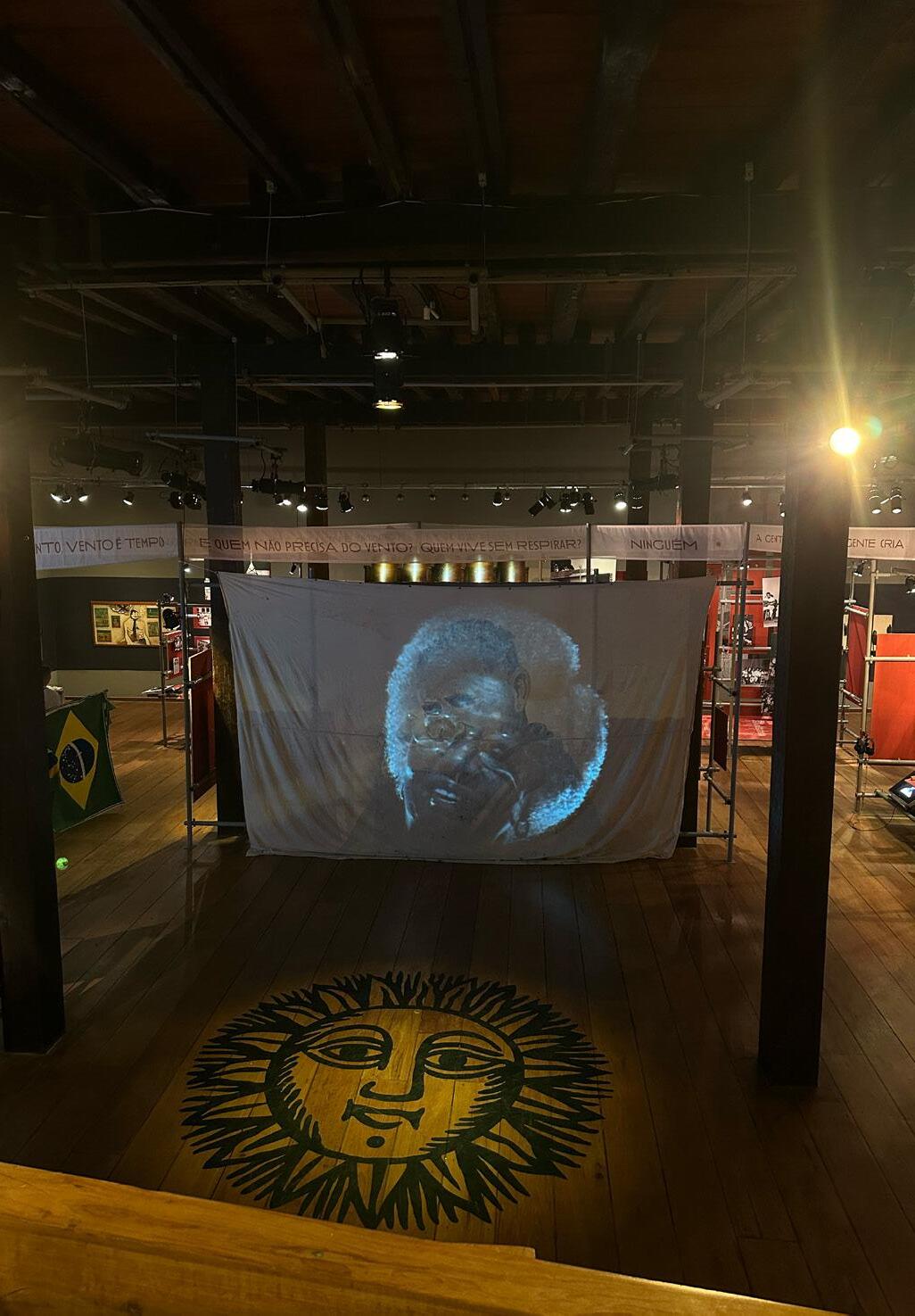
Apoio
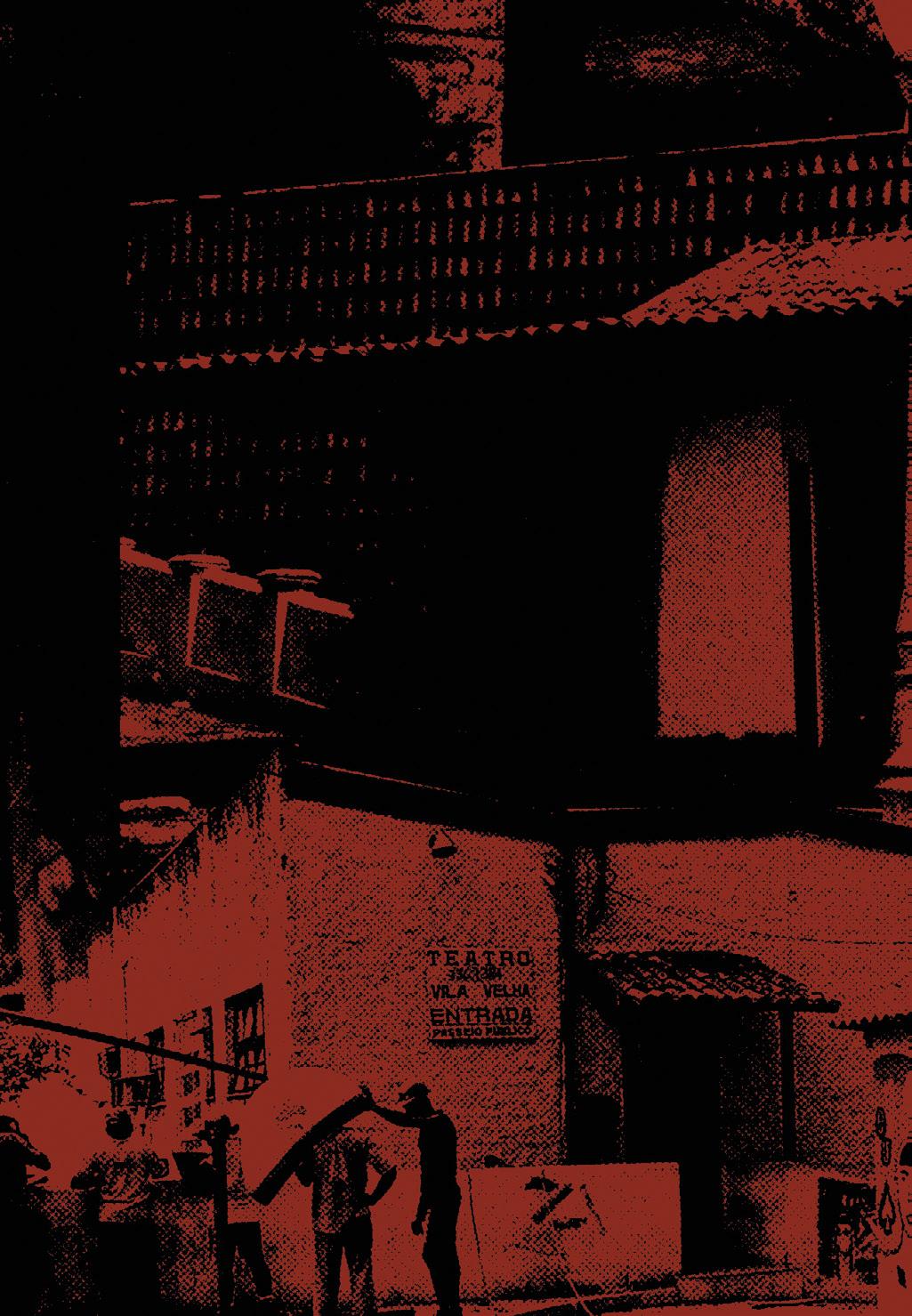
Produção Coprodução
Realização

